

The Perfect 3 Days in Tokyo Itinerary
- Last Updated: March 30, 2024
Headed to the Land of the Rising Sun and looking for an itinerary for the capital? Read on for a jam-packed guide on how to spend 3 days in Tokyo!
Planning a trip to Tokyo can be a bit intimidating. With over 38 million people in the metro area, this is the most populous city in the world.
You know those videos of people being packed like sardines onto a subway car? Yeah, they were probably taken in Tokyo!
The Japanese capital is more like 23 cities, as each of the special wards offers something different. While Asakusa is very traditional, Harajuku is the place to be if you want to take in Japan’s youth culture.
In such a massive city, you won’t be able to see it all in just 72 hours. That being said, you can cover a lot of ground on a Tokyo itinerary if you have a solid plan.
READ MORE: Check out our list of the best things to do in Tokyo !
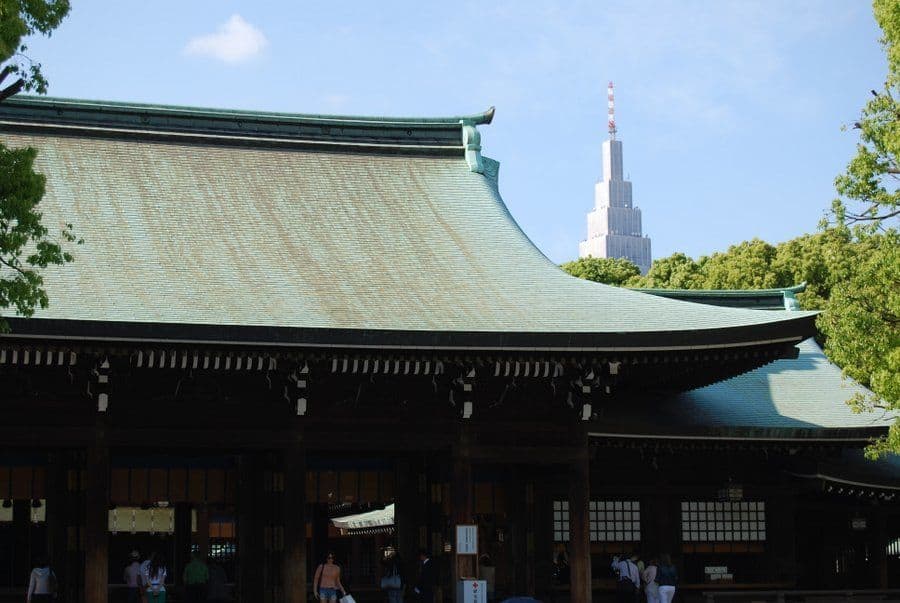
Table of Contents
Nakamise Shopping Street
Senso-ji temple, choose your own adventure, museum of your choice, otaku culture, toyosu fish market, yoyogi park, meiji shrine, takeshita street, tokyo metropolitan government building, imperial palace, roppongi hills, tokyo tower, shibuya crossing, mario kart irl, best hostel in tokyo – grids, best mid range hotel – hotel ryumeikan, best luxury hotel – mandarin oriental.
The first thing you’ll want to do when figuring out what to do in Tokyo in 3 days is which wards you’re most interested in.
You can visit a couple of them on each day but there’s no way you’re hitting them all in such a short time!
Thankfully Tokyo has a vast and efficient public transportation system to help you get around. You can even take day trips to various cities around the Tokyo Bay area.
The underground network is so expansive here that the map looks like some kind of multi-tentacled anime creature.
You can really go anywhere in the city on the Tokyo metro subway lines.
READ MORE: Here’s our brand new guide to travelling in Japan to help you plan your next big trip!
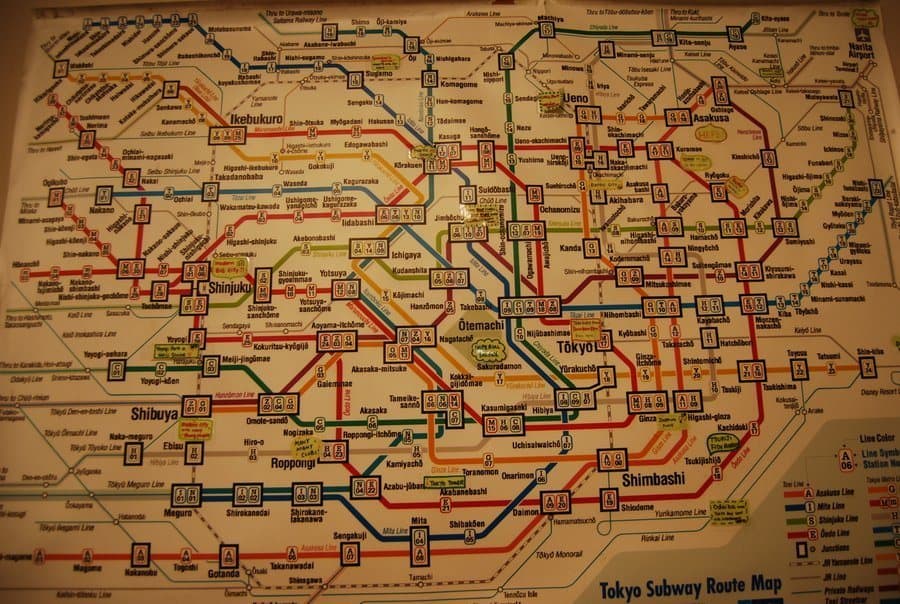
Unfortunately, there are several different rail systems operating here. For a 3 days in Tokyo itinerary, your best bet is picking up one of the 72-hour Tokyo metro tickets .
The Klook website is the cheapest place to buy these, a bit cheaper than buying them at the station.
Another good tip is to pick up a Suica IC card . These are what all the locals use to pay for, well, just about anything.
Buses, metros, vending machines, 7/11, these little pre-paid cards are essential to making your time in Tokyo much less complicated, so you’re not constantly trying to find correct change.
Do yourself a favour and buy one. You’ll thank me later.
BONUS – Booking ahead of time ensures you won’t miss out on the tour, and get the best price too! And just for NOMADasaurus readers, if you use the Klook discount code “NOMADS10” on the website when checking out, you’ll get $10 off your first booking!
Now it’s time to decide what to do in Tokyo in 3 days. In my humble opinion, it’s good to have a list of places you want to check out but also remain flexible.
You will most definitely get lost in Tokyo. Chances are you’ll see, hear, or smell something interesting and take a detour. It’s best to go with the flow, people!
I’m going to provide you with some ideas on what to see in Tokyo in 3 days, but I’m also going to let you choose your own adventure by offering multiple options.
If you’re ready to get lost in translation, read on for an epic 3 days in Tokyo itinerary.
This trip assumes you’re visiting Tokyo on the weekend, so you’ll want to double-check the opening days and hours of the attractions listed if you’re headed there during the week.
READ MORE: Don’t miss out on these best day trips from Tokyo !
Day 1 – Morning
While you may be tempted to dive off the deep end and crush a massive sushi breakfast on your first day, I suggest saving that for day two.
If you’re wondering what a traditional Japanese breakfast is, people usually eat rice, miso soup, fermented soy beans (known as natto), grilled fish, and some pickled vegetables.
People usually wash it down with green tea rather than coffee.
Once you’re full and caffeinated, it’s time to get on with your busy Tokyo itinerary.
READ MORE: Don’t miss our list of the best places to visit in Japan .
On my first visit to Tokyo, I started out in Asakusa. That’s exactly where I’m sending you to begin your 3 days in Tokyo itinerary.
Take the tube to Asakusa station and drop into the tourist information centre if you want to have a look around there first.
Not only are the staff here super friendly and helpful, but you can also head up to the 8th floor to enjoy an amazing (and free!) view.
Heading north, the first thing you’ll see is the Kaminarimon Gate (Thunder Gate).
The traditional gate has a massive lantern in the middle and two guardian statues on either side.
This is one of the most popular places to snap a photo in all of Tokyo, so get your camera ready!
Next up, take a walk up Nakamise Shopping Street. This bustling outdoor market is full of vendors selling traditional snacks as well as souvenirs.
If you wanted to pick up a kimono or some ningyo yaki – a sweet cake filled with red bean paste – this is the place to do it.
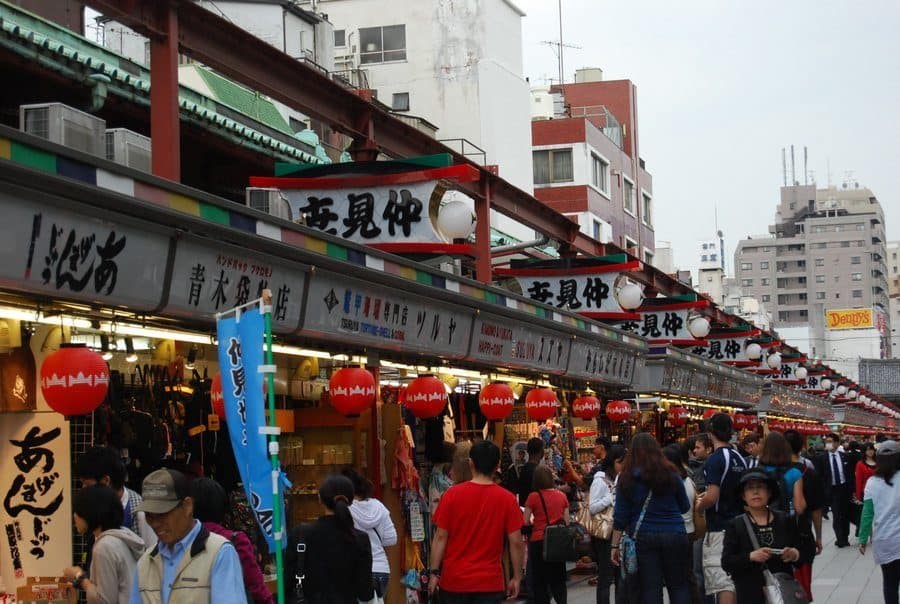
When you walk to the end of the shopping street you’ll find Senso-ji, Tokyo’s oldest temple.
Built way back in the 7th century, this Buddhist temple is an important piece of the city’s history.
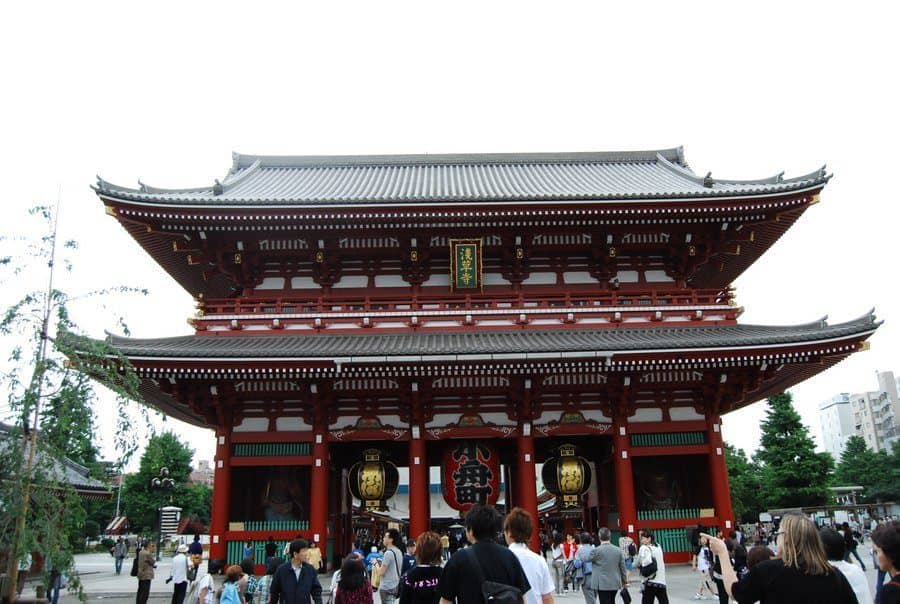
It’s definitely one of the top things to see in Tokyo in 3 days, and more than 30 million people visit each year.
Go ahead and linger a bit to take it all in all of the sights of the temple, but don’t forget that you’ve got a busy 3 days in Tokyo ahead of you!
Remember how I said I’d let you choose your own adventure for your 3 days in Tokyo?
Well my friends, you’ve got quite a few options once you leave the temple. Here’s a quick recap of what you can do in the area:
- Take a rickshaw tour of Asakusa
- Walk around the riverside Sumida Park
- Take a Sumida river cruise
- Head to the top of the Tokyo SkyTree (cheapest tickets for this is on Klook)
- Visit the Asahi Beer Hall (it’s not too early for a cheeky brew, is it?)
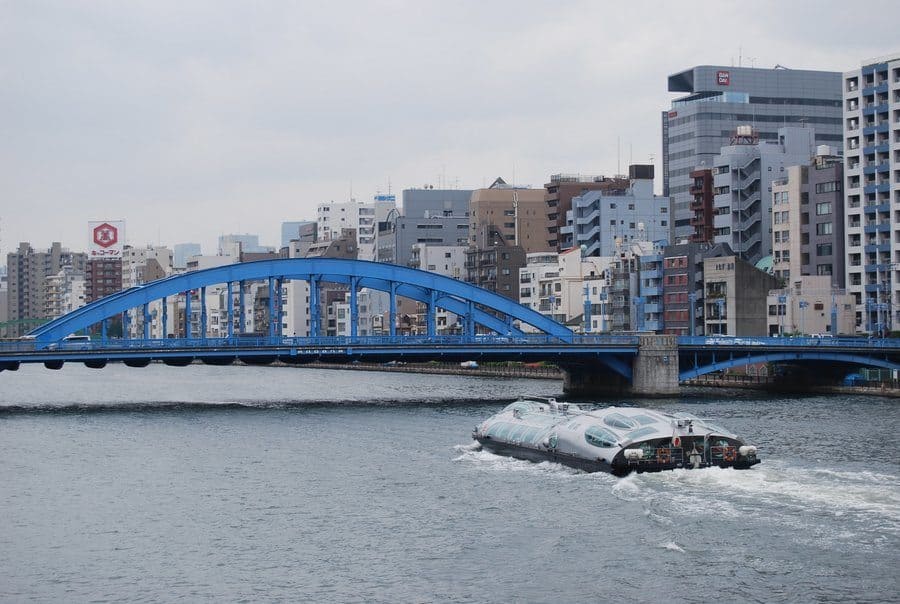
Before we move this 3 days in Tokyo party along, you’ll want to grab some lunch.
There are tons of options in Asakusa, including plenty of excellent ramen shops.
Day 1 – Afternoon
After some lunch – and maybe a cup of coffee with feline friends in a cat cafe – it’s time to move along with your Tokyo in 3 days itinerary. Hop back on the train and cruise over to Ueno Station for our next stop.
There’s perhaps no better place to be on a nice day in Tokyo than Ueno Park.
The park is especially lovely during the cherry blossom season, which happens from late March to early April.
Ueno Park has so much going on that you could honestly spend your entire 3 days in Tokyo here.
Obviously, you’re not going to do that, so you’ll have to be a bit picky about what you choose to do.
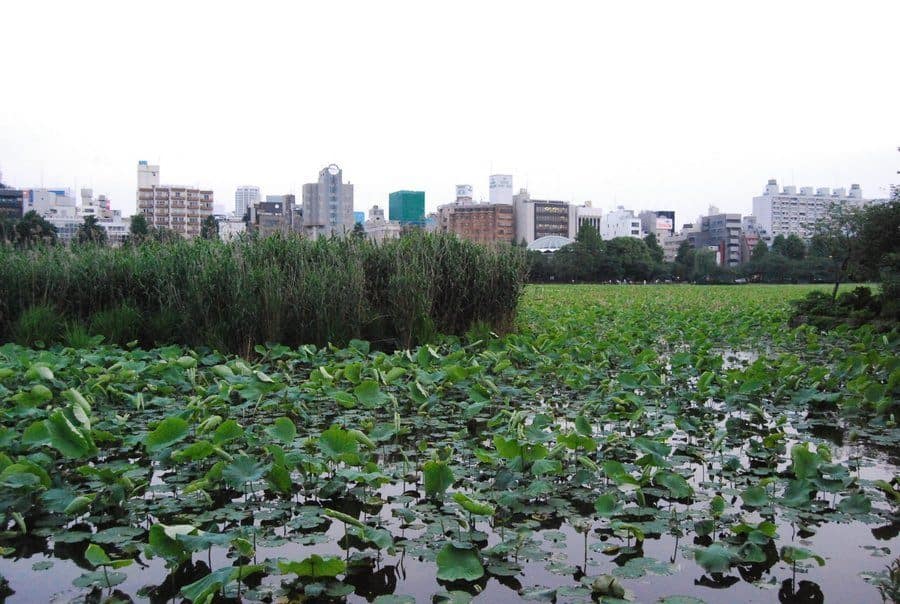
Here are just a few of the options:
- Take a boat around Shinobazu Pond
- Visit the Ueno Zoo
- See the statue of Saigo Takamori (a famous general)
- Check out the Toshogu Shrine
- Drop in the Tokyo Culture Hall
- Hit one of the many museums
- Book a guided tour of the park if it’s cherry blossom season!
Ueno Park is home to several fantastic museums. With just 3 days in Tokyo, you’ll probably have to choose just one.
In my humble opinion, I recommend going to the Tokyo National Museum.
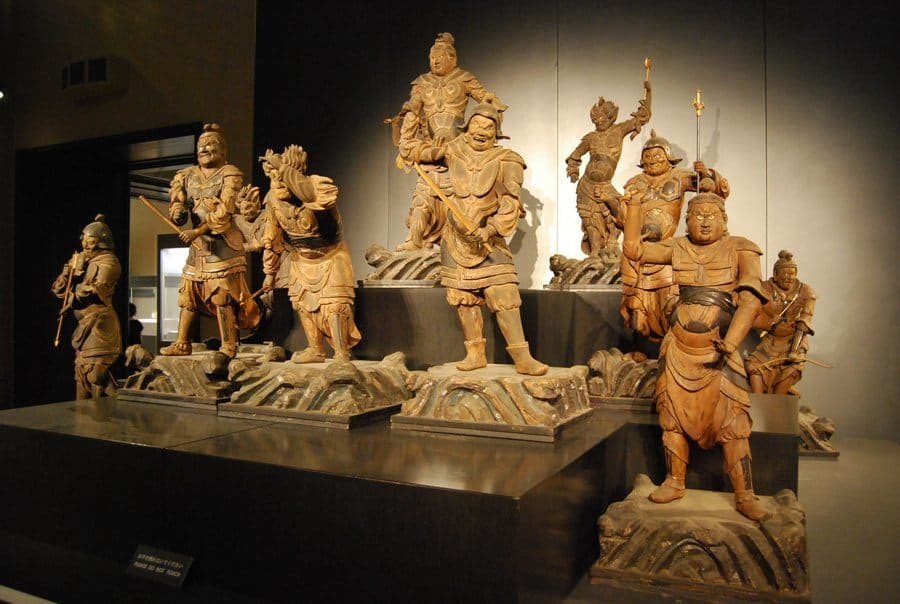
This museum has an impressive collection of over 100,000 pieces spread across several buildings.
It’s the largest and oldest museum in Japan and definitely a must-see in Tokyo in 3 days.
The Tokyo National Museum costs 620 yen to enter.
There are a few art and science museums to see when you visit Tokyo if you’re more into those than history.
You can check out the Tokyo Metropolitan Art Museum, the National Science Museum, the teamLab Borderless digital art museum, or several others.
Day 1 – Evening
As I’m sure you’re realizing by now, this Tokyo in 3 days itinerary is a doozy! Make sure you take some time here and there to kick back on a park bench.
Once you’ve caught your breath, get back out there and keep this 3 days in Tokyo train rolling.
After taking in a bit of traditional Tokyo, it’s time to check out the modern side of the city.
The perfect place to do that is Akihabara, which is just a short walk or train ride from Ueno Park.
This area was named after Akiba, a deity that can control fires. After a fire destroyed the area in the 1800s, the people here built a shrine dedicated to Akiba in hopes of preventing future fires.
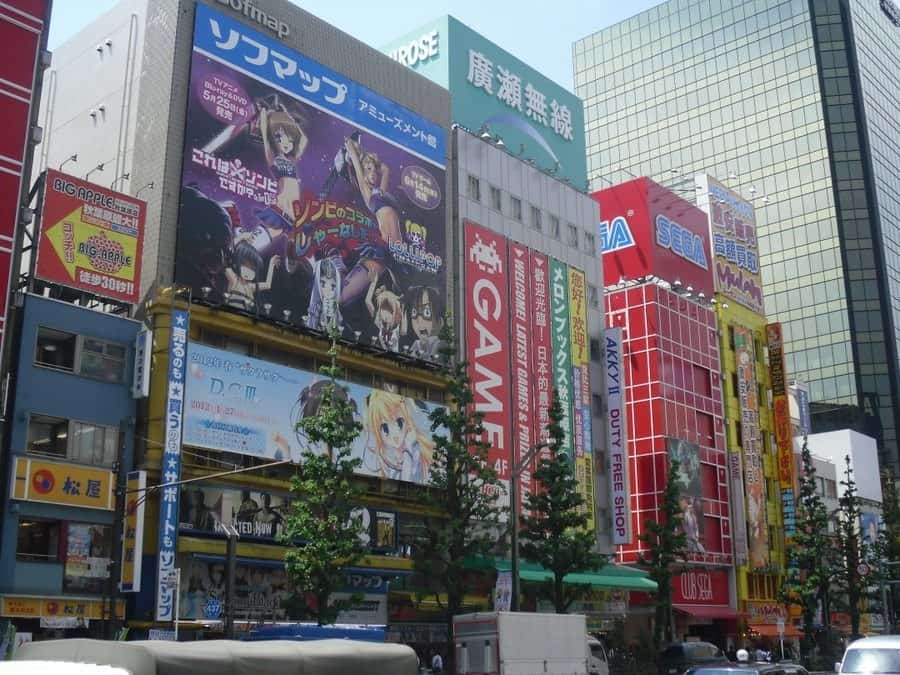
You won’t find the shrine here anymore, but you will find a dizzying array of electronic shops.
Here you can peruse computers, phones, cameras, TVs, and much more. Akihabara has definitely earned its nickname – “Electric Town.”
Even if you’re not shopping for electronics, it’s worth visiting Akihabara over your 3 days in Tokyo just to experience the unique otaku culture.
In Japanese, otaku is a somewhat derogatory term used to refer to someone who is a huge nerd. We’re not talking just any kind of nerd, though. Otaku are people who are obsessed with anime and manga.
People have come to embrace their otaku status and wear it proudly. This part of Tokyo is basically a mecca for otaku and very much caters to them.
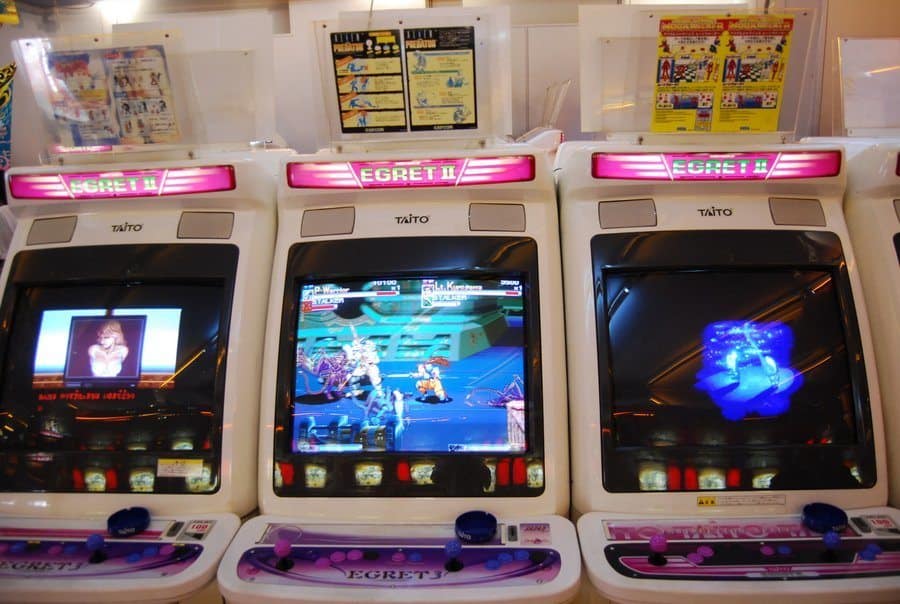
Walking around the streets of Akihabara is like being inside of a video game or comic book.
There are anime and manga shops and images all over the place, as well as tons of cosplayers handing out flyers for places like maid cafes.
“What is a maid cafe?” you may be asking yourself. It’s pretty simple – it’s a cafe where girls dress up like maids and treat customers like their masters.
If it sounds weird, that’s because it is. Embrace the odd during your 3 days in Tokyo, people!
READ MORE: Travelling elsewhere? Check out our list of the best things to do in Japan .
While you’re in the area, you’ve got to drop into a pachinko parlour. Pachinko is basically Japan’s answer to the slot machine, and it’s all the rage here.
These machines function as gambling devices, even though gambling for money in Japan is illegal.
The way they skirt the law is by having players win pachinko balls that are then exchanged for prizes.
There’s an exchange separate from the parlour where you can then swap your prize for some cold hard cash.
Trying your hand at a game of pachinko is for sure one of the top things to do in Tokyo for 3 days.
It’s time once again to choose your own adventure! After an exhausting first of 3 days in Tokyo, it all depends on how much gas you’ve got left in the tank and what your priorities are for day two.
Your options for dinner in Tokyo are basically endless. You might want to try out one of the fun conveyor belt sushi joints, find a place to chow down on wagyu beef , or search for some of the city’s best street food.
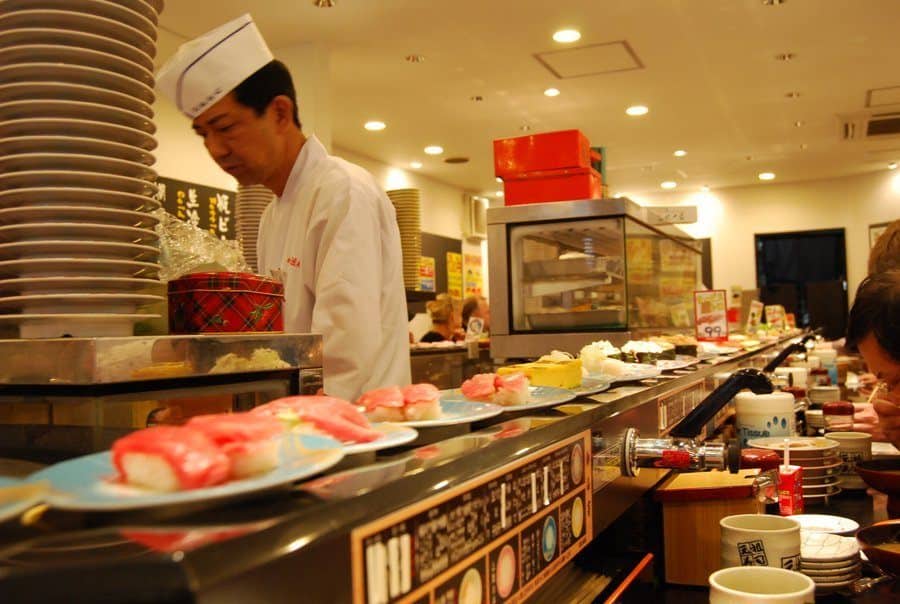
Whether or not you dabble in Tokyo’s nightlife by going on an epic pub crawl is really up to you. If you hope to catch the auction at the Tsukiji Fish Market, you’ll probably want to call it an early night.
That’s because you have to get there around 5 in the morning if you want to grab a spot!
If you could care less about watching people throw fish around, then get out there and rip it up on a night out in Tokyo!
I honestly haven’t experienced much of the nightlife there yet, but this is an excellent guide to drinking in Tokyo .
Day 2 – Morning
If the Toyosu Fish Market is on your list of things to see in Tokyo in 3 days, then day two starts really early for you!
Should you go this route, you might want to make sure you’ve got a coffee and a snack ready to get you going.
I should note that Toyosu is relatively new. Many guides to Tokyo list the Tsukiji Fish Market, but the wholesale market relocated in October 2018 for a variety of reasons.
These days, the tuna auction takes place between 5:30-6: 30 AM.
If you’re cool watching from the upper-level observation area, just show up a few minutes early. Just be warned that you might not see very much from here.
Those who want to watch from the lower floor need to apply in advance. To do so, head to the official website and scroll to the bottom for the English option.
Applying doesn’t guarantee you a spot, as it’s a lottery system. If you’re lucky, you’ll get notified about a week in advance.
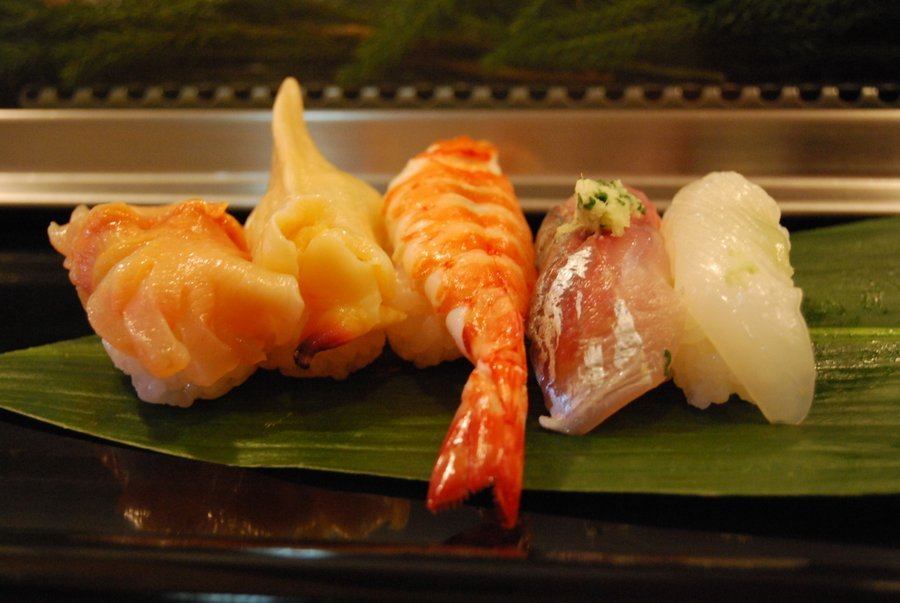
You don’t have to see the auction to enjoy a visit to the fish market. It’s interesting just walking around there for a bit and worth the trip just to smash a massive sushi breakfast in one of the many restaurants.
This is definitely one of the top things to do in Tokyo in 3 days!
For all the relevant information about visiting the new fish market and the changes that have happened since the move, I highly recommend reading this article .
Day 2 – Afternoon
After walking around a fish market, you’ll probably want to swing back to your accommodations for a shower.
If a sushi breakfast isn’t your thing, now is the time to grab some food and fuel up for the second of 3 days in Tokyo.
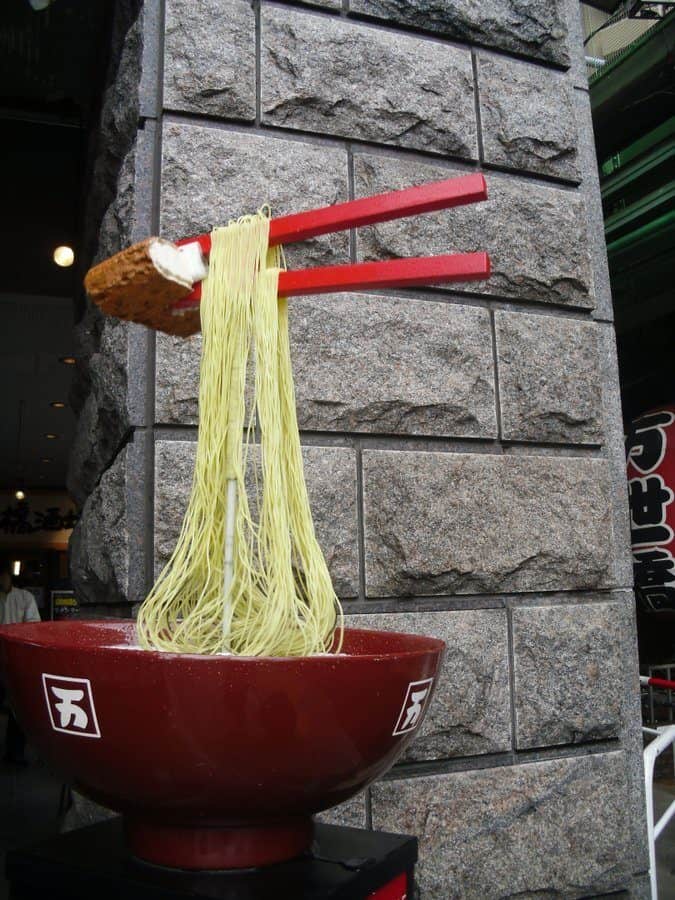
When you’re ready to rock, hop on the tube and head to Harajuku Station. This part of Tokyo is a centre of Japanese youth fashion and culture and a really fun place to explore.
If you need a snack or a pick-me up, there are a few cafes right around the tube station, including yet another cat cafe. They’re kind of a big deal here…
Before you check out the trendy side of Harajuku, head into Yoyogi Park.
Yoyogi Park is one of the largest parks in the city, full of ponds, fountains, and wide open green spaces.
The highlight of visiting Yoyogi Park is the Meiji Shrine. It was built back in 1920 to honour Emperor Meiji.
He passed away in 1920 after seeing Japan through a time of great change. It’s actually Emperor Meiji who is credited with opening the Land of the Rising Sun to the west.
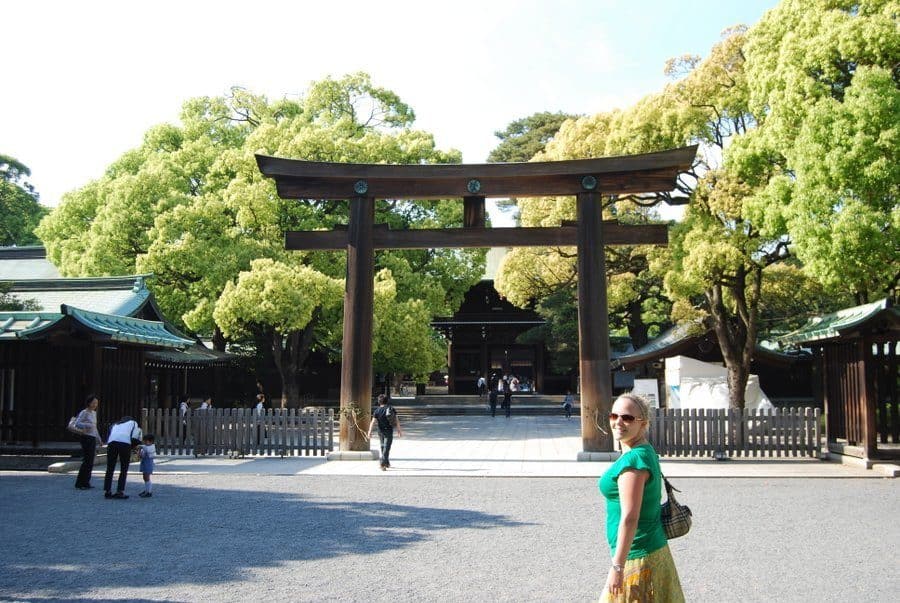
Meiji Shrine is a peaceful, beautiful place to spend some time. To access the shrine, you walk up a tranquil path and through the traditional torii gate.
In a city as big and bustling as Tokyo, it’s amazing how easy it is to escape into nature.
After visiting the shrine, head out of the park to nearby Takeshita Street.
This narrow street is the epicentre of Tokyo’s youth culture and is full of boutique shops, cafes, fast food joints, and all the things teenagers love.
Takeshita is bumping on the weekends with trendy teens who come here to show off their unique fashion sense and do some shopping with friends.
It’s a great place for some people watching, window shopping, and snacking.
Day 2 – Evening
Our 3 days in Tokyo itinerary has now officially passed the halfway point. Congratulations!
I’m sure you’re pretty spent by now, but you’ve got to push on as there’s a lot more to see and do.
For the evening portion of your 2nd day, head just a few stops north on the tube to Shinjuku Station.
At this point in the trip, you may have noticed that a hole has been burned in your wallet.
Tokyo isn’t a cheap city to visit, that’s for sure. That’s why this next stop is such a good one – it’s totally free!
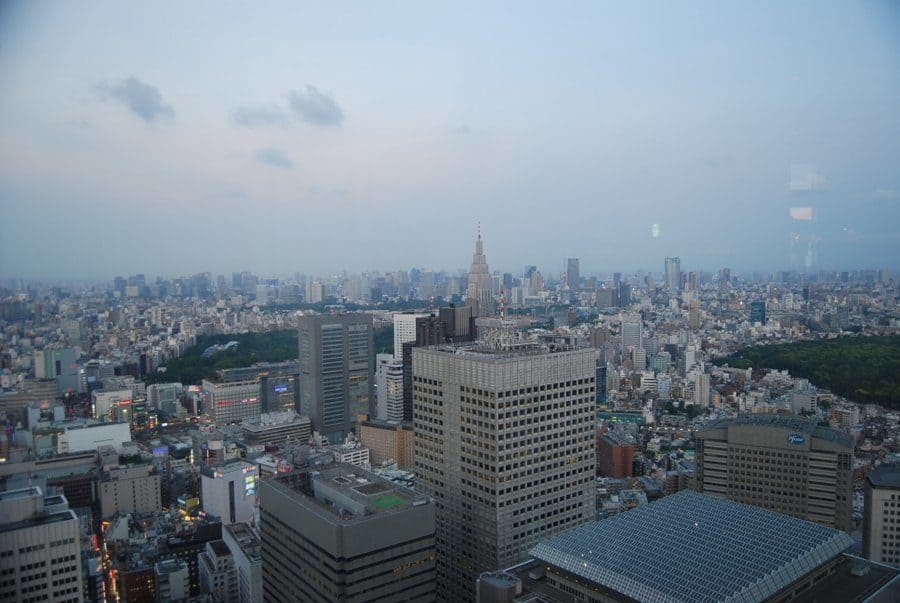
The Tokyo Metropolitan Government Building has an observatory that’s 202 metres above the city streets.
It’s the best place to go for panoramic views of Tokyo and it doesn’t even cost you anything.
Be sure to add a stop here to your list of things to see in Tokyo in 3 days.
It’s been a long day in Tokyo, so how you choose to spend the rest of your night is up to you at this point.
Some people might just want to grab a quick bite to eat and call it a night, and that’s totally understandable.
You’ve only got 3 days in Tokyo, though, so I recommend digging down deep, summoning your 3rd wind, and powering through to check at least one or two more things off your list.
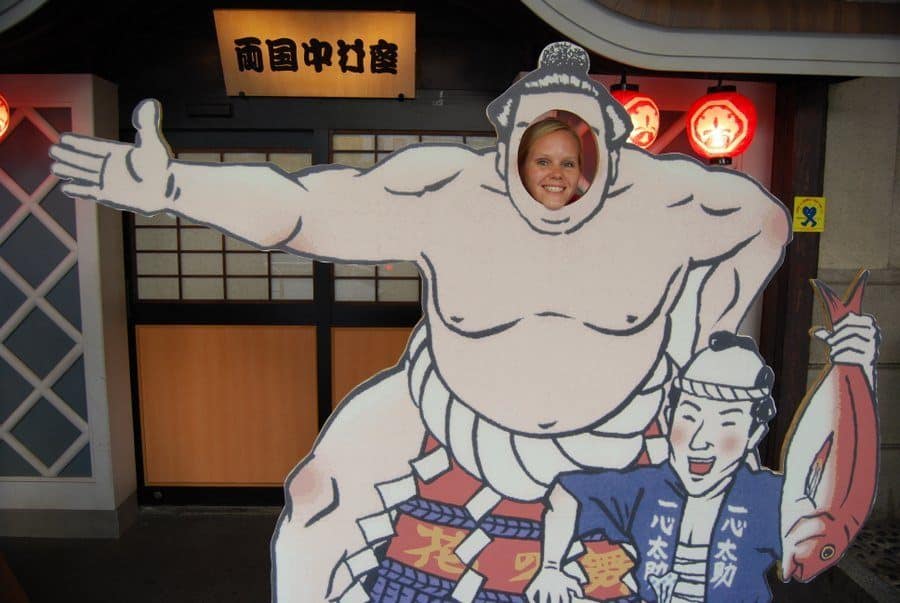
One cool thing to do in this area is visiting the Samurai Museum. It’s open until 9 PM and is worth checking out, if only just to snap a pic of you in a badass Samurai costume. Or you could go to sumo tournaments and see the famous sport in action if you’re a sport fan!
If you’re interested in experiencing a bit of sensory overload along with your dinner, be sure to check out the Robot Restaurant.
It’s basically the dinner show version of an acid trip.
NOMADasaurus Note – The Robot Restaurant was perhaps the BEST thing we did in Tokyo on our recent trip! Trust us, do it. – Alesha and Jarryd
As you might expect, the Robot Restaurant is quite popular. Tickets sell out well in advance, so be sure to book them early .
The price tag is a bit steep, but when else are you going to have such a wild dinner experience?
By booking through Klook you get the cheapest price possible (they have a special deal with the Robot Restaurant), and you get VIP entry and a souvenir.
If lasers and robots aren’t your style, there are plenty of other options for dinner around here.
Whatever you do for dinner, it’s worth it to cruise over to Golden Gai for a nightcap.
This area is full of narrow, winding alleys that are home to some very cozy bars. Some of them can only hold a handful of people.
This makes for a very authentic Japanese drinking experience and is a great addition to your 3 days in Tokyo itinerary.
Day 3 – Morning
Hopefully you didn’t do too many sake bombs in Golden Gai, but if you did that’s cool, too!
Go ahead and sleep in, get yourself a leisurely breakfast, and get ready to tackle the last of 3 days in Tokyo.
When you’re ready to rock, hop on the train and head over to Tokyo Station. Just a short walk from here, you’ll find the Imperial Palace.
It’s located at the former site of the Edo Castle and remains home to the imperial family.
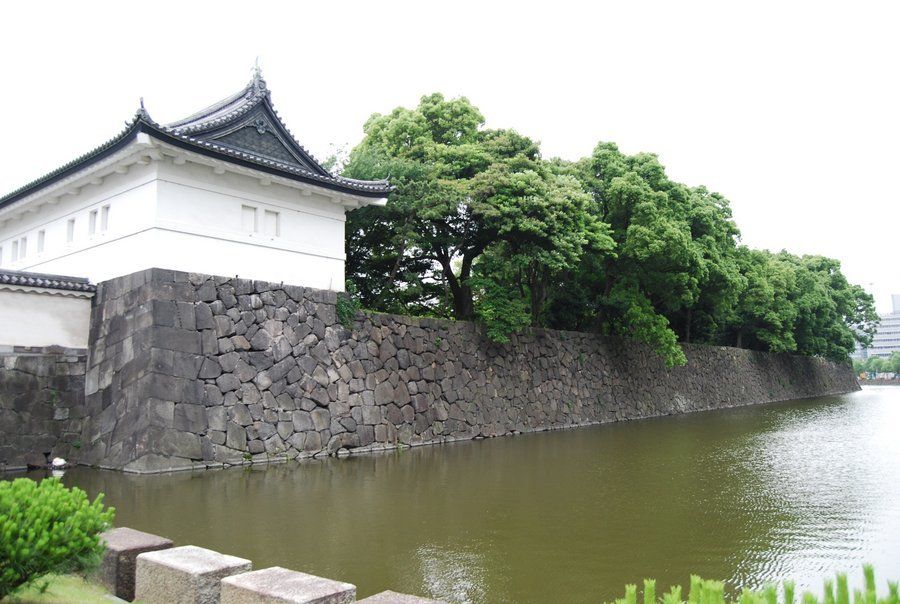
You can sign up to join a free tour of the Imperial Palace, but you’ll want to make sure to do so in advance.
Head to their website up to one month in advance to secure your spot.
Even if you don’t score a spot on a tour, it’s worth visiting the palace grounds.
The Imperial Palace East Gardens are stunning and definitely one of the best things to see in Tokyo in 3 days.
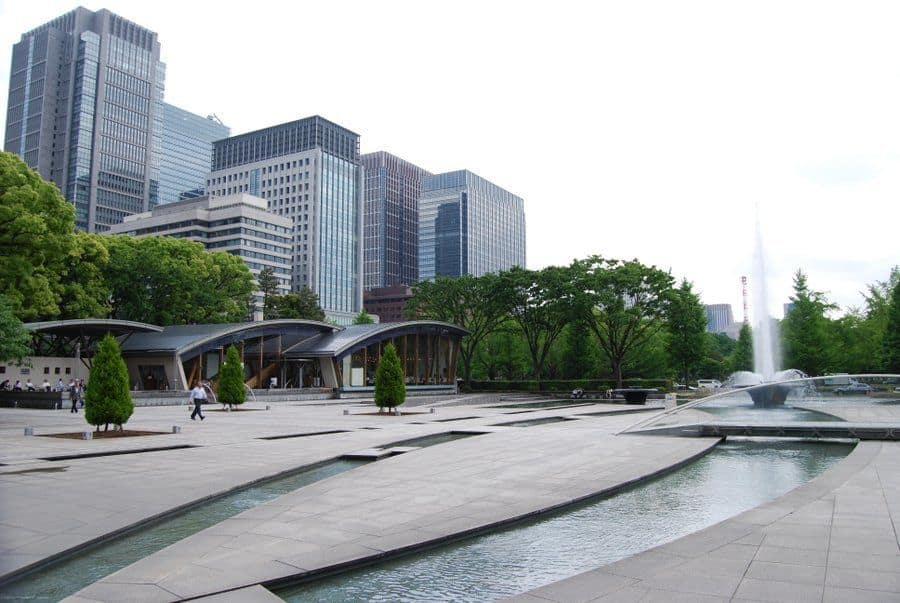
Another thing to check out near the Imperial Palace is the Wadakura Fountain Park. It’s a scenic place to sit down for a quick breather and grab a cheeky cup of coffee if you need some fuel for the rest of the day.
After exploring the palace grounds for a while, head out the southeast corner and cross the moat to access Hibiya Park.
It’s a pleasant little park and a good spot for a quick stroll.
The main reason to walk through this park, though, is to snap a photo of the Godzilla statue that’s right around the corner.
Put Blue Oyster Cult’s “Godzilla” on and sing along – “Oh, no, there goes Tokyo! Go, go Godzilla!”
To be honest, the statue is kind of small and underwhelming, but the novelty alone makes it worth the quick stop.
Plus, there are lots of restaurants and cafes around here and you’re probably ready for lunch at this point in the day.
Day 3 – Afternoon
It’s been a whirlwind 3 days in Tokyo so far, and we’re almost to the finish line.
For the afternoon on your final day in the city, cruise over to the Ginza district.
Ginza is the place in Tokyo to see and be seen. It’s the premier shopping district for the Japanese capital and is home to countless luxury stores, cafes, and restaurants.
During the warmer months (April-September), the central Chuo Dori street is shut down to traffic and becomes a bustling pedestrian zone.
Other cool things to do in Ginza include seeing a kabuki show at the Kabukiza Theatre or visiting the Nissan and Sony showrooms at Ginza Place.
If you didn’t make it to the new fish market on day two, you can swing by the old one today.
The Tsukiji Fish Market isn’t home to the auctions anymore, but it’s still open and there are plenty of places to munch on fresh sushi here.
Day 3 – Evening
It’s time once again to choose your own adventure! For your final night of 3 days in Tokyo, you’ll want to be sure to get some nice sunset views.
Here are a few options including the famous Tokyo Tower, Shibuya Crossing, and more.
This is a massive development project and the brainchild of building tycoon Minoru Mori.
It has apartments, office spaces, restaurants, movie theatres, shops, and more.
The idea was to create a place where people can live, work, and play, thus basically eliminating the need to commute.
Here you’ll find the Tokyo City View observatory. Tickets are a bit steep at 1,800 yen, but they also include admission to the Mori Art Museum.
If you don’t mind splurging a bit, the views here are pretty incredible.
If you want some epic views of the city but don’t want to fork over so much yen, you can head to the Tokyo Tower instead.
The Tokyo Tower is like the Japanese capital’s answer to the Eiffel Tower. The top of the Tokyo Tower also has a nice observation deck and it only costs 900 yen.
Standing at 333 meters tall, Tokyo Tower serves as a symbol of rebirth after World War II.
Book tickets to the Tokyo Tower on Klook!
We wrap up 3 perfect days in Tokyo in Shibuya. Coming out of the Shibuya Station, you’ll see the famous statue of Hachinko.
There’s a beautiful story behind this loyal dog, so be sure to read it before your trip!
Hopefully, you can handle crowds because our next stop is the Shibuya crossing.
Famed to be the busiest pedestrian crossing in the world, over 2,500 people crisscross the street here on each light.
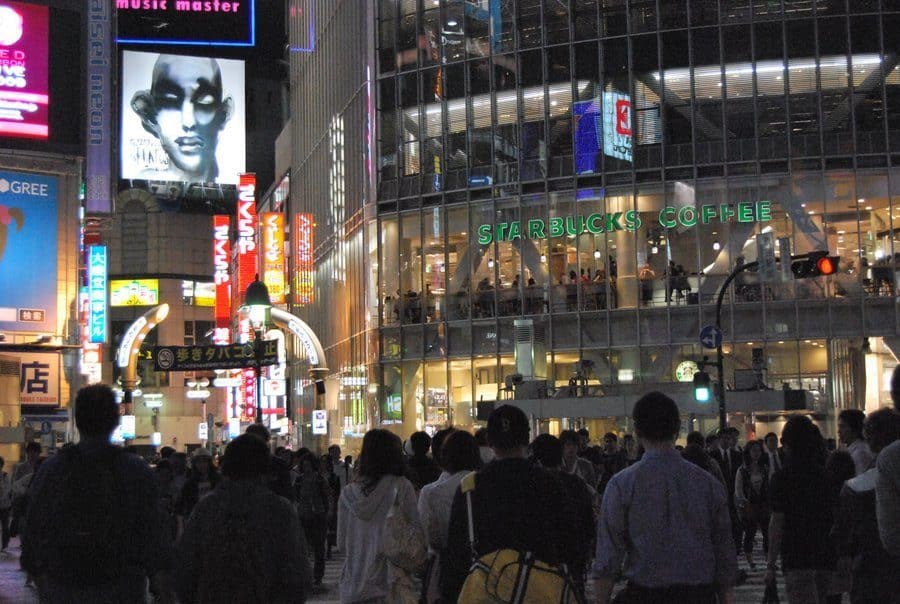
If you want to see the view of the crossing from above, your best bet is to pop into the Starbucks.
There’s no sneaking a free peak here, though, as they ensure that you buy something before you can approach the window. Grab a cup of joe and sit down to watch the madness below.
Hands down, one of the coolest things to do in Tokyo in 3 days is playing real-life Mario Kart.
MariCAR allows you to dress up as famous characters like Yoshi and ride a go-kart through the busy streets of Tokyo.
Just don’t go tossing any banana peels off to the side – that’s dangerous!
You have to book it ahead of time , and you must have your International Drivers Permit with you in order to do the activity.
If you’ve got any energy left, there are plenty of cool bars and music venues in Shibuya.
There you have it, my friends – an awesome plan for how to spend 3 days in Tokyo!
Where to Stay in Tokyo
Now that you’ve got a badass itinerary for 3 days in Tokyo, you’re probably wondering where you should say in this sprawling metropolis.
Honestly, as long as you’re in the city proper and are near an underground station, you’re good to go.
Some of the most popular areas to stay in Tokyo include Shinjuku, Shibuya, Ginza, and Asakusa.
Here are a few options for some accommodation in Tokyo to suit all budgets:
There are plenty of excellent hostels in Tokyo, which is great news for budget travellers.
If you’re balling on a budget, a solid choice is Grids . They’re so popular that they have three locations in the city with a fourth on the way.
You can choose between their Asakusa-Bashi, Akihabara, and Nihombashi locations.
Whichever one you go with, you’ll find a comfortable hostel in a great location.
Dorm beds go for under $25 a night here. They have a nice cafe and bar on-site here as well and serve a buffet breakfast for a reasonable price.
All of their properties have awesome reviews, so they’re clearly doing something right!
If you’re the type of traveller who appreciates a good deal, you’ll love the Hotel Ryumeikan. It’s just a stone’s throw away from the central Tokyo Station and double rooms go for $200 or less here.
The rooms here are well-appointed and, while they seem a bit small, are actually pretty big for Tokyo. They also have tea and a Nespresso machine, plus some super comfy pajamas you can use.
You can start your day off here with a fully-stocked breakfast buffet featuring both Japanese and western cuisine. Other amenities here include a laundry service and coin-operated machines if you’d rather just do your own.
When it comes to luxury accommodations in Tokyo, it’s hard to top the Mandarin Oriental.
This 5-star hotel is centrally located near Tokyo Station in the city center on the top nine floors of the Nihonbashi Mitsui Tower.
This swanky hotel has it all – a spa, gym, business centre, event space, and more. It also boasts a whopping 12 restaurants, 3 of which are Michelin-star.
Of course, all this luxury comes at a price. Even the cheapest option here runs close to $700 a night even in low season.
Then again, this place always comes up in lists of the “best hotels in the world,” so it’s worth the splurge for this one!
Sasha and Rachel
Hi, We’re Alesha and Jarryd!

We’ve been traveling the world together since 2008, searching for the planet’s best destinations and adventures.
Love Travel?
Sign up for our free weekly newsletter for the best travel tips, ideas and deals!
We respect your privacy. Unsubscribe at any time.
READ MORE...
19 BEST Things to Do in Osaka, Japan [2024 Edition]
The Best Day Trips from Every City in Japan [2024]
18 Amazing Things to Do in Kyoto at Night (2024 Guide)
Related Posts
Ryokan ochiairo review – is this japan’s best ryokan, 20 epic things to do in okinawa, japan [2024 guide], the ultimate sado island japan travel guide [2024], 6 thoughts on “the perfect 3 days in tokyo itinerary”.
I’m traveling to Tokyo at the end of Oct. Which company in Tokyo helped you get a ENFS visa?
Hi Chase, sorry we are not too sure. We did not have to get a visa to enter Japan as a tourist. Sorry we can not help. All the best.
Many thanks for this very good travel guide about 3 days in Tokyo. I’ve visited Tokyo several times and I can highly recomment a trip to this metropole.
Good ideas for the 5 days I’m in Tokyo (lazy) tnx
Glad to help. Have a great trip.
Thanks so much! This has been so helpful in my query for the upcoming trip hopefully when the pandemic is over. I get so excited waching the pics and learning about your adventure. My flight was actually cancelled and was given an option to rebook for a year to choose from so I was wondering when is the best time to go there with a weather suitable to my tolerance 🙂 I dont want too cold nor too humid…Cn you give suggestion please 🙂 I appreciate it so much! Godspeed to you both and more adventures to come !
Leave a comment Cancel reply
Save my name, email, and website in this browser for the next time I comment.
Truly Tokyo
A Tokyo Travel Guide
Tokyo 3-Day Itinerary
Three days is the perfect amount of time to spend in Tokyo. My three-day Tokyo itinerary is the best way to get the most out of your time in this incredible city.

Tokyo 3-Day Itinerary Summary
- Three days is the ideal amount of time for the traveler to stay in Tokyo.
- Base yourself somewhere central to save time.
- On Day 1, visit modern Tokyo on the west side.
- On Day 2, visit traditional Tokyo on the east side.
- On Day 3, visit the Imperial Palace Area and Shinjuku.
Check Hotel Availability
Destination, check-in date, check-out date.

Tokyo 3-Day Itinerary Full Itinerary
Day 1: modern tokyo/west side.
- 8:30am: Take the train or subway to Harajuku. Depending upon where you stay, you'll probably take the JR Yamanote Line to Harajuku Station or the Chiyoda subway line to Meiji-Jingumae/Harajuku Station.
- 9:00am: Arrive in Harajuku and visit Meiji-jingu Shrine . After visiting the shrine, walk along Omotesando (the main avenue of Harajuku), checking out all the cool shops. Then, walk east all the way to the superb Nezu Museum and its fantastic garden (do not miss the garden!).
- 11:00am: Walk back to the intersection of Omotesando and Aoyama-dori and take the Ginza subway line west to Shibuya.
- 11:15am: Arrive in Shibuya, take the Hachiko exit and then walk across the famous Shibuya Crossing . Explore the big department stores and boutiques of Shibuya.
- 1:00pm: Eat lunch somewhere in Shibuya. All the department stores in Shibuya have huge restaurant floors. For more choices see the Shibuya district page Places to Eat section.
- 2.30pm: Take the Yamanote Line one stop south from Shibuya to Ebisu Station, then switch to the Hibiya Line subway and take that two stops east to Roppongi.
- 3:00pm: Arrive in Roppongi and visit the Roppongi Hills complex. Take the elevator up to the 52nd floor Tokyo City View observation deck of the Mori Tower to see the city.
- 6:00pm: Eat dinner in Roppongi. See the Roppongi Places to Eat section on the Roppongi district page for some of my picks.
- 8:00pm: If you still have any energy left, have a drink in one of Roppongi's many bars. See the Roppongi district Nightlife section for some recommendations.

Day 2: Traditional Tokyo/East Side
- 9:00am: Take the Ginza subway line up to Asakusa . Visit Senso-ji Temple and nearby Asakusa-jinja Shrine .
- 10:30am: Take the Ginza subway line three stops west to Ueno.
- 11:00am: Arrive in Ueno . Visit the wonderful Tokyo National Museum , Ueno-koen Park and Tosho-gu Shrine and then make your way back to the station.
- 1:00pm: Take the JR Yamanote Line south to Tokyo Station. Eat lunch in or around Tokyo Station. See the Tokyo Station Area Places to Eat section for my recommendations.
- 2:00: Check with the tourist information office in the basement of the Kitte Building to see what's on at the Mitsubishi Ichigokan Museum or the Bridgestone Museum of Art. Consider a nice stroll in nearby Hibiya-koen Park afterward.
- 3:30pm: Return to your hotel for a nap and a shower.
- 6:00pm: Eat dinner in an area like Shinjuku , Ginza , Marunouchi or someplace close to your hotel. See the relevant district pages for recommendations.
- 8:00pm: If you've still got the energy, go out for a drink in a place like Roppongi , Shinjuku or Shibuya . See the relevant district pages for recommendations.
Day 3: Imperial Palace Area and Shinjuku
- 9:00am: Get yourself to Tokyo Station by train or subway. Walk east from Tokyo Station to the Imperial Palace East Garden . Visit the East Garden and exit via the Kitahanebashi-mon. For details on this area, see the Tokyo Imperial Palace Area page .
- 11:00am: Walk north through Kitanomaru-koen Park and then visit Yasukuni-jinja Shrine . Do not miss the controversial and interesting Yushukan Museum at the shrine. For details on this area, see the Tokyo Imperial Palace Area page .
- Noon: Take the Shinjuku Line subway west to Shinjuku. Eat lunch somewhere in Shinjuku. See the Shinjuku page for some suggested places to eat. You might want to hold off on eating lunch until 1:00pm to avoid the lunch rush.
- 1:00pm: First, go up to the observation deck of the Tokyo Metropolitan Government Offices to see the view of the city (and maybe even Mt Fuji) from the observation decks. Then, walk over to the East Side and check out the bustling shopping and entertainment district around the station. See the Shinjuku page for details on this area.
- 4:00pm: Return to your hotel for a rest and shower.
- 6:00pm: Eat dinner in the district of your choosing. Shinjuku , Shibuya , Ginza and Roppongi all have lots of great restaurants to choose from.
- 8:00pm: After dinner, head to Roppongi for a stroll and a drink or two. See the relevant district pages for some recommended bars.
Hints, Comments and Variations
- If you're only going to be in the city for three days, you should try to base yourself in a central location so you don't waste time moving around. I'd suggest Shinjuku , Shibuya , Ginza or the Tokyo Station area . For more on where to say, check out my Where to Stay in Tokyo page.
- On Day 2, another good option for the afternoon is the Edo-Tokyo Museum . It's easy to reach from Asakusa, Ueno or Tokyo Station.
- On Day 3, if it's very hot or you don't feel like walking much, cut out the Imperial Palace Area and head over to the Edo-Tokyo Museum (if you haven't already visited it).
- Don't try to do more than this with three days in Tokyo. If anything, cut out some of the destinations in this itinerary and slow down and relax! Tokyo is a huge city and it's tiring to move from place to place. Less is often more in a place like Tokyo.
Where Are These Places Located?
- Open the Tokyo map
- You will see the list of places on the left hand side. (Click the 3-line icon in the top left corner if not). Scroll down or use the map search (the magnifying glass icon) to find the place you want.
- Click the name of the place in the list. Its location pin will be highlighted on the map.
- Map pins are color coded - BLUE: Hotels / Ryokan / Guesthouses | VIOLET: Ryokan | PINK: Places to Eat | GREEN: Shops | YELLOW: Things to See and Do
- If you're using the map on your phone, open the map and then search for the name of the place. The map will then zoom in on its location.
Tokyo Vacation Checklist
- For all the essentials in a brief overview, see my First Time In Tokyo guide
- Check Tokyo accommodation availability and pricing on Booking.com and Agoda.com - often you can book with no upfront payment and free cancellation
- Need tips on where to stay? See my one page guide Where To Stay In Tokyo
- You can buy shinkansen (bullet train) tickets online from Klook - popular routes include Tokyo to Kyoto , Tokyo to Osaka and Tokyo to Hiroshima
- You can buy a Japan SIM card online for collection on arrival at Tokyo Narita or Haneda airports. Or rent an unlimited data pocket wifi router
- See my comprehensive Packing List For Japan
- Compare airline flight prices and timings for the best Japan flight deals . Check my guides to arriving at Narita Airport and at Haneda Airport .
- If you're visiting more than one city, you might save money with a Japan Rail Pass – see if it's worth it for you
- A prepaid Welcome Suica card makes travelling around Tokyo much easier - here's how
- World Nomads offers simple and flexible travel insurance. Buy at home or while traveling and claim online from anywhere in the world
Tokyo District Map

- Imperial Palace Area
- Tokyo Station
- Shimbashi Shiodome Hamamatsucho Shinagawa
- Akihabara Kanda
- Roppongi Akasaka
- Harajuku Aoyama
- Ebisu Daikanyama Meguro
Disclosure: trulytokyo.com is a participant in the Amazon Services LLC Associates Program, an affiliate advertising program designed to provide a means for sites to earn advertising fees by advertising and linking to amazon.com and amazon.co.uk. World Nomads provides travel insurance for travellers in over 100 countries. As an affiliate, we receive a fee when you get a quote from World Nomads using this link. We do not represent World Nomads. This is information only and not a recommendation to buy travel insurance.
- Destinations
Amazing 3 DAYS in TOKYO (Thrilling Itinerary with 21 Things You Can’t Miss)
This site uses affiliate links, meaning that if you make a purchase through our links, we may earn an affiliate commission.
Welcome to the bustling metropolis of Tokyo, Japan! Ready for action-packed 3 days in Tokyo?
Known for its cutting-edge technology, unique culture, and vibrant cityscape, Tokyo is a city that never sleeps .
With its mix of ancient traditions and modern innovation, Tokyo offers a captivating experience for travelers seeking to immerse themselves in the heart of Japan’s urban life.
In this 3-day itinerary, I will take you on a journey through some of Tokyo’s most iconic neighborhoods , historic sites , and culinary delights .
From the dazzling lights of Shinjuku to the serene gardens of Tokyo, get ready for an unforgettable adventure in this dynamic city!
Let’s dive into an action-packed 3 days in Tokyo , where you can explore the best of what this world-renowned city has to offer. For those wanting to extend their stay, consider adding on 5 days in Tokyo for a more comprehensive experience!
You Might Also Like:
Ultimate 16-DAY JAPAN ITINERARY for Marvelous Culture, History, and Nature
Easy DIY Shibuya and Harajuku Walking Tour (11 Best Stops+Maps+Tips)
What to do in shibuya (11 things to explore in the vibrant heart of tokyo).
Amazing TOKYO to HAKONE Day Trip (7 Fun Things You Can’t Miss)
Discover 6 JAPANESE TEA CEREMONY STEPS for a Meaningful Experience
- 1. Tokyo At-A-Glance
- 2. Map of Action-Packed 3 Days in Tokyo Itinerary
- 3. Amazing 3 Days in Tokyo Itinerary
- 3.1.1. Shibuya Scramble Crossing
- 3.1.2. Hachiko Memorial Statue
- 3.1.3. Shibuya Center-Gai
- 3.1.4. Yoyogi Park and Meiji Shrine
- 3.1.5. Takeshita Street
- 3.1.6. Omotesando Avenue
- 3.1.7. Tokyo Metropolitan Government Building
- 3.1.8. Shinjuku Golden Gai
- 3.1.9. Omoide Yokocho Alley
- 3.1.10. Kabukicho District
- 3.2.1. Sensoji Temple
- 3.2.2. Tokyo National Museum
- 3.2.3. Akihabara District - Electric Town
- 3.2.4. Maid and Gundam Cafes
- 3.2.5. Anime and Manga Shops
- 3.2.6. Arcades and Game Centers
- 3.2.7. Rent a Go-Kart in Akihabara
- 3.3.1. Toyosu Fish Market
- 3.3.2. Ginza
- 3.3.3. Imperial Palace
- 3.3.4. Roppongi
- 4. Intrepid Scout's Tips for 3 Days in Tokyo Itinerary
Tokyo At-A-Glance
Before diving in, here are a few helpful tips for planning your trip to Tokyo:
- Best Time to Visit Tokyo
Tokyo experiences four distinct seasons: spring, summer, autumn, and winter, each with its unique charm.
Spring (March to May): Spring is one of the most popular times to visit Tokyo due to the famous cherry blossom season. Spring weather is mild and pleasant, with temperatures ranging from 10 to 20 C (50 to 68 F).
Summer (June to August): Summer in Tokyo can be hot and humid, with temperatures ranging from 25 to 35 degrees Celsius (77 to 95 degrees Fahrenheit). However, it is also a vibrant season with various summer festivals, outdoor events, and fireworks displays.
Autumn (September to November): Autumn is another popular time to visit Tokyo, with mild weather and beautiful fall foliage in parks and temples. The temperatures range from 15 to 25 C (59 to 77 F).
Winter (December to February): Tokyo’s winter is generally cold, with temperatures ranging from 0 to 10 C( 32 to 50 F). However, Tokyo’s winter illuminations and holiday decorations are spectacular, creating a festive atmosphere throughout the city.
- Where to Stay in Tokyo
My first choice is to always stay in Ginza . Ginza is Tokyo’s luxury shopping district, known for its upscale boutiques, department stores, and high-end restaurants.
There are several hotels that I stayed at and really enjoyed. Check them out and see which one you like the best:
Muji Hotel Ginza – this is my first choice. The rooms are elegantly designed like all Muji products. The location is perfect near the JR Yamanote line. The in-room extras, all Muji branded, are great, with everything from the slippers to bags of Japanese sweets yours to take with you. The breakfast is lovely with healthy and high-quality food options.
AC Hotel by Marriott Tokyo Ginza – it is a beautiful, modern, and well-maintained hotel right in the heart of Ginza. The rooms are a good size, which is unusual for Tokyo, nicely designed, and super clean.
Agora Tokyo Ginza – stylish and elegant hotel. The location is great close to train stations. Rooms are on the smaller side, however, they are very comfortable and clean. You will love the bathroom which is beautifully designed and huge in size.
- How to Get Around in Tokyo
Tokyo has an extensive and efficient public transportation system that makes it easy to get around the city. Here are some common methods of transportation for navigating Tokyo:
The Tokyo Metro and subway are a convenient and efficient way to travel within the city, with multiple lines covering different areas. Make sure to get rechargeable IC cards such as Suica or Pasmo, which offer discounted fares and can be used on multiple transportation systems.
Japan Railways (JR) operates several lines in Tokyo, including the Yamanote Line, which is a loop line that circles central Tokyo and connects major neighborhoods.
Buses are another option for getting around Tokyo, although they are not as easy to use as Tokyo Metro and subway, as well as JR.
Taxis are widely available in Tokyo, but they can be more expensive compared to other forms of public transportation.
Walking is a great way to explore Tokyo’s neighborhoods like Shibuya, Shinjuku, and Asakusa.
- Intrepid Scout’s Tip:
Make sure to buy JR Pass before going to Japan. It is a huge cost-saving tool . It allows unlimited use of most JR trains, including the Shinkansen (bullet trains), limited express trains, and local trains, for a set period of time (7, 14, or 21 days).
The JR Pass also includes some additional benefits , such as free seat reservations on most trains, which can be especially useful during peak travel times, and access to some JR buses and ferries. It also covers the Tokyo Monorail to/from Haneda Airport and the Narita Express to/from Narita Airport, which can be convenient for travelers arriving or departing from these airports.
Map of Action-Packed 3 Days in Tokyo Itinerary
Map of 3 Days in Tokyo Itinerary
Amazing 3 Days in Tokyo Itinerary
Shibuya scramble crossing, hachiko memorial statue, shibuya center-gai, yoyogi park and meiji shrine, takeshita street, omotesando avenue, tokyo metropolitan government building, shinjuku golden gai, omoide yokocho alley, kabukicho district.
Let’s start this 3 days in Tokyo itinerary at the Shibuya Scramble Crossing!
Located in the very center of Tokyo, the Shibuya Scramble Crossing is the most iconic symbol of Tokyo and the most famous pedestrian crossing in the world.
It is estimated that over 500,000 people cross the intersection every day, making it one of the busiest pedestrian crossings in the world.
Shibuya Scramble Crossing is unique for its “scramble” design, where traffic from all directions comes to a stop simultaneously, allowing pedestrians to cross in all directions, including diagonally, creating a mesmerizing spectacle of people moving in various directions.
Intrepid’s Tips:
Shibuya Scramble Crossing is a popular spot for photography and capturing the dynamic atmosphere of Tokyo. Here are some of the best spots for photographing Shibuya Crossing:
- Starbucks Shibuya Tsutaya – Located on the second floor of Tsutaya Shibuya, the Starbucks cafe offers a great vantage point overlooking Shibuya Crossing. However, it is a busy place and you might have to patiently wait for an opportunity to get to one of the windows.
- Shibuya Sky – The observation deck is located on the rooftop of the Shibuya Scramble Square building, which is one of the tallest buildings in Shibuya, is definitely one of the best spots to photograph the crossing. The glass windows extend all the way to the floor, giving you uninterrupted views. However, there is an entrance fee to the deck which are s typically around 2,000 to 2,500 yen for adults.
- Shibuya Stream – Shibuya Stream has a rooftop terrace with an open-air deck with glass railings, providing an excellent spot for photography. But, it is not free. There is an entrance fee to the rooftop terrace which is typically around 2,000 yen.
- Pedestrian Bridges – There are two pedestrian bridges that you might want to check out: the Shibuya Mark City Bridge and the Tokyu Plaza Shibuya Bridge. Both are popular spots.
- Street Level – Don’t forget that capturing the energy and atmosphere of Shibuya Crossing from the street level can result in some unique and dynamic photos.
Right next to the Hachiko Exit of Shibuya Train Station, you will find the famous bronze Hachiko Memorial Statue . It commemorates the unwavering loyalty and devotion of a dog named Hachiko.
The story of Hachiko dates back to the 1920s when Professor Ueno , who worked at the University of Tokyo, adopted the Akita puppy and named him Hachiko.
Hachiko would accompany his owner to the Shibuya Train Station every day and would be there to greet him upon his return in the evening. However, in 1925, Professor Ueno unexpectedly passed away while at work, leaving Hachiko devastated.
Despite Ueno’s death, Hachiko continued to go to the Shibuya Train Station every day for the next nine years, waiting for his beloved owner to return.
Hachiko’s loyalty and devotion touched the hearts of the Japanese people and in 1934, a bronze statue of Hachiko was erected near the Shibuya Train Station as a tribute to his loyalty , devotion , and love .
The statue depicts Hachiko sitting with his body facing the train station, eagerly looking out for his owner’s return.
Nowadays, the statue has become a popular meeting spot for locals.
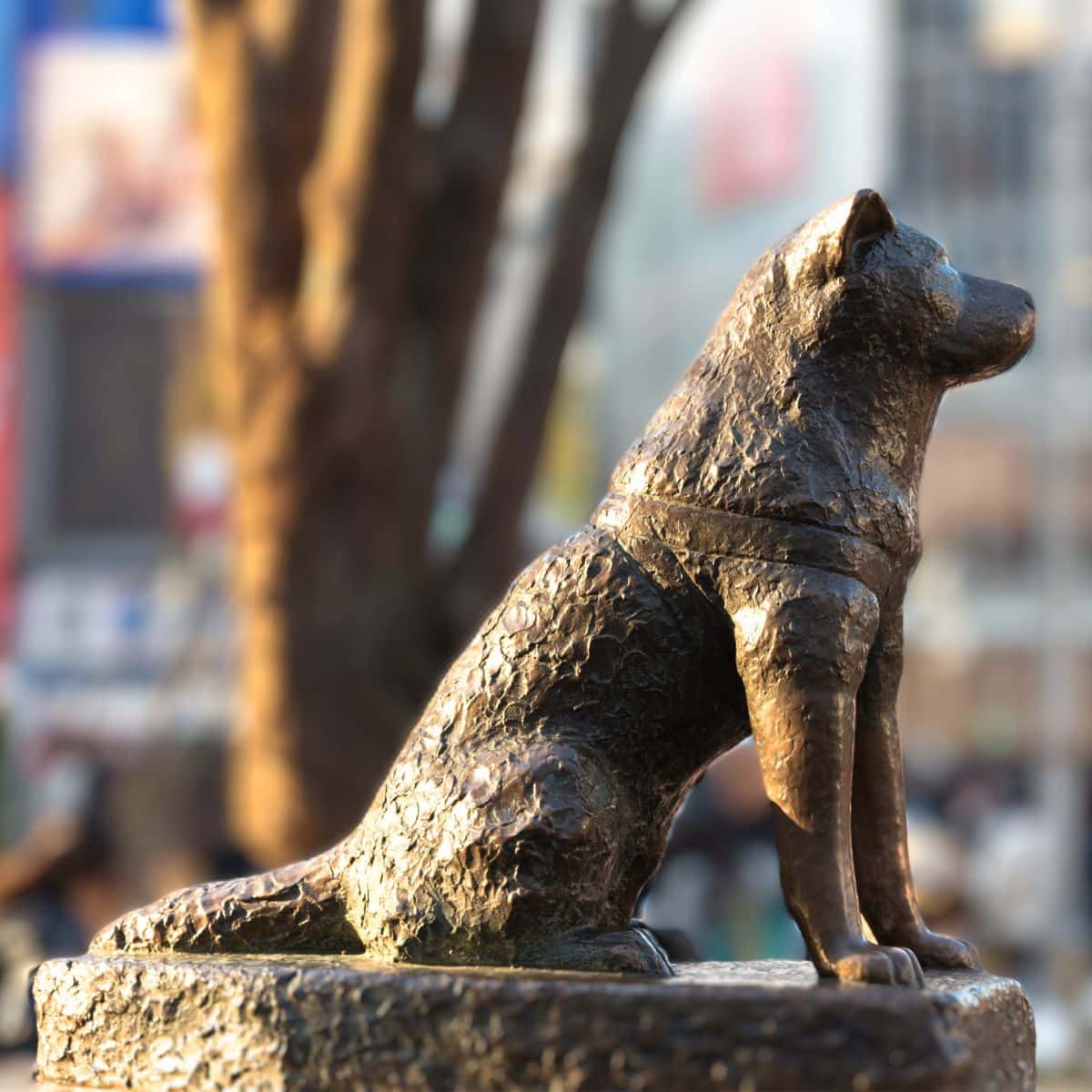
Hachiko Memorial Statue / 3 Days in Tokyo Itinerary
Shibuya Center-Gai , often simply referred to as “Center-Gai,” is a pedestrian street located in Shibuya known for its bustling and vibrant atmosphere. It stretches for about 350 meters and is lined with numerous trendy shops, cafes, restaurants, and bars. It comes alive in the evening and it is a great spot to come back at the end of the day and hang out.
Here are a few places worth checking out:
- WEGO – WEGO is a popular Japanese fast fashion brand known for its trendy and affordable clothing, accessories, and cosmetics.
- Supreme – Supreme is a brand that originated in New York City and has gained a cult following around the world. It offers limited-edition apparel, accessories, and collaborations with various artists and designers.
- Disney Store – The Disney Store in Shibuya Center-Gai is a must-visit for Disney fans.
- Village Vanguard – Village Vanguard is a unique and eclectic store that offers a wide range of quirky and unconventional items, including books, stationery, novelty goods, and unusual gifts.
- Tower Records – Tower Records in the Shibuya Center-Gai location is known for its extensive collection of music, including CDs, vinyl records, and DVDs.
- Don Quijote – Don Quijote is a famous discount store chain. The Shibuya Center-Gai location is a multi-floor store where you can find everything from cosmetics, snacks, electronics, household goods, and souvenirs.
- Nonbei Yokocho – Nonbei Yokocho, also known as “Drunkard’s Alley,” is a narrow alleyway near Center-Gai that offers a nostalgic and retro atmosphere. It’s lined with small izakayas (Japanese-style pubs) and bars, known for their cozy and intimate settings. It’s a great place to come back to in the evening and experience the traditional Japanese drinking culture, and enjoy local food and drinks.
- Tokyu Hands – Tokyu Hands is a well-known department store and the Shibuya Center-Gai location is a multi-floor store where you can find a diverse range of products, including home goods, stationery, and beauty products.
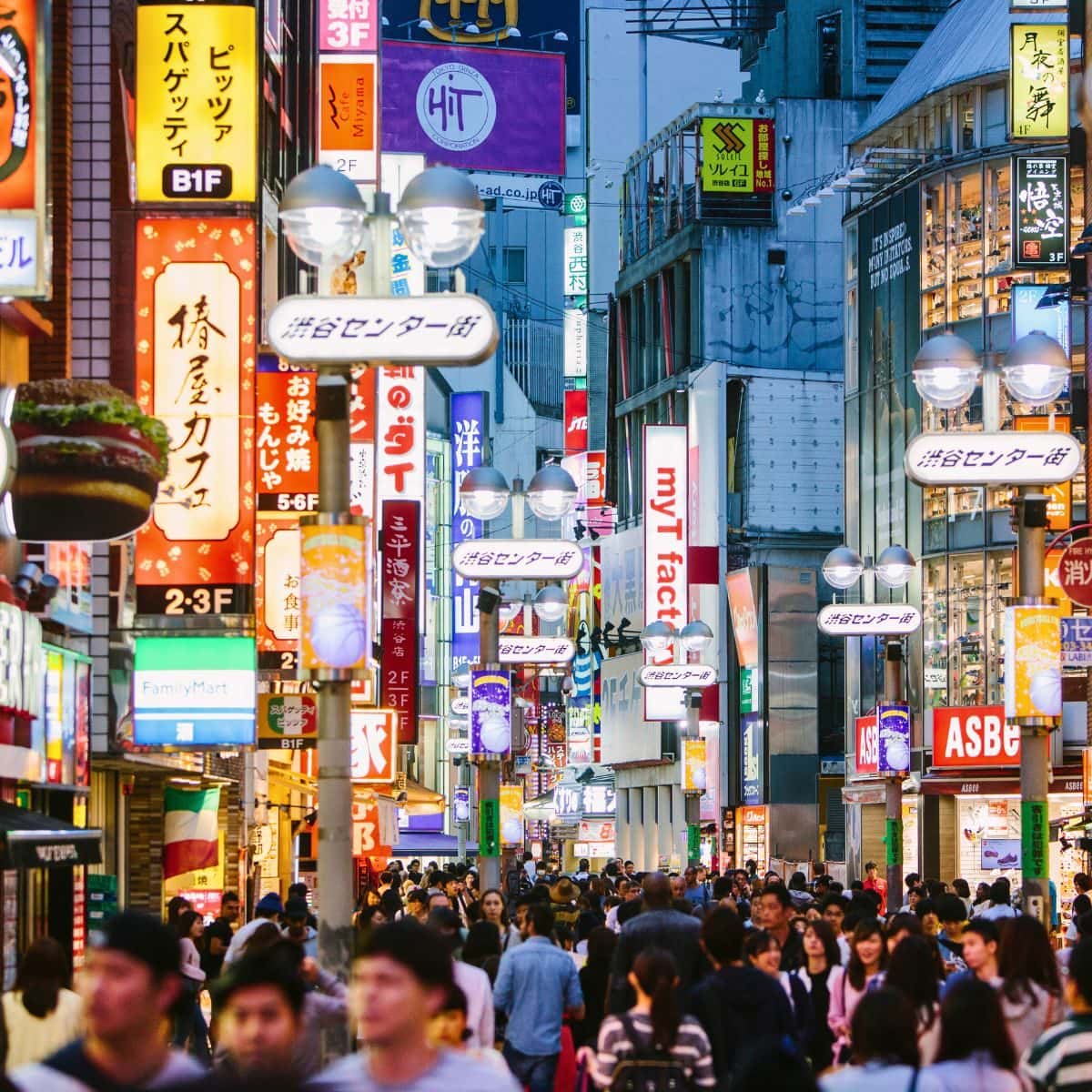
Shibuya Center-Gai in the evening / 3 Days in Tokyo
Next, we are going to a famous neighborhood in Shibuya called Harajaku. The main attractions here are Yoyogi Park, Meiji Shrine, the famous Takeshita Street, and Omotesando.
Yoyogi Park is a spacious public park that offers a peaceful retreat from Tokyo’s hustle and bustle. If you are visiting from late March through early April, then Yoygi Park is the best spot for hanami , which is the traditional Japanese custom of enjoying the beauty of cherry blossoms.
Sunday is a great day to stop by Yoyogi Park. It becomes a gathering spot for street performers, musicians, and artists who showcase their talents to the public.
Adjacent to Yoyogi Park is the serene Meiji Shrine . It was established in 1920 and was dedicated to Emperor Meiji, who passed away in 1912, and Empress Shoken, who passed away in 1914. The shrine was built as a place of worship and to honor the Emperor and Empress for their contributions to Japan’s modernization and development during the Meiji era (1868-1912).
The shrine complex has a simple and elegant design. The main entrance to the shrine features a towering torii gate made of cypress wood, which is one of the largest wooden torii gates in Japan.
The pathway leading to the main shrine building is lined with tall trees, creating a sense of tranquility and serenity.
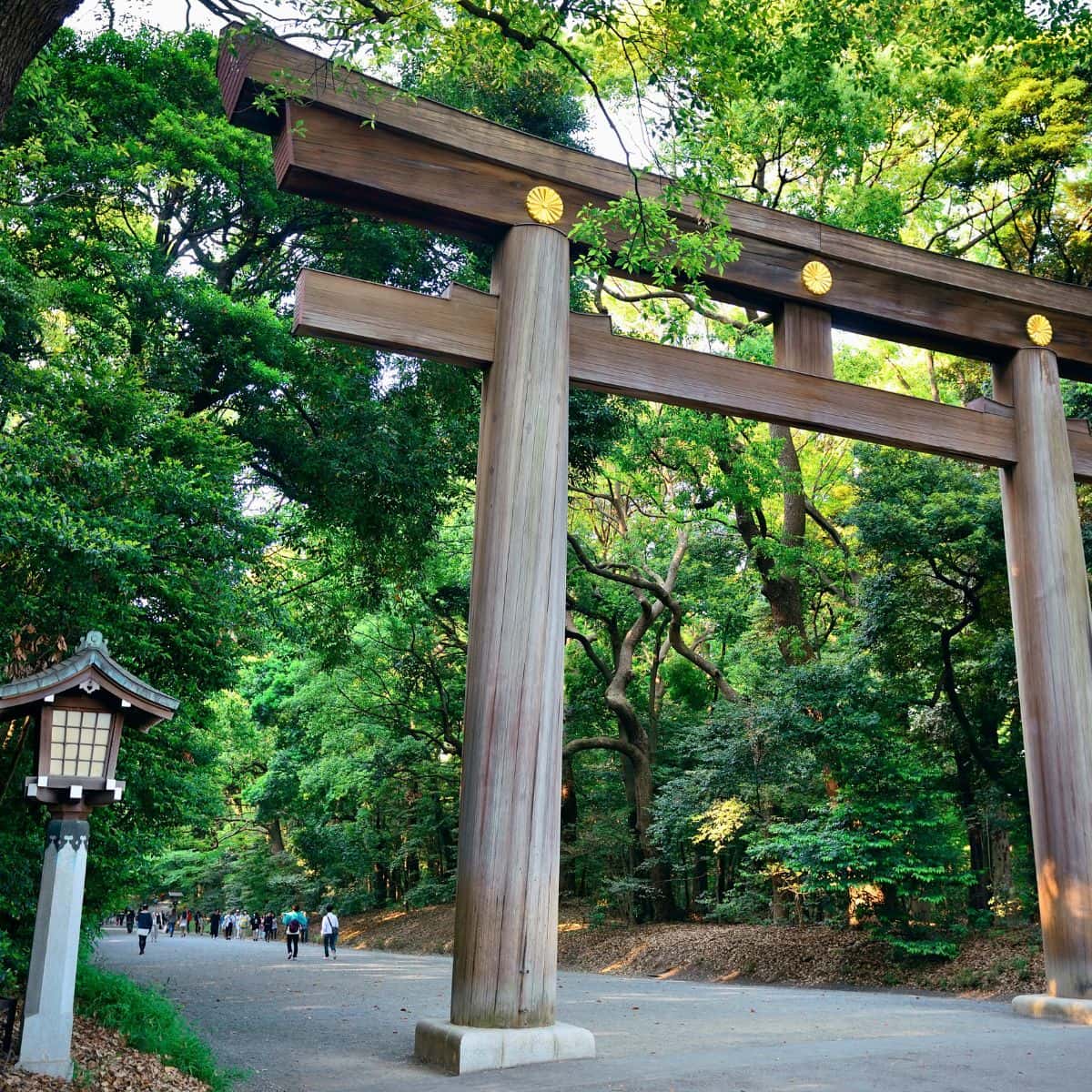
Torii Gate leading to Meiji Shrine / 3 Days in Tokyo
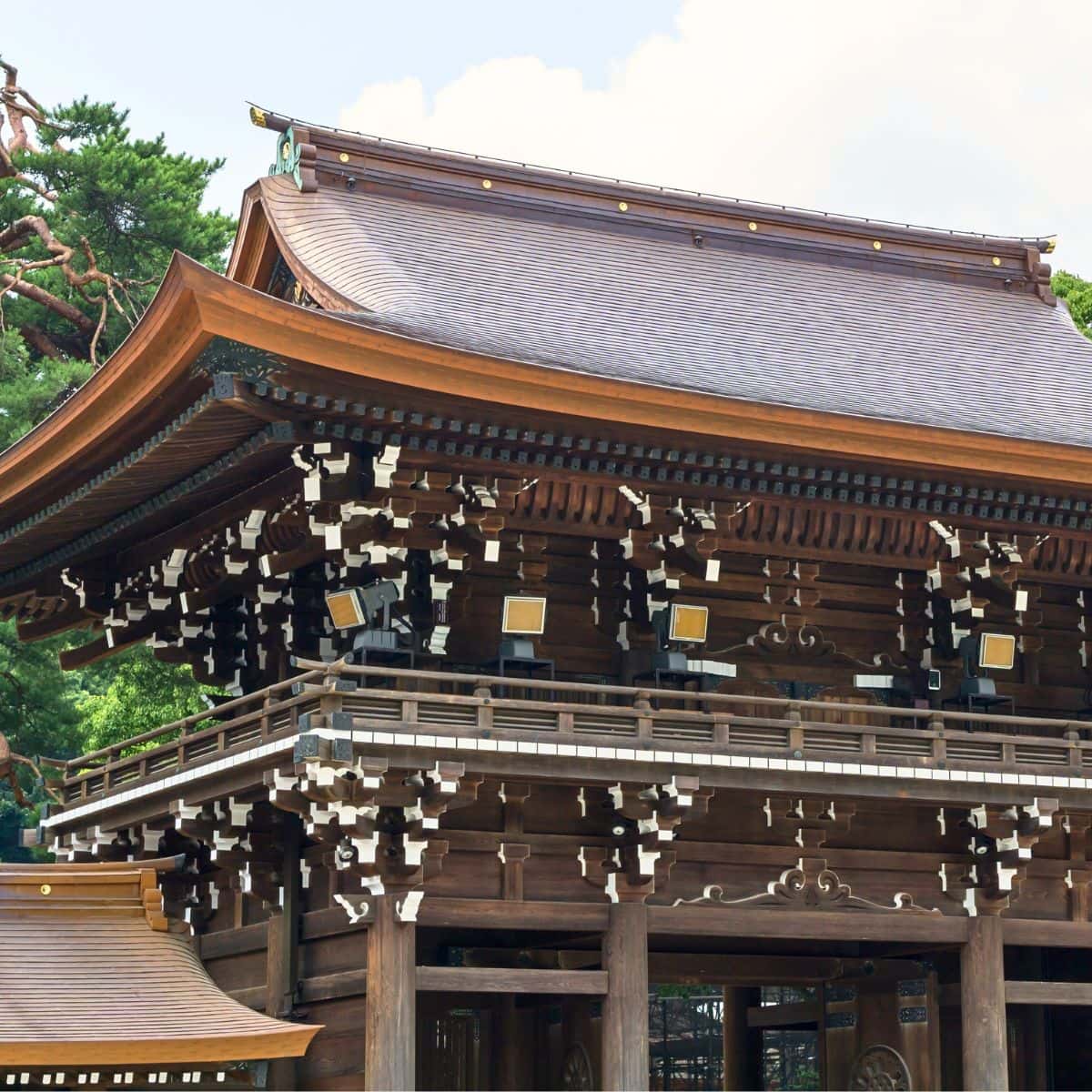
Meiji Shrine / 3 Days in Tokyo
One of the main attractions of Harajuku is Takeshita Street . It is a narrow pedestrian-only street lined with fashion boutiques, trendy cafes, and vibrant street food stalls.
Takeshita Street is famous for its unique fashion styles, ranging from Lolita fashion , which features elaborate Victorian-inspired dresses, to cosplay , which involves dressing up as characters from anime, manga, or video games.
Here are a few places on Takeshita Street that you should check out:
- Kawaii Monster Cafe – It is a colorful and quirky cafe that offers a unique dining experience. The interior features vibrant colors, whimsical decorations, and performances by costumed staff. The menu includes colorful and Instagram-worthy dishes, such as rainbow pasta and monster-themed desserts.
- Totti Candy Factory – One of the highlights of Totti Candy Factory is its giant rainbow cotton candy. They offer other sweets as well, such as candy apples coated in colorful candy and decorated with various toppings like sprinkles, cookies, and chocolates. They also have a selection of colorful lollipops and gummy candies.
- Crepe Stalls – Takeshita Street is famous for its crepe stalls. My two favorite ones are Marion Crepes and Angel Crepes. They offer a variety of sweet and savory crepes filled with delicious ingredients such as fresh fruits, whipped cream, chocolate, and more.
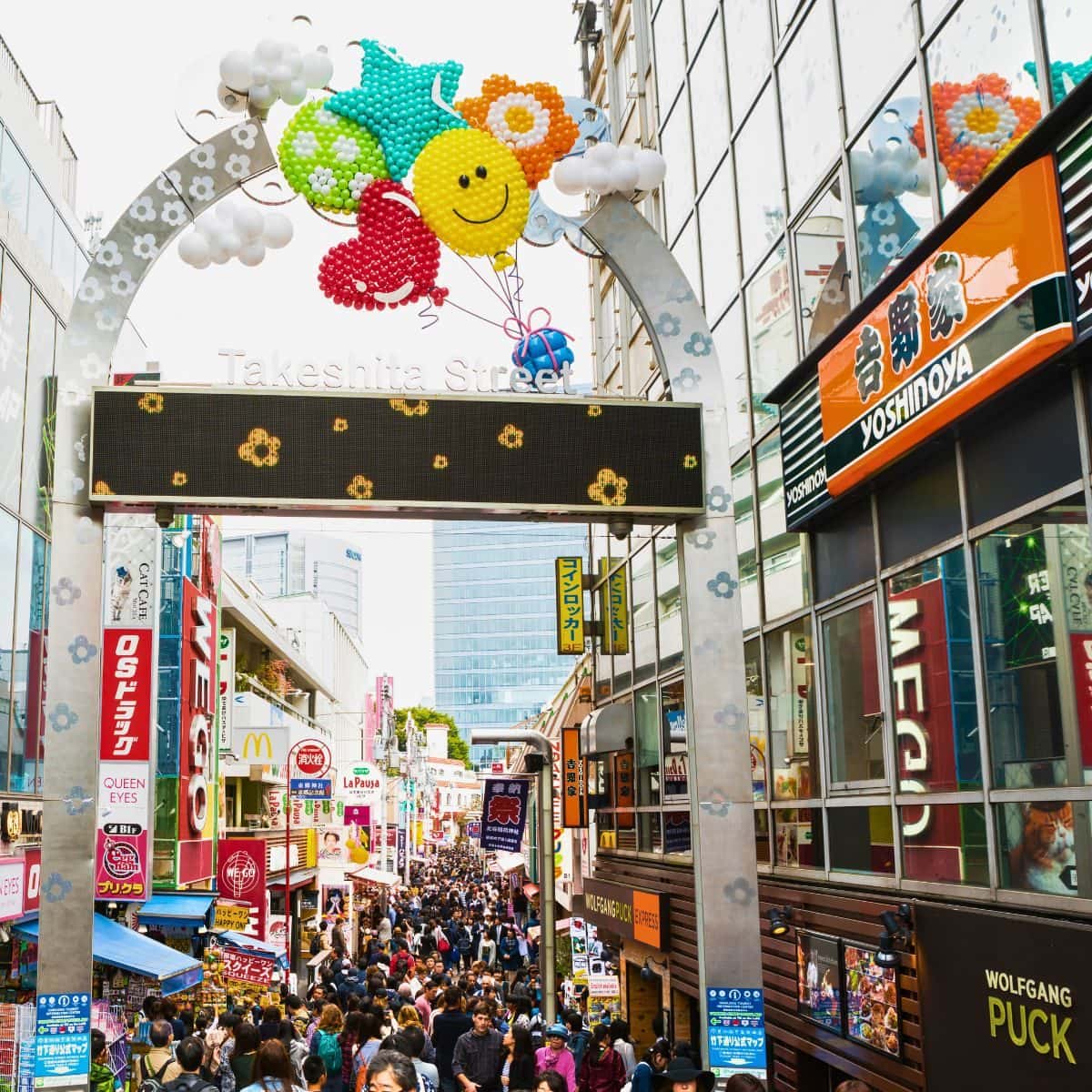
Takeshita Street / 3 Days in Tokyo
Omotesando Avenue, a tree-lined boulevard, also known as Tokyo’s Champs-Élysées, is another prominent street in Harajuku. It is famous for its upscale fashion boutiques, luxury brand stores, and architectural marvels.
Some of the places that you should check out on Omotesando Avenue are Tokyu Plaza Omotesando Harajuku . It is a shopping complex with a distinctive mirrored entrance. While you are there head out to their rooftop terrace for great views of Tokyo!
Another great place is Kiddy Land . It is a paradise for toy lovers! Kiddy Land is a multi-story toy store that offers a wide selection of toys, character goods, and collectibles. It’s a fun place to explore and reminisce about your childhood memories.
And, finally, do not miss the Prada Building , an iconic architectural landmark designed by Swiss firm Herzog & de Meuron. The Prada Building is the flagship store of the luxury brand Prada. It’s unique glass facade and futuristic design make it a must-visit.
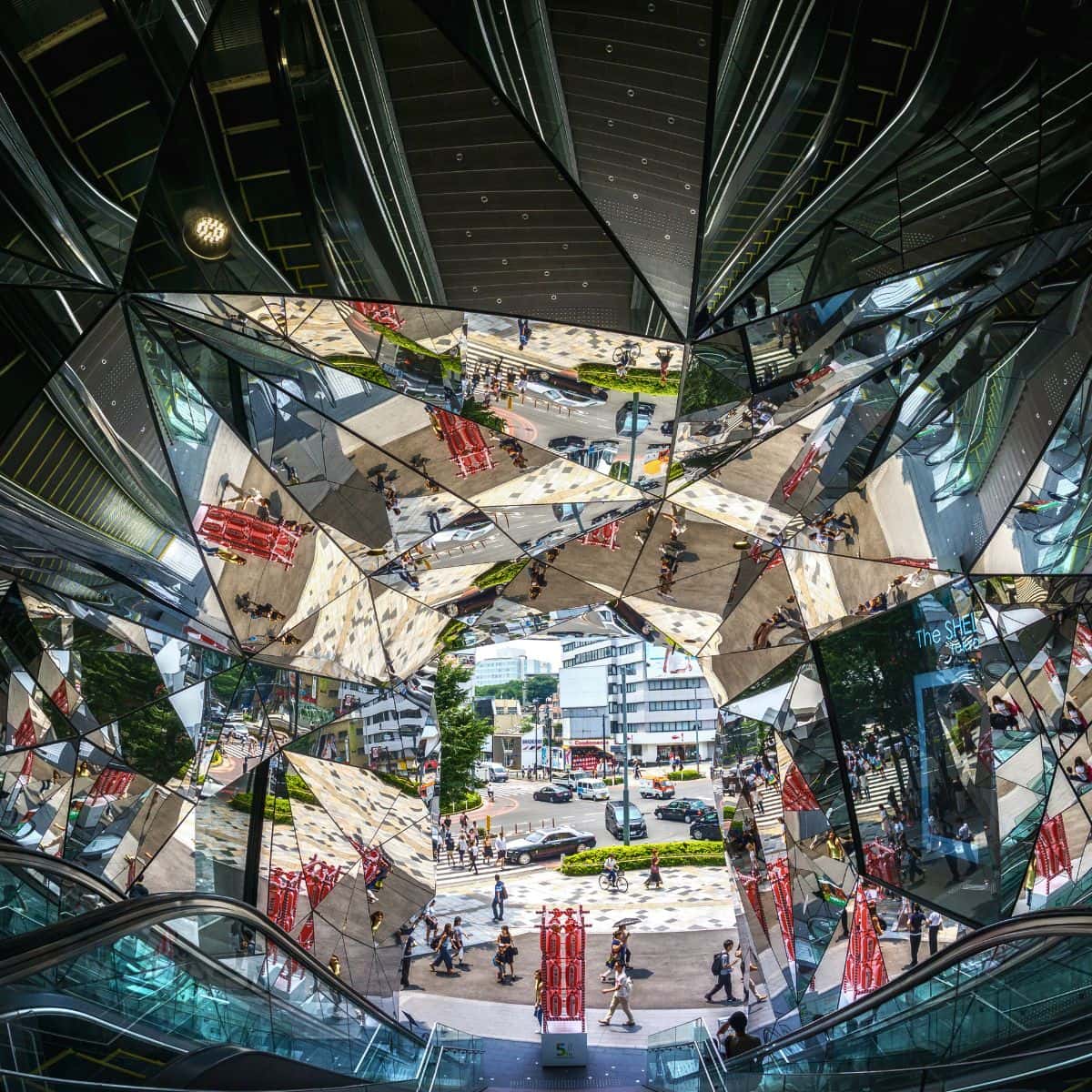
Tokyu Plaza Omotesando / 3 Days in Tokyo
Intrepid’s Tip:
Find Out More About Shibuya
Next, we are heading out to Shinjuku and the first stop is Tokyo Metropolitan Government Building.
Tokyo Metropolitan Government Building , also known as Tokyo City Hall or Tochō for short, is a prominent landmark in Tokyo, Japan.
It was designed by architect Kenzo Tange and completed in 1991. It consists of two twin towers, each rising 48 stories high and reaching a height of 243 meters (797 feet). The towers are connected by a large atrium and house various offices and facilities of the Tokyo Metropolitan Government.
One of the main attractions of the Tokyo Metropolitan Government Building is its observation decks , which are located on the 45th floor of each tower and offer stunning panoramic vistas of Tokyo’s skyline and beyond. And, the best part is that admission is free!
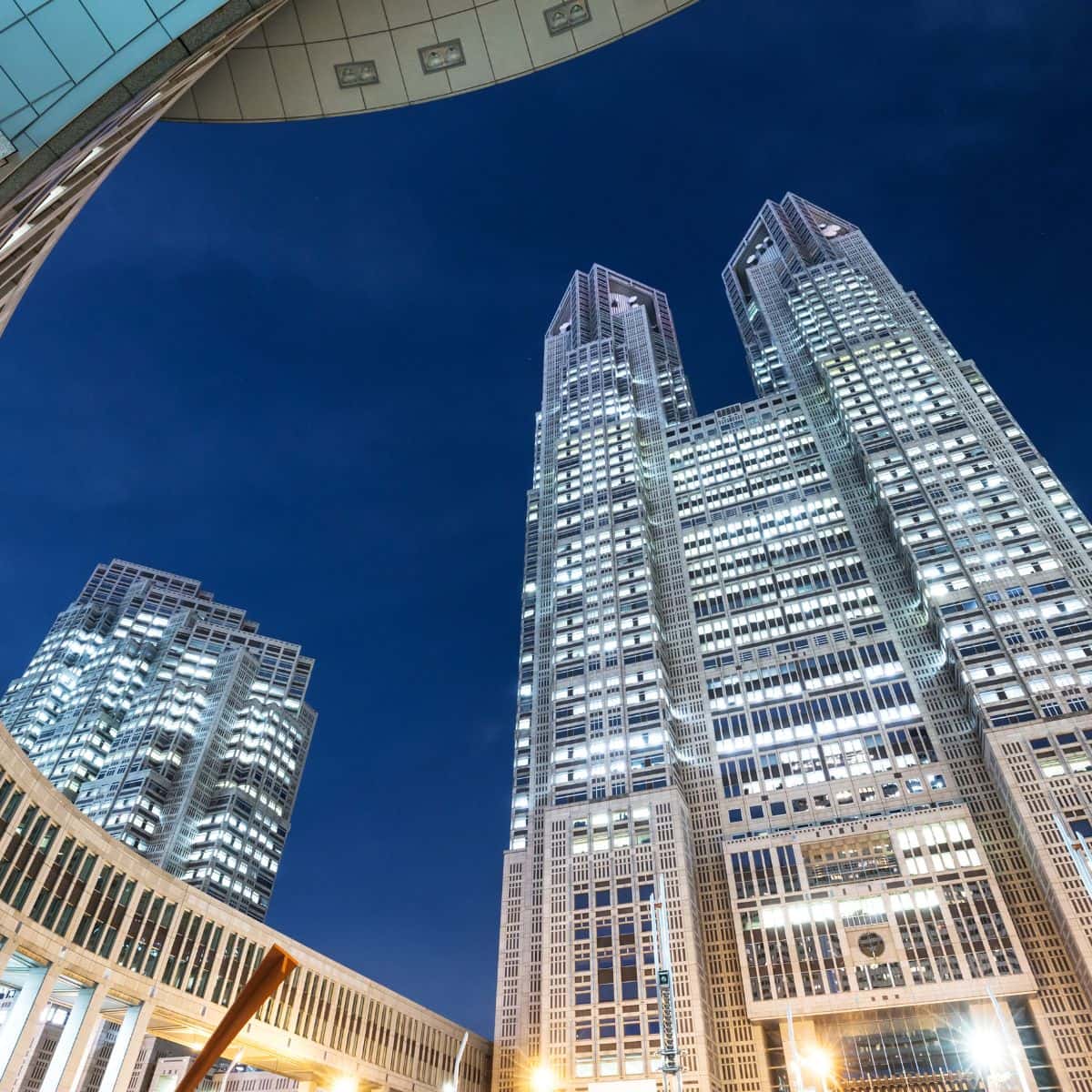
Tokyo Metropolitan Government Building / 3 Days in Tokyo
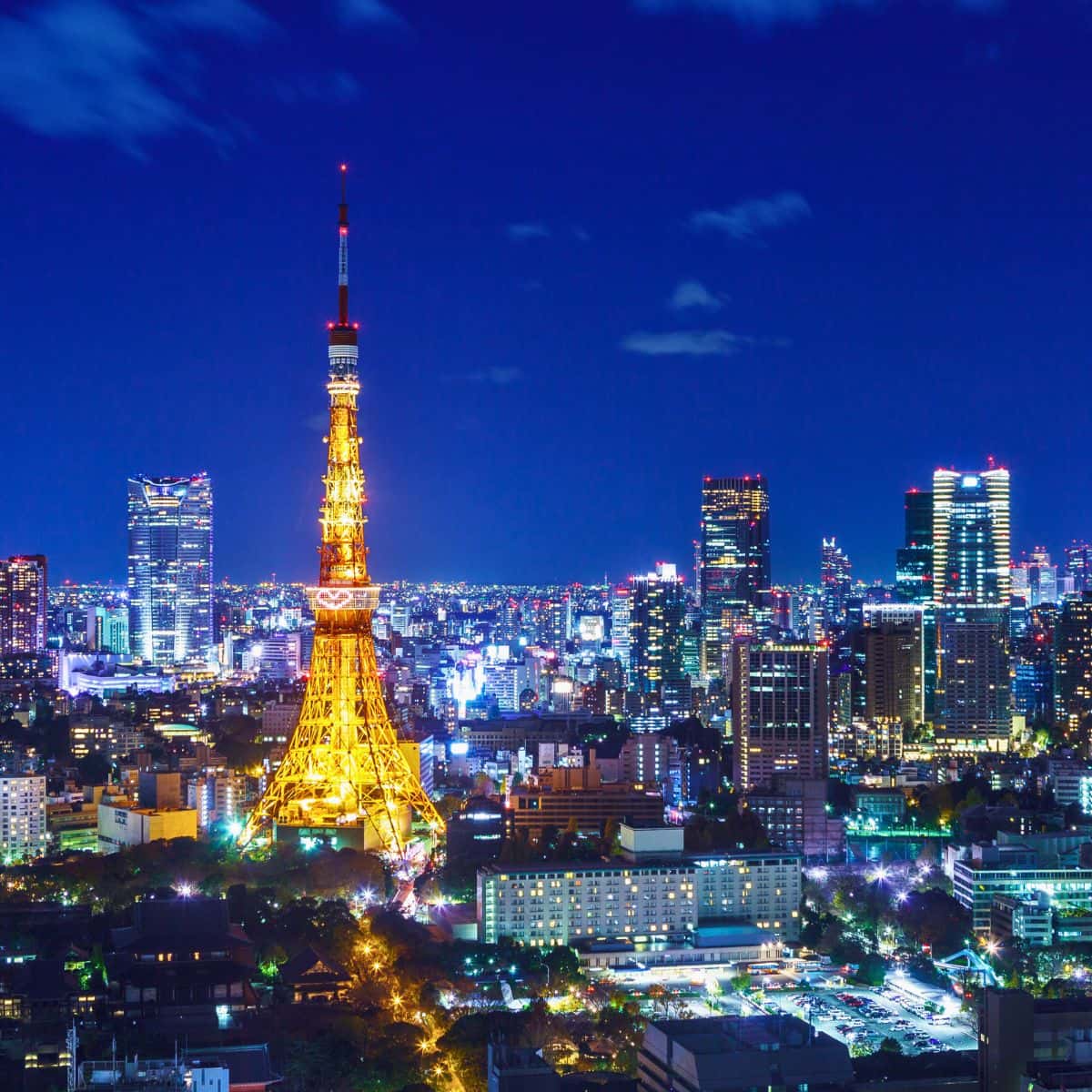
Tokyo skyline / 3 Days in Tokyo
Shinjuku Golden Gai is a network of narrow alleys famous for its atmospheric nightlife.
Each alley is lined with tiny, unique bars that can usually only accommodate a handful of customers at a time. Each bar has its own distinct character and theme, making it a fascinating place to explore and enjoy a drink or two in an intimate setting.
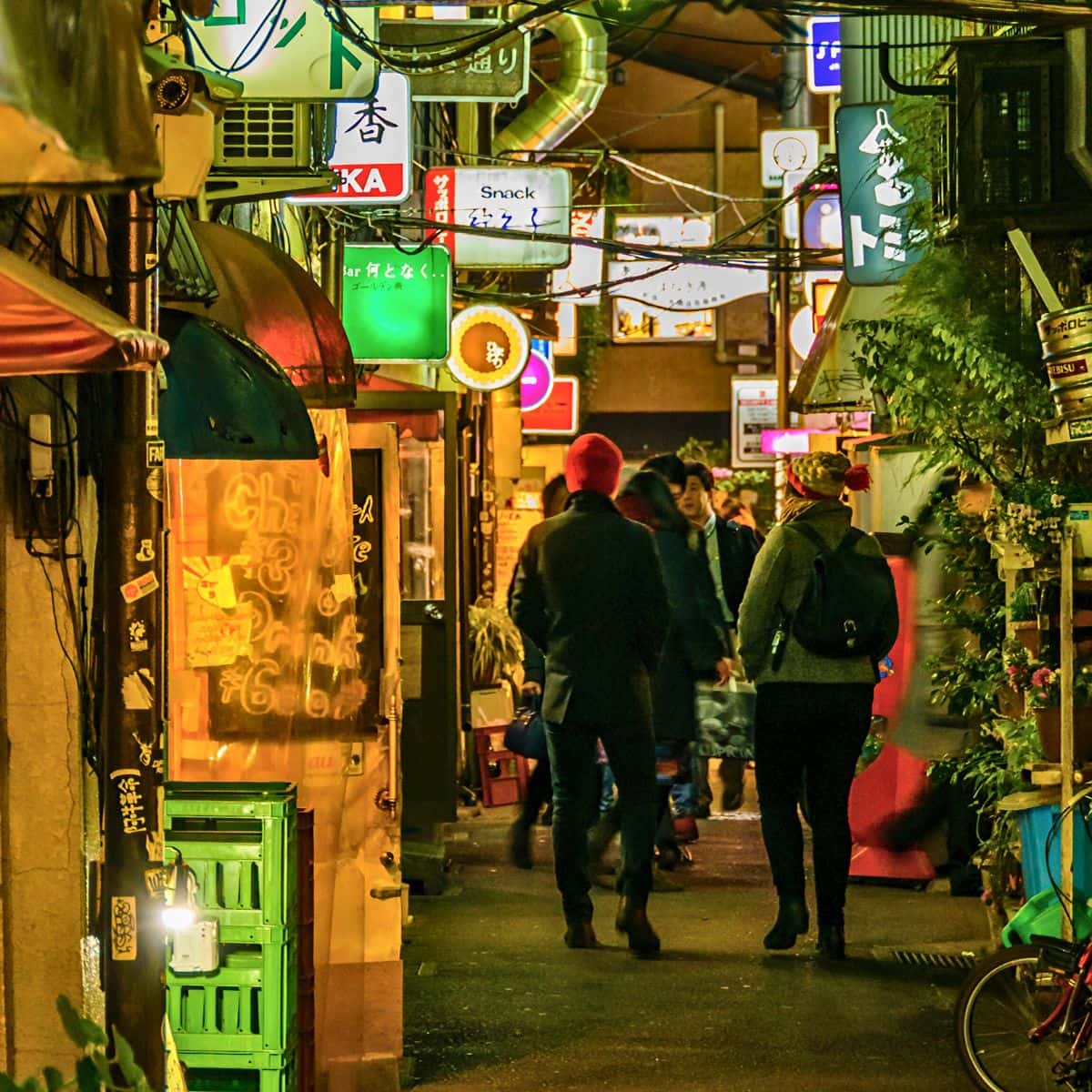
Shinjuku Golden Gai / 3 Days in Tokyo Itinerary
Another spot that you cannot miss in Shinjuku is Omoide Yokocho , also known as “Memory Lane” or “Piss Alley”.
It is a narrow alley lined with small, old-fashioned izakayas (Japanese-style pubs) and yakitori (grilled chicken skewer) stalls, which have preserved their original look and feel from the 1940s and 1950s.
The dimly lit lanterns, narrow passageways, and the smoke rising from the grills create a unique ambiance that is reminiscent of old Tokyo.
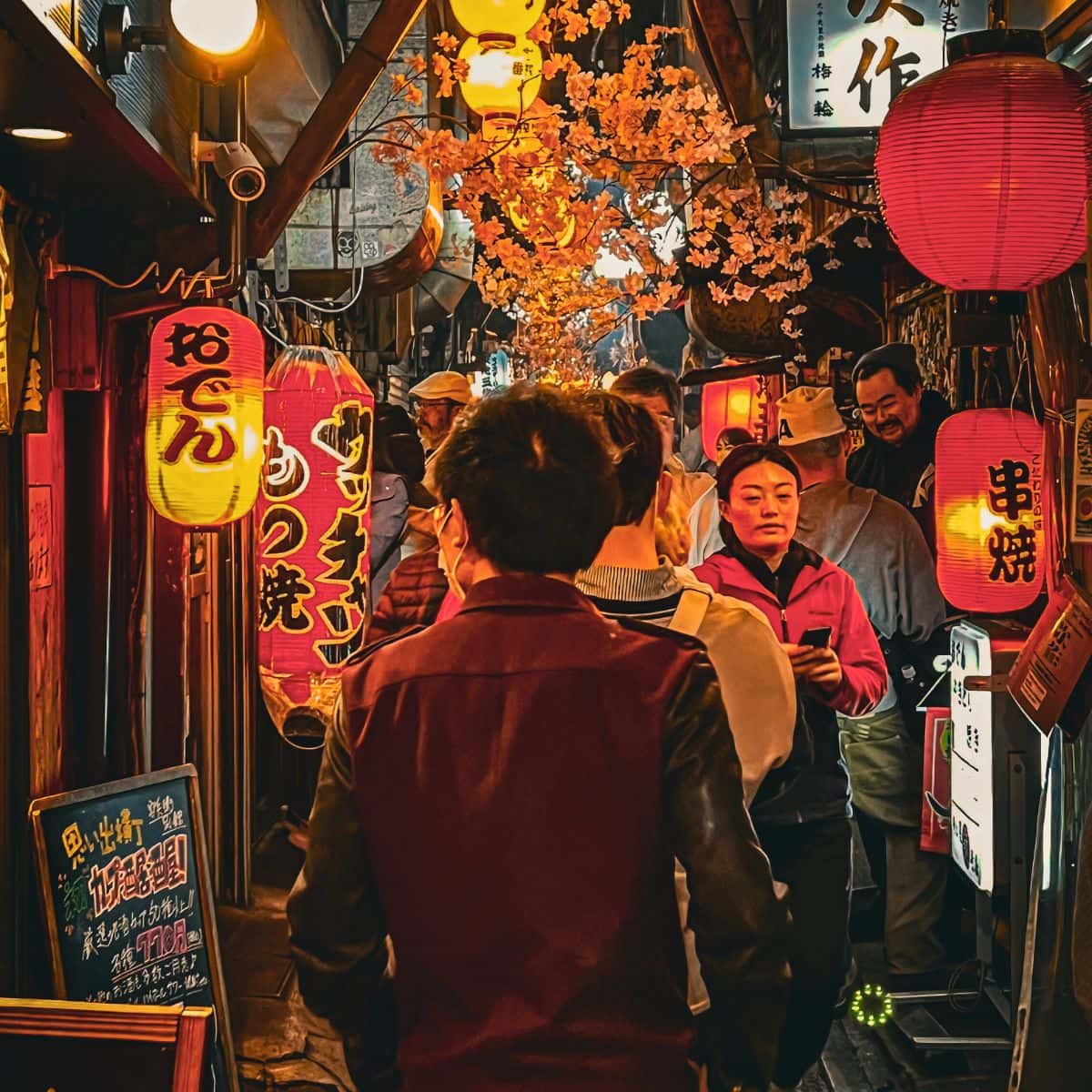
Omoide Yokocho in Shinjuku / 3 Days in Tokyo Itinerary
Another spot that you cannot miss in Shinjuku is Kabukicho . It is a famous entertainment district filled with numerous bars, nightclubs, karaoke venues, and live music venues.
Kabuki-Cho Godzilla Head is an iconic landmark of Kabukicho. It is located on the rooftop of the Toho Cinema building. The Godzilla Head roars and spews smoke at regular intervals.
Kabukicho is also known for its adult-oriented entertainment , such as hostess clubs, love hotels, and adult-themed establishments.
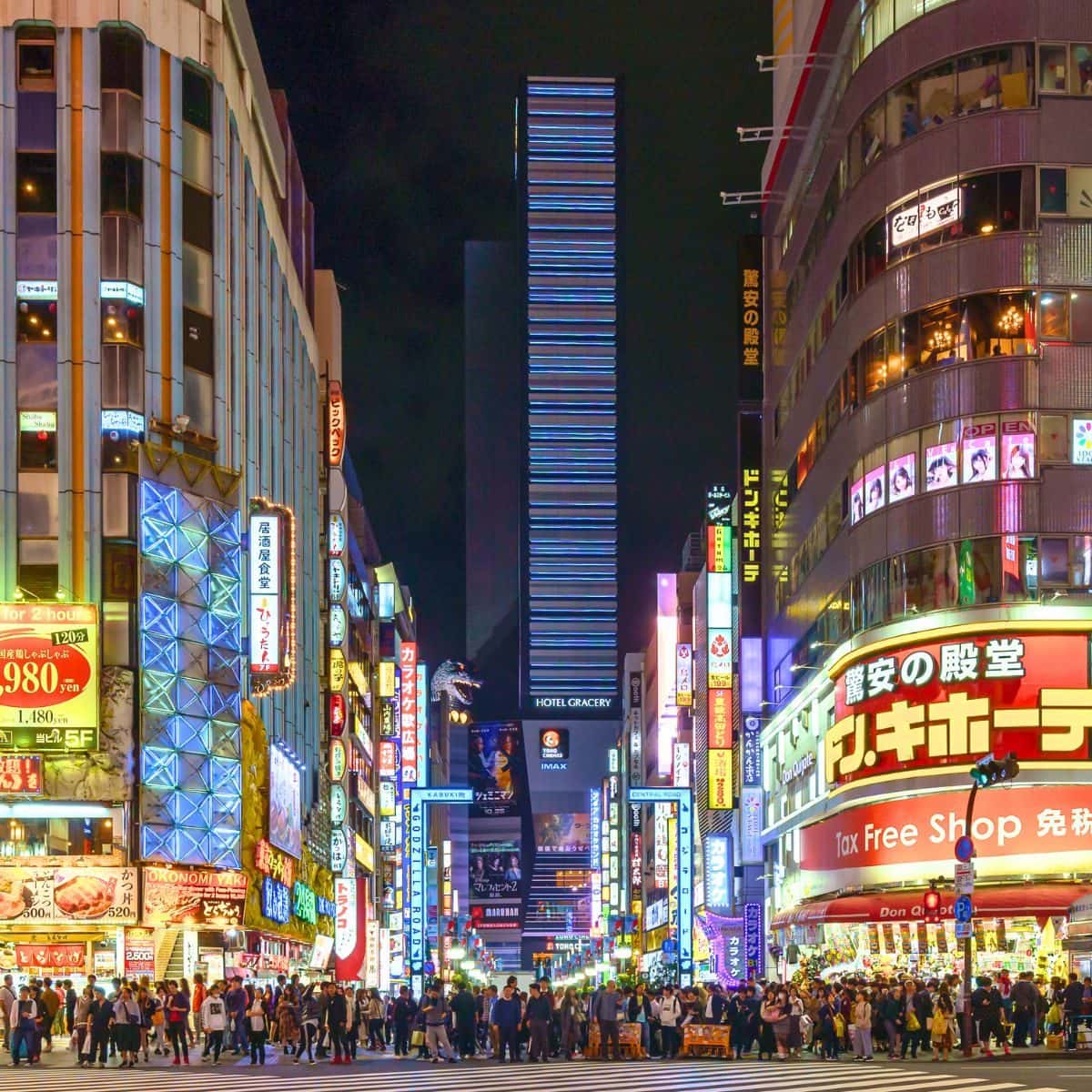
Kabukicho District / 3 Days in Tokyo Itinerary
This concludes the first day of 3 days in Tokyo itinerary.
If you have any energy left, then my recommendation is to head out to the Robot Restaurant . It is a popular tourist attraction located in Shinjuku.
It is not actually a restaurant in the traditional sense, but rather a live entertainment venue featuring robot performances, bright neon lights, and colorful decorations.
Another idea is to schedule a Harajuku and Shibuya Evening Walking Tour . This a fun evening tour in two of Tokyo’s trendiest and most vibrant districts. You will discover hidden hotspots and under-the-radar neighborhood gems in Harajuku and Shibuya, and duck into cutting-edge boutiques. The tour includes a savory, Japanese-style dinner with local treats.
Sensoji Temple
Tokyo national museum.
- Akihabara District
Maid and Gundam Cafes
Anime and manga shops.
- Arcade. and Game Centers
- Rent a Go-Cart in Akihabara
We start day 2 of 3 days in Tokyo itinerary in Asakusa District . It is located in the northeastern part of Tokyo’s Taito City, near the Sumida River.
Asakusa is known for its historical and cultural significance, with many traditional Japanese landmarks and attractions.
The first stop is Sansoji Temple .
Sensoji Temple, also known as Asakusa Kannon Temple, is a historic Buddhist temple dating back to the 7th century.
According to legend, Sensoji Temple was founded in 628 AD, when two fishermen discovered a small golden statue of Kannon, the Buddhist goddess of mercy, in the nearby Sumida River. The fishermen enshrined the statue, and a small temple was built to honor it, making Sensoji Temple one of the oldest temples in Tokyo.
Sensoji Temple is a large complex that includes several main buildings, gates, and other structures. One of the most iconic features of the temple is the Kaminarimon Gate , which serves as the entrance gate to the temple grounds. The gate is adorned with a large red lantern and a massive wooden statue of Fūjin, the Shinto god of wind, on one side, and Raijin, the Shinto god of thunder, on the other side.
Beyond the Kaminarimon Gate is Nakamise-dori , a bustling shopping street lined with small shops selling various traditional Japanese goods such as snacks, sweets, souvenirs, and crafts.
Nakamise-dori leads to the Hozomon Gate , which provides access to the main hall of Sensoji Temple.
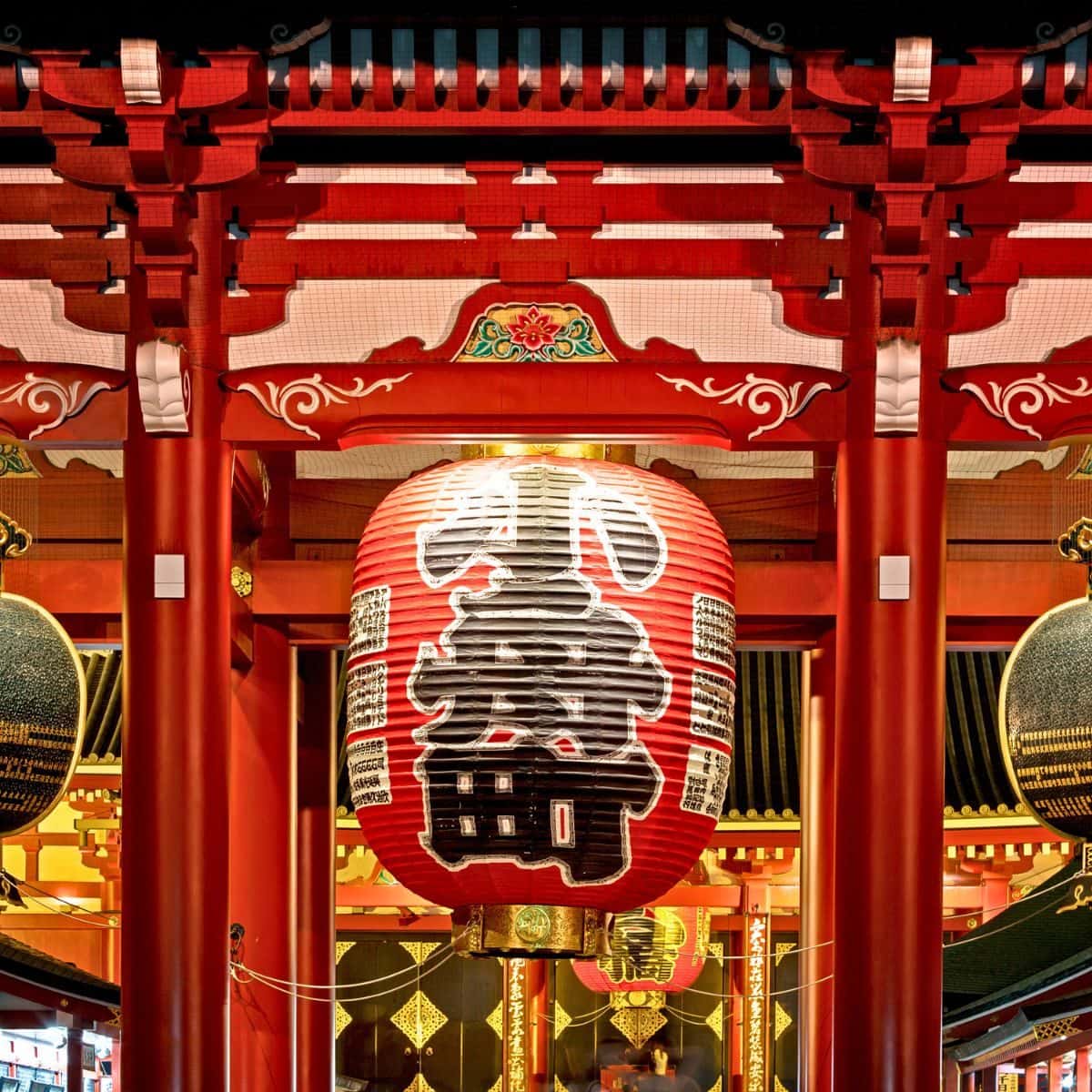
Sensoji Temple / 3 Days in Tokyo Itinerary
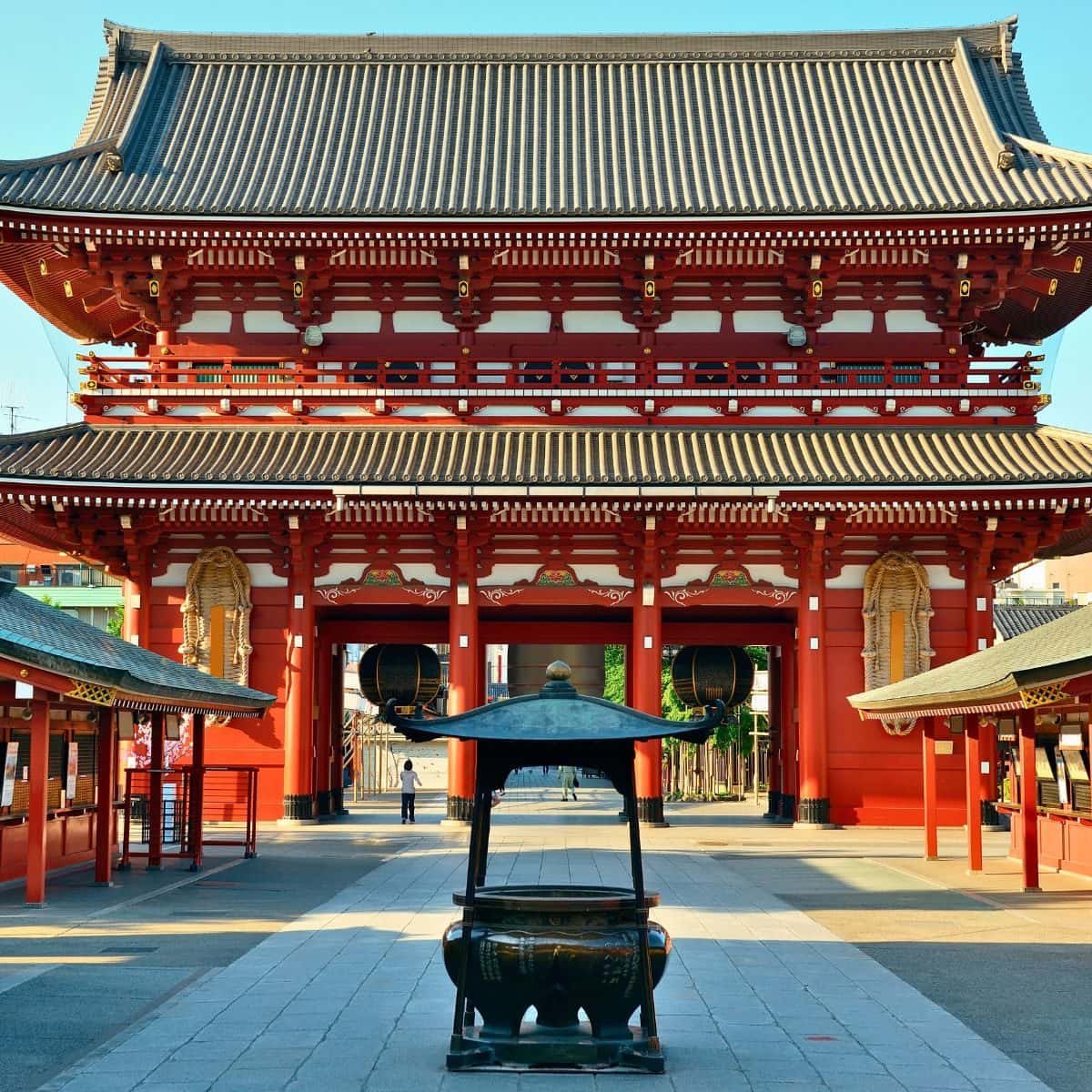
The next stop is an amazing Tokyo National Museum .
The museum is divided into several exhibition buildings, each with its own focus.
The Honkan (Japanese Gallery) is the main building and displays a comprehensive collection of Japanese art and artifacts, including Buddhist sculptures, samurai armor, ukiyo-e woodblock prints, and traditional crafts.
The Toyokan (Asian Gallery) houses a diverse collection of Asian art, including Chinese bronzes, Korean ceramics, and Indian sculptures.
The Heiseikan (Special Exhibition Gallery) features special exhibitions on various themes and periods, showcasing rare and important works of art from Japan and other Asian countries.
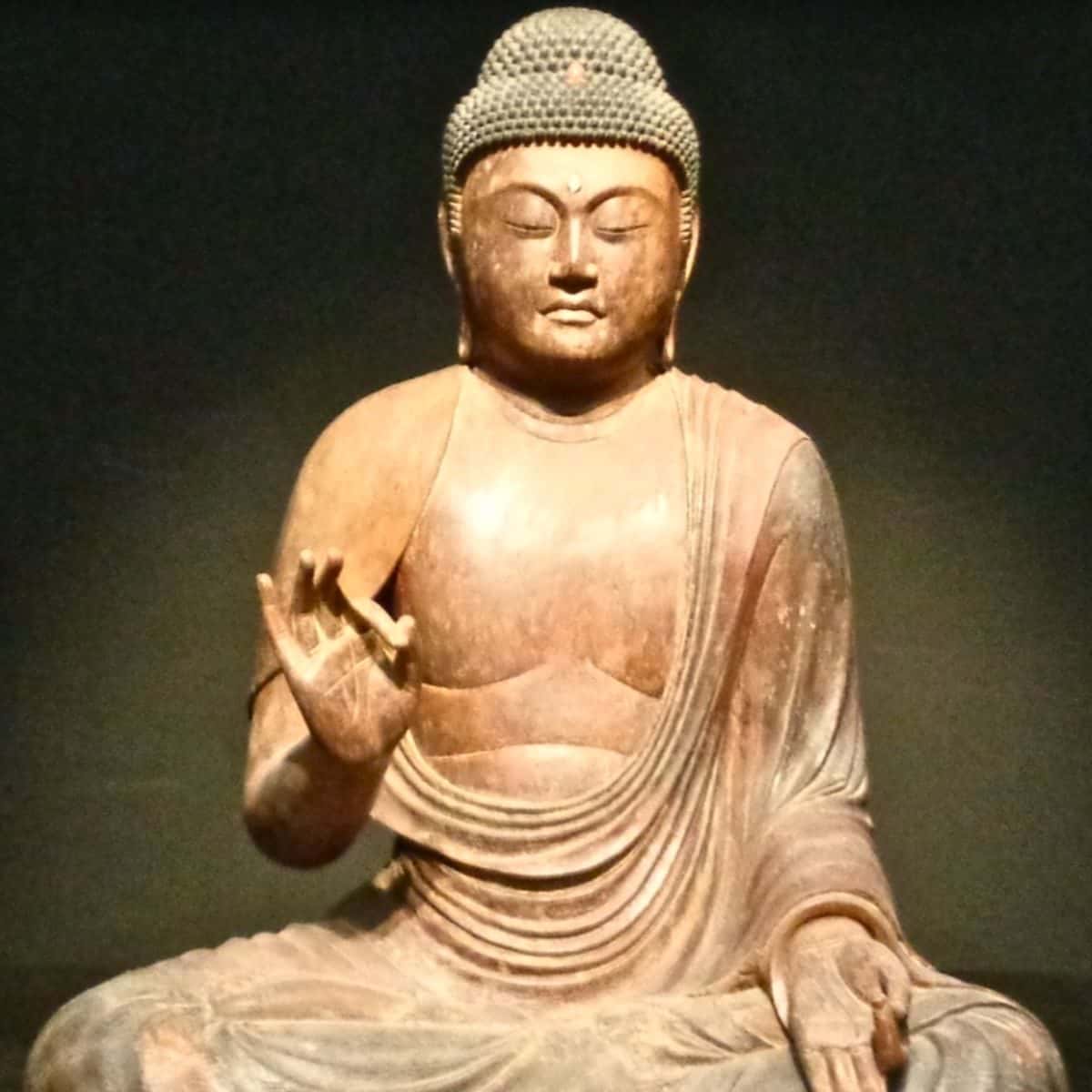
Tokyo National Museum / 3 Days in Tokyo Itinerary
Akihabara District - Electric Town
Next, let’s explore Akihabara District .
Akihabara, also known as “Electric Town” , is famous for its electronics stores, anime, manga, and gaming culture.
You will find numerous electronics stores that sell a wide range of gadgets, devices, and components. From the latest smartphones and computers to retro video game consoles and DIY electronics, you can find it all in Akihabara. Some popular stores to check out include Yodobashi Camera , Bic Camera , and Sofmap .
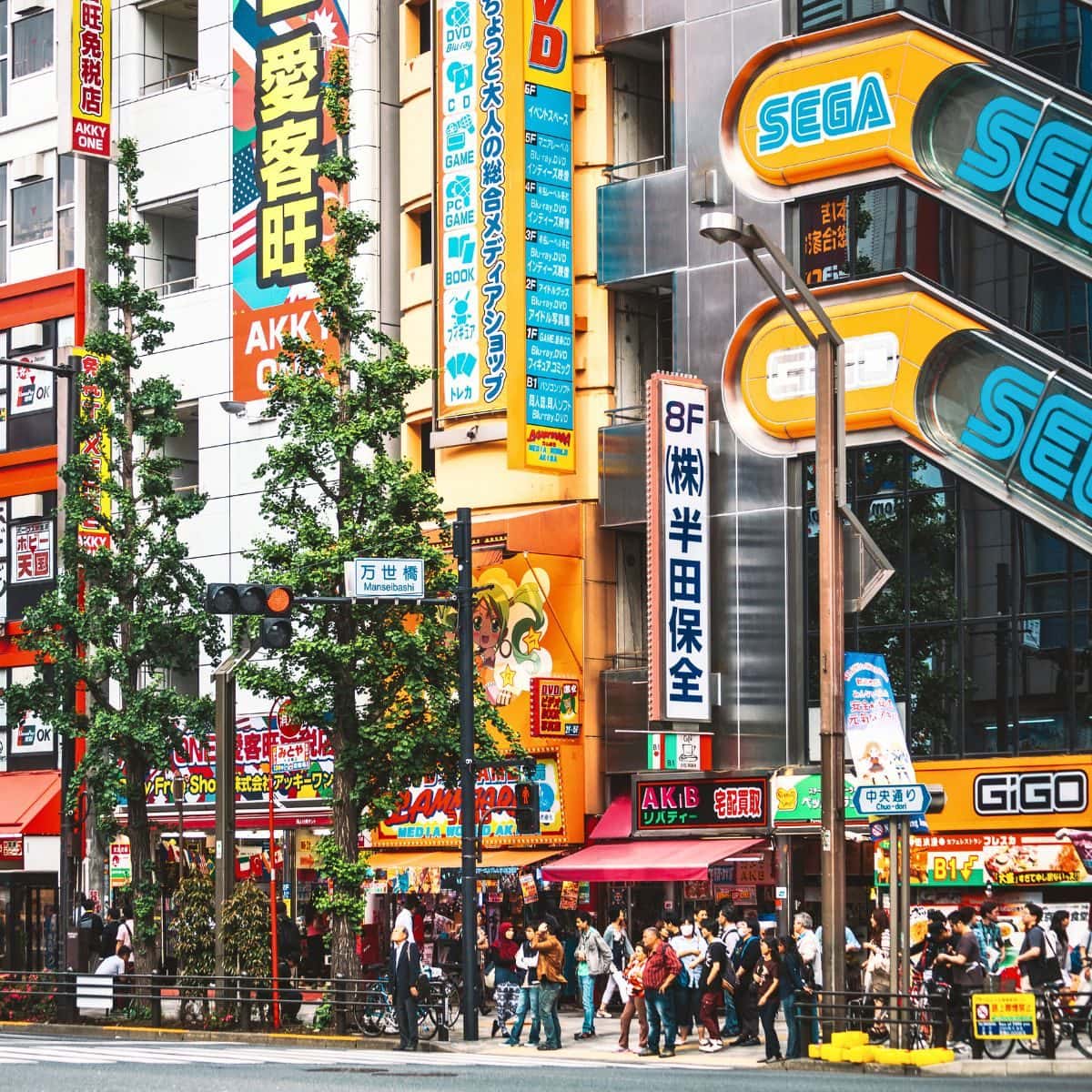
Akihabara District – Electric Town / 3 Days in Tokyo Itinerary
Akihabara remains the most well-known and popular location for maid and Gundam cafes .
The maid cafes are themed around waitresses dressed in cute maid costumes which are often elaborate and reminiscent of French maids. The waitresses adopt a friendly and cute demeanor, and address customers with terms like “master” or “mistress”.
The overall atmosphere is playful, welcoming, and definitely a one-of-a-kind experience where you can immerse yourself in the kawaii (cute) culture of Japan.
Here are a couple of maid cafes worth checking out:
- @Home Cafe – It is one of the oldest and most well-known maid cafes in Akihabara. It features a classic maid cafe theme with cute and friendly maids, playful performances, and a wide range of cutely decorated food and drinks on the menu.
- Maidreamin – It is a popular maid cafe chain with multiple locations in Akihabara and other parts of Japan. They offer a variety of cute and creative dishes, as well as entertaining performances and interactive games.
- Cure Maid Cafe is known for its Gothic Lolita theme, which features maids dressed in Victorian-style outfits with a darker and more elegant atmosphere compared to traditional maid cafes. They offer a unique twist on the maid cafe concept, with a focus on the Gothic and Lolita fashion subculture.
Gundam cafes are themed cafes that are based on the popular Japanese anime and manga franchise called Gundam.
Gundam is a long-running media franchise that originated in 1979 and features giant humanoid robots known as “mobile suits” or “Gundam”.
The cafes often have a futuristic and high-tech ambiance, with displays of Gundam models, posters, and artwork adorning the walls. The menu usually includes Gundam-themed food and drinks, such as burgers shaped like mobile suits, and Gundam-inspired desserts.
Some of the popular Gundam cafes are:
- Gundam Cafe Akihabara is an official Gundam-themed cafe located in the heart of Akihabara. It features a futuristic atmosphere with Gundam-themed decor, displays of Gundam models, and a variety of Gundam-inspired food and drinks on its menu.
- Gundam Cafe & Bar Akihabara is another official Gundam-themed. It offers a wide range of Gundam-themed food and drinks, including cocktails and other alcoholic beverages.
- CharaRIDE Akihabara is a Gundam-themed cafe that also offers a virtual reality (VR) experience that allows visitors to pilot a virtual Gundam and engage in virtual battles.
One of the best ways to see Akihabara and understand its unique culture is to join a guided tour. I attended this tour Akihabara Culture Tour and I liked it a lot. The guide was from Akihabara and a cosplayer. She had an incredible knowledge of anime, manga, arcades, and game centers.
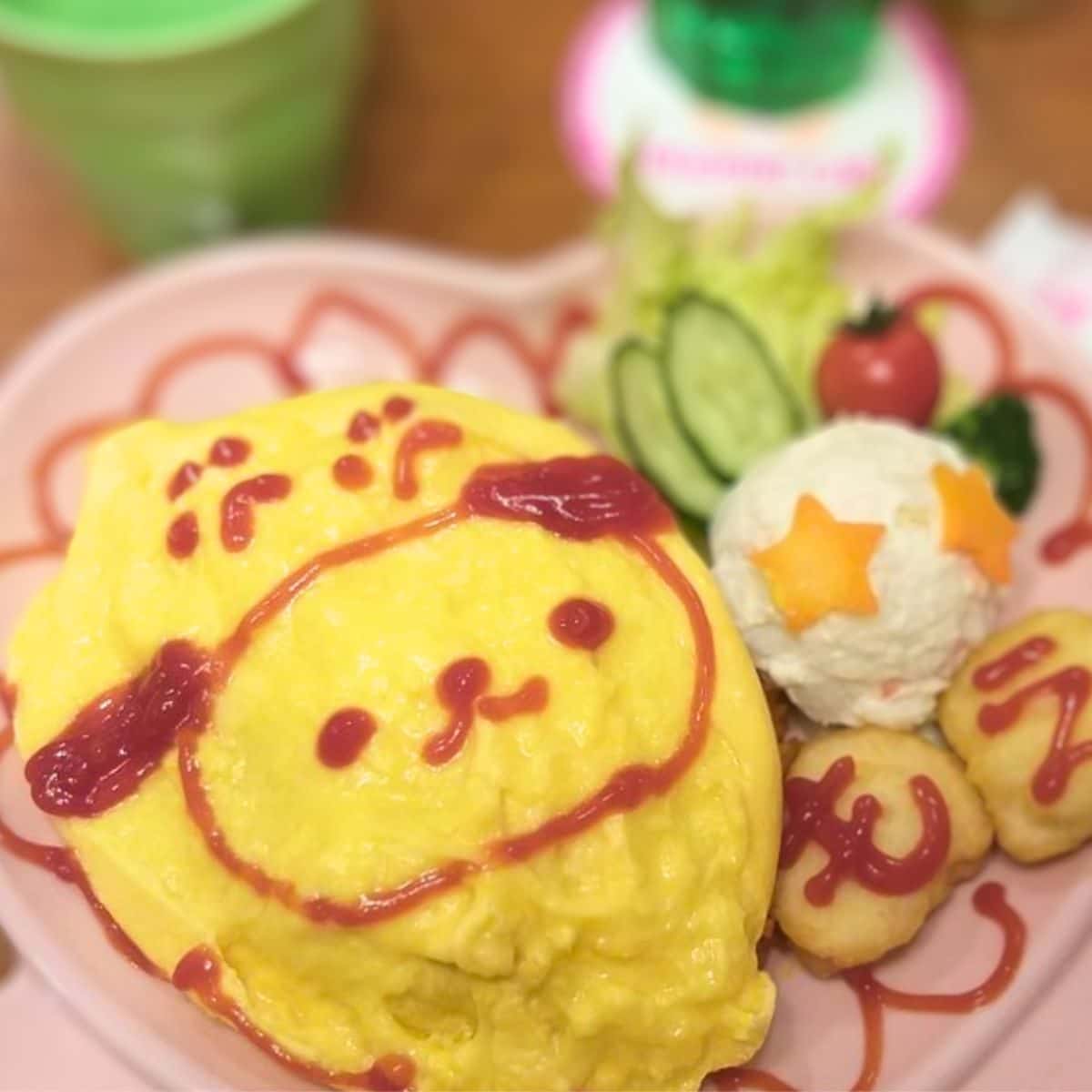
Cutely decorated food at @Home Cafe / 3 Days in Tokyo Itinerary
Akihabara is a paradise for anime and manga lovers . There are numerous shops selling manga, anime merchandise, collectibles, and cosplay costumes. Places like Animate, Mandarake, and Toranoana are popular spots to explore for the latest anime and manga releases, limited-edition items, and rare finds.
My recommendation is to check out Mandarake Complex . It is one of the largest stores in the Akihabara area an extensive selection of new and used manga, anime DVDs and Blu-rays, action figures, trading cards, video games, cosplay costumes, and other related merchandise.
One of the highlights of Mandarake Complex is its vast collection of used and rare items, making it a treasure trove for collectors and fans looking for hard-to-find merchandise or out-of-print items.
Arcades and Game Centers
Akihabara is also known for its arcades and game centers that offer a wide range of video games and entertainment.
Here are a couple of places you might like:
- SEGA Akihabara Building 1 – This iconic SEGA arcade is a multi-floor game center with a wide selection of games, including classic arcade games, crane games (UFO catchers), rhythm games, and more. It’s a must-visit for SEGA fans and offers a diverse range of gaming experiences.
- TAITO HEY! Akihabara 1 – TAITO HEY! is a popular arcade chain in Japan, and the Akihabara location is one of the largest and most well-known. It offers a variety of games, including retro arcade games, modern video games, virtual reality (VR) games, and more.
If you want a better understanding of anime and gaming in Japan, then my recommendation is to join Akihabara Anime and Gaming tour . You will gain a better understanding of Japanese culture, plus you will visit a retro video game store, and a maid cafe, plus you will have a knowledgeable guide by your side who can answer all your questions.
Rent a Go-Kart in Akihabara
My recommendation is to finish the second day of 3 days in Japan itinerary by renting a go-kart in Akihabara .
There are several go-kart rental companies in Akihabara, such as Akiba Kart, Street Kart, and MariCAR.
If this is something you might like to do, then make a reservation in advance , as go-kart rentals in Akihabara are very popular and may have limited availability.
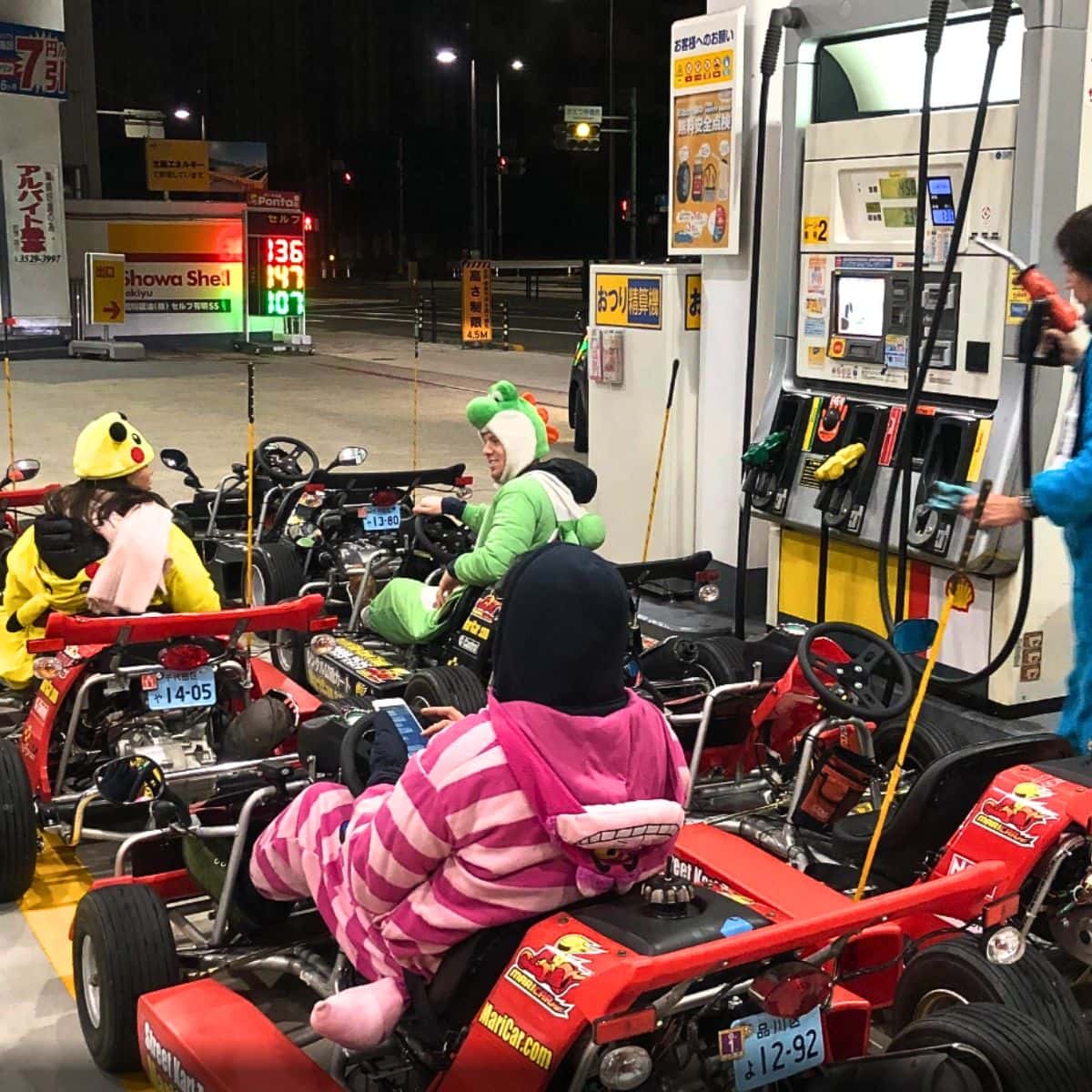
Go-Kart Rental in Akihabara / 3 Days in Tokyo Itinerary
Toyosu Fish Market
Imperial palace.
- teamLab Borderless Art Museum
- Roppongi Hills
Toyosu Fish Market is one of the largest wholesale seafood markets in the world. It is renowned for its fresh seafood auctions and serves as a hub for the distribution of seafood to restaurants, sushi shops, and retailers in Tokyo and beyond.
The market opened in October 2018 and replaced the iconic Tsukiji Fish Market , which had been in operation for over 80 years.
The Toyosu Fish Market is located on a man-made island in Tokyo Bay and covers an area of 40.7 hectares.
The market is divided into three main sections : the fish auction area, the intermediate wholesale area, and the fruit and vegetable market.
One of the main attractions of the Toyosu Fish Market is the live tuna auction , where buyers bid on fresh tuna that is carefully inspected and graded by market officials.
The auction takes place early in the morning at about 5:30 am and visitors are allowed to observe from a designated viewing area.
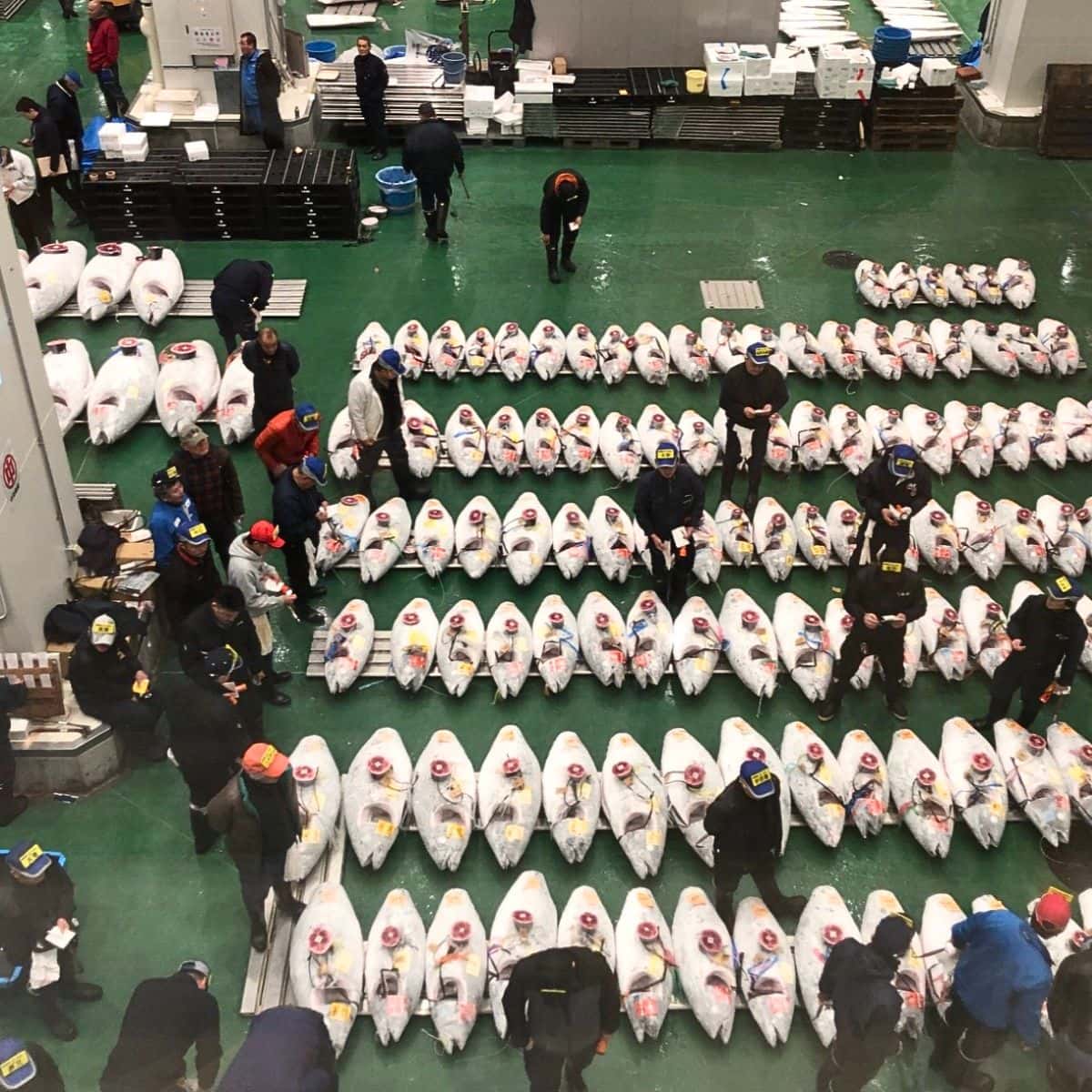
Toyosu Market / 3 Days in Tokyo Itinerary
In addition to the auctions, the intermediate wholesale area is a great place to visit and see how the seafood is processed, packaged, and distributed to buyers, including local restaurants and retailers.
A nice change from the seafood market is to visit the fruit and vegetable market where a wide range of fresh produce is traded.
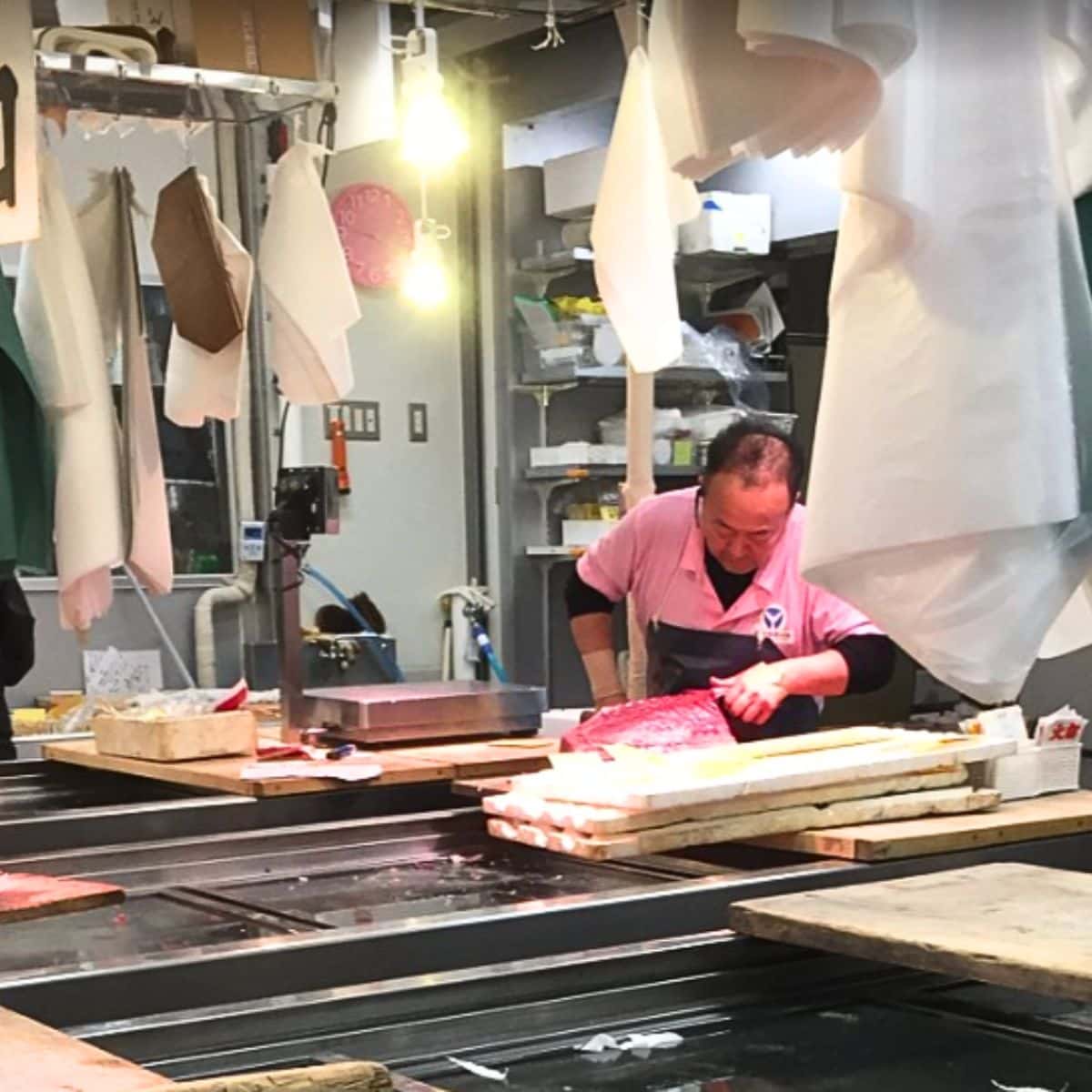
I attended Tuna Auction and Tokyo Toyosu Fish Market Tour . It was amazing! You should definitely look into it.
You will watch the entire auction from start to finish, including tuna inspection from 5:00 to 5:30. Then from 6:30–9:00 your expert guide will give you a market tour and you will learn about tuna, auctions, markets, and Japanese food in detail.
You will also enjoy the panoramic view of Tokyo’s skyline, and learn about the history and geography of Tokyo.
Finally, you will savor authentic sushi for breakfast at the best sushi restaurant in the market.
Important: Auction viewing from the viewing deck requires an advanced online lottery. They will apply for you if you book the tour by the application deadline date!
Ginza is where I always stay when I am visiting Tokyo. It is my favorite place in Tokyo.
Ginza is known as an upscale shopping district. It has some high-end department stores and luxury boutiques. Probably the most popular is Ginza Six , a luxury shopping complex that opened in 2017. It has a mix of high-end fashion brands, art galleries, gourmet restaurants, and a rooftop garden.
Another place I need to mention is Ginza Mitsukoshi . It is one of the oldest and most prestigious department stores in Japan. Their flagship store is located in Ginza. They are known for their high-quality products, elegant interiors, and top-notch customer service.
I am sure that as you are strolling through Ginza, you will notice Ginza Wako . It is an iconic building in Ginza known for its distinctive clock tower and historic heritage.
What I like about Ginza the most is its diverse and high-quality dining scene. There are numerous restaurants in Ginza offering a wide range of cuisines, from traditional Japanese to international fare.
Here are three dining places in Ginza that are highly regarded for their culinary excellence. If any of them sound good, then make your reservations as soon as possible. They all are booked well in advance.
- Sukiyabashi Jiro is a world-famous sushi restaurant known for its top-quality sushi and the masterful skills of its chef, Jiro Ono. The restaurant has been awarded three Michelin stars!
- Ginza Kyubey is another renowned sushi restaurant in Ginza that has been serving top-quality sushi for over 80 years.
- Ginza Bairin is famous for its crispy and juicy tonkatsu made with carefully selected pork.
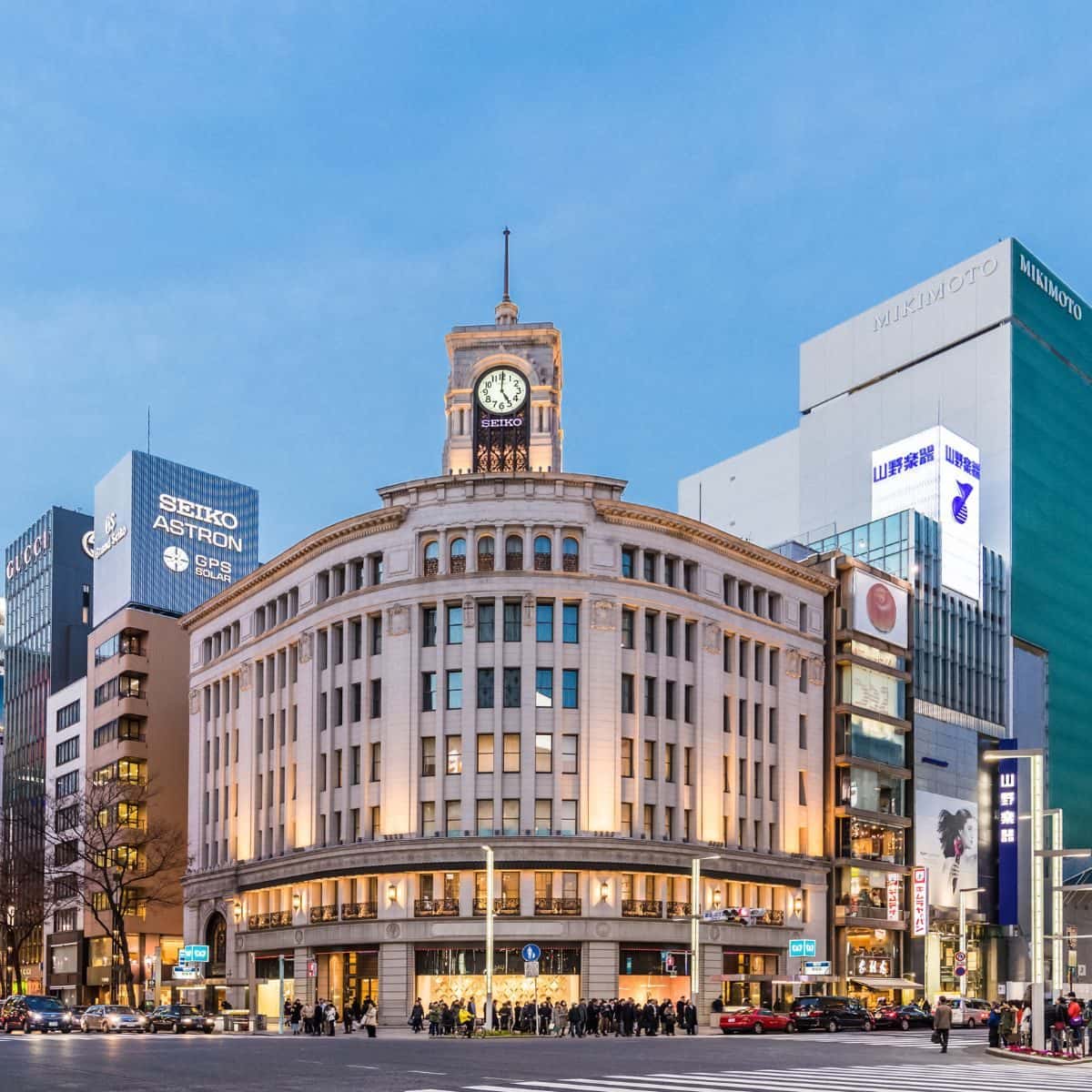
Ginza / 3 Days in Tokyo Itinerary
Read: BEST RAMEN in GINZA – Slurp-tastic Ramen at IPPUDO
Next, let’s head out to the Imperial Palace.
The Imperial Palace is the primary residence of the Emperor of Japan and the Imperial Family. It is known for its beautiful gardens, historic buildings, and cultural significance.
Here is what not to miss:
- Imperial Palace East Gardens
The Imperial Palace East Gardens have beautifully maintained Jpanese-style gardens, with various plants, flowers, and trees, including cherry blossoms in spring and vibrant foliage in autumn. It is such a pleasure to walk along the moats, enjoy the scenic views, and escape the hustle and bustle of Tokyo.
- Nijubashi Bridge
Nijubashi Bridge is one of the most iconic spots in the Imperial Palace, known for its picturesque beauty. It is a double-arched stone bridge that spans the moat and leads to the main entrance of the palace.
- Imperial Palace Plaza
The Imperial Palace Plaza is a large open space located in front of the main entrance of the palace. It offers a panoramic view of the palace.
- Fujimi-yagura Turret
Fujimi-yagura is one of the few remaining turrets of the original Edo Castle, which was once located on the same site as the current Imperial Palace. It is a historic structure that offers a glimpse into the castle’s military defenses during the Edo period. You can explore the interior of the turret and learn about its historical significance.
- Sannomaru Shozokan Museum
Sannomaru Shozokan is a museum located within the Imperial Palace grounds that displays a collection of historical artifacts and treasures of the Imperial Family.
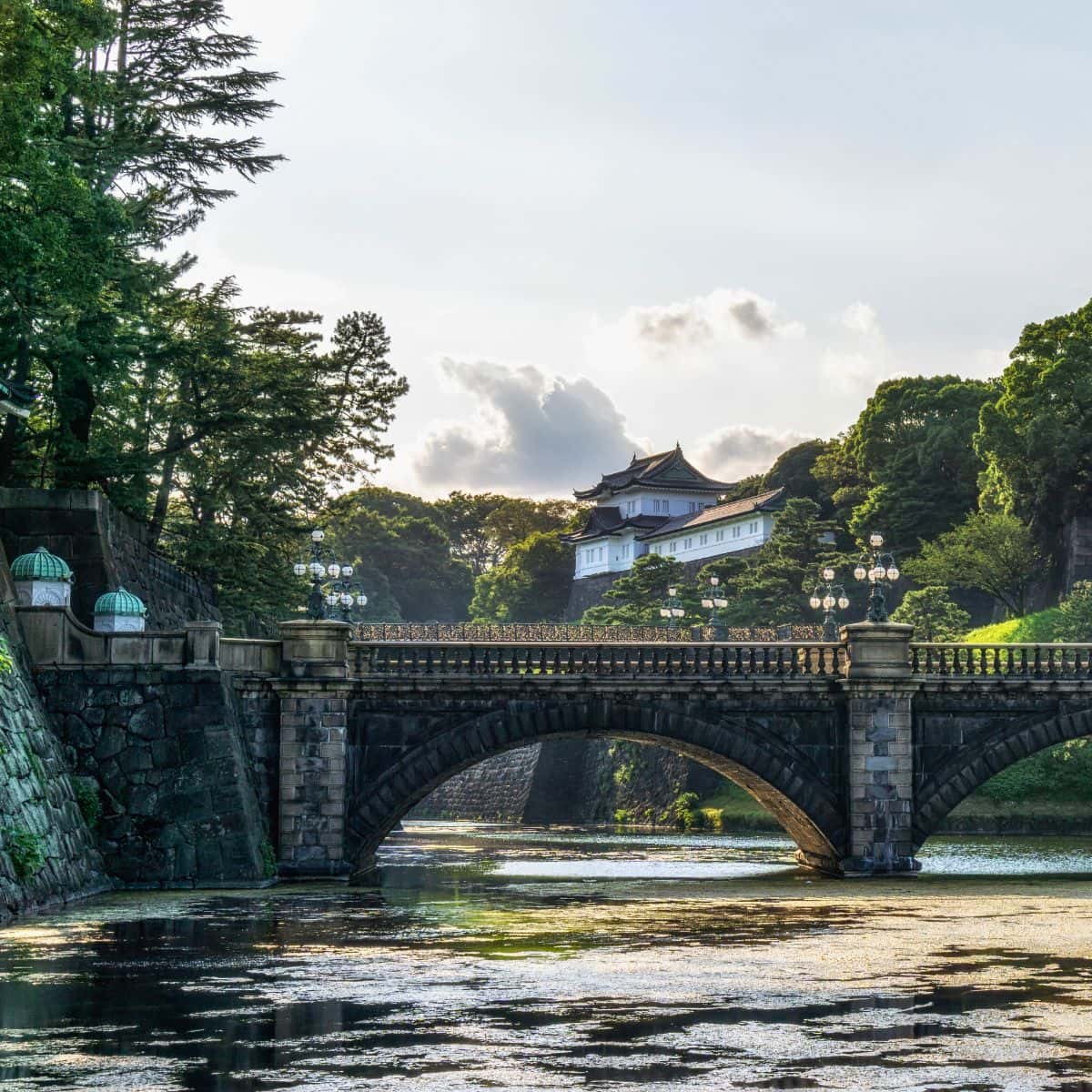
Imperial Palace / 3 Days in Tokyo Itinerary
The last stop of the day and the last activity on this 3 days in Tokyo itinerary is Roppongi.
Roppongi is known for its vibrant nightlife, shopping, dining, and entertainment. However, one spot that you cannot miss is Roppongi Hills . It is a modern complex that houses offices, shops, restaurants, art galleries, and observation decks offering panoramic views of Tokyo.
The Tokyo City View observation deck, located on the 52nd floor, offers breathtaking views of the city skyline, including Tokyo Tower and Tokyo Skytree.
The Tokyo Skydeck , located on the rooftop, is an open-air observation deck that provides a 360-degree view of Tokyo.
Both observation decks are great and most popular during the sunset!
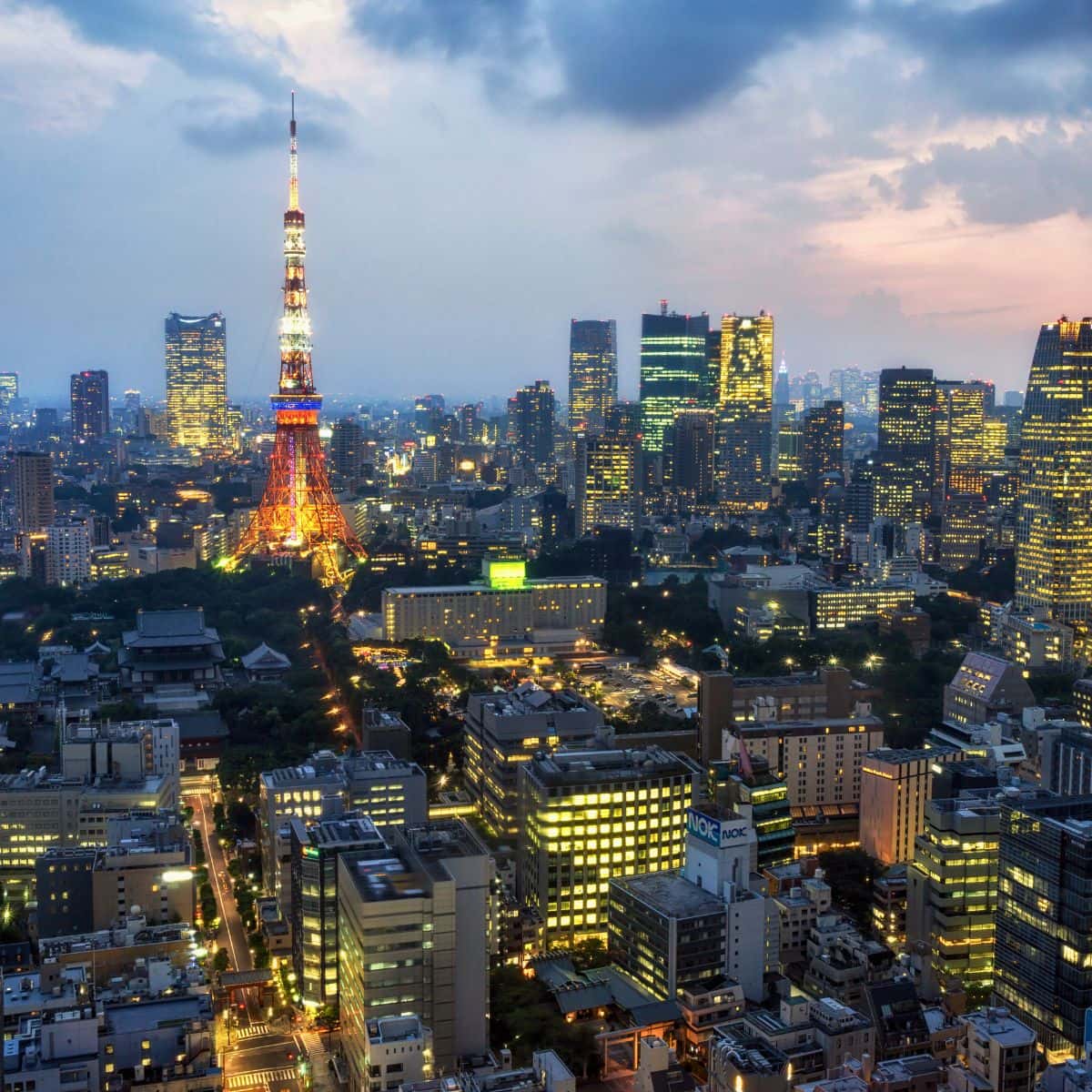
Tokyo at sunset / 3 Days in Tokyo Itinerary
Intrepid Scout's Tips for 3 Days in Tokyo Itinerary
I hope you got some ideas for how to spend 3 days in Tokyo. You can easily condense this itinerary and plan for 2 days in Tokyo.
If you like to take things at a leisurely pace then extend it to 4 days in Tokyo and add Roppongi Art Triangle . It is a collection of three art museums located in close proximity to each other in Roppongi, known as “Art Triangle Roppongi.” It consists of the Mori Art Museum, the National Art Center, Tokyo, and the Suntory Museum of Art.
- Mori Art Museum is a contemporary art museum located in Roppongi Hills that showcases a diverse range of contemporary art from Japan and around the world. The museum features rotating exhibitions of various art forms, including paintings, sculptures, photography, installations, and multimedia works. It is known for its innovative and thought-provoking exhibitions.
- The National Art Center, Tokyo is a unique museum that does not have a permanent collection but hosts special exhibitions of various art genres,
- The Suntory Museum of Art focuses on Japanese and Asian art, including ceramics, lacquerware, and textiles.
Also, it is a good idea to escape the hustle and bustle of Tokyo and explore the surrounding areas. Here are my favorite day trips from Tokyo :
14 Practical Tips How to See SNOW MONKEYS in JAPAN (Best Trip from TOKYO)
Perfect ONE DAY in KANAZAWA – 7 Things to Do (BEST TRIP from Tokyo, Kyoto, or Osaka)
More Information About Japan:
14 Amazing Things to Do in Arashiyama (Map+Useful Tips)
What to See at Nijo Castle in Kyoto (10 Top Things to Know)
Stunning Golden Pavilion in Kyoto (How to Visit and What to See)
Amazing Fushimi Inari Taisha in Kyoto (8 Things to Know Before You Visit)
First Visit to Kyoto – How to Visit and What to See (11 Things You Can’t Miss)
Perfect Day Trip to Miyajima from Kyoto, Osaka, or Hiroshima
10 Amazing Things to Do in Hiroshima You Can’t Miss of Your Visit
You Might Also Like:
275 Best QUOTES About JAPAN (JAPANESE Culture, Nature, Food, Anime, Proverbs)
Perfect ONE DAY in OSAKA Itinerary (6 Best Things to Do)
7 Fun and Easy DAY TRIPS from KYOTO (Useful Maps+Photos+Tips)
Read All the Posts About Asia in:
Asia Travel Guide
Read All the Posts About Japan in:
Japan Travel Guide
Did You Find This Useful?
Why not save 3 days in tokyo to your pinterest board.
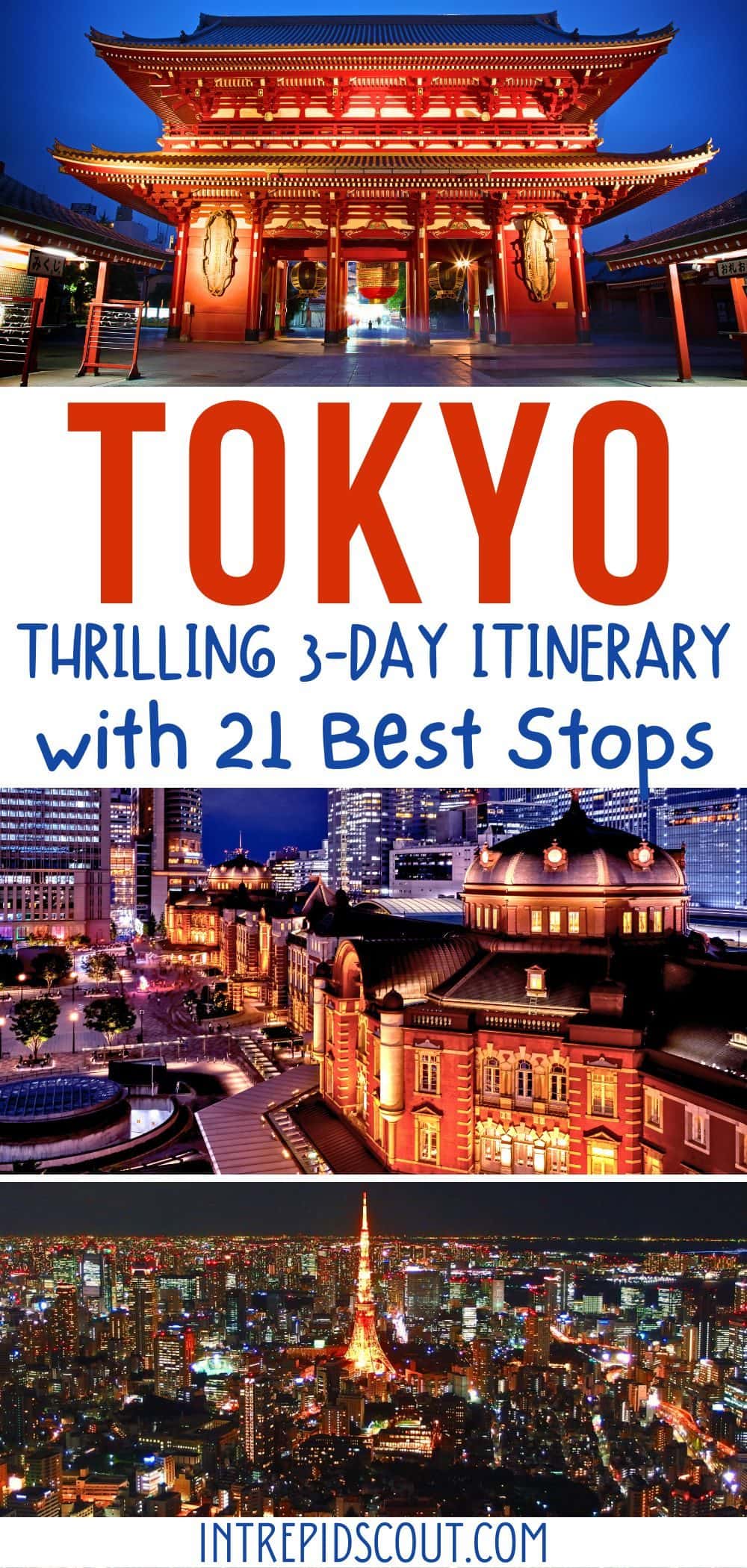
Now, It Is Your Turn, I Would Like to Hear Back from You!
Are you planning on visiting Tokyo? What is on your list of places to see in Tokyo?
Please let me know! Drop me a quick comment right below!
Click on any of the images below to get inspired and to help you with the planning process for your trip to Japan!
- alert('URL copied to clipboard.')).catch(err => console.error('Unable to copy to clipboard.', err))">
Share via Email
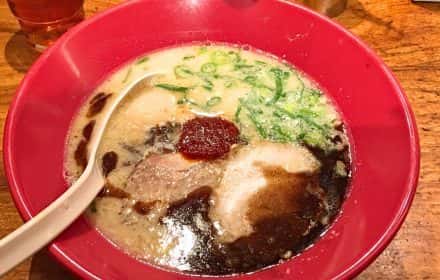
BEST RAMEN in GINZA - Slurp-tastic Ramen at IPPUDO
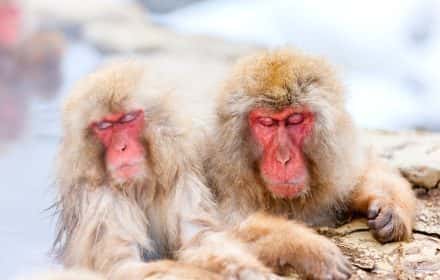
Tokyo to Hakone Day Trip (7 Fun Things You Can't Miss)
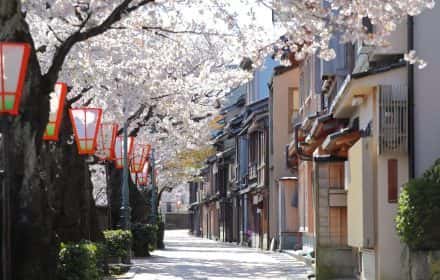
Perfect ONE DAY in KANAZAWA - 7 Things to Do (BEST TRIP from Tokyo, Kyoto, or Osaka)
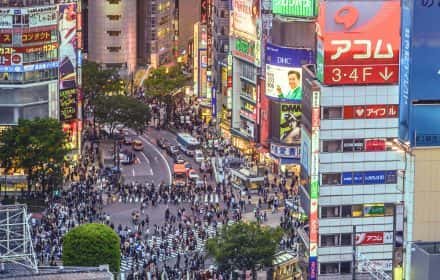
@intrepid.scout
Leave an answer Cancel reply
Your email address will not be published. Required fields are marked *
The company processes your data to facilitate the publication and management of comments. You can exercise your rights of access, rectification, deletion and objection, among others, according to our Privacy policy .
- Work with Me
- Start a Blog
- Yearly Roundups
- 101 in 1001 Goals
- how to start a travel blog
- tips for new bloggers
- write me a guest post!
- Work With Me
A Passion and A Passport
Proving Travel is Possible with a Full-Time 9-5
3 Days in Tokyo: The Perfect Tokyo Itinerary
last Updated: November 29, 2023 japan tokyo
FYI: Affiliate links may be sprinkled throughout the awesome, free content you see below. I’ll receive a small commission when you purchase from my links (at no extra cost to you), which I’ll totally blow on adult things like boba tea and avocado toast. As always, thanks for the support.
Headed to Japan and looking to fill your time with 3 days in Tokyo?! You’re in luck, my matcha-loving, sushi-searching friend. This Tokyo itinerary has got exactly what you need to help plan your trip!
Tokyo is a sprawling city that connects modernity with deep Japanese tradition, which shines through in its rich history, fascinating attractions, and cosmopolitan neighborhoods. From its mouth-watering food to its beautiful architecture and parks, the Japanese capital city truly has something for any kind of traveler.
I spent a perfect 10 days in Japan last cherry blossom season ( full itinerary here ), and we’re hoping to head back to Tokyo for an extended long weekend this year! Basically to eat everything and then some, but we don’t need to talk about my indulgent, over-the-top food habits (like traveling 15 hours via air for some vending machine ramen).

As an international flight hub for several airlines, Tokyo is the perfect place to visit en route to another destination, or simply on its own! If you’ve got 3 days in Tokyo to explore, you can see most of the city’s highlights. Buckle up for this detailed itinerary which will explain what to do in Tokyo in 3 days, with all the details you need to know to plan your trip there.
Note : This Tokyo itinerary is jam-packed with activities for the ultra-adventurous traveler. However, if you’re looking for a more laid-back schedule (no judgment here!), don’t feel like you need to do everything I’ve listed. Use this detailed Tokyo travel blog as a foundation, then prioritize the activities that sound most interesting to you!
Read Next: COMPLETE 10 Day Japan Itinerary (Perfect for first-timers to the country)
Pre-Travel Guide to Tokyo
When to visit tokyo.
Tokyo is truly a year-round destination – each season boasts something different and exciting for visitors to the city. However, not all seasons are created equal. Winters in Tokyo can be dark and cold, while summers are sweltering hot and humid. Spring and autumn are often very mild and temperate, with the best weather occurring between March and May, and then again from October to December.
Personally, I’d recommend traveling to Tokyo during these months for the mild weather, perfect for wandering around on foot and experiencing the city’s open-air attractions.
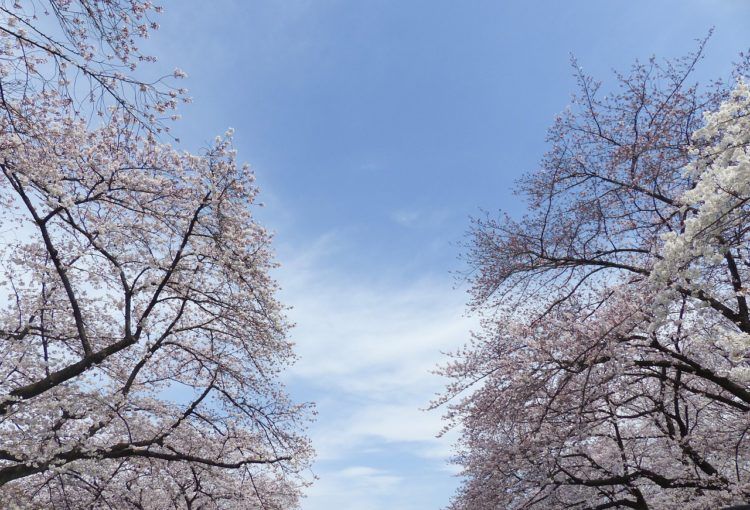
If you’re flexible on dates, one of the most beautiful times of year to visit Tokyo is during the annual blooming of the cherry blossoms. During the early spring, the cherry trees light up many areas of the city in white and pink blooms, and it’s truly a spectacle! While the city is often more crowded with tourists during this time of year, the cherry blossoms are certainly a once-in-a-lifetime thing to see. You can check predictions for the peak cherry blossom seasons this year here .
If you’d prefer to visit in the end of the year, you can opt to time your visit with the fall foliage, during which the city’s trees turn bright red, orange, and yellow.
Read Next: When to Visit Japan (Month by Month)
How to Get Around Tokyo
One thing to know about traveling in Tokyo is that taxis can be extremely expensive. We’re talking about potentially hundreds of dollars to get across the city. Uber operates in Tokyo as well, but it’s often just as expensive (if not more) as the taxis. Taxis are typically a safe transportation option for tourists, but the costs can add up super quickly and you usually need to pay in cash.
Luckily for budget travelers, Tokyo has a world-renowned public transportation system that’s easy to use even as a tourist. On the metro, you can pay by the ride (typically 170 to 310 JPY each way) or buy an unlimited multi-day pass (600 yen per day – recommended if you’ll be using the metro to get around).
In general, the metro maps have English translations and each stop is announced on the metro’s speakers in both Japanese and English. From both Narita (NRT) and Haneda (HND) airports, you can take a direct airport train into the city center for a much more reasonable price than the taxis.
Where to Stay in Tokyo
Finding accommodation in Tokyo can be a little challenging. The good news? Accommodation is easy to find, as there are tons of choices. The bad news? Hotels are typically small, sometimes cramped, and relatively expensive, especially if you wait until the last minute to book.
Tokyo is a massive city, so it’s important to choose your location carefully. No matter where you choose to stay, be sure to book a place that’s within walking distance to a central train station so you can easily and affordably get around from place to place.
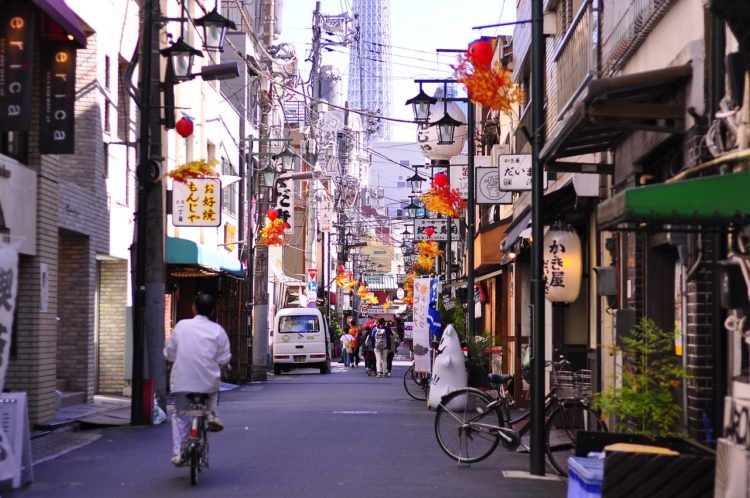
There are three centrally-located neighborhoods I’d recommend staying in: Shibuya, Shinjuku, and Ginza.
Where to Stay in Shibuya:
Shibuya is a metropolitan area home to the always-crowded “Times Square” of Tokyo, Shibuya Crossing (more on this later). Here, you’ll find suit-clad businesspeople, selfie-taking tourists, and hurried locals in a hodgepodge of energy, lights, and modern buildings.
- Splurge : Shibuya Stream Excel Hotel Tokyu
- Budget : Mustard Hotel Shibuya
- Hostel : Turn Table Hostel
Where to Stay in Shinjuku:
Shinjuku is another lively neighborhood, home to incredible green spaces and hole-in-the-wall eats and nightlife. You can find alleys full of lanterns and tiny bars, or wander through the giant Gyoen Garden.
- Splurge : Keio Plaza Hotel Premier Grand
- Budget : The Knot Tokyo Shinjuku
- Hostel : Nine Hours Shinjuku – North
Where to Stay in Ginza:
And, for the shoppers out there, Ginza boasts some of the city’s best boutiques and shopping malls. On weekends, Ginza’s streets are closed to cars for the perfect walking wonderland.
- Splurge : Millennium Mitsui Garden Hotel Ginza
- Budget : The Square Hotel Ginza
- Hostel : Bed & Breakfast Renga
Language and Currency in Tokyo
While Japanese people are generally very polite and helpful, few people speak English fluently. It’s much easier to find assistance via English speakers in more frequently touristed areas or in your hotel. However, as with any foreign country, I recommend learning a few words in Japanese before you arrive.
USEFUL JAPANESE PHRASES:
- Hello/Good Afternoon: konnichiwa
- Good bye: sayonara
- Delicious: oishi
- Thank you: arigatō
- Please: kudasai
- Where’s the toilet: benjo wa doko desu ka?
- Does anyone speak English? Eigo no hanaseru hito wa imasen ka

The currency in Tokyo is the Japanese Yen (JPY). You can either exchange money at designated exchange kiosks around the city, or take money directly from a bank ATM (there are several scattered around most Tokyo neighborhoods). I prefer to use an ATM whenever possible as they typically provide better exchange rates.
I was super surprised, but I found Japan to be mostly a cash society, so expect your credit card to get rejected at some places and be sure to carry enough Yen with you. If you’re coming from the US, an easy way to figure out USD to JPY is to move the decimal point two spots to the right >> 100Y = approximately $1USD. Just for quick reference, 10,000Y = approx 100USD.
And finally, what you originally came here for, a super detailed 3 day Japan itinerary! Get planning, my friends!
3 Days in Tokyo Itinerary
Day 1: west side (modern tokyo).
Between shiny buildings and busy streets, the first day of your Tokyo itinerary will take you to some of the more modern, cosmopolitan areas of the city: Shibuya, Harajuku, and Shinjuku. If you’re planning on spending more than 3 days in Tokyo, you can split this up into a couple of days for a more relaxed schedule!
Morning: Shibuya
Start the morning off in Shibuya, which you can easily access by metro. With its tall, shiny buildings, Shibuya is a major business hub in Tokyo, home to some of the city’s major corporations. It’s also a fantastic place to get a feel for the modern, rapidly expanding cosmopolitan side of the city, whether at the bustling Shibuya Station or overlooking the crowds in Shibuya Crossing.

- Shibuya Crossing: Head to Shibuya Crossing (especially during rush hour), which is known as the “Times Square” of Tokyo, to watch the city’s busiest intersection come to life. Amidst flashing LED signs and huge billboard ads, you can see several pedestrian lanes of people crossing at the exact same time. Join in on the fun on the streets, or head to Starbucks for your morning cup of joe and a bird’s eye view of the chaotic pedestrian crossing.
- Hachiko Statue: Shibuya’s Hachiko Statue might melt your heart, especially if you’re an animal lover. This statue was built to remember the incredibly faithful Akita dog who waited every day at the Shibuya train station for his owner. Even after the owner’s death, Hachiko continued to show up every day for years without fail at the station! Now, at the Shibuya Station, you can see a statue of Hachiko that was built as a tribute to his unconditional loyalty.
- Tokyu Hands: If you’re looking for a place to stop and shop for some souvenirs, Tokyu Hands is a giant department store in Shibuya where you can find some of Japan’s best and most unique items. They focus on handmade items and crafts, and you can find a lot of things here in that same creative vein.
Afternoon: Harajuku
When I think of Harajuku, there’s really only one word that comes to mind: stylish. Here, you can spot some of the city’s most unique and colorful fashions, amidst a sea of boutique shops and cute cafes. Harajuku is also located right next to the Meiji Shrine and surrounding park, which is a beautiful area to disconnect from the noise and haste of the city (you’ll need it after spending the morning in Shibuya!).
- Meiji Shrine: Located next to Harajuku’s metro station, the Meiji Shrine and surrounding Yoyogi Park are a peaceful respite from the otherwise lively areas of Tokyo you’ll visit today. The shrine was dedicated to Emperor Meiji in 1920, and was rebuilt after being destroyed during WWII. Today, visitors can enter the shrine area and learn about its traditions and history, including the hand washing station and the wishing tablets, also known as ema.
View this post on Instagram A post shared by J (@jermstravels) on Jan 24, 2019 at 4:06pm PST
- Omotesando and Takeshita Dori shopping streets: Harajuku’s fashions and designs aren’t exclusively for locals; you can actually buy a lot of these colorful, crazy items you see in this neighborhood to take home with you. Head to Omotesando and Takeshita Dori shopping streets to window-shop and browse some of the local boutiques…or simply people-watch the ultra-chic, colorfully-dressed locals that seem to frequent the area.
View this post on Instagram A post shared by ? ? ? ? ? ? ♀ (@goldiegrace) on Jan 16, 2019 at 4:05am PST
- Try some street food: Despite being home to some beautiful (and expensive) boutiques, there’s actually plenty of great street food in the Harajuku area to try. One of my favorites was the crepes, which you can find in street kiosks lining the main walking street. However, if you’d fancy something else, there are several other kiosks selling both savory and sweet treats.
View this post on Instagram A post shared by Charlotte Foodies ? (@foodie_muse) on Jun 3, 2017 at 3:18pm PDT
- Harry’s Hedgehog Café: Yes, you read that right: this is a real cafe where you can actually play with tiny hedgehogs. The cute animal lover in me is grinning just writing this (*cue squeal*). For a small fee, you can put on a pair of thick gloves and hold/play with these miniature hedgehogs. The cafe staff stands by at each table to ensure the well-being and safety of the hedgehogs during your visit.
View this post on Instagram A post shared by ?Shelly Jimenez (@shellyjimenez) on Nov 28, 2018 at 12:58am PST
- Kawaii Monster Cafe: In Japanese, the word kawaii means “cute” or “adorable” and that’s definitely the gist of this trippy, colorful Harajuku-based cafe. Filled with psychedelic decorations and some out-of-this world color schemes, the Kawaii Monster Cafe is a super Instagrammable place that’s full of visual stimulation. There’s definitely no shortage of wackiness (or strangeness) here! To enter, there’s a 500 JPY entrance fee and each person is required to order at least one entree and a drink, but it’s generally reasonably priced.
View this post on Instagram A post shared by KAWAII MONSTER CAFE (@kawaiimonstercafe) on Jan 22, 2019 at 11:07pm PST
- Observe the costumes: While wandering around Harajuku, keep an eye out for traditional Harajuku Girls dressed in their elaborate costumes and anime, especially if one of your 3 days in Tokyo happens to be a Sunday.
Evening: Shinjuku
After leaving colorful Harajuku, you might find Shinjuku to be a welcome change to your Tokyo itinerary for the evening. This nearby neighborhood is equally modern and traditional. One minute, you’re surrounded by tall buildings and the next, you’re ducking through tiny food stalls in a narrow, lantern-laden alleyway or breathing in fresh air at a traditional Japanese garden.

- Shinjuku Gyoen Garden: As one of the largest green spaces in the city of Tokyo, you can’t miss Gyoen Garden, especially if you love the outdoors. This massive park is home to several different kinds of Japanese gardens, with trails that connect different areas of the park. Additionally, it’s a gorgeous place to see Tokyo’s cherry blossoms in the springtime, or fall foliage towards the end of the year.
- Tokyo Metropolitan Government Building: Around sunset or at night, you can head to the observation deck of the Tokyo Metropolitan Government Building to see some of the most spectacular panoramic views of Tokyo. I loved going when the sun went down to see the sparkling city lights below. The best part is it’s totally free to go up there!
- Robot Restaurant: One of the most popular Shinjuku hotspots is the Robot Restaurant. Although it’s a wildly popular hyper-tacky tourist attraction, we chose not to go after reading tons of mixed reviews, but it’s up to you! Note that the food is something left to be desired, so you’ll wanna plan to eat before or after (and Piss Alley is a great choice).
View this post on Instagram A post shared by robotrestaurant (@robotrestaurant) on Jan 14, 2019 at 3:09am PST
- Piss Alley (Omoide Yokocho): Despite its off-putting name, Piss Alley is one of the coolest places to visit in Shinjuku. A tiny, narrow alley lined with lanterns and full of people, Piss Alley is home to tiny bars, food stalls, and restaurants that serve up some of the best food in the area. Historically, it was a hidden street for drinking and other illicit activities, and is still a symbol of some of the older traditions of the city.
View this post on Instagram A post shared by Joyce ? Vancouver (@juicybb) on Jan 21, 2019 at 7:32pm PST
Day 2: East Side (Traditional Tokyo)
On the second day of your 3 days in Tokyo, you’ll head to some of the city’s historic areas, exploring traditional shrines and temples, wandering through some of the city’s older neighborhoods, and ending the day in one of the strangest and coolest parts of town.
Morning: Asakusa
As one of Tokyo’s most well-preserved old neighborhoods, Asakusa is a place to see the charms of “old Tokyo” and experience a very different vibe than the urban shuffle in Shibuya and Shinjuku. There are several old temples and streets with market stalls in the Asakusa area, waiting to be explored by the adventurous tourist.

- Sensoji Temple: The Sensoji Temple is Tokyo’s oldest temple and one of the most iconic. Its entryway is marked by a signature large red lantern. With its beautiful red frame and green rooftops, it’s worth taking some time in the morning to explore the grounds and the temple itself. Get up early and head to Asakusa to avoid the large crowds that gather here during the day.
- Nakamise Dori Street: Just outside of the Sensoji Temple lies one of Tokyo’s most historically significant shopping streets. Here, you can find all kinds of Japanese goods and homewares, as well as many souvenir shops. Take some time to walk through this street during your visit to Asakusa to people-watch and see some of the beautiful handicrafts from Tokyo locals.
During Cherry Blossom Season: Sumida Park
Like I’ve mentioned earlier in this Tokyo travel blog post, spring is the most amazing time to come to Tokyo. Located near the Asakusa train station is Sumida Park, one of the best and most beautiful parks in Tokyo to see the cherry blossoms in the springtime. There are over 700 cherry trees in this riverside park! If you’re lucky enough to be in Tokyo during the full bloom, head to Sumida Park while you’re in the Asakusa area.

Afternoon: Ueno
Another traditional Tokyo neighborhood, Ueno is most well-known for its shrines, gardens, and museums. You can spend the afternoon in this part of the city, strolling through the streets or trails and learning more about Tokyo’s fascinating history.

- Ueno Park/Gardens: Ueno Park is a large metropolitan park in the Ueno area, which is home to lovely walking trails and over 1,000 cherry blossom trees that bloom in the springtime. It’s also a popular place for locals to hang out. There are also a handful of shrines and temples in the park that you can check out while you’re there.
- Tokyo National Museum: Within Ueno Park, there are several museums and a zoo. You could spend an entire day exploring them all, but if I had to pick just one, I’d recommend going to the Tokyo National Museum. Packed full of interesting information, the Tokyo National Museum is a collection of important historical and traditional Japanese items that span the country’s history. Entrance is 620 JPY.
Evening: Akihabara District
In the late afternoon, head to the Akihabara District, which became famous in Tokyo for its focus on anime and manga culture and its several electronics/gaming shops. There are literally streets and streets of electronics shops in this part of town, which provides a fascinating backdrop for this very unique corner of Tokyo.
- Electric Town: Like I mentioned earlier, Akihabara District started off as a center for electronics sales. Dozens and dozens of tiny electronics shops sprang up in groups, many of which are still in business today. In addition to the tiny electronics stores, you can also visit Yodobashi Akiba, a gigantic electronics department store in the neighborhood that sells everything from cameras to computers to sound equipment and more.
- Game Centers: There’s literally an entire pocket of the Akihabara District that’s completely dedicated to game centers, or arcades. There are dozens you can visit and play games in, but my favorite is Super Potato Retro Shop, which has a bunch of throwback retro games you can play in a cozy environment on the 5th floor.
- Maid and Gundam Cafes: One of the strangest things you can experience in Akihabara is the Maid and/or Gundam Cafes. Exactly as they sound, these are small restaurants where the waiters/waitresses dress up as maids and butlers and cater to your every wish, including but not limited to playing games, taking Instagram selfies, and serving too-cute drinks and desserts.
Day 3: Sushi Breakfast and Shopping
You really can’t have a 3 day Tokyo itinerary without a day of food and shopping, right?! Well, this is that day. I’ve included a bunch of different options for you on this third day of your Tokyo itinerary, so you can choose what you want to do based on what you want to buy, eat, or see!
Early Morning: Toyosu Fish Market
I’m sure you’ve heard about the ever-so-popular and quite famous Tsukiji Market. However, in late 2018, the famous Tokyo establishment, the Tsukiji Fish Market, shut its doors for the last and final time. The market itself moved to a different location, now titled the Toyosu Fish Market, but don’t you worry – it’s open for visitors!
View this post on Instagram A post shared by TK (@otorochutoro) on Dec 6, 2018 at 11:29pm PST
At this new location, you can still find some of the freshest sushi around, and a daily 4:30 AM tuna auction (if you’re willing to get up that early). I recommend heading over in the early morning (around 4 for the tuna auction, or later if you just want to walk around and explore/eat). Grab some sushi at the Toyosu Fish Market for breakfast, as that’s the time of day when it’s the freshest.
Morning: teamLab Borderless Art Museum and Ginza
- teamLab Borderless Art Museum: Of all the places on this Tokyo itinerary, I think this art museum might be one of the most fascinating. A digital art museum, the teamLab Borderless Art Museum is an interactive and immersive art experience that has the visitor moving through different rooms of color, light, psychedelic patterns, and moving projected images. It’s a really unique art experience, and I’d recommend it even if you’re the type of person who won’t go near an art museum.
View this post on Instagram A post shared by I am a day and night dreamer (@sn00pyee) on Jan 24, 2019 at 4:06pm PST
- Shopping in Ginza: After the teamLab experience, head to Ginza for some shopping (or window-shopping, if you’re on a budget). Two of the must-see shopping streets in the Ginza area include Chuo-dori Street and Harumi-Dori. If you’re in Ginza, you can’t miss these streets; they are lined with shops and cafes and eventually intersect. While in Ginza, don’t forget to check out the Kabukiza Theatre, which has regular Japanese fine arts performances and is just a really beautiful building in general.
Afternoon: Imperial Palace and East Garden
The Imperial Palace and its surrounding greenery are an important part of Tokyo’s history and culture, and are definitely worth a visit during your 3 days in Tokyo. The castle on the grounds was originally the Edo Castle, but after changing hands many times, was ultimately destroyed. In its place lies part of the original foundation in the East Garden.
Late Afternoon/Evening: Roppongi
An ultra-modern area for shopping nightlife, the upscale neighborhood of Roppongi is home to several buildings and attractions that are best visited in the late afternoon or evening, so you can appreciate the modern, well-lit complexes and designs of this dazzling place.
- Roppongi Hills: This is a sizeable and famous high rise development complex situated in the middle of the neighborhood. It’s like a miniature city within a city, with its own skyline, eating areas, and more.
- Mori Art Museum: Housed in a modern glass building, the Mori Art Museum is home to lots of contemporary art in a variety of genres and mediums. In my opinion, it’s worth it to visit the museum for the building alone!
- Tokyo Midtown Complex: The Tokyo Midtown Complex is a huge, high-end shopping and dining complex with tons of areas to walk around, shop, and grab dinner.
- Mori Tower: If you didn’t get a chance to go to the Tokyo Metropolitan Government Building on day 1 (or you just love city views!), you can see another fabulous bird’s eye view of Tokyo from the 52nd floor or the rooftop Sky Deck of the Mori Tower. The views from up here are best at night, when the city begins to light up.
EXTRA! Day 4: Take a Day Trip
Okay, okay, I know this was supposed to be a 3 day Tokyo itinerary, but the reality is that it would be a total shame if you didn’t take the time to explore the surrounding areas of Tokyo if you have a bit more time in the city.
While this guide tells you what to do in Tokyo in 3 days, I felt that it was important to add an option for those of you wanting to see a little bit more of Japan during your time here. So, if you do find yourself with 4 days in Tokyo (or a little bit of extra time in your schedule) you can take one (or more!) of these nearby day trips.
Read Next: Top Day Trips from Tokyo
- Distance from Tokyo: 42.6 miles/68.5 km
- Main things to do: Temples (Hokokuji, Hasedera, others), Great Buddha, Hachimangu Shrine, hiking

Kamakura is a Japanese town that boasts stunning examples of traditional architecture in its religious sites, including several temples and shrines. Historically, it was the origin of Japan’s samurai government and an important cultural hub for the country’s development.
In addition to well-maintained historic sites, it’s also home to stunning nature areas that you can visit and enjoy, even if you’re only visiting Kamakura for the day.
By far, the most hassle-free way to take a day trip to Kamakura is by organized tour, especially if you only have 4 days in Tokyo and don’t want to be stuck in your hotel trip planning. You can book a day-long trip to Kamakura like this one that includes transportation and a local guide (which is awesome given the town’s incredible historical sites).
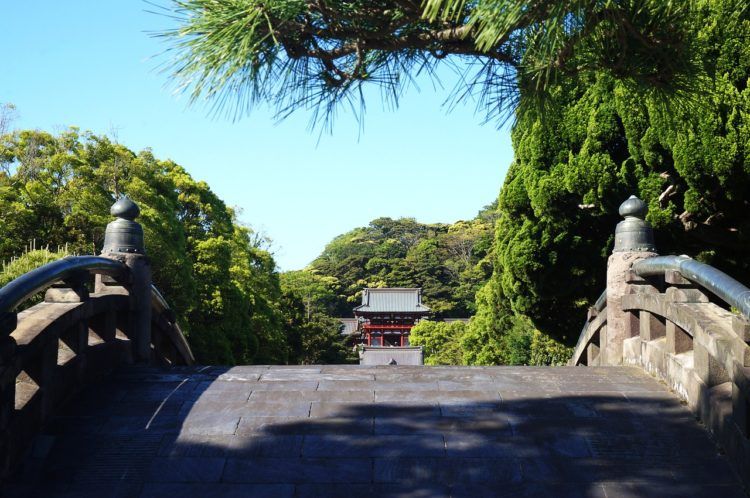
However, if you want to DIY your day trip, the easiest way to get to Kamakura from Tokyo is by train. The easy-to-use JR trains connect both the Tokyo Station and the Shinjuku Station to Kamakura directly. If you’re going by train, the trip takes about 1.5-2 hours one way and costs 920 JPY.
Once in town, head to the Giant Buddha (or Kamakura Daibutsu (Kōtoku-in) ), one of Kamakura’s most famous landmarks. Then, explore a few of the city’s temples, like the Hokokuji or Hasedera temples , which are beautiful examples of traditional Japanese temples. You can also visit the Hachimangu Shrine , which is the most culturally and historically important Shinto shrine in all of Kamakura. If you’re interested in getting some fresh air, hit some of the nearby hiking/walking trails into the outskirts of the town.
It’s best to visit Kamakura during the spring and fall, as the weather will be mildest during these months and you’ll be spending a lot of time outside.
- Distance from Tokyo: 92.5 miles/148.9 km
- Main things to do: Shinkyo Bridge, Three Buddha Hall, Five-Story Pagoda, shrines, landscapes & scenery
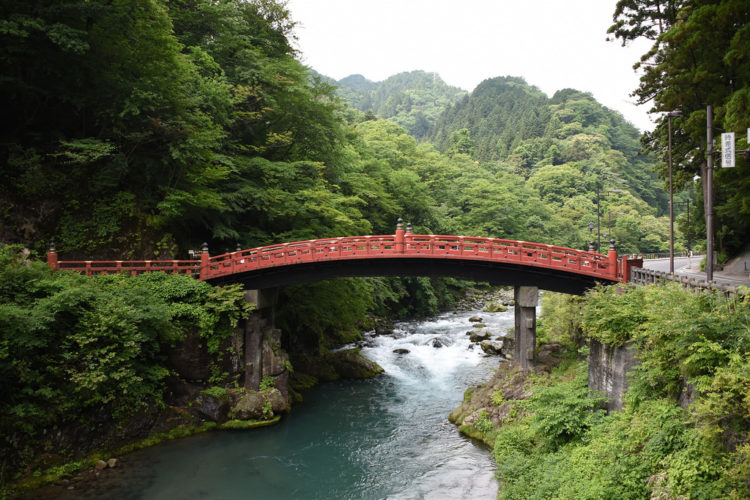
Located in the mountains about 2.5 hours from Tokyo by train, Nikko is an 8th century Japanese town with several picturesque, forested shrines and temples. With its perfect location right near Lake Chuzenji, you can get a taste of history and culture as well as beautiful landscapes and outdoor exposure.
Again, as Nikko is a decent distance (almost 100 miles) from Tokyo, it’s easiest to book a guided day tour to minimize the hassle of figuring out the transportation and activities for the day. Day tours like this one offer a really great value, and they organize everything for you. However, if you’d rather plan your own independent day trip, you can get to Nikko by train from Tokyo.

While in Nikko, you have to visit some of the many shrines and temples in the area. Three Buddha Hall and the Five-Story Pagoda are two especially photogenic ones, but there are several shrines dotted throughout the city – many of which are surrounded by wooded areas – that you can visit. Additionally, don’t miss the incredibly beautiful Shinkyo Bridge .
When you finally feel like you’ve seen enough of the local shrines and temples, you can also explore the nearby Lake Chuzenji or Kanmangafuchi , where the 70 mysterious Jizo statues are located. There’s a legend that the number of statues changes every time you count them…but you’ll just have to visit for yourself to find out if it’s true.
It’s best to visit Nikko during the fall, where the foliage colors consume the greenery of the forest and turn the entire town and surrounding area bring yellow, orange, and red.
- Distance from Tokyo: 57.2 miles/92.1 km
- Main things to do: Views of Mount Fuji over Lake Ashinoko, Hakone Onsen, Hakone Shrine, Owakudani Crater
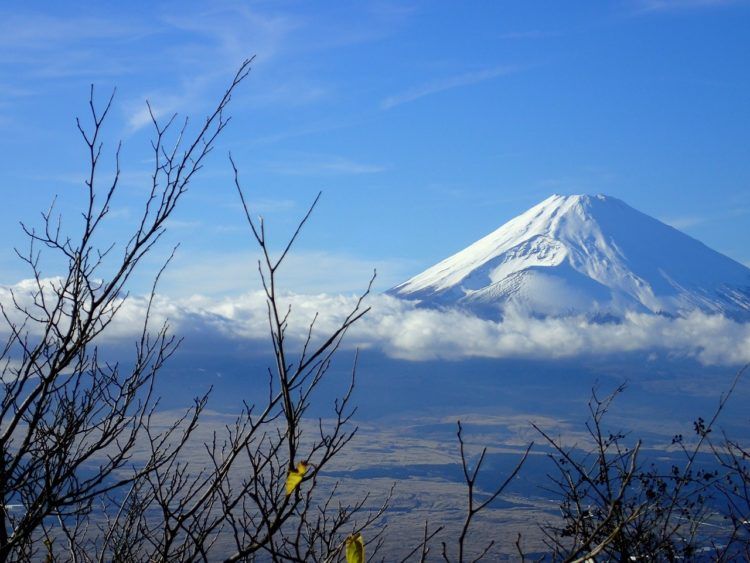
Located just over an hour from Tokyo, Hakone is one of the most visually beautiful day trips from Tokyo, boasting stunning views of Mount Fuji amidst forested shrines and landmarks. A short train ride from Tokyo’s city center, Hakone is a perfect day trip you can go on to get a bit more peace and quiet; I’d recommend this one if you love the outdoors and you only have 4 days in Tokyo.
There are several day tours from Tokyo that you can book (like this one or this one ) which will organize your transportation and logistics for a day trip to Hakone. With limited time in Tokyo, it’s easiest just to book a tour. However, you can also hop on a train from Tokyo and explore Hakone on your own (but since I found the trains to be somewhat confusing with local and direct trains and had difficulty figuring out which was which, I’d just take a tour if I were you.)
In Hakone, you’ll have the chance to visit a lot of quiet, secluded shrines and even a relaxing traditional Japanese bath! First, on clear days, you can head to Lake Ashinoko to see amazing views of the conical Mount Fuji, which in the colder months is capped with snow. You can take a boat ride around the lake or just take in the sights from the shore.
After that, visit the Hakone Shrine , a forested shrine with bold red structures. Afterward, you can take a cable car over Owakudani Crater , a crater formed by the last volcanic eruption in the area where they make miracle eggs that are said to add 7 years to your life! You can end your day at the Hakone Onsen , a traditional Japanese bath house with warm water to relax your body and round out your trip with a uniquely Japanese onsen experience.
So there you have it, a complete and packed 3 day Tokyo itinerary! As I mentioned earlier, if you want a more relaxing experience, pick and choose a few activities for each day instead of cramming it all in and rushing from place to place (like me).
Other Japan articles you may like:
Best Time to Visit Japan
Japan Bucket List: Where to Visit
Complete 10 Day Japan Itinerary
Tokyo Bucket List and Itinerary Inspiration
Day Trips from Tokyo
25+ Things to do in Kyoto
Day Trips from Kyoto
Things to do in Harajuku
When are you planning to visit Japan and how will you be spending your 3 days in Tokyo?!
Images via Nikko 1 / 2
Leave a Reply Cancel reply
Your email address will not be published. Required fields are marked *
Save my name, email, and website in this browser for the next time I comment.
You may also love...

Subscribe To The Newsletter
FOR TRAVEL INSPO and FUN
No spam, only fun!
Favorite Destinations

- About Jessica
- How to Plan a Trip
- Fave Travel Companies
- Shop My Faves
Destinations
- World Travel
- San Francisco
- Northern California
- Southern California
- Central Coast

The Perfect Three Days in Tokyo Itinerary

Tokyo is one of the greatest cities in the world, and I feel lucky every day to call this beautiful place home. Tokyo has so many incredible highlights that three days in Tokyo won’t cover all of the key things to do. When planning a Tokyo three-day itinerary though, these tips will give you some ideas on how to make the most of your trip.
For first-time visitors, Tokyo can be an overwhelming place. With so much culture, charm, and uniqueness to explore, this three days in Tokyo itinerary will hopefully help you navigate the city a little easier.
Here is how I recommend spending three days in Tokyo !
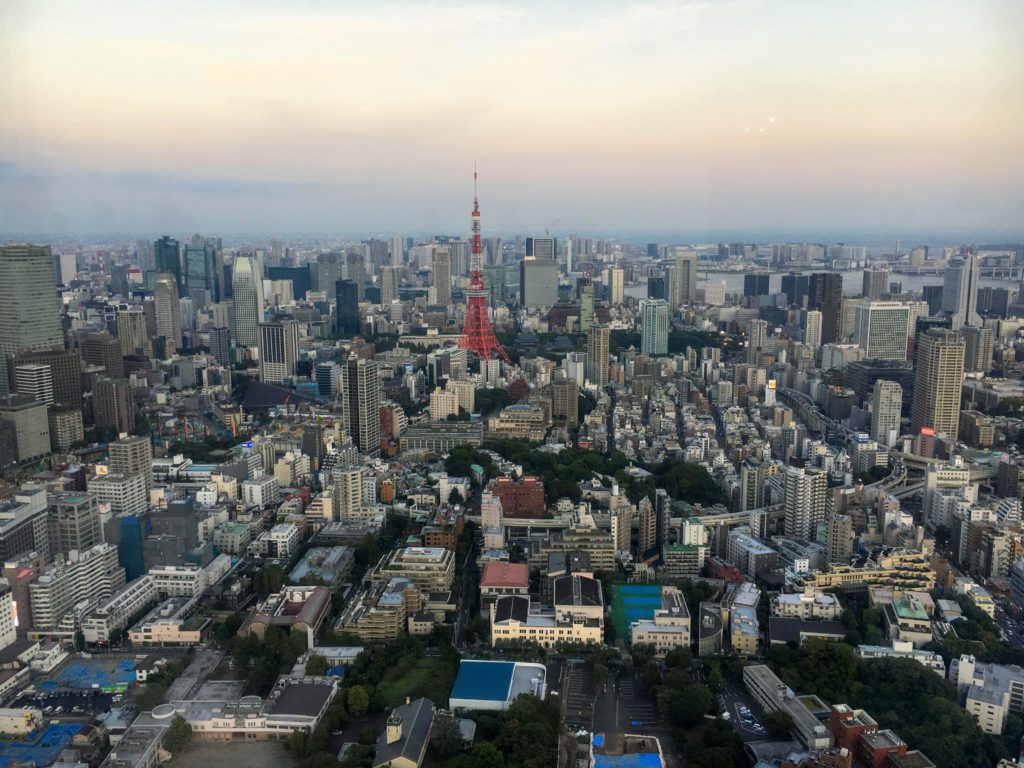
Tips for Getting Around Three Days in Tokyo
- Get a Suica card to breeze through public transit during your three days in Tokyo. If you get a JR Pass , it can also be used for the JR lines around Tokyo. With the Suica card, plan to spend around $10 USD or ¥1000 yen per day on transit within Tokyo.
- Learn where the main train stations are in relation to your hotel. The main stations are Shinjuku, Shibuya, Tokyo, and Ueno stations, all on the Yamanote line . Knowing where these stations are directionally will help you navigate all other trains during your three day Tokyo itinerary.
- Avoid rush-hour traffic if you can, unless you want to get sardine-canned in the trains. Rush hour in Tokyo is in the morning around 8-10am, and in the evening around 6-8pm.
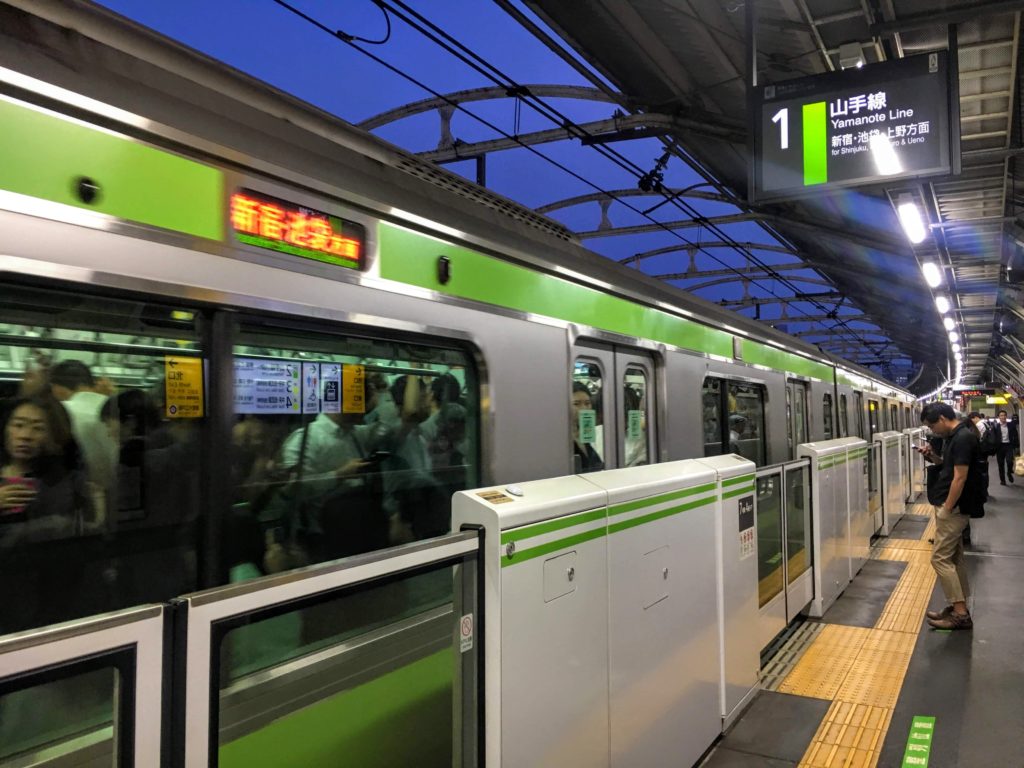
Where to Stay During Three Days in Tokyo
I highly recommend getting accommodation in Tokyo near the Yamanote line for this three-day Tokyo itinerary. The Yamanote line is the lifeline of the city that will connect you to many of the highlights of Tokyo.
Check out where to stay during three days in Tokyo:
- Budget : The Global Hotel Tokyo or Holiday View Inn near Shinjuku, or Grids Toyko Ueno Hostel & Hotel near Ueno
- Mid-Range : The Millennials in Shibuya, Sakura Cross Hotel or Belken Hotel in Akihabara
- Luxury : Cerulean Tower Tokyu Hotel in Shibuya or The Tokyo Station Hotel near Tokyo Station
Alternatively, stay somewhere quirky like a capsule hotel where you sleep in a bookcase, or a hotel where the reception is run by robot dinosaurs… even a houseboat on a canal! Check out my list of coolest hotels in Tokyo . Make your Tokyo three-day itinerary super memorable by staying in one of these unforgettable hotels!
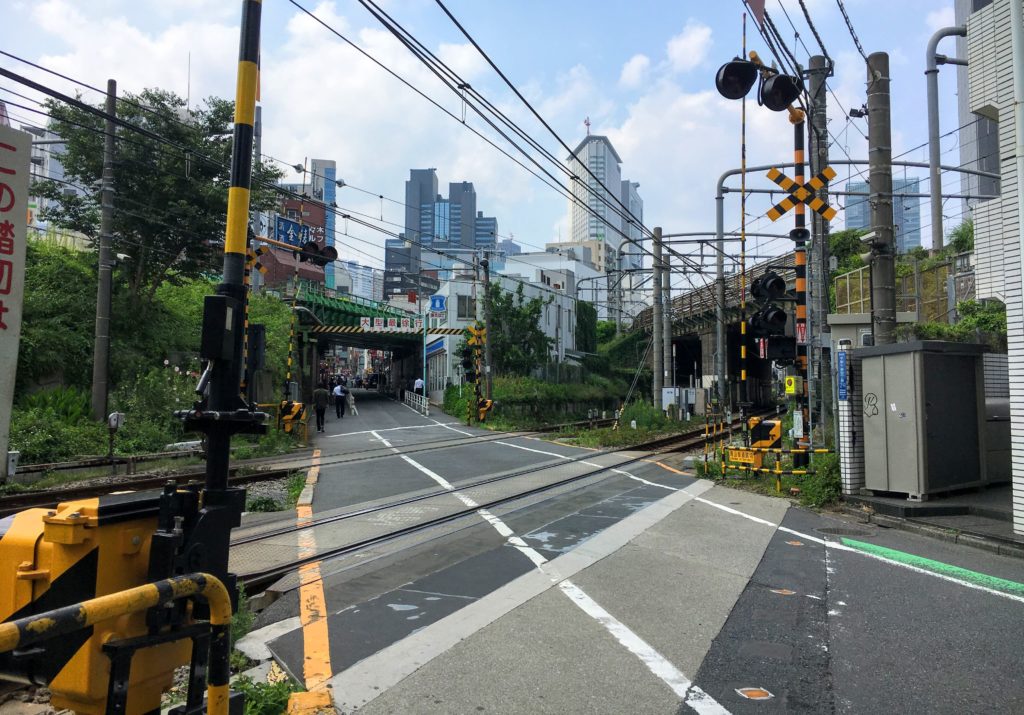
Three Days in Tokyo Itinerary
Day 1: tsukiji, ginza, imperial palace, tokyo station, akihabara, asakusa.
Spend your first day in Tokyo on the East side of the city, where you can experience both the traditional side and the flashy, futuristic parts of Tokyo.
Stops on Day 1 of my Tokyo three-day itinerary include Asakusa’s famous Sensoji temple, Tsukiji fish market, Ginza, and the anime capital of Japan: Akihabara.
Stop 1: A Taste of Tsukiji Market
The world-famous Tokyo tuna auction moved from Tsukiji to the Toyosu neighborhood in 2018. The Tsukiji Outer Market and many street food stalls still exist in Tsukiji however, are well worth the visit. Many stalls start closing around noon, so Tsukiji is a great place to visit early in the morning during your three days in Tokyo itinerary.
Wander through the countless stalls selling fresh seafood, packaged and dried seafood, and other traditional snacks and candies. Eat your way around independently or with a local guide , and try fresh clams, sea urchin, crab legs, even beef kebabs!
How to get to Tsukiji market: Tsukiji market is on the Hibiya subway line, which is reachable via a transfer from the JR Yamonote line at Yurakucho Station.
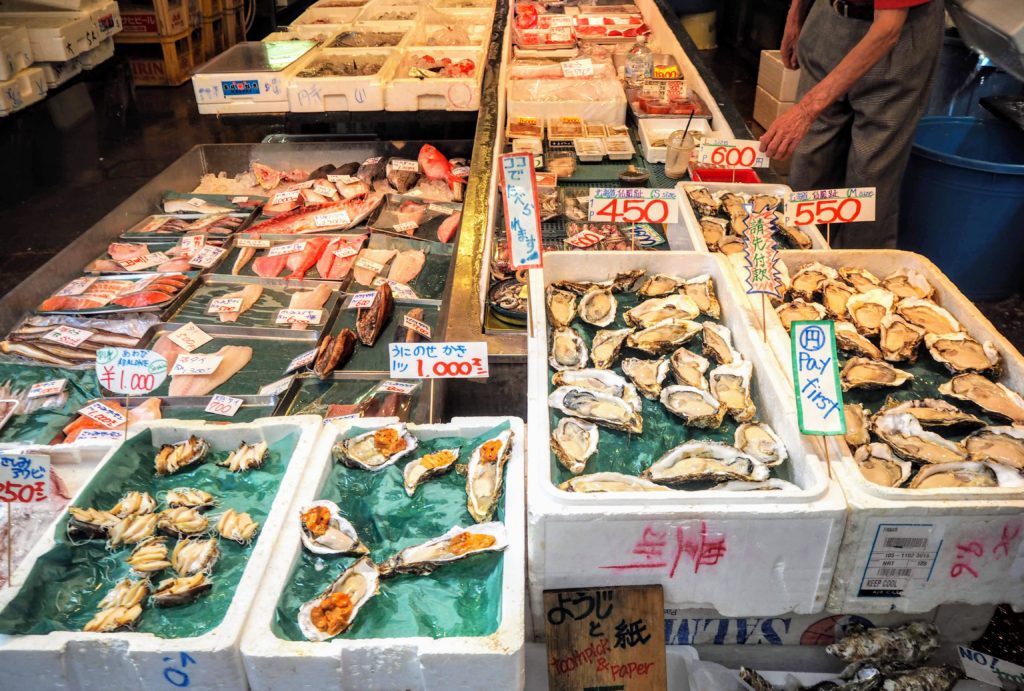
Stop 2: Flashy Ginza
A 20-minute walk from Tsukiji Fish Market is the Ginza neighborhood. What 5th Avenue is to New York City is Ginza to Tokyo. It’s the perfect place for high-end clothing shopping or just shopping for souvenirs during your three-day Tokyo itinerary.
Stores I recommend not missing are the 6-story Loft, a home-goods and lifestyle store than sells useful and quirky items that make perfect souvenirs. Itoya is a 11-story stationary store near Loft, where you can buy beautiful Japanese paper, cards, and envelopes, as well as fancy pens, inks, and stamps.
For high-end shopping, check out Ginza Six department store. Your typical UniQlo, GU, and H&M shops can be found in Ginza also.
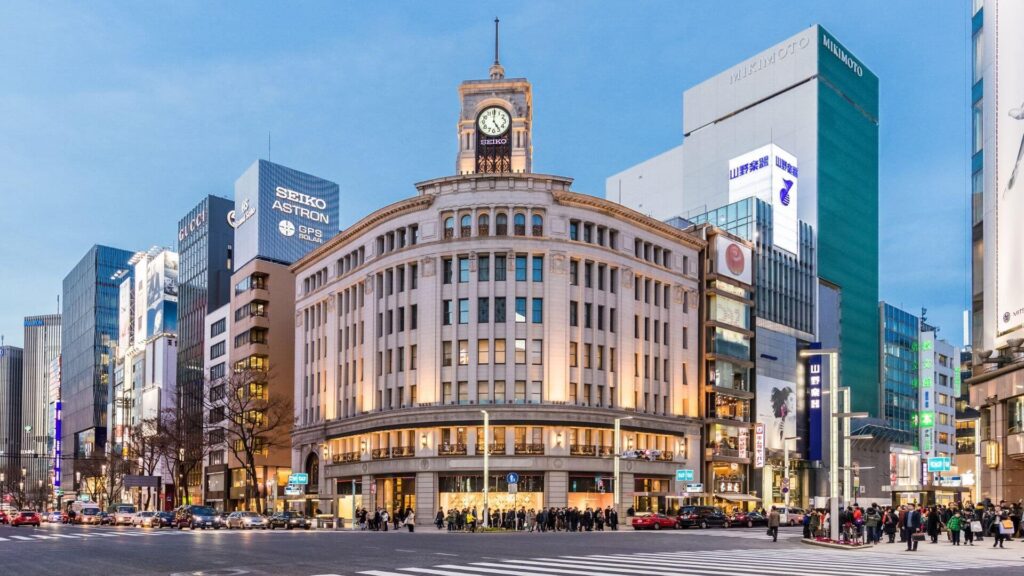
Stop 3: The Imperial Palace Gardens
From Ginza, it’s another 20-minute walk north to Tokyo Station, where you can store your Ginza shopping spree goods in a locker if you need. Just to the west of Tokyo station is Tokyo’s Imperial Palace Gardens.
This area in Tokyo has had historical significance for centuries, and is still used as the Imperial Residence today. Walk around the gardens, learn about the history, and admire the architecture that has been preserved since the Edo-era.
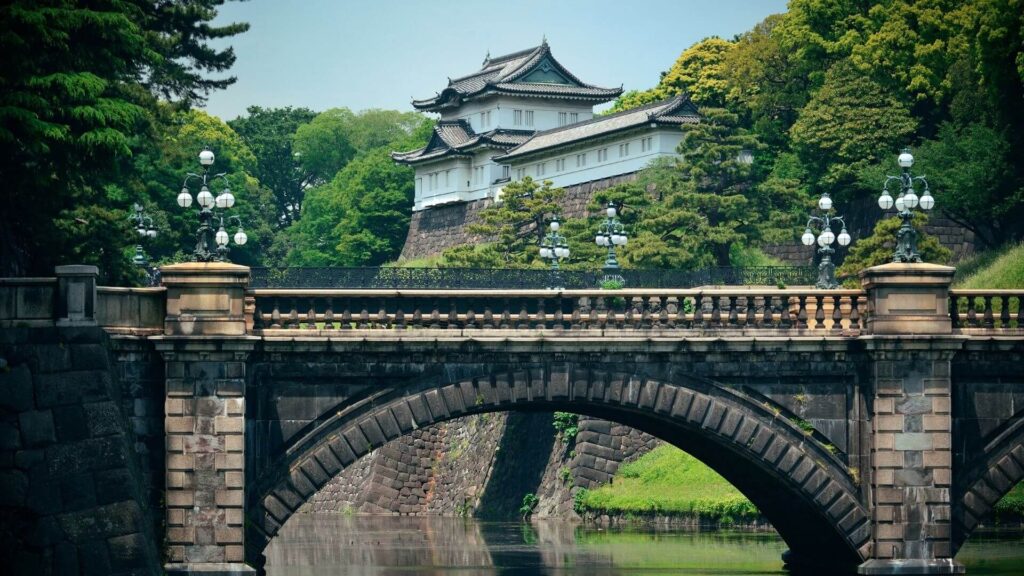
Stop 4: Tokyo Station
After you’ve wandered the extent of the Imperial Palace Gardens, head back to Tokyo Station. One of the busiest stations in Tokyo also has a wonderful underground shopping area and food court, perfect for a mid-day break during your three-day Tokyo itinerary.
Check out B1 of Tokyo Station, home to Tokyo Character Street , where a dozen little shops dedicated to different character series, are lined up. Favorites include Pokemon , Dragon-Ball Z, Crayon Shin-chan, Studio Ghibli , and Hello Kitty. Shopping in Character Street is on my list of cutest things to do in Tokyo .
Have lunch at any of the restaurants also on B1 of Tokyo Station, where countless Japanese comfort foods are represented. Check out Tokyo Ramen Street , where satellite shops of famous ramen restaurants from around Japan can be found.
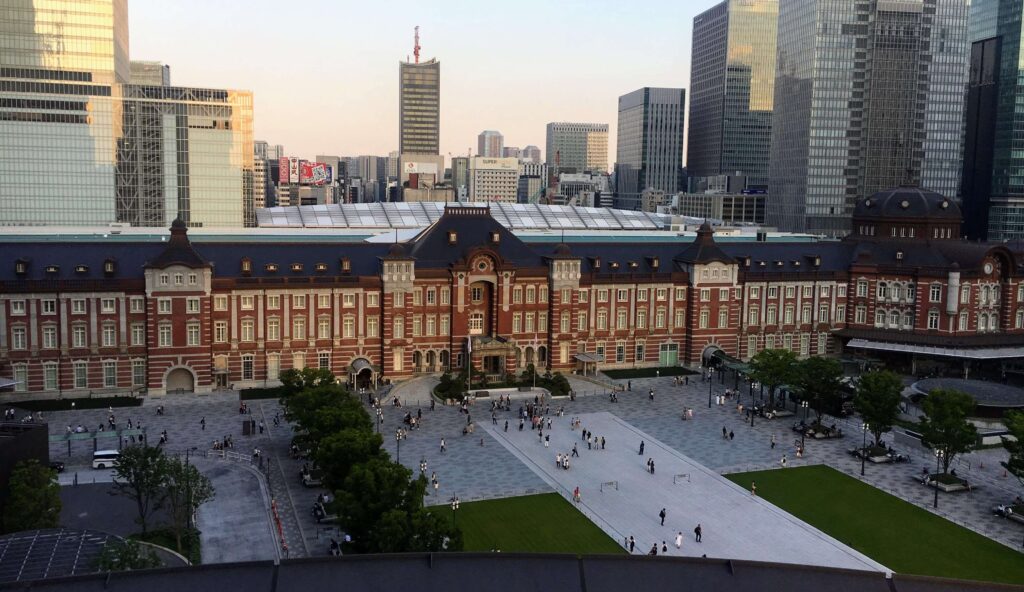
Stop 5: Anime in Akihabara
How to get to Akihabara: From Tokyo Station, hop on the JR Yamanote Line (or walk about 30-40 minutes) to reach Akihabara.
If you have an anime or manga fanatic traveling with you during your three days in Tokyo itinerary, Akihabara is definitely worth a stop.
What is known as the anime capital of Japan is home to shops selling electronics, games, CD’s and DVD’s, and anime goods. It’s also home to a variety of Tokyo’s famous maid cafe’s (on my list of WEIRDEST things to do in Tokyo).
If your Japan travel posse is not into electronics, J-Pop, or manga and anime however, Akihabara can be skipped to save time during three days in Tokyo.
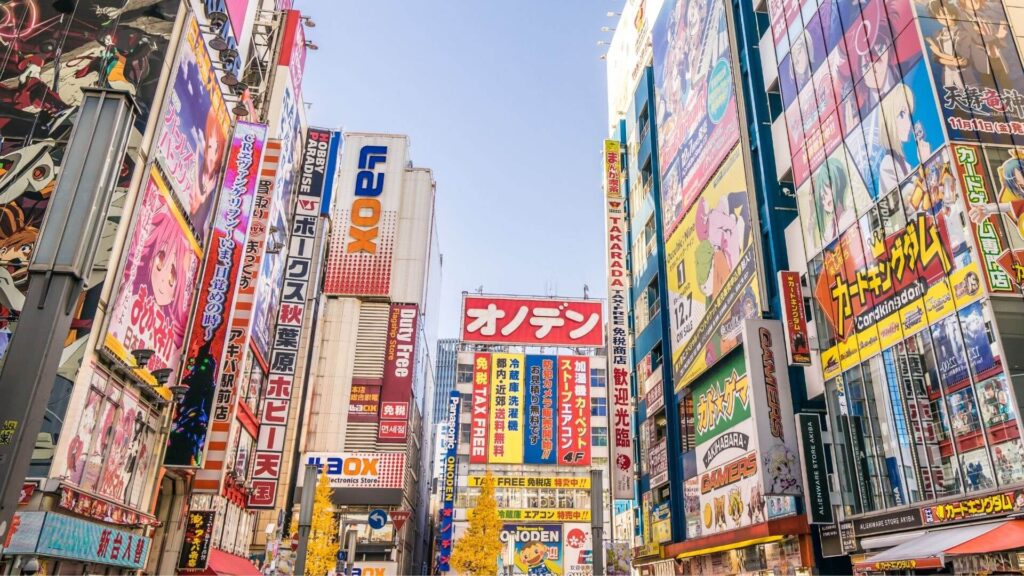
Stop 6: Cultural Asakusa
How to get to Asakua from Akihabara: Take Yamaote Line to Ueno, then change to the Ginza subway line to Asakusa.
Asakusa and the Senso-ji Temple are some of my favorite places in Tokyo. Senso-ji temple is one of the most iconic cultural spots in Tokyo with its massive red, traditional structures, and is an unmissable Tokyo bucket list destination. In addition to being a tourist destination, you’ll see locals visiting and taking part in traditional temple rituals as well. You can partake by pulling an omikuji fortune and throwing a coin into the offertory box before praying to the gods in the main temple building.
At nearby Nakamise Street you can pick up any type of Japanese souvenir you can imagine, from keychains and magnets to foldable fans, fancy knives, tea sachets, and more.
Asakua is a great place to embark on a Tokyo Food Tour because of all its street food options. If gaining elevation is your priority during this Tokyo three-day itinerary as well, check out the Tokyo Skytree nearby!
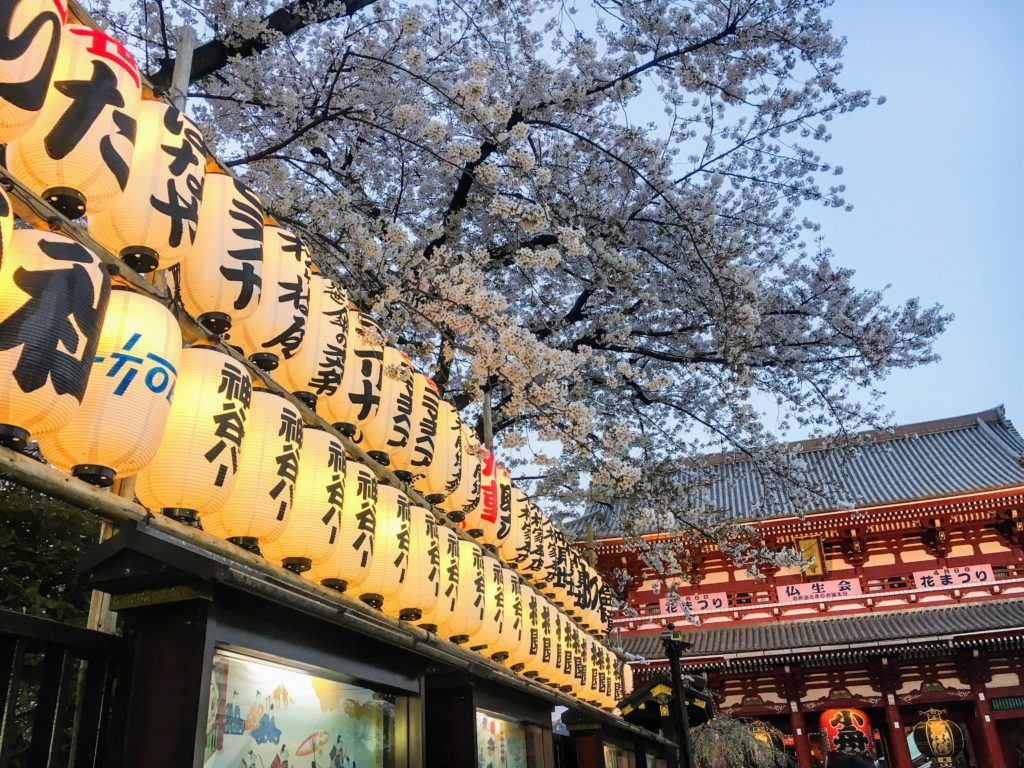
Day 2: Roppongi/Naka-Meguro, Shibuya, Meiji Jingu, Harajuku, Omotesando and Shinjuku
Spend Day 2 of your 3 day Tokyo itinerary in the heart of the city, visiting famous sites like the Shibuya Crossing, Takeshita Street in Harajuku, and Shinjuku Gai.
No day in Tokyo is complete without a visit to a historic shrine or temple, so spend some time at the famous Meiji Jingu as well.
Stop 1: Roppongi or Naka-Meguro
How to get to Roppongi and Naka-Meguro: Both neighborhoods are on the Hibiya subway line, which can be reached by transferring from the Yamanote JR line at Shibuya or Yurakucho train stations.
If you’re into the arts, head to Roppongi and check out the MORI Art Museum and the Tokyo City View Observation Deck. Both are located in the Roppongi Hills MORI Tower, 50+ floors above Tokyo. Buy tickets to skip the line here . If you love the views, check out my post on the best Tokyo viewpoints !
Not into museums? Head to Naka-Meguro, a quiet neighborhood home to the Starbucks Reserve Roastery (the perfect way to start your day) plus many other boutique shops and cafes. A river running through Naka-Meguro is famous during cherry blossom season, when the white and pink trees are hanging down over the river.
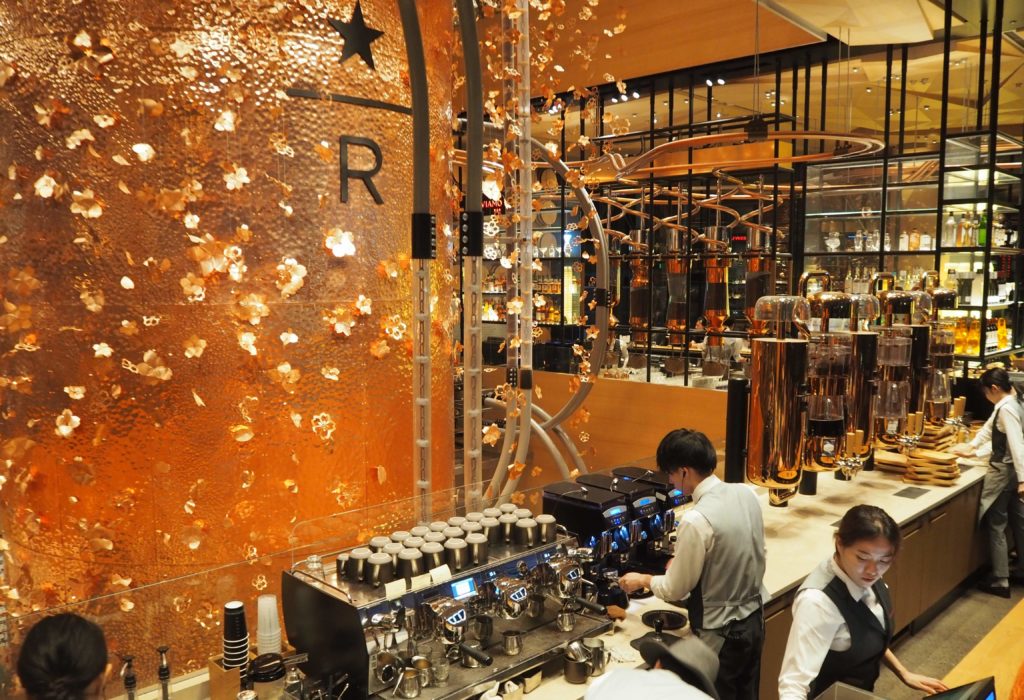
Stop 2: Shibuya
How to get to Shibuya: Hop back on the Hibiya subway line to the Yamanote Line, which will take you to Shibuya station.
Shibuya is everything a young person dreams of when thinking of Japan. You can’t spend three days in Tokyo without experiencing the Shibuya crossing, and exploring Shibuya’s flashy lights, skyscrapers filled with boutique shopping, and game centers.
Start by heading to the Shibuya Starbucks, which is a great place to relax and enjoy amazing views of the Shibuya Scramble Crossing.
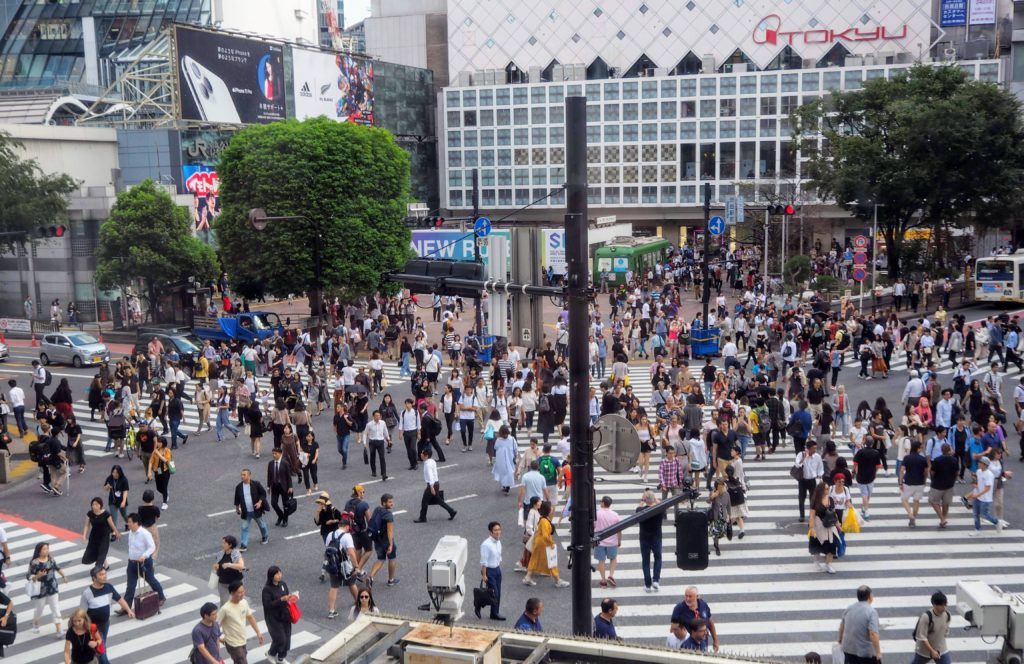
For female travelers to Tokyo, check out Shibuya 109 , a building filled exclusively with feminine clothing, shoes, handbags, and jewelry stores. Even if you’re not into Japanese fashion, it’s an awesome place to check out the styles that are trendy with the locals.
Shibuya is home to some of the biggest and baddest shops Japan is famous for. Check out Tower Records if you’re in to music, the massive Loft stationary store, and Shibuya’s Mega Don Quijote. In Shibuya there are also several game centers where you can try your hand at claw machines, or take puri-kura photo booth photos.
If you’re looking for an amazing vegan lunch spot, check out Nagi Shokudo in Shibuya, one of Tokyo’s top vegan restaurants.
Tip : If you’re traveling with vegetarian and non-vegetarians in your group, check out my post of Tokyo restaurants with both veg and non-veg options.

Stop 3: Meiji Jingu
Walk about 20 minutes north from Shibuya to Harajuku (or take the Yamanote line one station). Before you follow the crowd to Takeshita street (more on that later), take the path under the massive torii gate towards Meiji Jingu. Meiji Jingu is a Shinto shrine dedicated to Japan’s first emperor and empress.
The quiet, forested grounds will transport you back to nature, and back in time before Shibuya and Harajuku even existed. The Meiji Jingu shrine is free to visit, and everyone can take part in traditional Japanese Shrine rituals there. Purchase a wooden plaque to write a wish on, and hang it from the holy tree next to the shrine. A priest every day blesses the tree and its plaques so the gods will hear the wishes.
Tip : If you’re visiting Tokyo on a weekend, Yoyogi Park next to Meiji Jingu often has cultural events taking place such as Japanese dance or international festivals.
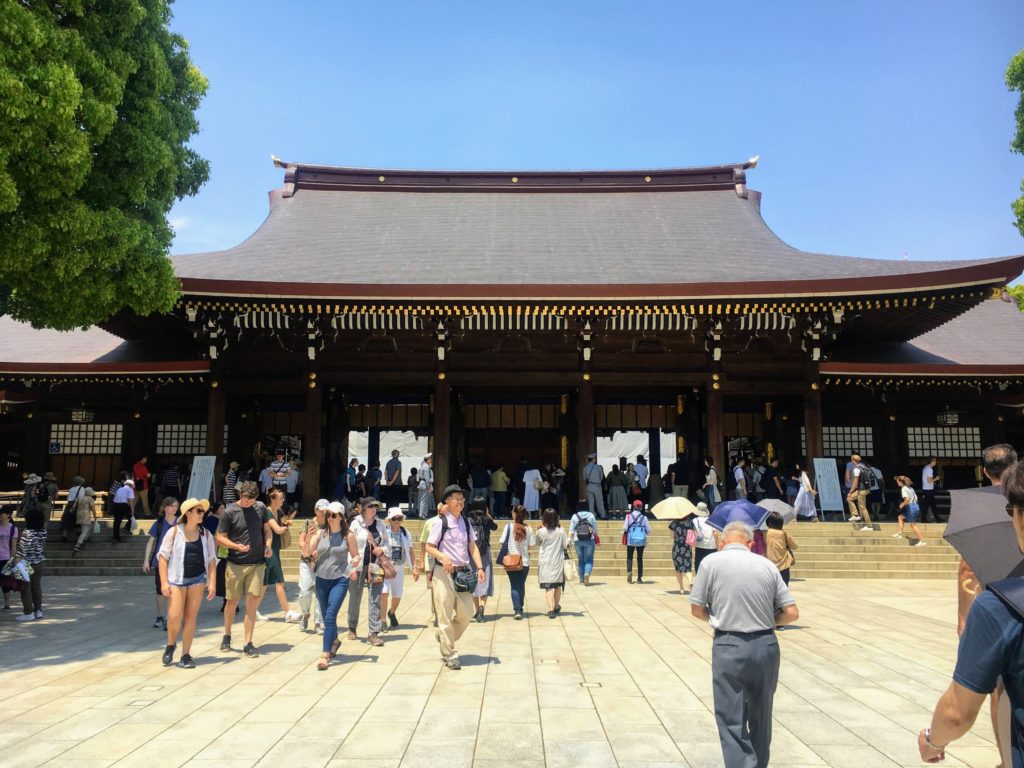
Stop 4: Harajuku
Harajuku is a must-see during your three days in Tokyo. This neighborhood, especially Takeshita street, is famous for being the kawaii , or cute, capital of Tokyo. Everything here is rainbow-colored, cute, fluffy, and covered in unicorns and kittens. Literally.
Below the surface on Takeshita street are also several boutique stores selling different styles of Japanese fashion as well, such as skater, rock-n-roll, hip-hop, and even goth. One of Tokyo’s largest DAISO ¥100 yen shops also calls Takeshita street home.
Try some quirky street food on Takeshita Street, like rainbow cotton-candy, Insta-worthy crepes, and colorful candy, or pet some adorable piglets at the micro-pig cafe !
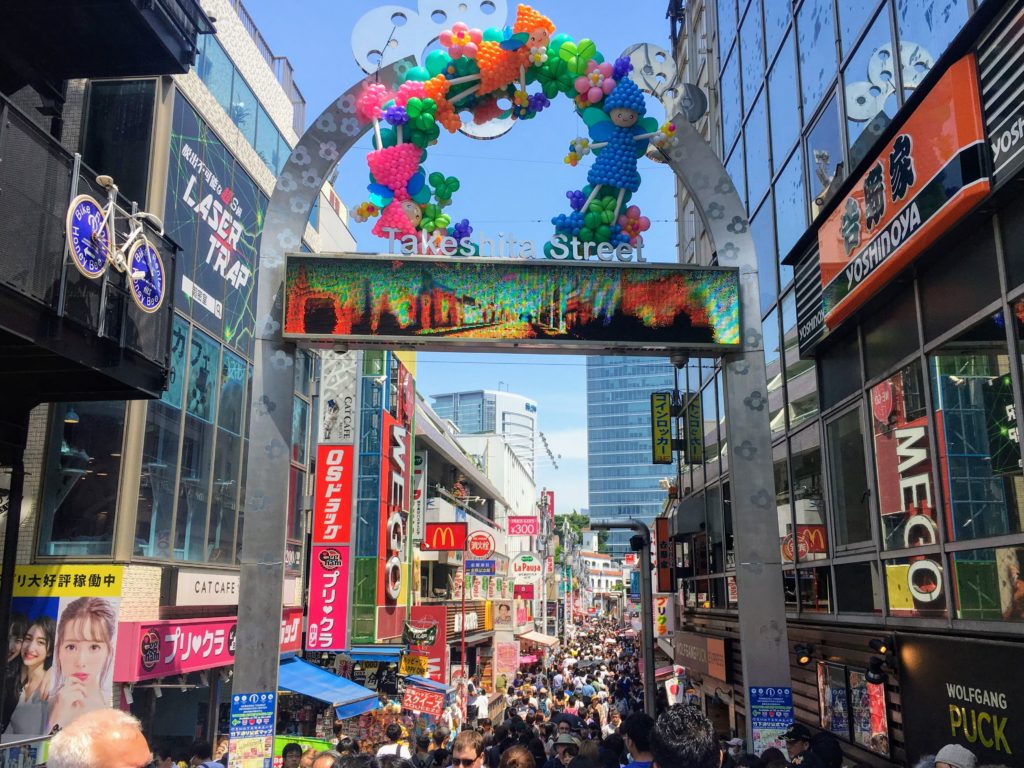
Stop 5: Omotesando
At the end of Harajuku’s Takeshita Street starts the Omotesando neighborhood.
Omotesando is famous for its high-end shops lining the main street, but there are many hidden gems here if you take the back streets. Copenhagen’s famous Flying Tiger shop has a location here, and you can buy some creative things at “ The Awesome Store ” too.
If you’re looking for gorgeous and classy Japanese souvenirs, check out Oriental Bazaar (reopening in 2023). The bazaar has half a floor dedicated to Japanese yukata and kimono, and sell Japanese cloth, postcards, chopsticks, ceramic cups, bowls, and more.
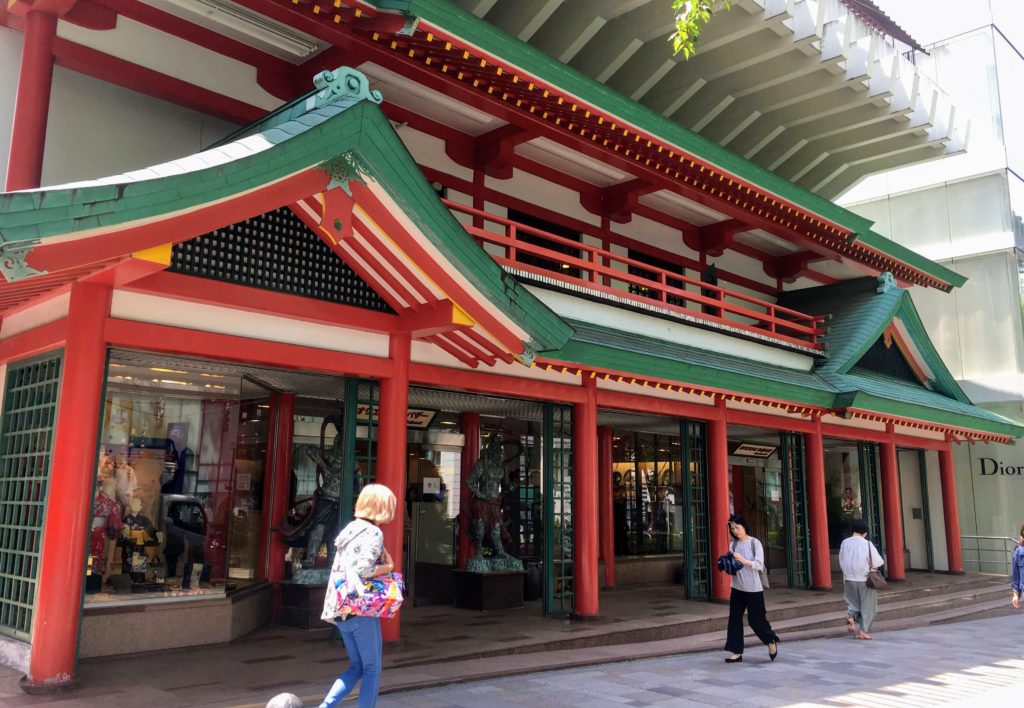
Stop 6: Shinjuku
No Tokyo itinerary is complete without spending time in Shinjuku, also must-visit Tokyo bucket list neghborhood.
It’s a great place to finish Day 2 of your three-day Tokyo itinerary, because I prefer Shinjuku at night. All the store signs are lit up, and it’s buzzing with the Japanese after-work crowd. Shinjuku has great photography opportunities with all the flashing advertisements, and also has countless places to drop in for a dinner of ramen, sushi, and a beer.
Don’t miss having a stroll around Shinjuku Gai even if you’re not drinking. Dozens of tiny bars here shelter people coming to relax after a day’s hard work. Shinjuku Gai is picture-perfect, filled with tiny alleyways with old-fashioned signs and Japanese lanterns lighting the way.
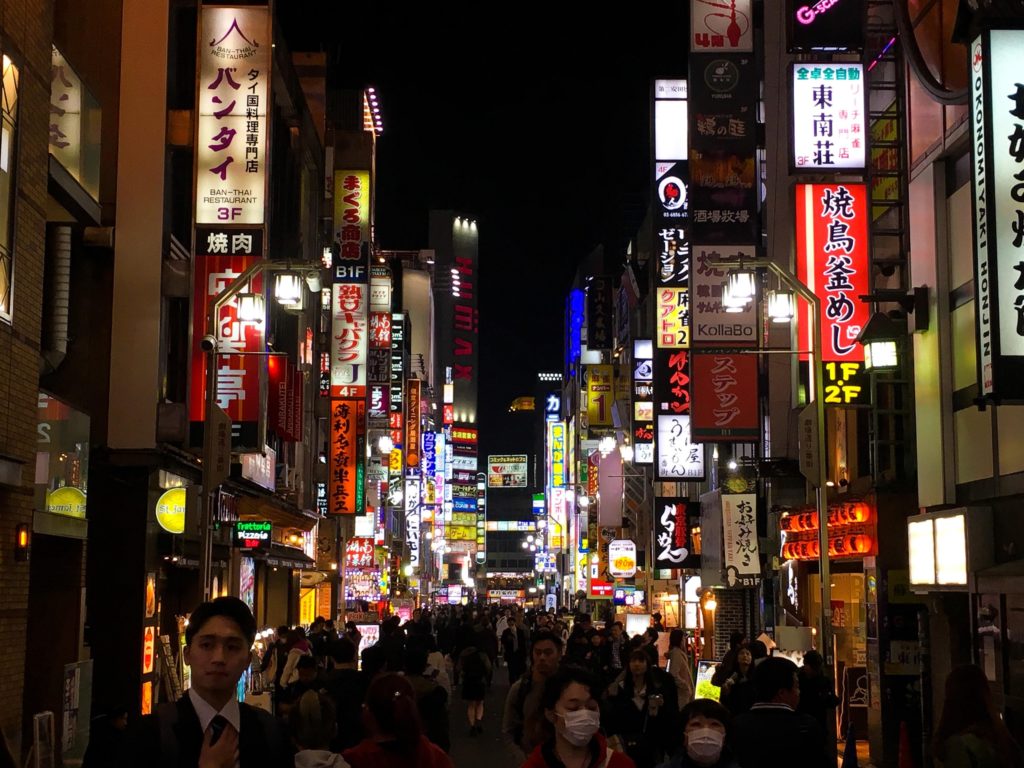
To get an amazing view over Tokyo any time of the day, head to Shinjuku’s Metropolitan Government Building. It’s the only FREE skyscraper Tokyo viewpoint , overlooking the city from the 48th floor. On clear days, even get a glimpse of Mt. Fuji !
Looking for other things to do in Tokyo?
- Check out the highlights – Top 15 Things To Do In Tokyo
- See Tokyo’s weird and quirky side – 40 Weird And Unique Things To Do In Tokyo
- Learn where to escape the crowds – Off-The-Beaten-Path Places In Tokyo
- Get out of the city for a day – Best Day Trips From Tokyo
- Gain some elevation over Tokyo – Six Amazing Tokyo Viewpoints
Day 3: Teamlab Planets, Yanaka Ginza, Nezu Shrine, Ueno
Finish up your three days in Tokyo by visiting the historic Yanaka Ginza neighborhood, visiting a world-famous Teamlab museum, then returning to any other Tokyo neighborhood that tickled your fancy.
At Tokyo’s famous Teamlab museums, guests immerse themselves in digital artwork displays. Although not very connected to Japanese culture or history, it’s an incredible bucket-list Tokyo experience.
Stop 1: Yanaka Ginza
How to get to Yanaka Ginza: Take the Yamanote line until Nippori Station, and exit the station towards the south.
Yanaka Ginza is a step back into Tokyo’s past, to get a glimpse at what the city may have looked like a century ago. Many of the shops have stayed true to their original craft and have sold the same goods for generations. Buy things like traditional rice crackers, soy sauce, ceramics, and Japanese handicrafts here. Of course there are more current stores like a ¥100 yen store and trendy boutique shops too.
One of my favorite sights here is a sake shop that has several open bottles lined up on ice at its store front. Pick a sake, then pop a squat at the chairs outside the store for some people-watching, just like the elderly locals do.
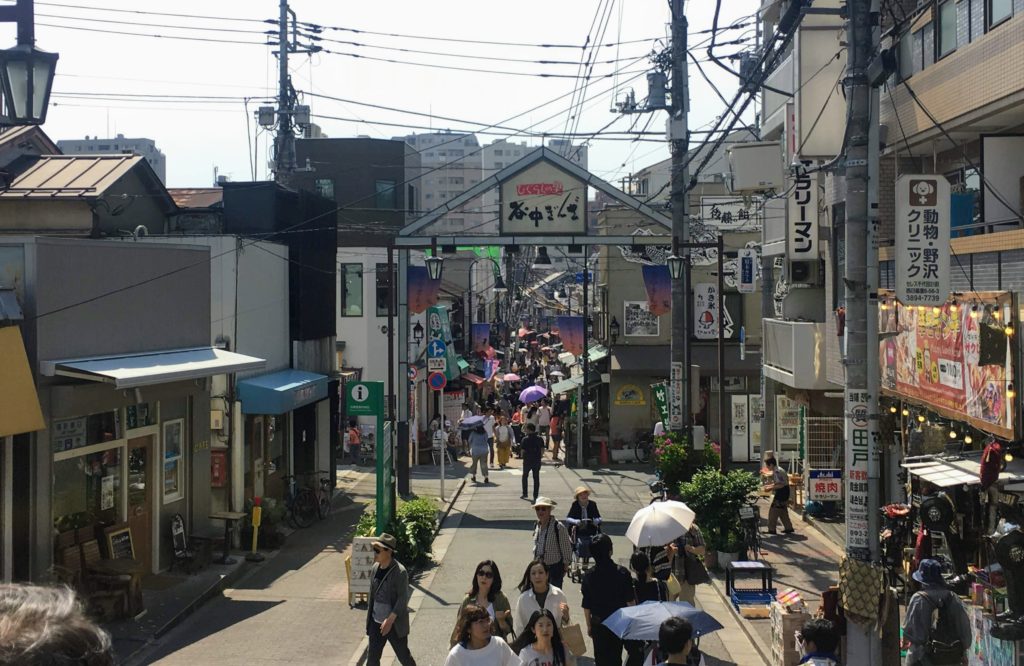
Stop 2: Nezu Shrine
About 20-30 minutes on foot through winding roads from Yanaka Ginza is the beautiful Nezu Shrine.
It’s a shrine still off-the-beaten-path in Tokyo and gives you a chance to experience a really local shrine. Nezu Shrine is a popular place for local newlyweds to be blessed by a priest, and get their traditional Japanese pictures taken.
If you’re spending three days in Tokyo during the April hydrangea season, Nezu Shrine will be overflowing with locals. There is a massive wall of hydrangea bushes along one side of the shrine, with a picturesque koi pond at the base of it.
Nezu Shrine is also famous for its line of torii gates, a bit smaller than the ones at Fushimi Inari Shrine in Kyoto , but they are brilliant nonetheless and less crowded to take pictures at.
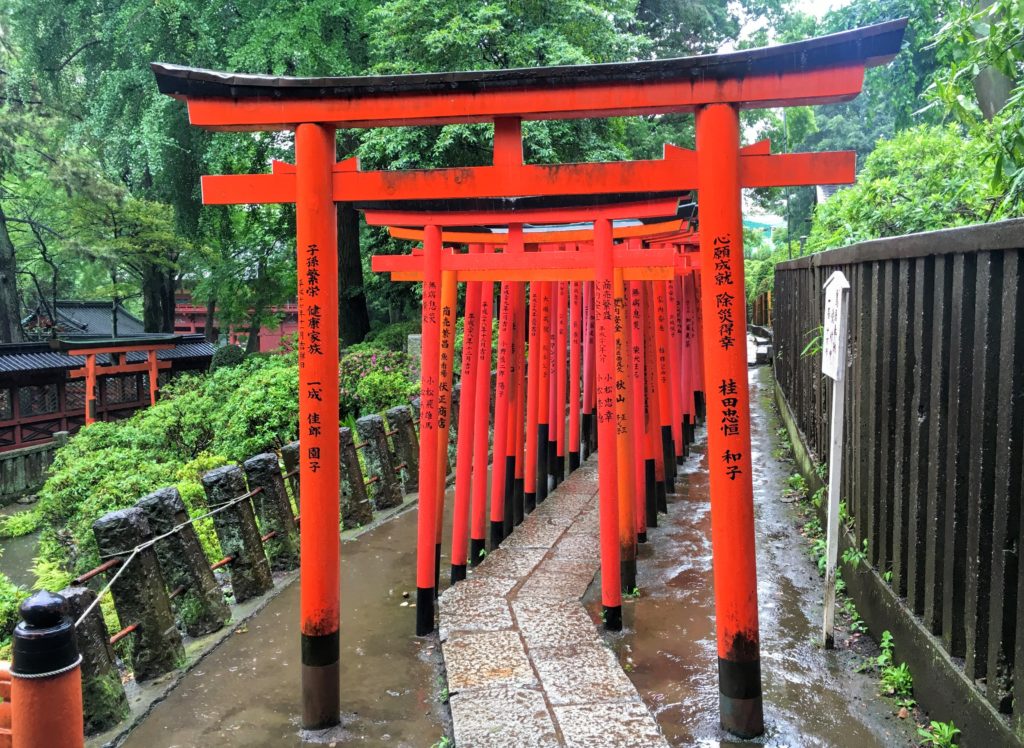
Stop 3: Ueno, etc.
A short walk from Nezu Shrine is Ueno Park, a large area home to shrines, museums such as the Tokyo National Museum, and even a zoo. From Ueno Station (on the Yamanote Line), you can decide if there are any other neighborhoods in Tokyo you’d like to see one last time.
You can also visit some places in Tokyo you might have missed on this itinerary, or explore somewhere completely new. Examples include:
- Ikebukuro , one of the most livably neighborhoods in Tokyo and home to a massive mall, Sunshine City.
- Shin-Okubo , known as Tokyo’s Koreantown. Stock up on K-Pop goods and Korean cosmetics and face masks here. Check out my article for SavvyTokyo about Shin-Okubo !
- Sky Tree viewpoint – Head to the tallest building in Tokyo and Japan to admire the city sprawl. Skip-the-line admission tickets here .
Alternatively, head back to the places you loved from this three day itinerary in Tokyo!
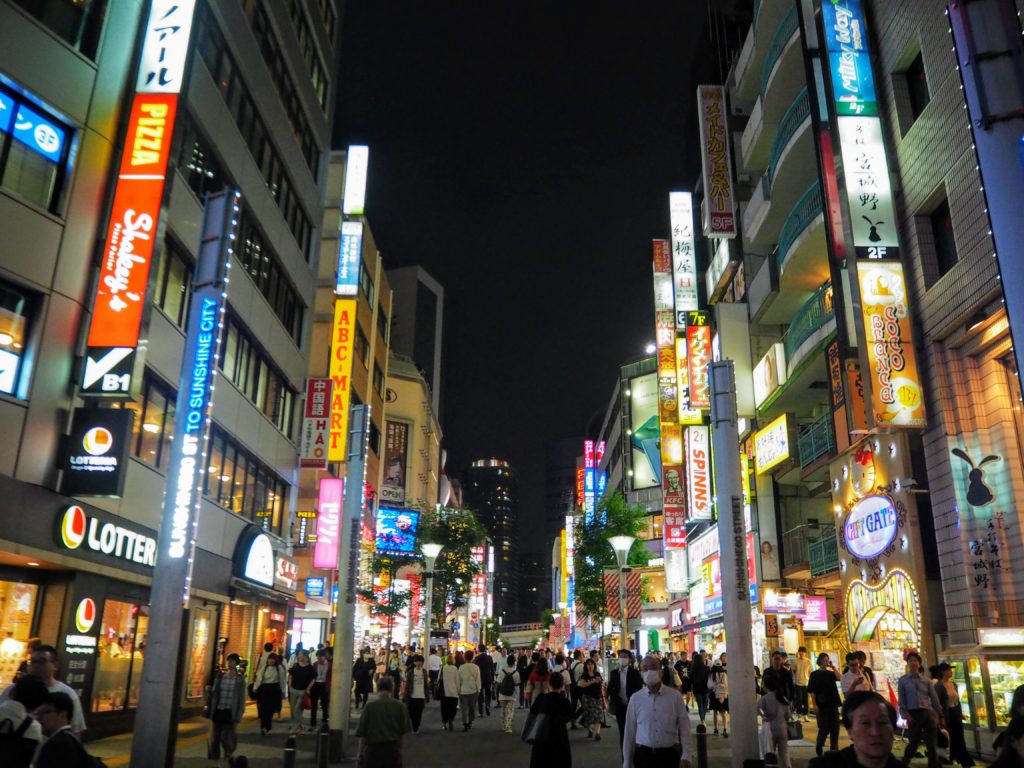
Stop 4: Teamlab Planets or Teamlab Borderless
The final stop on this three-day Tokyo itinerary is Teamlab Planets (in Toyosu) or the NEW Teamlab Borderless (in Azabudai Hills).
Teamlab museums are digital art museums that use lights and sounds to create a fully immersive art experience. Read about the two museum’s differences here to choose which one is right for you. Because these museums are open late, they’re a great way to spend time into the evening on the last day of your Tokyo itinerary. It’s an experience you’ll never forget!
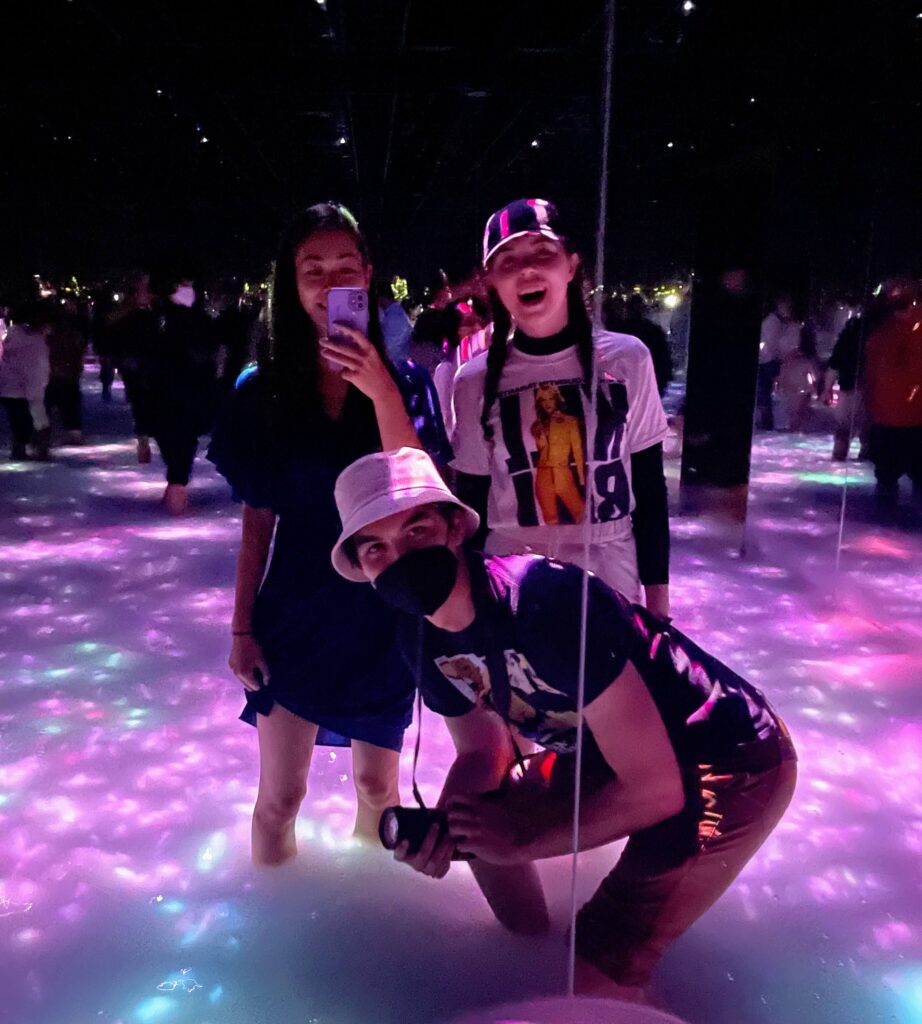
Three days in Tokyo is a short period of time. If you’re able to squeeze in more time to spend a day in nature, be sure to head to the outskirts of Tokyo to Mt. Takao.
If you’re a serious Miyazaki fan, it’s also worth spending time at the Studio Ghibli Museum in the Mitaka neighborhood.
Consider extending your three days in Tokyo itinerary to visit any of these wonderful day-trip locations from Tokyo as well!
Spending Three Days in Tokyo? Pin This Post!
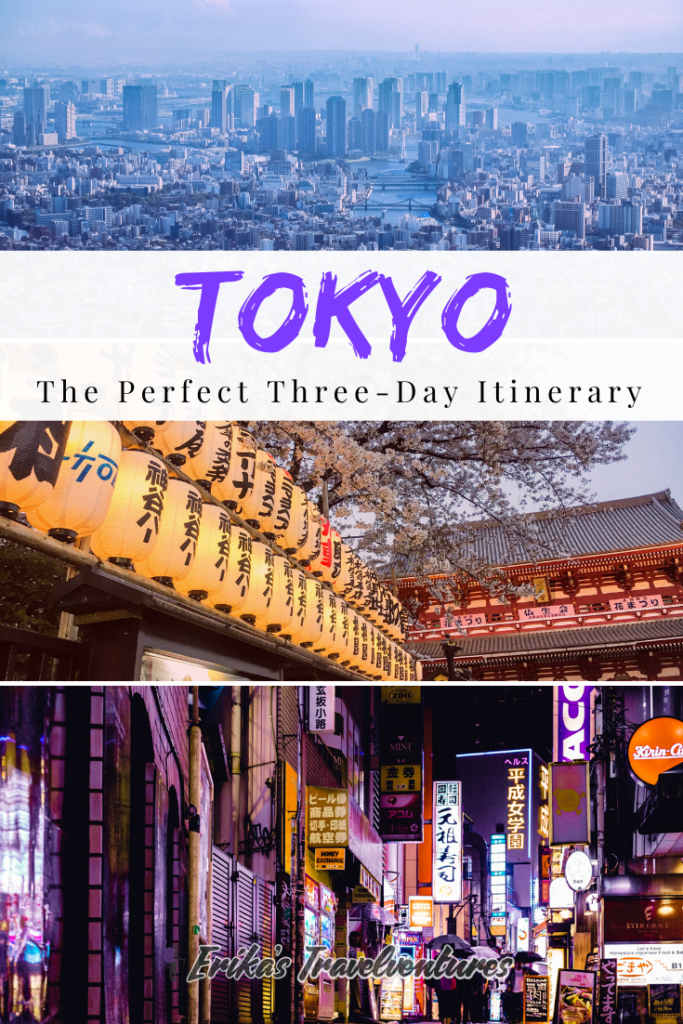
Are You Prepared For Your Next Travelventures?
- Book Your Flights – To find the cheapest flights, flexibility is key. I use both Google Flights and their low fare calendar, and Skiplagged , which uses airfare loopholes to get the lowest prices.
- Book Your Accommodation – Check out Booking.com for the largest selection of accommodation around the world. For backpackers, Hostelworld.com is also a favorite.
- Buy Travel Insurance – It’s better to protect yourself from mishaps when traveling. Get a quote from World Nomads to see how much it’ll cost to get you covered!
- Check Visa Requirements – From E-Visas to Visas-on-Arrival, iVisa has all the info on country visa requirements. If one is required, you can order one hassle-free through their site.
- Book Local Excursions – Don’t miss out on world-class experiences by booking tours and tickets online, ahead of your arrival. GetYourGuide has fun experiences from all around the world, and Klook specializes in Asian destinations.
- Pack Your Essentials – Check out my posts about Long Term Travel Gear , and Carry-On Luggage Packing Essentials !
- Read my Travel Resources page for more budget travel tips.
You might also like:

Ghibli Museum vs Ghibli Park – Which should you visit?

30 Cute and Kawaii Things to do in Tokyo

25 Cool and Unique Hotels in Tokyo
Leave a reply cancel reply.
Your email address will not be published. Required fields are marked *
The Travel Sisters
3 days in tokyo: the perfect itinerary for first time visitors.
by The Travel Sisters | Mar 2, 2018 | Destinations | 10 comments

3 Days in Tokyo Itinerary for First Time Visitors
Our 3 day Tokyo itinerary covers the must sees in Tokyo in the first two days, so if you are only in Tokyo for 2 days just follow the itinerary for Day 1 and 2.
Tsukiji Fish Market

If your body is on a different time zone, your first day in Tokyo might be the best day for an early morning visit to the Tsukiji Fish Market , the biggest wholesale fish and seafood market in the world. Make sure to catch the tuna auction – spots are limited so you need to arrive at 3:00 am in the morning! After watching the tuna auction, make sure to enjoy some fresh sushi for breakfast. If you want to guarantee catching the tuna auction it might be easier to sign up for a tour here .

Visit the famous Sensōji (or Asakusa Kannon Temple) in Asakusa. Although the temple and surrounding area is very busy and packed with tourists, it is still a Tokyo must see.
The walk to Sensōji, Nakamise Dori, is lined with small shops selling various souvenirs. This is a good spot to knock out your souvenir shopping.

Spend a few hours in Akihabara, a district in Tokyo famous for its many electronics shops. One of the popular things to do in Akihabara is to visit a maid cafe .
Meiji Shrine/ Omotesando/ Yoyogi Park/Harajuku

If you enjoy window shopping take a walk on Omotesando which is a broad, tree-lined street that houses various top designer boutiques. As Omotesando comes to an end you will reach Yoyogi Park , a great spot for people watching. The best day for people watching is Sunday so you might want to do this on Day 1 or Day 3 if you are in Tokyo on a Sunday.
Also nearby is the famous Harajuku neighborhood. The main action is at Takeshita Dori, which is a short pedestrian walkway. Here you will see shops selling clothes for teens, and lots of Japanese youth and girls wearing Harajuku style.
Make sure to also visit the Meiji Shrine which is located right next to the Harajuku station.
Shibuya Crossing

Tokyo can be hectic so visiting a park is a nice way to spend a couple of hours during your time in Tokyo. One of the most beautiful parks in Tokyo is Shinjuku Gyoen National Garden which consists of three different types of gardens: traditional Japanese, formal French and an English garden. Home to a large number of cherry trees, it is a popular but also peaceful spot for hanami (cherry blossom viewing) during the spring cherry blossom season .

Now that you have seen the major sites in Tokyo, you can have some fun and do some of the unique things to do that Tokyo is known for.
Watch a Sumo Wrestling Tournament or Sumo Practice

Sumo is Japan’s national sport. Attending a sumo grand tournament is a fun and cultural experience we would recommend to anyone visiting Japan during the tournament.
The sumo tournament runs in Tokyo for 15 days at a time during January, May and September (exact dates vary each year). If you visit Tokyo outside of these dates, consider visiting a sumo stable to watch a sumo wrestling practice .
(If you are interested in attending a sumo wrestling match, check out our Tips for Watching Sumo Wrestling in Japan for the schedule, advice on finding tickets, choosing seats and other information that we think is helpful.)
Have a drink or meal at a themed café or restaurant

Tokyo is full of some interesting cafes from various animal cafes (cat cafes, dog cafes, owl cafes , rabbit cafes and a hedgehog cafe ) to maid cafes and even a robot restaurant . Read about our visit to a bunny cafe here .
Tips for Visiting Tokyo
• Most Japanese ATMS don’t work with foreign ATM cards. To find ATMs that work head to the nearest 7-11.
•Not sure when is the best time to visit Tokyo? While Tokyo is great city all year, the weather is most pleasant plus the city is the most beautiful in the spring and fall. To help you decide before you book your trip see related post: The Best Time to Visit Tokyo .
Getting to and Around Tokyo
• The best way to get around Tokyo is by the efficient and comprehensive metro system . If you plan to take the subway more than a couple of times, you might want to purchase a PASMO card . PASMO is a prepaid reloadable smart card that you can use for trains and buses without having to calculate and pay a separate fare each trip. You can purchase a PASMO card at airports or train stations.
• If you want to avoid figuring out how to get around you can also sign up for a Tokyo Hop-On Hop-Off Tour .
• The easiest way to get from the airport to your hotel is the Airport Limousine bus which drops you off right at your hotel door. The Limousine bus does not stop at all Tokyo hotels so check the website for more information.
• If you have too much luggage to take public transportation or the Airport Limousine does not stop by your hotel you can reserve a shared airport shuttle from Narita here and from Haneda here .
Where to Stay in Tokyo
It can be overwhelming deciding where to stay in Tokyo as there are so many hotels and neighborhoods. These are our top choices for every budget:
Grand Hyatt Hotel. This is a great hotel in Tokyo for those looking for a luxury experience or have hotel points to use. The Grand Hyatt Hotel has a great location and gets great reviews on tripadvisor. Click here to see the latest prices or read Tripadvisor reviews .
Park Hyatt Tokyo. This luxury hotel in Shinjuku is the hotel in the travel movie , Lost in Translation. Click here to see the latest prices or read Tripadvisor reviews .
Akasaka Excel Hotel Tokyu. This midprice hotel is where we usually stay in Tokyo. The location is super convenient -it is in the same building as a 7-11 and several restaurants and it is also across the street from the Akasaka-Mitsuke subway station with underground access to five different lines. Click here to see the latest prices or read our full review .
The Prince Park Tower Tokyo. This midprice hotel get good reviews. It has a great location and also offers a free shuttle to the closest train station. Click here to see the latest prices or read Tripadvisor reviews .
Richmond hotel Asakusa. This small modern hotel is located in a great location in Asakusa walking distance to the famous Sensōji Temple. Click here to see the latest prices or read Tripadvisor reviews .
Red Planet Asakusa. This newly built hotel also has a great location in Asakusa and offers great views of the Tokyo Skyline and Sky Tree from some rooms. Click here to see the latest prices or read Tripadvisor reviews .
The Best Tokyo Tours
Here are a few different tours you can join to make the most of your time in Tokyo.
This bus tour will take you to some of the places listed in my itinerary.
If you enjoy being active, you might enjoy this 4.5 hour bike tour .
Are you a foodie? This street food tour will let you taste the best of Japanese cuisine.
Hope you enjoyed our 3-day Tokyo itinerary . Have you been to Tokyo? If so, what would you do in three days?

10 Comments
Loved your 3 days in Tokyo itinerary. If you’re in Shinjuku, I’d add a stop at the micro-bars of Golden Gai after dark.
Haha, I think it’s great that you included cat cafe on your list! I would have loved to see a sumo match and the fish market. But for your next trip, I’d suggest a visit to one of the arcade’s for a round of Dance Dance Revolution and a trip to their fun photo booths! 🙂
I would love to visit Tokyo someday. This is a great itinerary, I would especially love to check out a cat cafe
I am always short of time when I travel. So, your list is just perfect for me. Sometimes, we want to do the best during the available time – and it is a perfect example of that
I thought 3 days in Tokyo wouldn’t be enough, but this guide definitely showed me that you can do a lot of things in those 3 days!
Great itinerary! Tokyo is such an epic city, but you break it down to a manageable itinerary. I’ll be keeping this in mind when I head there.
Love this guide to Toyko. It is such a great place to visit – but can be overwhelming for the first time visitor. I love the highlights you have chosen.
This brings me back! I was in Tokyo when I was 17 on a school trip. We flew in, crashed for a few hours, and then got up before dawn to go to the fish market. It was such a pain, but it did help us all kick the jet-lag!
What could be better than a ready-made travel itinerary! Thanks a lot, now I don’t have to worry about my leisure during my business trip. I’m travelling there in early May, and there must be some free time to fill in with some impressions. If I have enough time, I’d also go to Ashikaga Flower Park outside of Tokyo but not that far… It’s about wisteria tunnels, that must be just abloom during the time of my visit. Also, it would be great if I had time for Mount Fuji. Well, it’s some 150 km from Tokyo, but I hope I will make it. Mountains have always been my strong passion.
Thank you for this article! I’m heading to Tokyo soon for the first time and I’m still quite overwhelmed for what to do/where to go and this is very helpful.
Submit a Comment Cancel reply
Your email address will not be published. Required fields are marked *
Save my name, email, and website in this browser for the next time I comment.
Notify me of follow-up comments by email.
Notify me of new posts by email.

Subscribe to Blog via Email
Recent posts.
- Chase Freedom Flex 2024 2nd Quarter 5% Bonus Categories
- Discover 5% Cashback Calendar 2024: Categories That Earn 5% Cash Back
- Chase Freedom Calendar 2024 Categories That Earn 5% Cash Back
- All Southwest Airlines International Flight Destinations
- Chase Freedom Flex 2024 2nd Quarter 5% Bonus Categories – Activate Now!
Follow us on Facebook

Pin It on Pinterest

Ultimate 3-Day Tokyo Itinerary: A Weekend Getaway Filled with Tokyo’s Best
by Venese | Dec 28, 2022 | Japan Itinerary | 0 comments

If you find yourself with a three-day window to explore Tokyo , or are embarking on a weekend escapade to this bustling metropolis, maximizing your time becomes essential. While it’s crucial to weave in visits to Tokyo’s iconic historical and cultural landmarks, don’t overlook opportunities for shopping and indulging in the city’s vibrant nightlife scene. Dive into Tokyo’s kaleidoscope of attractions with this meticulously crafted 3-day Tokyo itinerary, designed to showcase the city’s main highlights and provide you with an unforgettable experience. From ancient temples to modern skyscrapers, traditional markets to trendy boutiques, and serene gardens to bustling streets, Tokyo offers a captivating blend of old-world charm and contemporary allure, ensuring there’s something for every traveler to discover and enjoy.
Table of Contents
(8:00-9:30) Tsukiji Fish Market
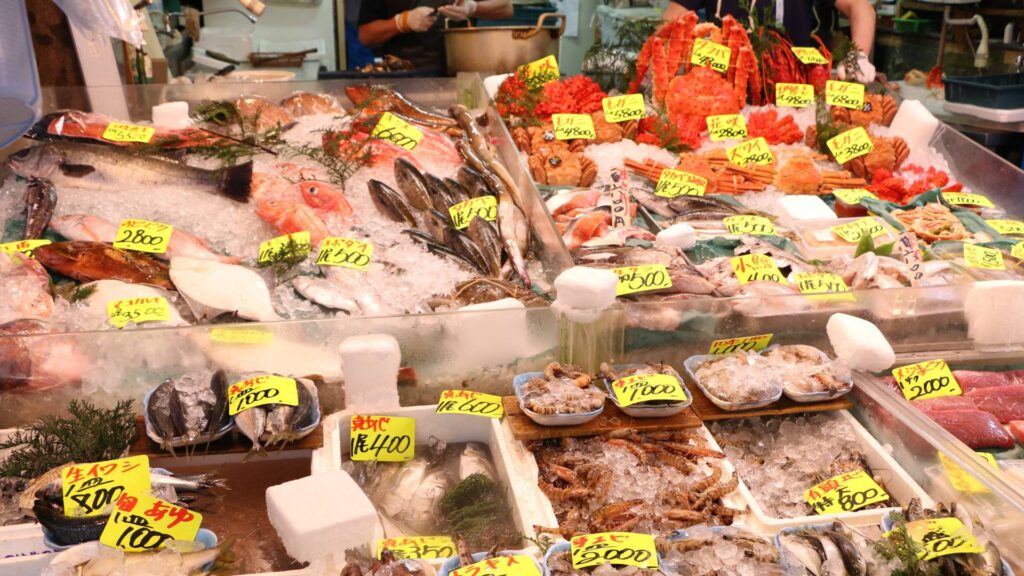
The Tsukiji Fish Market, renowned as Japan’s ‘Food Town,’ offers a vast array of traditional Japanese foods, ranging from wholesale to retail. This bustling market is a culinary haven, with numerous restaurants and eateries dotting the area, all showcasing the freshest fish and ingredients Japan has to offer.
Originally catering to wholesalers and professionals, Tsukiji Fish Market has evolved over the years to become a must-visit destination for consumers and tourists alike. Today, visitors can indulge in small meals and bite-size tastings, immersing themselves in the vibrant culinary scene.
The Tsukiji Outer Market remains the premier marketplace for customers seeking fresh seafood, vegetables, and Japanese traditional food materials. Whether you’re a food enthusiast or simply looking to savor authentic Japanese cuisine, Tsukiji Fish Market promises an unforgettable gastronomic experience.
If you are unsure how to approach this, take a look at Arigatojapan’s brilliant Tsukiji market tour! https://arigatojapan.co.jp/tours/classic-tsukiji-breakfast-tour/
This way you won’t miss any incredible food or experiences while visiting Tsukiji!
(10:00-11:00) Skytree Observatory

The Tokyo Skytree, located in Sumida, the heart of Tokyo, stands as the iconic symbol of modern Japan, blending cutting-edge technology with traditional Japanese craftsmanship. Soaring to an impressive height of 634 meters, the Tokyo Skytree claimed the title of the world’s tallest skyscraper, as recognized by Guinness World Records in November 2011.
Ascend to the 350-meter-high Tokyo Skytree Tembo Deck via the elevator and marvel at the breathtaking cityscape below. On a clear day, you can even catch a glimpse of the majestic Mount Fuji in the distance. Take your experience to new heights at the Tembo Galleria, a remarkable tube-shaped hallway suspended 450 meters above ground, offering a unique sensation of walking through the sky.
Whether you’re admiring the panoramic views or venturing into the captivating Tembo Galleria, a visit to the Tokyo Skytree promises an unforgettable journey above the bustling metropolis.
(11:00-12:00) Solamachi

Nestled at the base of the Tokyo Skytree lies Tokyo Solamachi, a sprawling shopping and entertainment complex. Launched in May 2012, this commercial hub boasts 312 stores offering a diverse range of products and experiences.
Beyond its role as a bustling new downtown destination, Tokyo Solamachi serves as a vital gateway connecting the city center with the Tokyo Skytree and the Tobu railway line. It has quickly become a must-visit destination for tourists from Japan and around the world, drawn by its vibrant atmosphere and extensive offerings.
From trendy boutiques to delectable dining options, Tokyo Solamachi offers something for everyone, making it the perfect complement to your visit to the iconic Tokyo Skytree. Explore, shop, and indulge in the vibrant energy of Tokyo’s premier shopping and entertainment destination.
(12:30-13:30) Yukata Experience
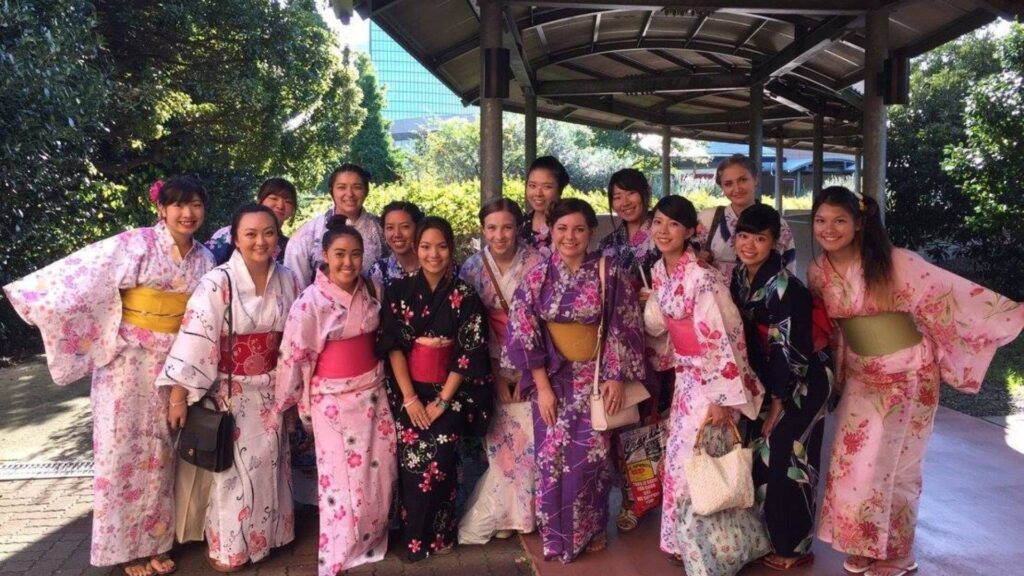
Embrace the essence of summer fashion with the traditional Japanese garment known as the yukata. Characterized by its lighter fabric and looser fit, the yukata is a staple attire worn during the warmer months, symbolizing the season’s vibrancy and charm. Often showcased in traditional Japanese performing arts and dances, it embodies the spirit of Japanese culture and heritage.
For an authentic cultural experience, don a yukata and immerse yourself in the captivating streets of Asakusa. This historic neighborhood, nestled in the heart of Tokyo, offers a glimpse into Japan’s rich traditions and customs. As you wander through its bustling streets and quaint alleyways, adorned in traditional attire, you’ll feel transported to a bygone era.
From admiring the majestic Senso-ji Temple to exploring the lively stalls of Nakamise Shopping Street, wearing a yukata adds an extra layer of authenticity to your Asakusa adventure. Capture the essence of Japanese elegance as you stroll beneath the shade of cherry blossom trees and savor local delicacies at charming tea houses and eateries.
Whether you’re soaking in the serenity of Asakusa’s historic gardens or participating in traditional cultural activities, such as tea ceremonies or calligraphy workshops, the yukata serves as a timeless symbol of Japanese identity and pride. Experience the allure of summer in Asakusa as you embrace the spirit of Japanese fashion and culture during your 3-day Tokyo itinerary.
(13:30-15:00) Sensoji Temple, Shopping Street
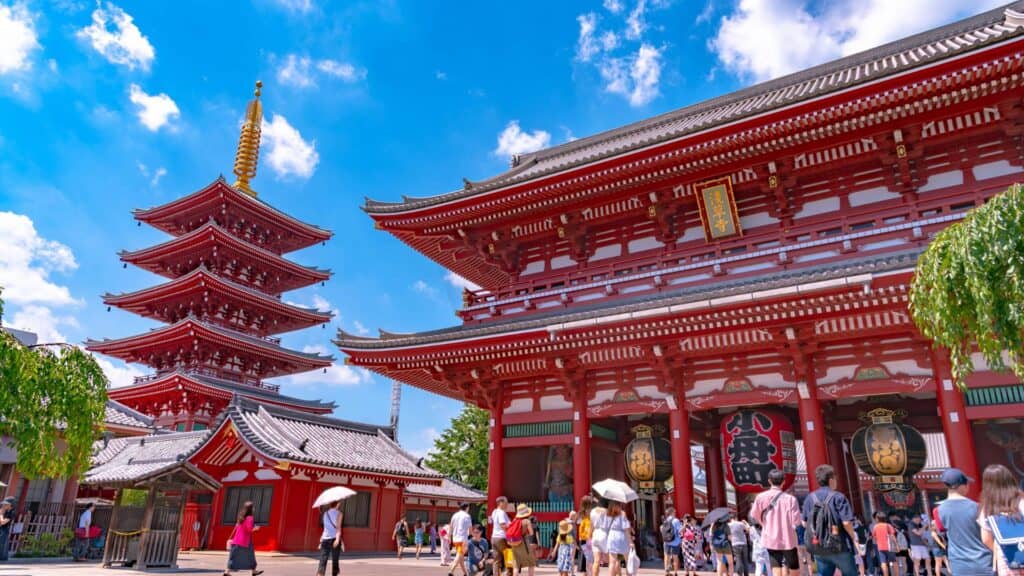
When it comes to iconic tourist spots in Tokyo, Senso-ji Temple reigns supreme. Regarded as one of the most renowned attractions in the city, Senso-ji draws approximately 30 million visitors annually from around the globe, making it a must-visit destination for travelers both domestic and international.
Asakusa’s unmistakable symbol is the towering red lantern adorning the Kaminarimon (Thunder Gate) at the temple’s entrance. Stepping into the neighborhood surrounding Senso-ji, visitors are transported back in time to the Edo period, with its traditional architecture and charming streets retaining the old-world charm of Tokyo.
Whether you’re admiring the grandeur of Senso-ji Temple or exploring the quaint alleys of Asakusa, immerse yourself in the rich history and cultural heritage that this vibrant neighborhood has to offer. Discover the allure of old Tokyo as you wander through the bustling streets lined with shops, restaurants, and historical landmarks.
(15:30-16:30) Optional Ramen Making Experience
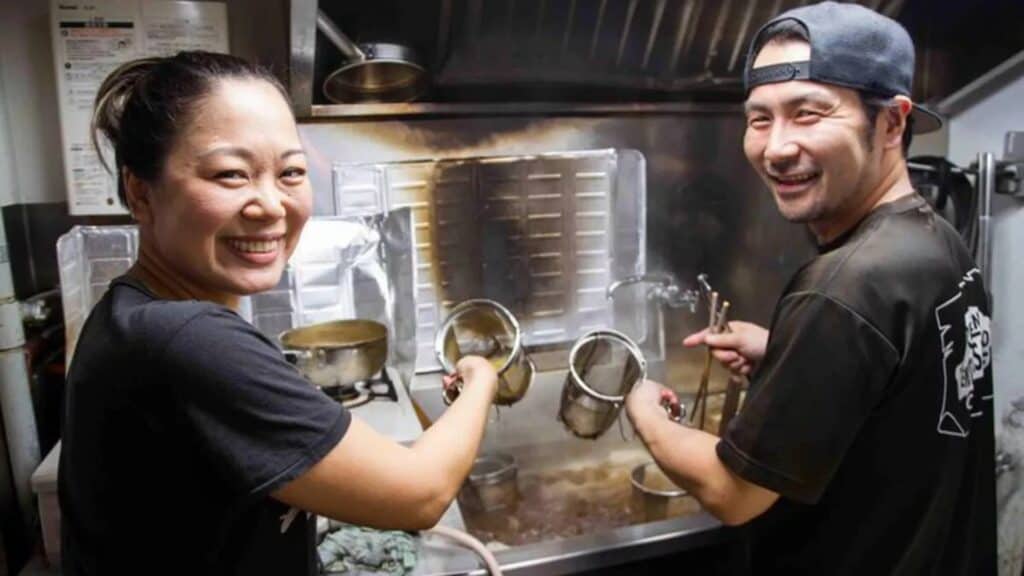
Immerse yourself in the art of Japanese cuisine with a hands-on ramen-making experience. Step into an authentic Japanese ramen kitchen, where you’ll have the opportunity to learn the traditional techniques for crafting fresh ramen. Under the guidance of a skilled ramen chef, you’ll create two bowls of delectable ramen from scratch, using all the necessary Japanese cooking tools.
Learn the intricate process of preparing ramen noodles, from kneading the dough to shaping and cutting the noodles to perfection. Discover the secrets behind creating the rich and flavorful broth that forms the heart of every bowl of ramen. As you ladle the broth over the freshly cooked noodles, you’ll have the chance to customize your ramen with an array of toppings and garnishes.
Unlock the secrets of authentic Japanese ramen-making and embark on a culinary journey that will tantalize your taste buds and deepen your appreciation for this beloved dish. Whether you’re a novice cook or a seasoned food enthusiast, this hands-on experience promises to be both educational and delicious.
Optional Day 1 Destination: Shimokitazawa
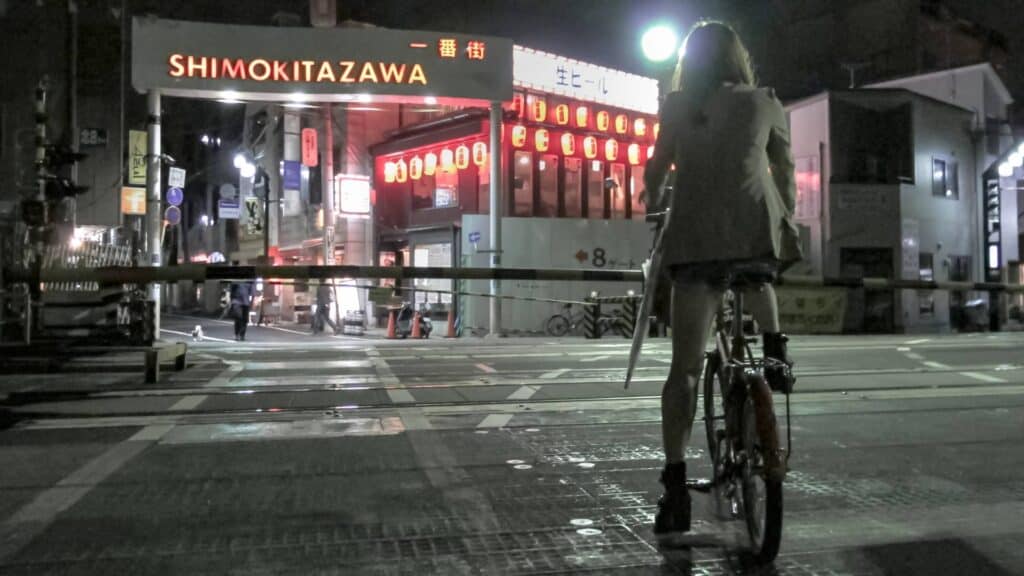
Shimokitazawa, a lively area of western Tokyo only a few stops from Shibuya, is well-known for its profusion of second-hand shops. You may find anything you need for at least 20% off the original sale price, including everything from designer clothing to brand-new phones. Shimokitazawa is sometimes called “Shimokita” for short because it has many theatres, galleries, live houses, cosy cafés, and izakaya pubs. This is a location in Tokyo that is a must-visit for everyone looking for something special!
Since the 1970s, Shimokitazawa has served as the hub of Japan’s counterculture scene. Many of the local galleries and venues support independent artists and creatives from the area.
(9:00-10:30) Optional Tokyo Tower Escapade
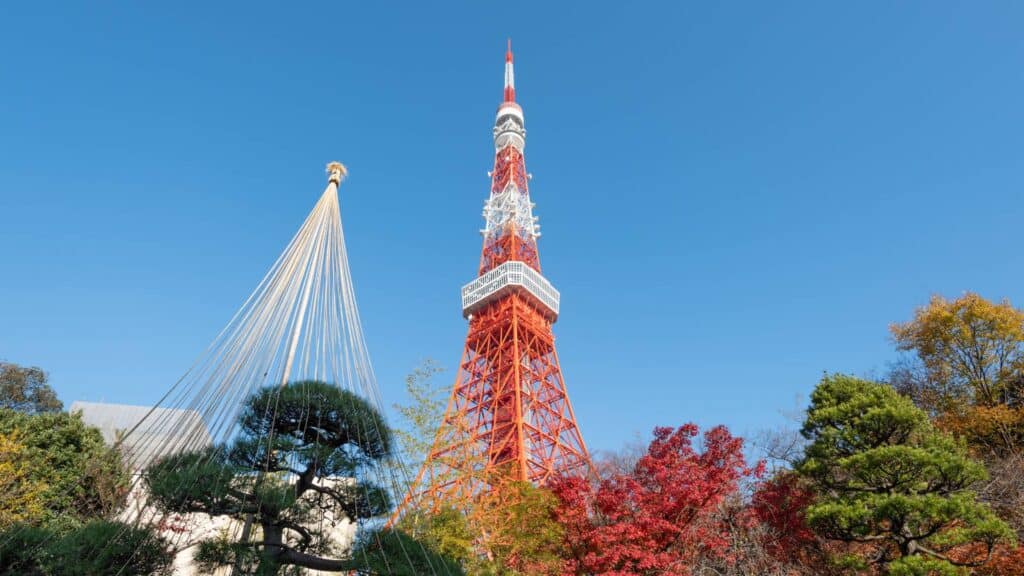
Perched in the heart of Tokyo, Tokyo Tower stands tall as Japan’s iconic symbol of post-war resurgence and economic strength. Rising to a height of 333 meters, it surpasses even the Eiffel Tower by 3 meters. Since its completion in 1958, Tokyo Tower has captivated visitors as a renowned tourist destination and an essential broadcast antenna.
Ascending to the tower’s main deck, accessible by elevator or a 600-step stairway (both require admission fees), visitors are treated to panoramic views of Tokyo’s skyline. Situated at 150 meters above ground, the main deck offers a unique perspective of the city, complemented by amenities such as a gift shop, a cafe, and “lookdown windows” providing thrilling views of the bustling city below.
Explore Tokyo Tower’s rich history and architectural grandeur, and experience the allure of this iconic landmark that continues to stand as a testament to Japan’s enduring spirit and resilience. Whether admiring the vistas or enjoying the tower’s amenities, a visit promises an unforgettable journey into Tokyo’s vibrant culture and heritage.
(11:00-13:00) Shibuya Crossing, Shopping

Shibuya is synonymous with the iconic Scramble Crossing, a bustling intersection renowned as one of the world’s busiest. With as many as 3,000 people crossing during a single green light, it’s a vibrant symbol of Tokyo’s energy and dynamism.
Adding to Shibuya’s allure is Shibuya Scramble Square, boasting a staggering 212 ‘world’s most fashionable’ shops. From established brands to innovative new ventures, this retail mecca offers a diverse array of shopping experiences. Don’t miss the chance to visit Shibuya Sky, perched at approximately 230 meters and spanning 47 stories above ground. As Shibuya’s highest point, it offers breathtaking panoramic views of the cityscape below.
Discover the beating heart of Tokyo in Shibuya, where culture, commerce, and creativity collide in a whirlwind of excitement. Whether you’re navigating the bustling streets or taking in the sweeping vistas from Shibuya Sky, there’s always something new and exciting to experience in this vibrant neighborhood.
(13:00-14:00) Yoyogi Park
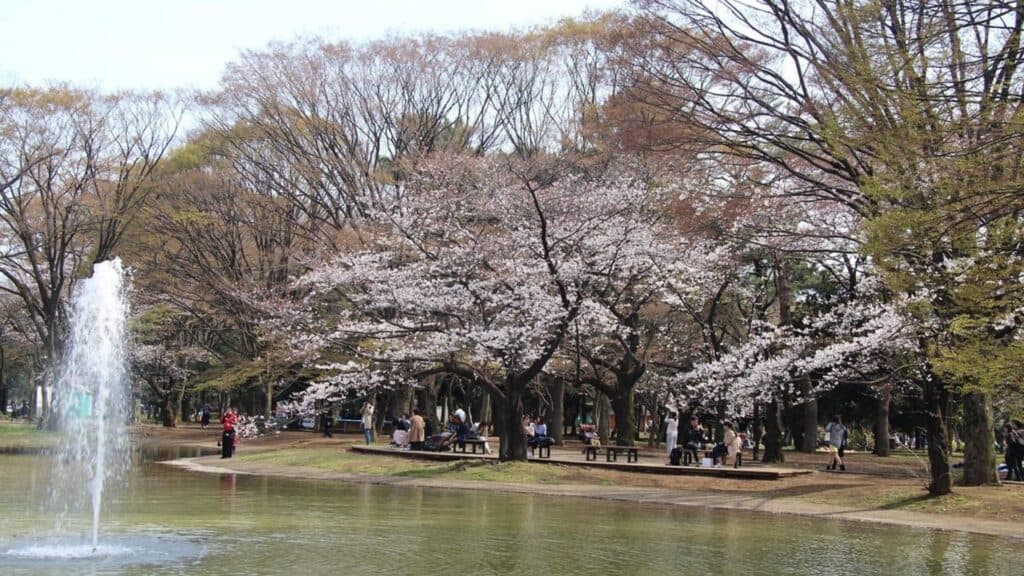
Yoyogi Park stands as a sprawling oasis amidst the hustle and bustle of Tokyo’s city center. Located just a stone’s throw away from Harajuku Station, Yoyogi-koen Station, and Meiji-jingumae Station, it’s easily accessible and offers a serene escape from urban life. As you step into the park, you’ll find yourself enveloped by nature, surrounded by lush greenery that creates a tranquil atmosphere reminiscent of a forest retreat.
Beyond its natural beauty, Yoyogi Park is a hub of activity, hosting a variety of events throughout the year, particularly on weekends. From vibrant food trucks offering delectable treats to captivating performances and cultural festivals, there’s always something exciting happening in the park. It’s no wonder that Yoyogi Park is a favorite destination for locals and tourists alike, drawing visitors who flock to enjoy picnics and leisurely strolls in its expansive grounds.
Experience the serenity and vibrancy of Yoyogi Park—a beloved urban oasis that offers a refreshing escape and a wealth of cultural experiences in the heart of Tokyo. Whether you’re seeking tranquility amidst nature or seeking out the lively atmosphere of its events, Yoyogi Park promises a memorable journey for all who visit.
(14:00-15:00) Meiji Jingu Shrine

Meiji Jingu, nestled in the heart of Shibuya, Tokyo, is a revered Shinto shrine dedicated to Emperor Meiji and Empress Shoken. Spanning an expansive 700,000 square meters, the shrine is surrounded by Chinju-no-Mori, an enchanting forest envisioned as an “eternal forest.” This majestic woodland was meticulously crafted with the planting of approximately 100,000 trees donated from across Japan during the shrine’s inception.
Each year, Meiji Jingu attracts the highest number of worshippers in Japan during the New Year’s period. Pilgrims flock to the shrine to pay their respects, offer prayers, and seek blessings for the year ahead. This annual tradition underscores the deep reverence and cultural significance that Meiji Jingu holds within Japanese society.
Witness he tranquility and spiritual resonance of Meiji Jingu, where ancient traditions and natural beauty converge to create a sacred sanctuary in the heart of Tokyo. Whether you’re exploring the serene forest paths or participating in a traditional Shinto ritual, a visit to Meiji Jingu offers a profound journey into Japan’s rich cultural heritage.
(15:00-17:00) Harajuku

Harajuku pulsates at the epicenter of kawaii culture and cutting-edge fashion in Tokyo. Embark on a whimsical journey down Takeshita Street, an iconic thoroughfare renowned for its array of trendy shops and delectable take-out eateries—particularly famous for its mouthwatering crepes. As you meander through this vibrant street, you’ll discover an increasing number of unique cafes, each offering its own distinctive charm. Venture into the side streets to stumble upon hidden gems, including whimsical animal cafes where you can interact with a variety of adorable creatures, from playful cats to endearing micropigs.
Continuing your exploration, delve deeper into the enchanting labyrinth of Harajuku to uncover the Omotesando area. Here, you’ll encounter a striking contrast of high-end fashion boutiques, upscale restaurants, and eclectic shops. During the winter season, the streets of Omotesando come alive with dazzling illuminations, casting a magical glow over the fashionable district.
Immerse yourself in the dynamic energy and eclectic charm of Harajuku, where every corner offers a delightful surprise and a glimpse into Tokyo’s vibrant cultural tapestry. Whether indulging in delectable treats on Takeshita Street or perusing the upscale boutiques of Omotesando, a visit to Harajuku promises an unforgettable experience that celebrates the city’s avant-garde spirit and creative flair.
Optional Day 2 Destination: Nakano
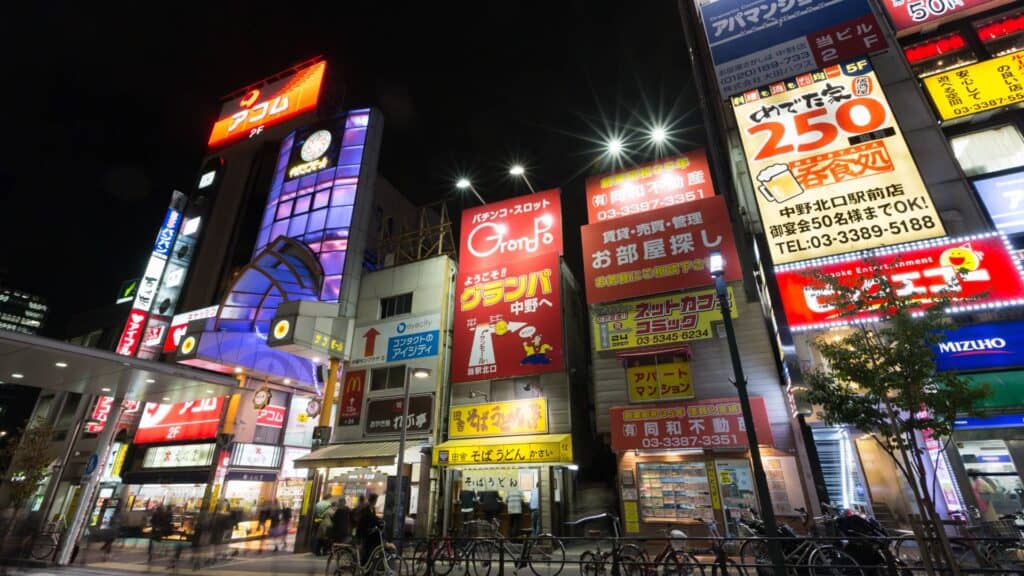
Just a few stops away from Shinjuku, Nakano is often dubbed “Western Tokyo’s Akihabara,” earning its reputation as an otaku nirvana. Yet, Nakano Ward offers a diverse and expansive landscape that appeals to a broad spectrum of interests, extending beyond manga aficionados.
Despite Tokyo’s relentless modernization, Nakano has retained much of its old-world charm. Venture northeast from the station, and you’ll stumble upon a nostalgic, partially pre-war street adorned with traditional izakaya, cozy bars, and other hidden gems. Further north, discover Edo-era temples and serene parks, offering a peaceful respite from the urban hustle.
Home to a diverse community of office workers, college students, and families, Nakano boasts a warm and welcoming atmosphere. Residents are known for their laid-back demeanor and are often eager to engage in friendly conversation, adding to the neighborhood’s inviting allure.
Explore the multifaceted tapestry of Nakano, where tradition seamlessly intertwines with modernity, offering a rich tapestry of experiences for visitors and locals alike. Whether you’re delving into manga culture or immersing yourself in the neighborhood’s historical treasures, Nakano promises an unforgettable journey filled with discovery and charm.
(17:30-20:00) Shinjuku’s Omoide Yokochu, Kabukicho, Golden Gai
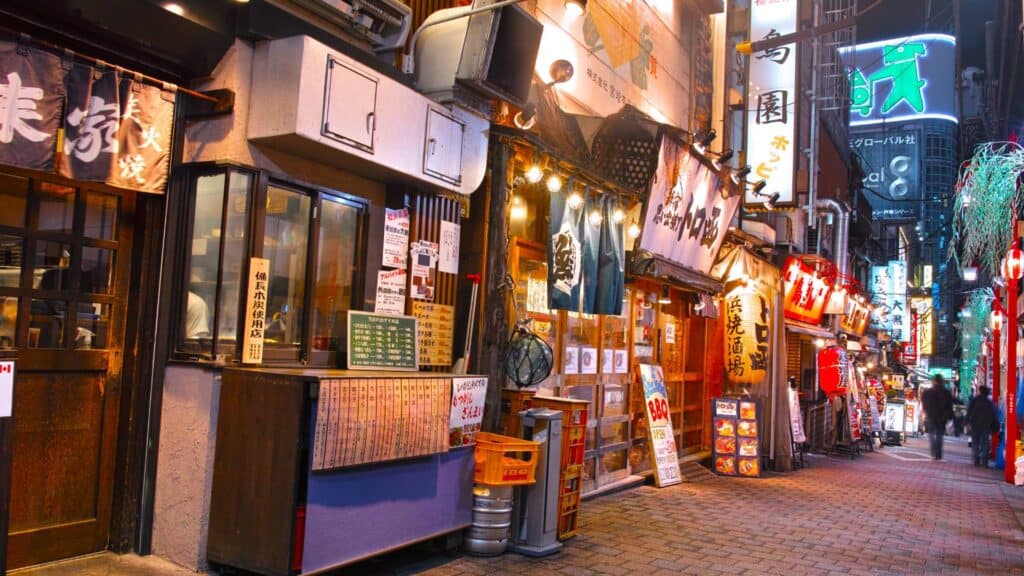
Shinjuku stands as a bustling epicenter of entertainment, offering a myriad of activities to suit every preference. From towering business buildings to eclectic restaurants, esteemed schools to vibrant entertainment venues, bustling shops to luxurious hotels, Shinjuku pulsates with endless possibilities.
Nestled just outside the Shinjuku West Exit lies “Omoide Yokocho,” also affectionately known as “Yakitori Yokocho” or “Shonben Yokocho.” This iconic shopping street traces its origins back to the post-war era of 1946 when it emerged as a bustling black market hub, boasting approximately 300 shops. Today, it has transformed into a beloved drinking district, teeming with quaint eateries serving up delectable dishes like yakitori, offal stew, and sashimi. With its convenient location just a 3-minute stroll from Shinjuku station, it’s the ideal spot for office workers to unwind after a long day or enjoy a pre or post-night out libation.
Venture into Shinjuku’s legendary Golden Gai (新宿ゴールデン街), nestled in Kabukicho 1-chome. This historic restaurant district is renowned for its charming barracks tenements housing nearly 300 bars, including cozy snack bars. Frequented by writers, artists, and luminaries from the film and theater industry, Golden Gai exudes an irresistible allure, inviting patrons to revel in its rich cultural ambiance while savoring a diverse array of culinary delights.
(7:00-8:30) Sumo Morning Practice with Former Sumo Wrestlers at Yokoami
Deeply rooted in tradition and history, the vibrant neighborhood of Yokoami in Sumida-ku, Tokyo, holds significant ties to Japan’s national sport, sumo wrestling.
Home to the iconic Ryogoku Kokugikan, the grand arena where thrilling sumo tournaments unfold, and numerous sumo stables scattered throughout the area, Yokoami boasts a rich legacy intertwined with the revered sport of sumo. Even today, the neighborhood continues to attract hordes of sumo enthusiasts, drawn by the allure of witnessing the ancient tradition in action.
Moreover, Yokoami pays homage to its culinary heritage with a monument commemorating the birthplace of Yohei Sushi. Renowned for revolutionizing sushi by introducing nigiri-zushi paired with wasabi, Yohei Sushi’s innovation has left an indelible mark on the global culinary landscape, ensuring sushi’s widespread popularity beyond Japan’s borders. With sumo wrestling, otekebori (traditional wood carving), sushi, and other quintessential elements of Japanese culture converging in Ryogoku, visitors are treated to an immersive experience steeped in tradition and heritage.
(9:00-11:00) Ueno
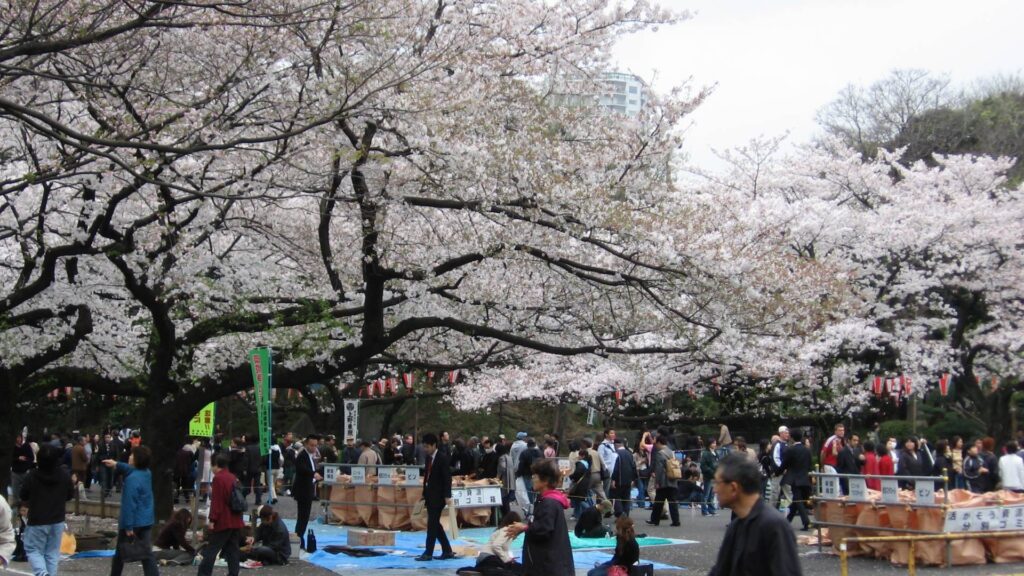
Ueno is a cultural haven, offering a plethora of artistic and recreational delights to visitors. Adjacent to the station lies Ueno Park, a sprawling oasis boasting art galleries, museums, the tranquil Shinobazuno Pond, a historic temple with a striking five-storey pagoda, and the beloved Ueno Zoo. Renowned for its scenic beauty, Ueno Onshi Koen is a favored destination for cherry blossom viewing during the spring season.
Bordering the railway line is the bustling Ueno Ameyoko shopping street, a vibrant marketplace teeming with lively stalls offering an eclectic array of street foods, fresh produce, trendy clothing, and more. Don’t miss the opportunity to indulge in a culinary adventure at one of the street’s many enticing restaurants, ensuring a satisfying gastronomic experience amidst your cultural exploration.
(11:30-13:30) Akihabara

The central Tokyo neighborhood of Akihabara, affectionately known as Akiba, owes its fame to its plethora of electronics stores and its status as the epicenter of otaku (die-hard fan) culture in Japan. Renowned for its vibrant atmosphere and diverse offerings, Akihabara boasts a plethora of electronic retailers alongside specialized shops catering to anime and manga enthusiasts.
In recent years, Akihabara has evolved into a mecca for Japanese otaku and anime aficionados, with numerous establishments dedicated to collectibles such as figurines, card games, anime, manga, and vintage video games dotting the landscape alongside electronics outlets. The district is also home to a variety of businesses associated with animation, including maid cafes (manga kissa), where waitresses cosplay as maids or anime characters, and internet cafes offering patrons the chance to read comics, watch videos, and surf the web.
(14:00-15:00) Tokyo Station

Tokyo Station, situated in Marunouchi, Chiyoda-ku, Tokyo, stands as the primary gateway to the bustling metropolis of Tokyo and ranks among the busiest railway hubs globally. Its significance transcends borders, making it not only a vital transportation hub within Japan but also a renowned landmark worldwide.
Following the conclusion of the Sino-Japanese and Russo-Japanese wars, Tokyo Station underwent extensive construction, culminating in its completion in 1914. The iconic red-brick Marunouchi Exit Station Building, prominently positioned facing the Imperial Palace, was bestowed the distinction of being a National Important Cultural Property in 2003. It also holds a place of honor among the top 100 stations in the Kanto region.
The precincts surrounding Tokyo Station are a bustling tapestry of shops, eateries, shopping arcades, and galleries. This vibrant area offers visitors a captivating glimpse into the multifaceted essence of Tokyo, providing insights into the dynamic daily lives of its residents. Exploring this vibrant district offers a quintessential Tokyo experience, where modernity harmonizes with tradition at every turn.
(15:00-17:00) Imperial Palace
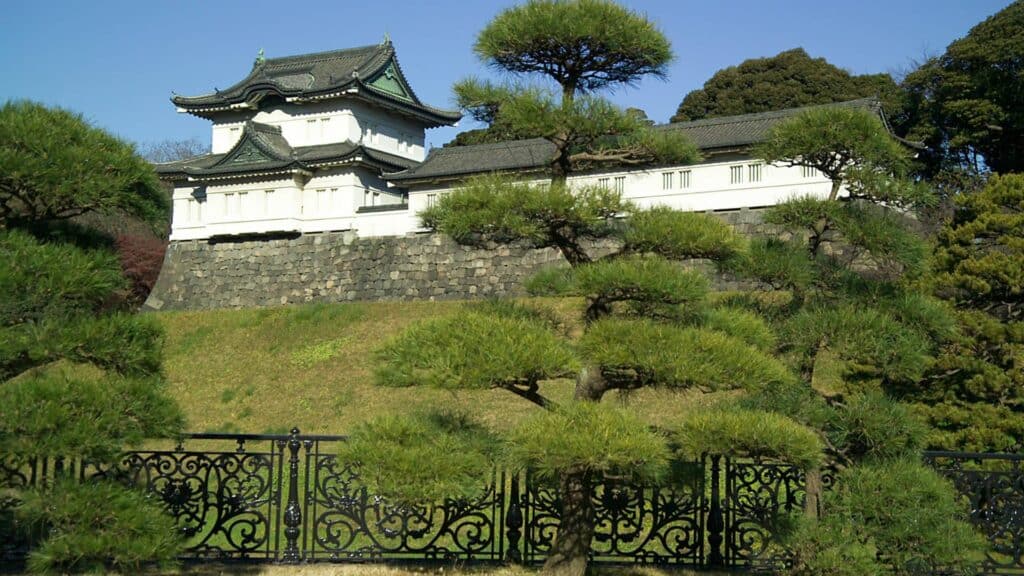
The Imperial Palace stands as the primary residence of the Emperor and a quintessential symbol of Japan’s rich history and culture. Drawing visitors from across the globe, the Palace boasts over four centuries of architectural heritage, meticulously manicured gardens, and an array of natural wonders. What’s more, admission to this iconic landmark is entirely free, inviting exploration by all.
Comprising three distinct sections, the Imperial Palace area offers a wealth of experiences. Visitors can freely explore the East Gardens and Outer Gardens of the Imperial Palace, soaking in the serene ambiance and scenic beauty. For access to the Imperial Palace grounds, advanced reservations are required, providing an exclusive glimpse into Japan’s imperial legacy.
Spanning approximately 2.3 million square meters, the Imperial Palace area serves as a verdant urban sanctuary amidst Tokyo’s bustling cityscape. Just a brief 15-minute stroll from Tokyo Station, visitors are greeted by expansive green spaces juxtaposed against towering skyscrapers. Within the tranquil Imperial Palace Garden, adorned with majestic black pine forests, numerous benches offer tranquil spots to pause and savor a leisurely walk.
Optional Day 3 Destination: Ginza

Ginza, nestled in the heart of Chūō, Tokyo, stands as a beacon of luxury and sophistication. Renowned as a premier shopping destination, this district is adorned with a plethora of internationally acclaimed department stores, designer boutiques, chic eateries, and quaint coffee shops. It epitomizes extravagance, elegance, and refinement, making it a sought-after destination for discerning shoppers and trendsetters worldwide.
Stroll through the streets of Ginza, and you’ll be greeted by upscale clothing outlets at every turn. Moreover, the district boasts a constellation of Michelin-starred restaurants, representing the pinnacle of fine dining in Tokyo. Yet, the true allure of Ginza lies beyond its grand façades, tucked away in cozy alleyways illuminated by soft lights. Here, you’ll discover hidden gems ranging from charming gift shops to traditional izakaya, offering a delightful blend of old-world charm and modern allure.
Experience the epitome of luxury and sophistication in Ginza, where every corner offers a glimpse into Tokyo’s vibrant and opulent lifestyle.
Final Thoughts
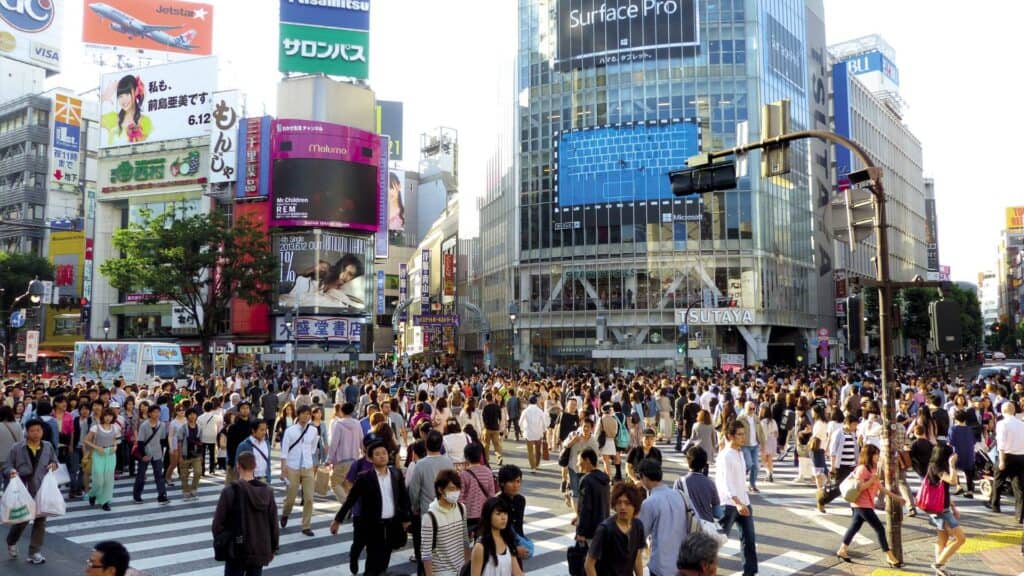
Crafting a comprehensive itinerary for a 3-day visit to Tokyo can be challenging, given the city’s vast array of attractions. However, with careful planning, you can create a well-rounded plan that captures the essence of this vibrant metropolis. As one of the globe’s premier tourist destinations, Tokyo offers a plethora of captivating experiences waiting to be explored. Let this meticulously curated 3-day Tokyo itinerary serve as your roadmap, guiding you to the most thrilling and captivating destinations throughout your journey. Whether you’re a culture enthusiast, a foodie, or an adventure seeker, Tokyo has something to offer everyone.
Submit a Comment Cancel reply
Your email address will not be published. Required fields are marked *
Save my name, email, and website in this browser for the next time I comment.
Recent Posts
- The Best Japan Internet Access Options: Budget SIM Card Versus Pocket WiFi
- 29 Best Summer Destinations in Japan
- Top Places to Visit in Japan in June: Revealing 15 Must-See Destinations
- One Night in Tokyo: Insider Tips for an Epic Mini Adventure
- 17 Spine-Chilling Haunted Places in Japan to Discover
Recent Comments
- Tere Bellido on Autumn in Japan: 60+ Spots to Enjoy Autumn Leaves (Koyo) from September to December
- Vijay Singh on Ultimate guide to Zamami Island in Okinawa: What to do and hidden gems
- Lori on Overnight & Weekend Trip Ideas from Tokyo
- Robie on How much does it cost to live in Japan? You might be surprised
- Sidney Johnson on How much does it cost to live in Japan? You might be surprised
The Ultimate Tokyo 3 Day Itinerary
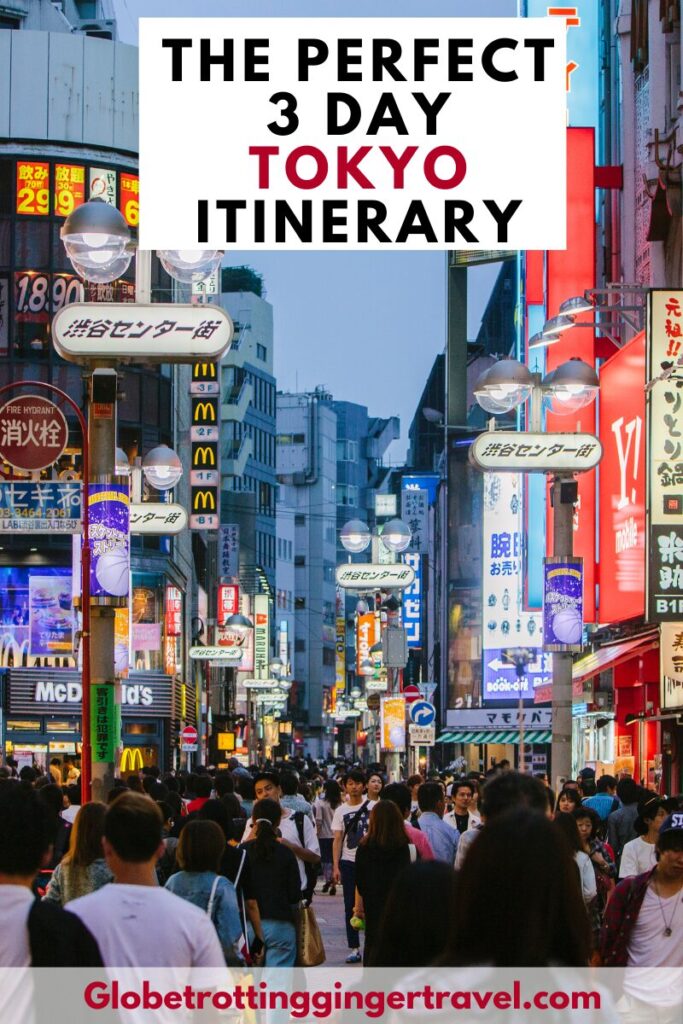
Tokyo is a thriving metropolis full of juxtapositions in the culture and history. Everywhere you go, new and old can be felt- historic temples and palaces next to high rises and technology. You will quickly fall in love with this city, the people and the food. There are so many things to do in Tokyo and this guide will lay out some of the best things to do in Tokyo in a 3 day itinerary.
(Updated April 2024)
Table of Contents
Is 3 days enough to see Tokyo?
You can see a good amount of Tokyo and many different neighborhoods and activities in 3 days. If you are more flexible or have more time, 4 or 5 days would be great to see even more of the incredible sights.
What is the best month to visit Tokyo?
Tokyo is very famous in the Spring for their Sakura season or cherry blossoms, but it’s very busy during this time with lots of people and the prices for hotels go up.
Another incredible time to visit Tokyo is in the Fall. The Fall colors look so beautiful at the temples and the shrines.
What is the cheapest month to travel to Japan?
Japan’s slow season is in the winter time and so the cheapest month to travel to Japan coincides with that and is February. Other cheap months are November, January and March.
Day 1: Tokyo 3 Day Itinerary
Morning-shibuya crossing.
Start your morning at Shibuya Crossing- the busiest pedestrian crossing street in the world. At peak times, thousands of pedestrians go across this crosswalk. This place is perfect for people watching and some fun photography.
Bring fun props like a red umbrella if you really want to stand out in your photos. If you want a view of the street from above, head to the nearby Starbucks.
Afterwards, take a stroll around the Shibuya area, exploring the trendy shops and cafes that line the streets. Visit the iconic Shibuya 109 department store, and grab a coffee at one of the many coffee shops in the area.
As you wander, keep an eye out for the unique street art and fashion that defines Shibuya’s youth culture. The morning in Shibuya is an unforgettable experience that will set the tone for an exciting day in Tokyo.

Lunch- Conveyor Belt Sushi Bar
Going to a Sushi Conveyor Belt Bar was one of the most fun things to do in Tokyo! You basically sit at your booth as a conveyor belt with countless sushi options goes past you.
You can either pick up the sushi you want from the conveyor belt or you can order a specific kind of sushi or another food/drink from your electronic screen at your booth.
As your order comes close to your table, it starts to ring so you know that it is yours. This is definitely an experience every visitor to Tokyo has to have!
Afternoon- Animal Cafes
Tokyo is famous for all of its themed cafes and you could seriously just spend your entire trip going to different cafes. There are tons of different animal cafes to choose from including cats, owls, rabbits and even raccoons so you definitely need to add one to your Tokyo 3 day itinerary.
I tried out Harry’s Hedgehog Cafe and an owl cafe. When you go to the animal cafes, you pay per hour and you get to interact with the animals and usually this includes one drink as well. At the Owl Cafe, there was even a little tiny owl that sat on my shoulder the whole time!
I fell in love and wanted to take him home. Harry’s Hedgehog Cafe was very popular and there was even a line out the door.
Definitely a must do for any Tokyo 3 day Itinerary.
Evening- Harajuku Street
Harajuku is one of my favorite areas in Tokyo! It’s such a fun, vibrant and busy area full of cool styles, cute shops and tons of cute food. Don’t forget to try a cotton candy bigger than your head at Totti Candy Factory.
Another really cute place is Santa Monica Crepes selling the prettiest looking crepes you’ve ever seen. Try to come on a Sunday if you can so you can witness the Harajuku Parade.
Dinner-Themed Cafes
There are tons of themed cafes in Tokyo which are really fun to visit. I tried the Monster Café and it was so cool and wacky.
There are many different themed rooms you can sit in and then kawaii (cute) characters walking around dressed as “monsters.” There are also little shows that happen through out your dining experience and all of the food is themed.
We got french fries that literally came with rainbow colored sauces- so fun! Some of the other popular themed cafes in Tokyo are the Maid Café, 5 different Alice in Wonderland Cafes, Vampire Café, Samurai Café, Prison Café and of course the Hello Kitty Cafe.
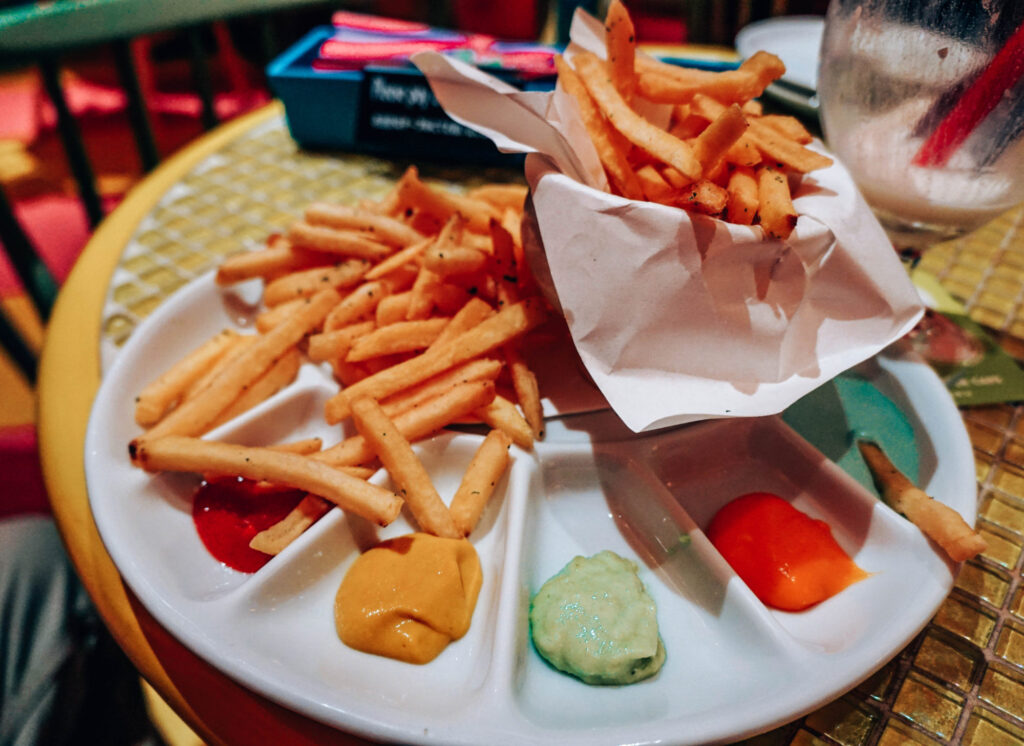
Day 2 in Tokyo
Morning- robot show.
The Robot Show is truly indescribable and one of the wackiest things to do in Tokyo. However, it can’t be missed. This is Tokyo in a nutshell- fun, zany, weird, out there- all of it.
The Robot Restaurant puts on an eclectic cabaret show with performances full of flashing lights, taiko drums and techno music.
It’s a fun and campy neon-lit show where dancers, dinosaurs, ninjas all collide. The whole time you are watching the show- you’ll be thinking “What the heck is going on?” but it truly was one of my most memorable experiences in Tokyo!
Book a spot at the Robot Show here.
Afternoon-Tokyo Tower
The Tokyo Tower stands 333 meters high in the center of Tokyo and is the world’s tallest, self-supported steel tower. It is even 13 meters taller than the Eiffel Tower- which it was actually modeled after.
It is a very popular tourist spot, but it is also a broadcast antenna. The Tokyo Tower is definitely worth visiting to get incredible views of Tokyo’s skyline. I also loved finding places with incredible viewpoints of the Tower itself because it is quite a lovely feat of architecture.
I booked my tickets for the Tokyo Tower here.
or you can combine Tokyo Tower, Sensoji Temple and the Imperial palace,
with this ticket here.
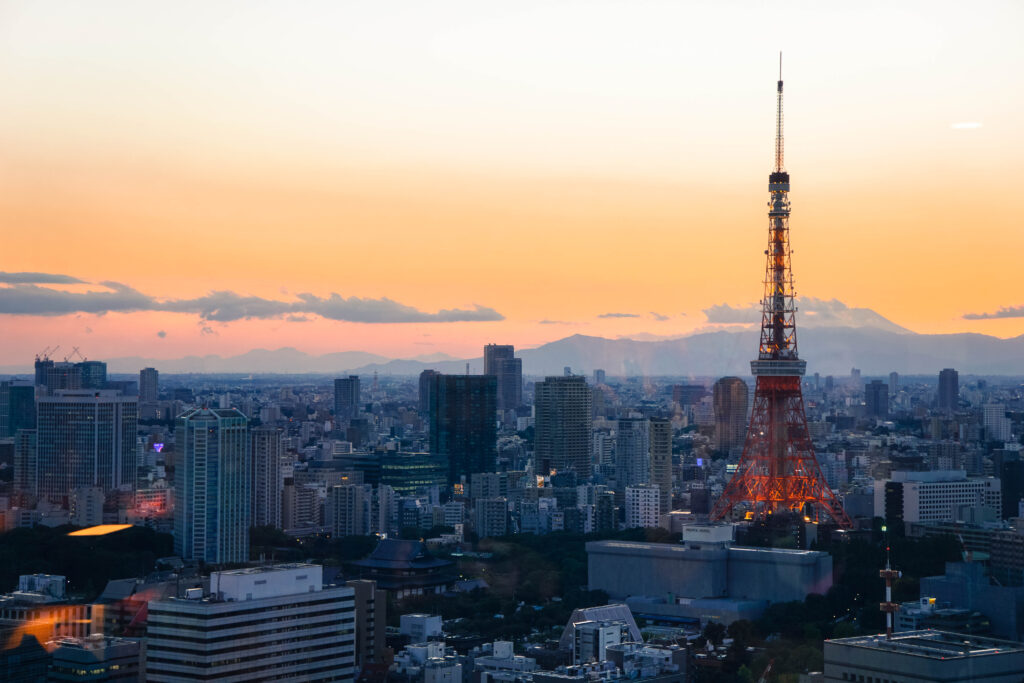
Meiji Shrine and Grounds
Meiji Shrine. located in Shibuya, Tokyo near Harajuku Station is a famous Shinto shrine. The shrine is dedicated to the deified spirits of Emperor Meiji and his wife, Empress Shōken. Yoyogi Park is adjacent to the shrine and is a large forested area within the busy city.
The grounds offer many walking paths that are beautiful and very peaceful. Harajuku Street is a 10-15 minute walk away so these activities can be easily paired together for a wonderful afternoon in Tokyo.
The tour I took went to Meiji Shrine, Asakusa Temple and Tokyo Tower!
Click here to book the tour I took to Meiji Shrine!
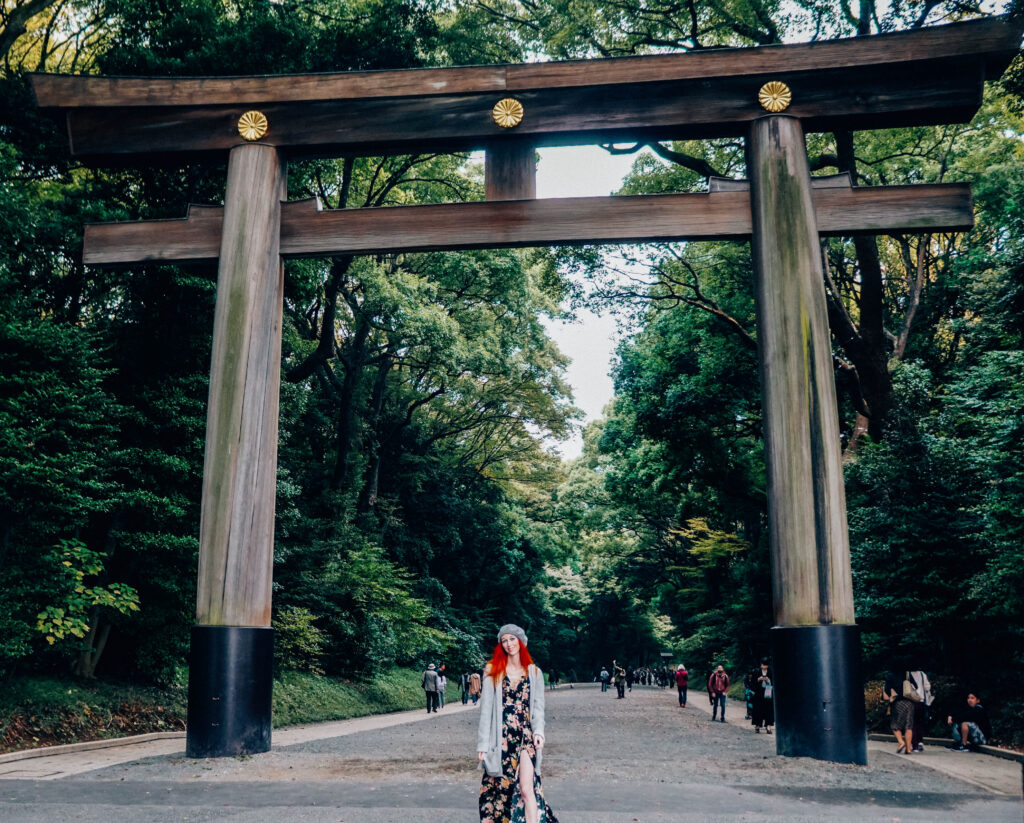
Go Kart Tour of Tokyo
Looking for something really fun and adventurous to do in Tokyo? Check out this Go Kart Tour! You get to explore Akihabara in the most unique and fun way! And you even get to ride in a go kart dressed as a character of your choice! You also don’t need to worry about getting lost because you have a guide that will lead the way. You will visit around Tokyo Station, Ginza and Akihabara.
Stay the night at a Themed Hotel
Tokyo loves a good themed cafe, but it doesn’t stop just there. They also have many themed hotels throughout the city. There is a hotel that is Hello Kitty themed, Godzilla themed, Spaceship themed and more.
I stayed in a themed hotel where part of the hotel has artist themed rooms and every room was painted in a different style and I absolutely loved it! The views over Tokyo here are also absolutely incredible.
Click here to book a stay at The Artist themed hotel
Read about my stay here.
Tokyo 3 Day Travel Itinerary
Evening- imperial palace.
The Tokyo Imperial Palace is the primary residence of the Emperor of Japan and is surrounded by parks and gardens offering a getaway from the busy city streets. Surrounding the home of the Emperor, the grounds are immaculate and visiting them is one of the top things to do in Tokyo for many visitors on a 3 day Japan itinerary. I took this walking tour all over the grounds that was very good.
Covering 1.3 square miles, the grounds include cherry blossom viewing spots (in the Spring), art galleries, historical ruins and beautiful gardens—plus a private section reserved for royalty, of course.
Once the site of Edo Castle, the land is now among the most highly valued in Japan, and is a short walk from Tokyo Station. If you’re planning to visit, there are organized tours of inner areas available for free, as well as special days when you can see the Emperor himself! I absolutely loved visiting in the Fall and the grounds were beaming with Fall colors everywhere.
Click here to book a tour of The Imperial Palace
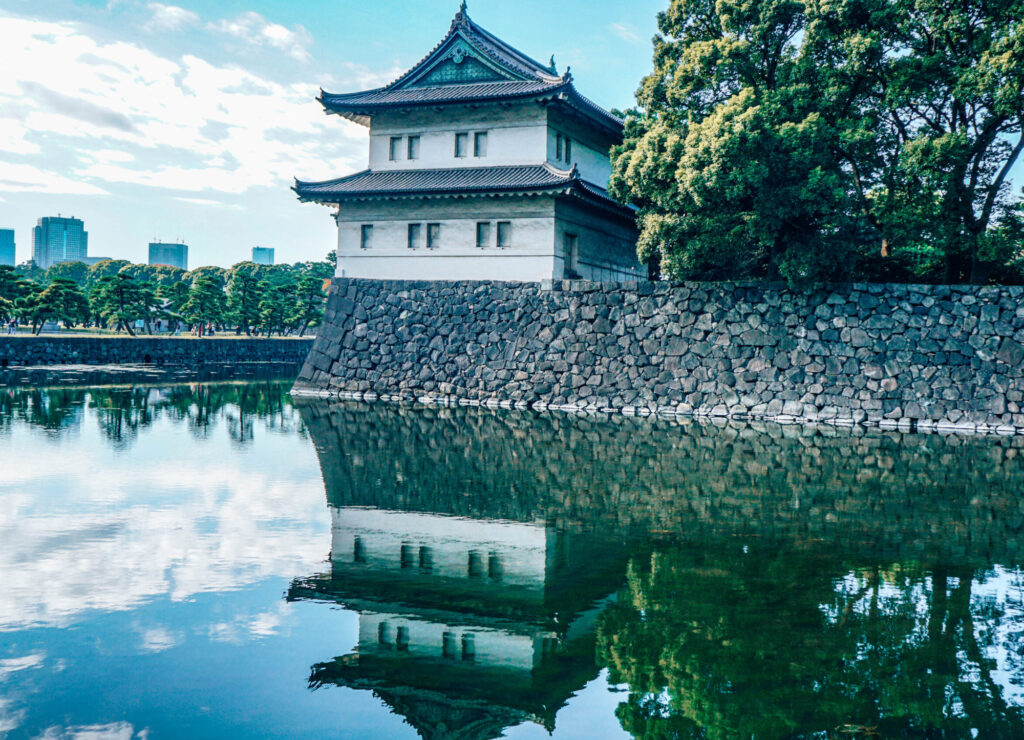
Morning- Nezu Museum and Gardens
The Nezu Museum is a private collection of Japanese and Asian art. There are many interesting exhibits including paintings, ceramic, textiles, calligraphy and tea sets.
Nezu Kaichiro was an avid art collector and the site where the museum and gardens are used to be his home. After his death in 1940, his son founded the museum to preserve his collection.
One of my favorite parts of the museum were the gardens. They were absolutely beautiful and especially beautiful in the Spring and the Fall.
Visiting Nezu Gardens in the Fall, is one of the best additions to any Tokyo 3 day itinerary. There are so many beautiful Fall leaves. It is also not as well known as some of the other top places to see Fall leaves so you could even have the gardens all to yourself.
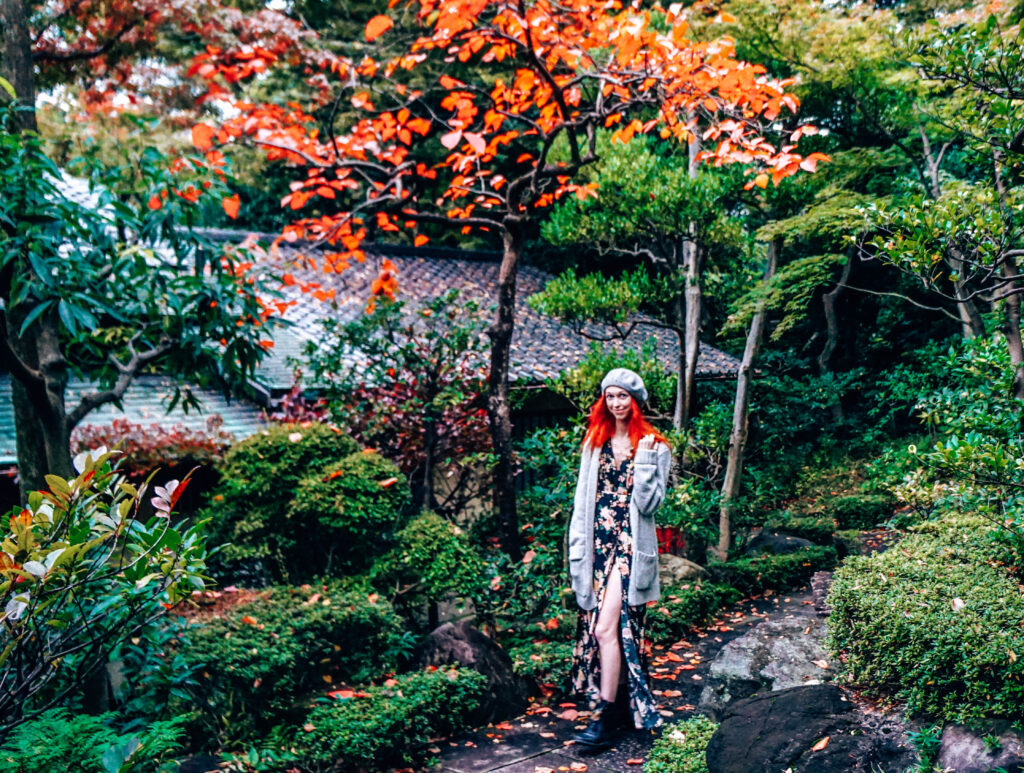
Explore the Asakusa area and Sensō-ji temple
Sensō-ji is an ancient Buddhist temple located in Asakusa, Tokyo, Japan. It is Tokyo’s oldest temple, and one of its most significant. The grounds are absolutely beautiful and visiting is definitely one of the top things to do in Tokyo.
There is a huge food market outside of Senso-ji so it can be really fun walking around and trying new foods.
There are even fruit stands where you can drink juice right out of the fruit. Admission to this temple is free which is an added bonus. It gets very busy so plan to wake up really early to visit before the crowds start showing up.
I loved the tour I took because it went to Meiji Shrine, Asakusa Temple and Tokyo Tower!
Click here to book the tour I did here!
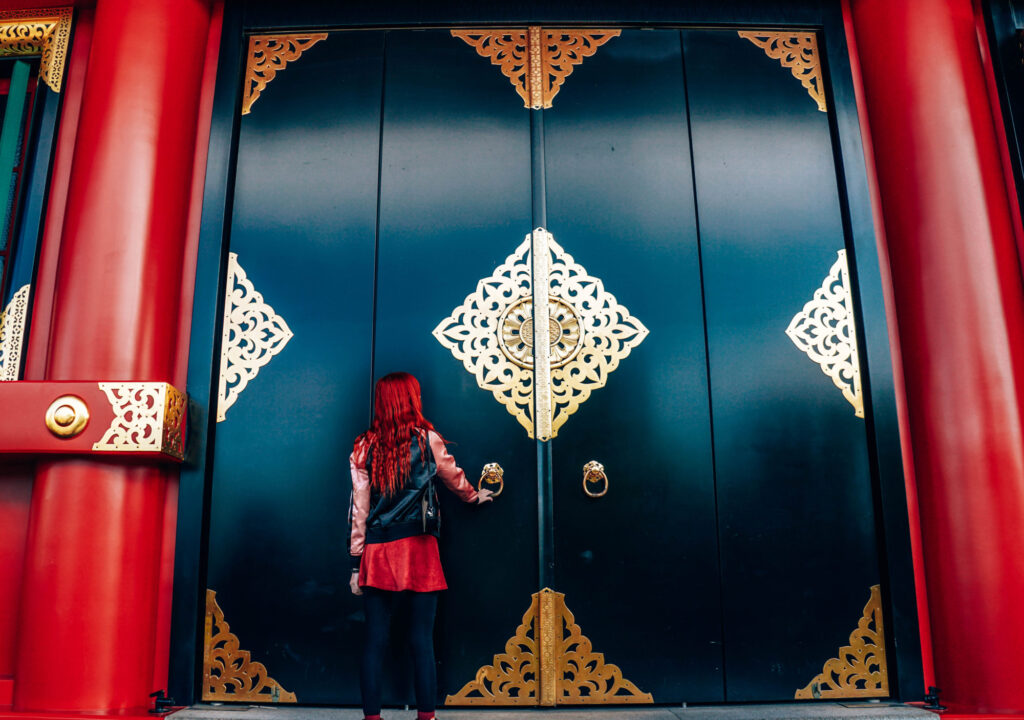
Wander through the Golden Gai district
Golden Gai in Shinjuku is an area comprised of a network of six narrow alleys, connected by even narrower passageways. It is well known for its bars and small food establishments.
Golden Gai retains a lot of its charm and feels like you stepped back into time. Coming here is definitely an adventure and you never know what you will find. It is a great place to try traditional Japanese food and as it is not necessarily a tourist destination, but also for locals, the prices will be a lot lower than other nearby places.
My husband and I found a small noodle restaurant that we decided to try and it was really delicious! Try to be respectful of Japanese customs. These restaurants are tiny- think like 6 spots to eat.
When you are finished eating your food, it is custom to stand up and open up the seat so that someone else can start eating.
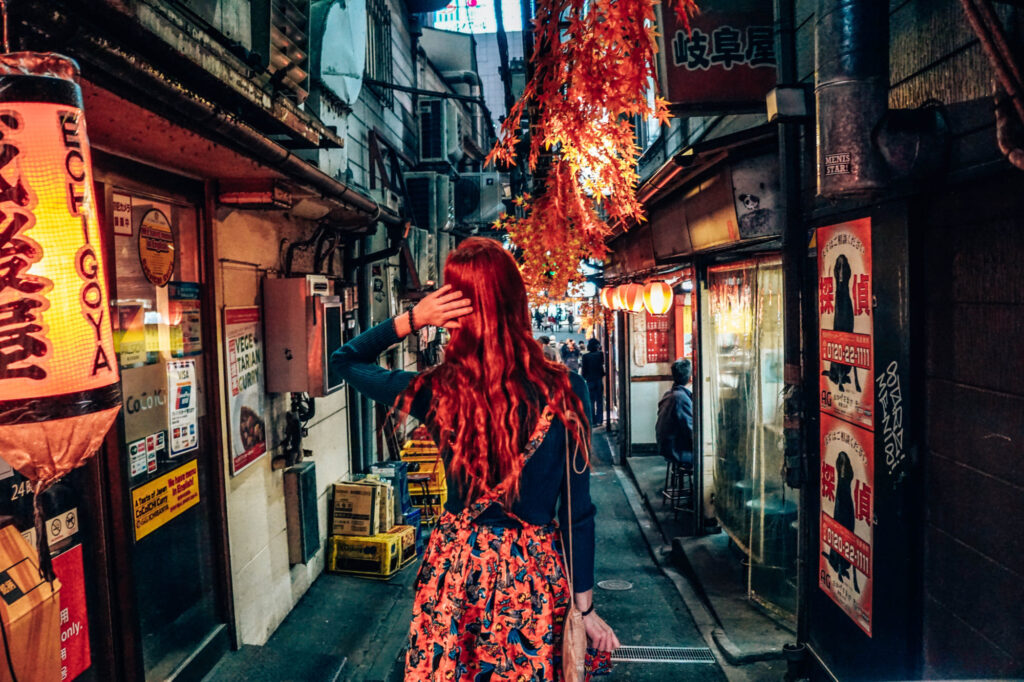
Stay in a Ryokan
Traveling is incredible because you get to experience different cultures from all over the world. If experiencing Japanese culture is important to you, then staying in a Ryokan is one of the top things to do while in Tokyo.
A ryokan is a type of traditional Japanese inn/hotel that features traditional style Japanese rooms. Ryokans are an opportunity to truly experience traditional Japanese lifestyle and culture. The rooms often have tatami floors, futon beds and you get to try local cuisine while sitting on the ground on mats with a low table.
There are many different types ranging from budget friendly to luxurious. Many Ryokans also have onsens or hot baths/springs that you can try out. One of my favorite parts was wearing the traditional dress around the hotel. This was definitely an experience to remember and should be a strong consideration for your Tokyo 3 day itinerary.
Click here to book a stay at a top rated Ryokan in Tokyo
Bonus- Try the Vending Machines
Trying the vending machines is one of the top things to do in Tokyo. They have fun and vibrant vending machines lining every street corner. There are so many fun options- why not be adventurous and try something new.
The blue colored items are cold and the red colored items are hot. It’s amazing that they have coffees and different hot drinks in there. Some of the Japanese sodas I tried were really unique and delicious.
More Top Activities in Tokyo
If you have more than 3 days in Tokyo or some of the above activities don’t catch your eye, here are some more top things to do in Tokyo!
- Team Lab Planets
- Sumo Experience
- Shibuya Sky
- Tokyo Disney and Disney Sea
- Japanese traditional Tea ceremony
- Dawn Cafe Tokyo- Avatar Robot Cafe DAWN is a permanent experimental cafe operated by OryLab Inc, where people who have difficulty going out for various reasons remotely operate the avatar robots OriHime and OriHime-D from their homes and hospitals, to provide services.
- Harry Potter Studio Tour , Harry Potter Store and Plaza- Visit the largest indoor Harry Potter attraction in the world and the first Warner Bros. Studio Tour in Asia!
- Hatcoffee – cute puffy cat coffees
- Shinjuku – 3D Bilboards like the Famous 3D Cat and Kabukicho Gate
Explore the Ghibli Museum, a wonderland of animation and art! Learn about anime history and admire the creations of Studio Ghibli.
- Pokemon Cafe/Pokemon World
- Gotokuji Temple – Lucky Cat Temple walking tour. This is such an unique place
- Tsujuki Fish Market – Stroll through and delight in the tastes, smells, and sights of one of the world’s most famous fish markets. Discover new flavors and learn about the people who work here.
- Hakone Shrine
- Cinnamon Roll Cafe (Sanrio Character)
- Pepper Parlor Robot Cafe
- Art Aquarium Museum Tokyo
- Unko Museum Tokyo
- Shirohige’s Cream Puff Factory
- Sanrio Puroland – Visit Sanrio Puroland for a magical adventure with Hello Kitty and friends. Enjoy fantastic shows, rides, and unique gifts
Day Trips from Tokyo
- Day Trip To Mount Fuji
- Ibaraki, Hitachi Park and Oarai Isosaki Shrine Day Trip – Savor freshly caught seafood at Nakaminato Market, explore the vibrant floral wonderland at Hitachi Seaside Park, and immerse yourself in the beauty of Oarai Isosaki Shrine
So there you have it! The Best Things to do and add into your Tokyo 3 day itinerary!
Planning a trip to tokyo just got back let me know in the comments.
Read Next: Where to Stay in Tokyo | Park Hotel Tokyo
Like what you see? Pin it for later or share it using the buttons on the left!
Related Posts
Moab with kids- 22 fun things to do.
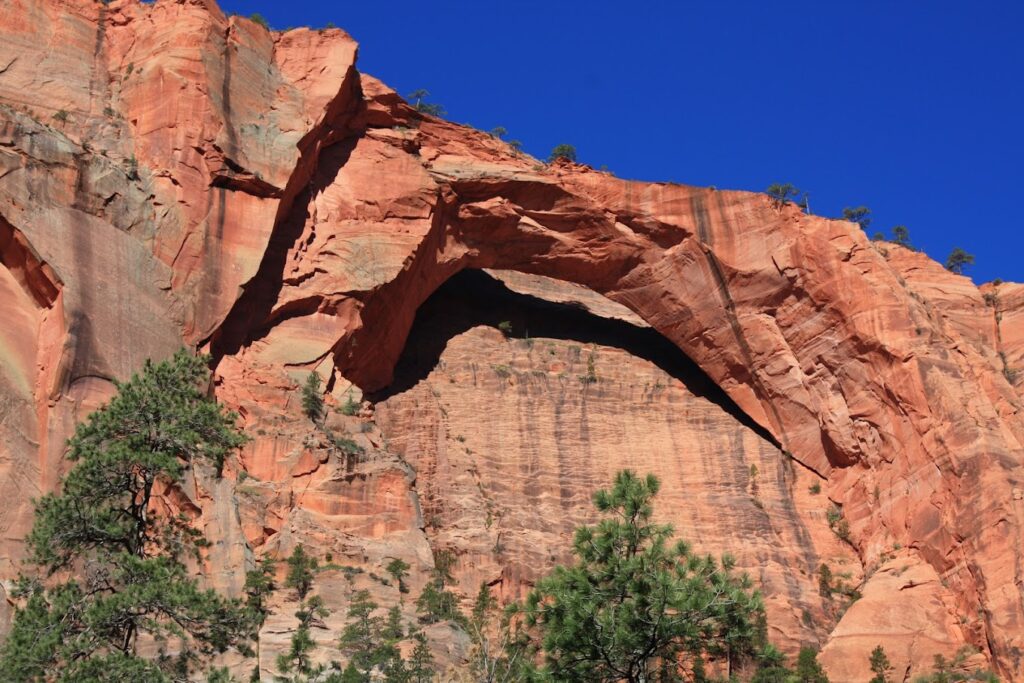
Kolob Canyon Scenic Drive: 5 Miles of Stunning Scenery
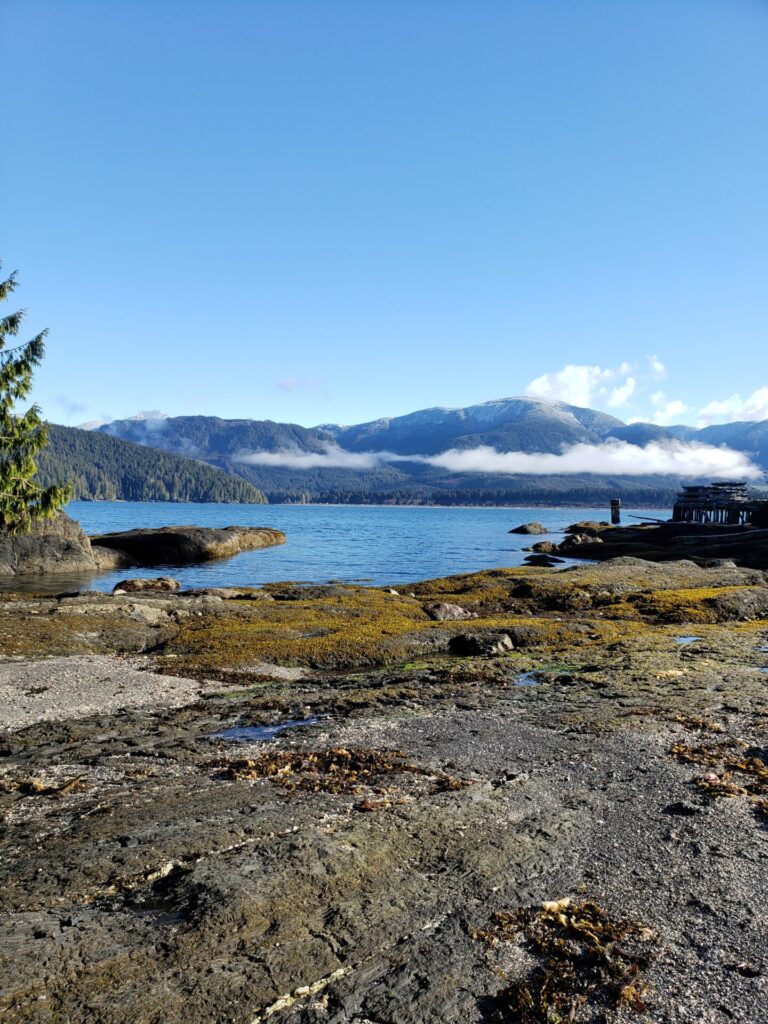
Exploring Port Renfrew: #1 Hidden Gem of Vancouver Island
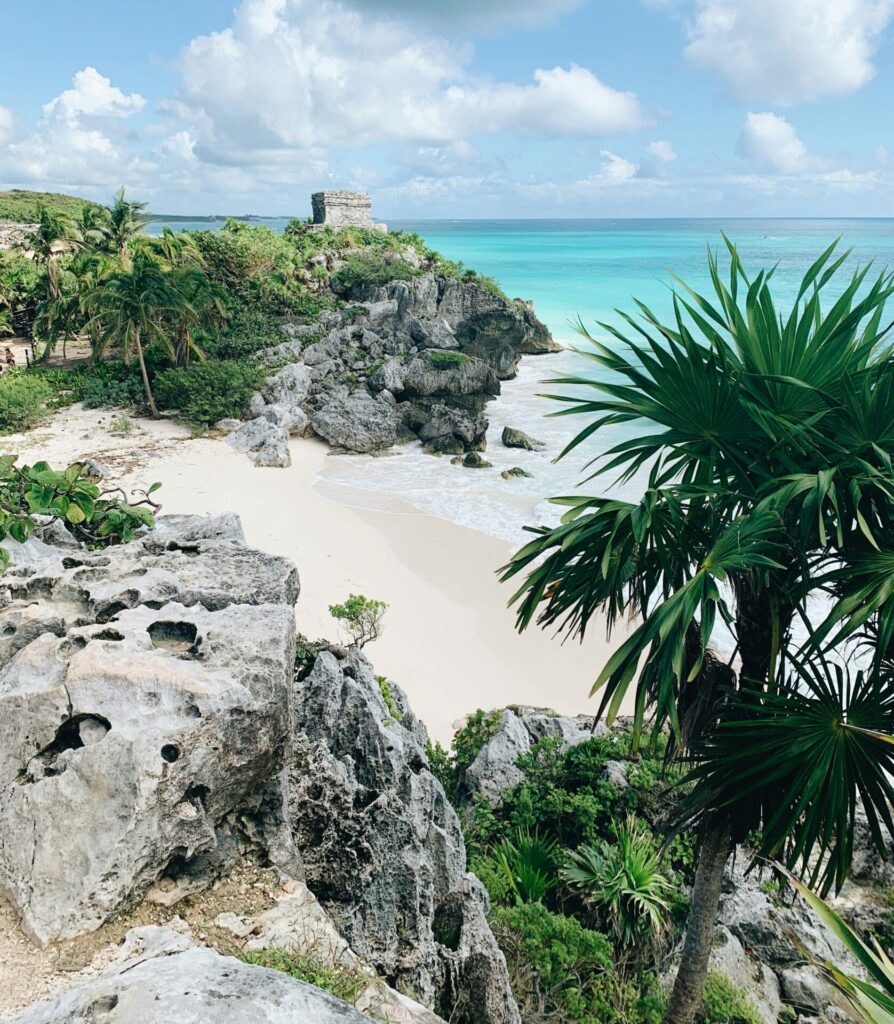
13 Best Things to do in Cancun for Couples
Sign me up for the newsletter!
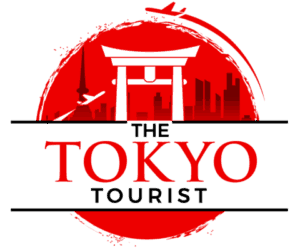
Before you go, check this out!
Read all about how I saved a whopping $600 during a two-week stay in Japan!
What To Do in Tokyo in 3 Days? (Itinerary included!)
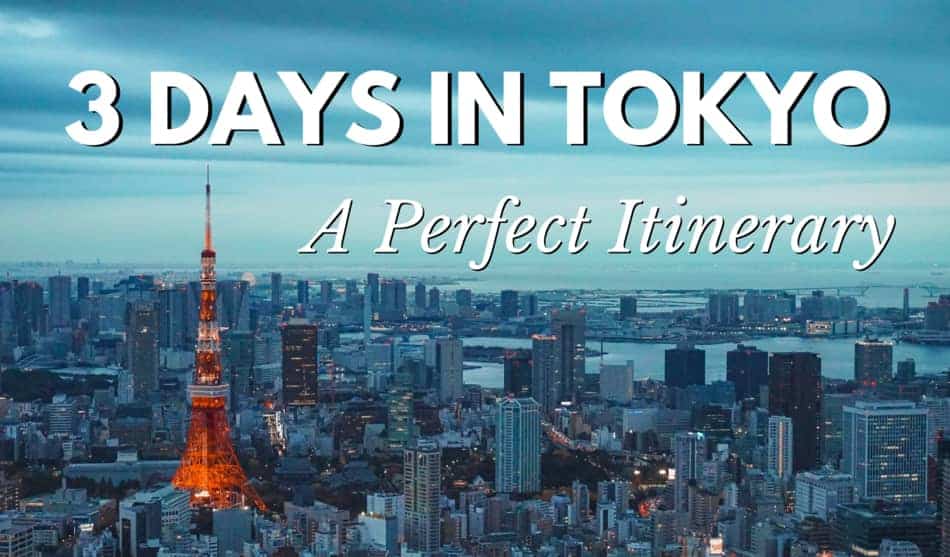
Got only three days to spend in Tokyo? It’s easy to stress out because that’s just 72 hours and it can go quite fast. With the right itinerary, though, you can plan every day to the minute so you can fit in all the activities and landmarks you want to see.
So what can you do in Tokyo in three days? Try following this itinerary to make the most of your trip: Day One: Shibuya Crossing, Harajuku, Meiji-jingu Shrine, Nezu Museum, Yoyogi Park, Omotesando, Roppongi Hills Complex Day Two: Asakusa-jinja Shrine, Senso-ji Temple, Asakusa, Ueno-koen Park, Mitsubishi Ichigokan Museum, Akihabara Day Three: Shinjuku, Imperial Palace Area, Yasukuni-jinja Shrine, Kitanomaru-koen Park, Tokyo Metropolitan Government Offices
Do you want hour-by-hour breakdowns of the above itinerary so you don’t miss a thing? Read on, as I’ll give you a schedule you can follow for each of your three exciting days in Tokyo.
Let’s get started!
Assuming you’re flying into Tokyo on your first day, you’ll have arrived at either the Haneda Airport International or Narita International Airport. Haneda has a single terminal at the JR EAST Travel Service Center, which is accessible by the Tokyo Monorail 2F.
There are two airport terminals through Narita, 1 and 2-3. Both terminals should pop you out around the JR EAST Travel Service Center and the Exchange Office.
From there, you’d want to get your JR Pass . You can then get on the Narita Express, which you’ll want to take to Shibuya. Don’t know what Japan Rail Pass is? Read all about it here .
8:30 a.m. Harajuku to Meiji-jingu Shrine at Yoyogi-koen Park and Nezu Museum
If you did all your traveling the day before, then you’d start your day already in Tokyo. In that case, let’s begin your morning a little differently. Hop a subway or train to take you to Harajuku. You can either ride the Chiyoda subway line through Harajuku Station/Meiji-Jingumae or ride the JR Yamanote Line right to Harajuku Station.
Once you get to Harajuku, take some time to witness the beauty of the Meiji-jingu shrine at Yoyogi-koen Park. Depending on which day you’re in Tokyo, expect the park to be busy. That’s especially true on the weekends, when events and festivals attract people to the park.
Make sure you see the shops on Omotesando, which is a major street in Harajuku. If you have the time, keep walking east. You’ll come across the Nezu Museum, which is known for its beauteous gardens.
11 a.m. Onwards to Shibuya
If you did squeeze in the time for the Nezu Museum, then it’s an easy enough walk to get to the Ginza subway. All you have to do is cross the Aoyama-dori and Omotesando intersection and head west. Once on the subway, ride to Shibuya. This should be a 15-minute trip, so it won’t take you long.
Get off the subway, following the Hachiko exit. Now you can enjoy the Shibuya Crossing, a populous destination in the city. It’s often incredibly heavy with foot traffic, especially when big events are going on. There are tons of boutiques and department stores to get lost in, but don’t stay for too long! There’s still more to see and do on your first day in Tokyo.
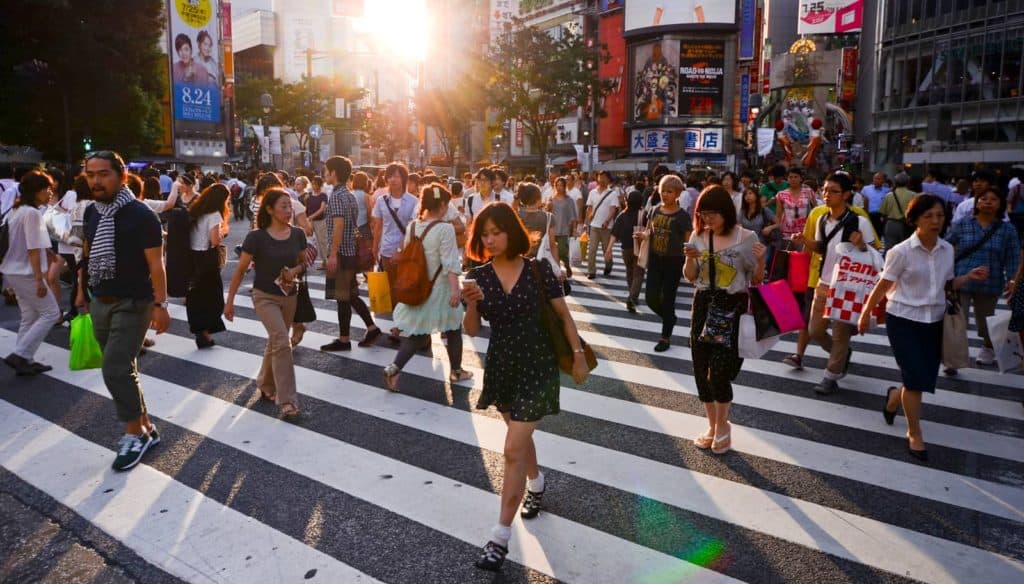
1 p.m. Lunch in Shibuya
There are countless restaurants in the area to choose from, so you certainly have your pick. You can try sushi at Uoriki, yakitori at Morimoto or Yakitori Tetsu (which is the cheaper of the two), soba noodles at Fukudaya, or teishoku at Echigoya Sandayu. Let your cravings and your wallet guide your decision.
2 to 2:30 p.m. Travel to Roppongi
After an hour to an hour and a half of dining, it’s time to take another ride so you can continue your day. This time, you want to be on the JR Yamanote Line, which you should ride to Ebisu Station. You’re not done yet, as it’s time to get on the Hibiya Line subway east. After two stops, you should be at your destination, Roppongi. This travel should take roughly 30 minutes.
3 p.m. Roppongi Hills Complex
While you’re in Roppongi, I recommend you take some time to see the Roppongi Hills Complex. To do so, you’ll have to go to the Mori Tower and ride 52 stories up to the Tokyo City View observation deck. It’s a gorgeous sight one of the best vantage points you’ll get of Tokyo!
5 to 6 p.m. Dinner in Roppongi
After you finish with the breathtaking views of the observation deck, you’ve probably worked up quiet an appetite. You might as well stay in Roppongi and round off your day here with some delicious dinner. You can find teppanyaki at Restaurant Omae XEX, pizza at Pizzkaya Roppongi (yes, there’s pizza in Japan), and even Italian at Il Figo Ingordo.
If you want to be adventurous and eat Japanese fare, try ramen at Ippudo Roppongi Branch and French and Japanese fusion food at Narisawa or Takazawa.
7 to 8 p.m. Nightlife or Go Home
Depending on how tired you are, you might elect to stay and see Roppongi at night. This is one of the best-known areas of Japan when it comes to nightlife, so you would have made the right choice. But before you go partying in Roppongi, you really need to read this article. Tokyo might not be as safe as you think .
For some culture, you can visit art museums like Musee Tomo, Suntory Museum of Art, Mori Art Museum, and the National Art Center Tokyo . The Nogi-jinja Shrine is here if you missed it earlier in the day.
Otherwise, you can spend your time at Tokyo Midtown, which is an entertainment, dining, and shopping complex with a Ritz-Carlton Hotel right in the middle. It’s easy to spend hours here, but watch the time, because you don’t want to be out super late.
Wait until you see what’s in store for your second day in Tokyo.
8 a.m. Asakusa-jinja Shrine and Senso-ji Temple
Good morning! It’s your second day in Tokyo and there’s a lot you can do. Hopefully, you weren’t out too late partying it up in Roppongi, because you’ll want to be awake and traveling before 8 a.m. to make the most of your day.
Once you leave your hotel, you’ll need to get on the Ginza subway and ride it until you arrive to Asakusa. This is where you’ll find several buildings that are definitely worth seeing, such as the Asakusa-jinja Shrine and the Senso-ji Temple .
If you have the time, be sure to stop into the Edo-Tokyo Museum and have a look around. Also, if you can get tickets, you’d want to head to Ryogoku from Asakusa to see a live sumo wrestling event at Ryogoku Kokugikan. This is definitely worth doing at least once! In fact, it’s one of the most awesome things about Japan ! Make sure you keep reading until the end of this article, because I’ll talk more about live sumo matches. Make sure you keep reading until the end of this article, because I’ll talk more about live sumo matches.
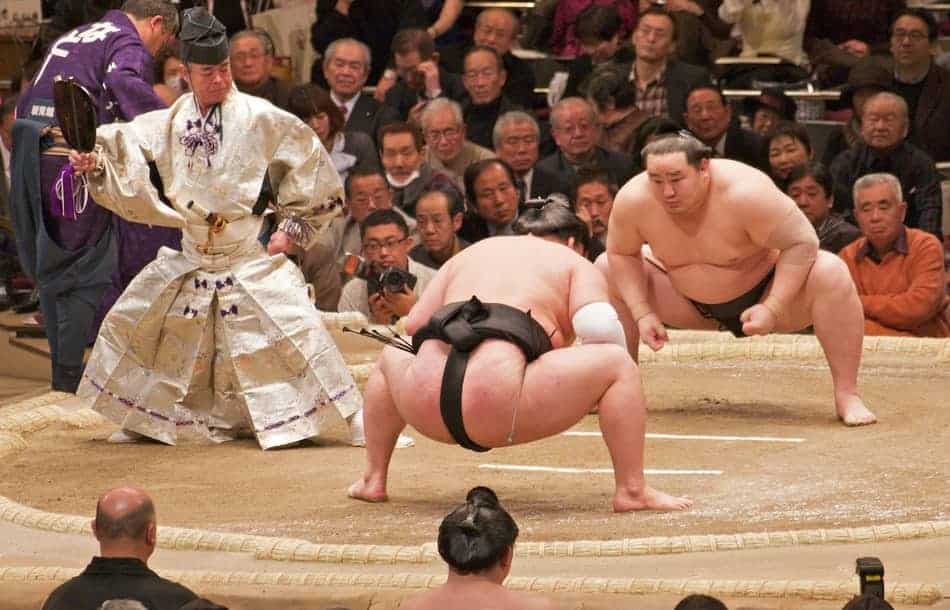
11 a.m. Tosho-gu Shrine, Ueno-koen Park, and Tokyo National Museum
After you’ve had a few hours to enjoy the shrines and the museum in Asakusa, it’s time to move on. (If you’ve fallen in love with Asakusa you should check out the world’s tallest tower – Tokyo Skytree .) You want to get back on the Ginza subway. This time, ride it west for three stops. You’ll arrive at Ueno soon after.
There’s tons to do here, so expect to spend two or three hours in this part of Tokyo. For another landmark worth seeing, don’t miss the Tosho-gu Shrine. Ueno-koen Park, also known as Ueno Park , will keep you busy, too. After all there’s a zoo in there. You’ll also find cherry blossom trees, cafes and restaurants, and the Tokyo National Museum around here. Take some time to really take it all in and have some lunch while you’re at it.
2 p.m. Tokyo Station and Mitsubishi Ichigokan Museum
When you’ve decided you’ve had your fill of Ueno Park, get on the JR Yamanote Line south. You want to ride it until you get to Tokyo Station. This is another nice place to eat lunch if you can’t find anywhere at Ueno Park that jumps out at you (unlikely, but hey, it happens).
When you get there, head into the Mitsubishi Ichigokan Museum . Nearby areas of interest are Hibiya-koen Park and the Bridgestone Museum of Art. Take your time exploring these areas, as your day is essentially free from here.
5 p.m. Akihabara aka Electric Town
If you’re looking for a place to unwind and relax for a few hours, try a maid café at Akihabara. These are quite the attraction since the employees dress up in maid costumes. You’ll also find many electronics and tech shops here. Akihabara can be quite a popular destination, especially at night, when the billboards and buildings light up the streets.
Once you’re done exploring all Akihabara has to offer, head back to your hotel for the night. You’re probably quite tired from getting up so early anyway! While you won’t have as early a start for your last day in Tokyo, you do want to be well-rested.
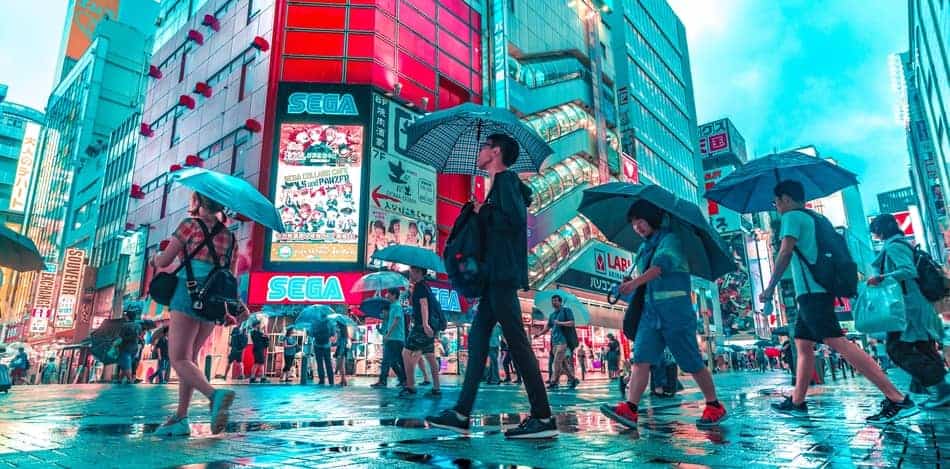
9 a.m. Shinjuku and Imperial Palace Area
You wake up refreshed and ready to tackle the third and final day of your Tokyo trip. The first thing you want to do after you get dressed and showered is head to the Tokyo Station. You can get there by subway or train.
Upon your arrival, head east on foot until you reach the Imperial Palace East Garden. Plan to spend a good amount of time here since the garden is quite large, roughly 2.3 million square feet. It also gives you a chance to get a glimpse into the inner palace area, which is seriously a treat.
You probably won’t get through all the gardens because that’s a lot to cover by foot, but do as much as you can. When you’re done, make sure you leave through the Kitahanebashi-mon exit. This’ll make it most convenient to continue on your way.
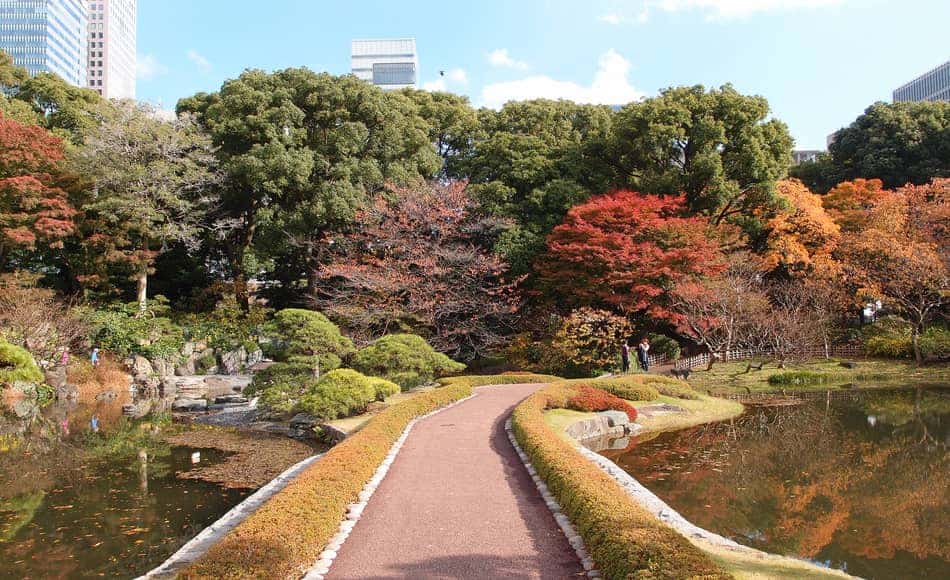
11:30 a.m. Yasukuni-jinja Shrine and Kitanomaru-koen Park
I hope your feet aren’t too tired yet since you’ll want to continue walking after you’ve left the Imperial Palace East Garden. Through the Kitahanebashi-mon exit, head north. You’ll come upon the Kitanomaru-koen Park.
Continue along the park to the Yasakuni-jinja Shrine. Near the shrine, you’ll see the Yushukan Museum, a war museum told from a nationalist perspective. It’s got a touch of a reputation, that’s for sure, so it’s worth checking out.
1 p.m. Lunch in Shinjuku, Tokyo Metropolitan Government Offices
Once you’re done with the park and the museum, get on the Shinjuku Line subway and take it west. Get off the train when you arrive in Shinjuku. Now that you’re here, it’s time to chow down.
There are nearly countless restaurants in Shinjuku, so you shouldn’t have a hard time finding a place to enjoy some lunch. If you miss American food, Brooklyn Parlor serves burgers and fries. Otherwise, you might try izakaya at Hibiki Shinjuku-ten, yakitori at Shousuke, sukiyaki at Imahan, or dim sum at Din Tai Fung. You can also find tempura at Tenkuni or Tsunahachi.
Now that your stomach is full, you can head over to the Tokyo Metropolitan Government Offices, specifically the observation deck. Depending on the weather, you can get a pretty good view of Mt. Fuji and an even better view of most of Tokyo. It’s not one you’ll want to skip.
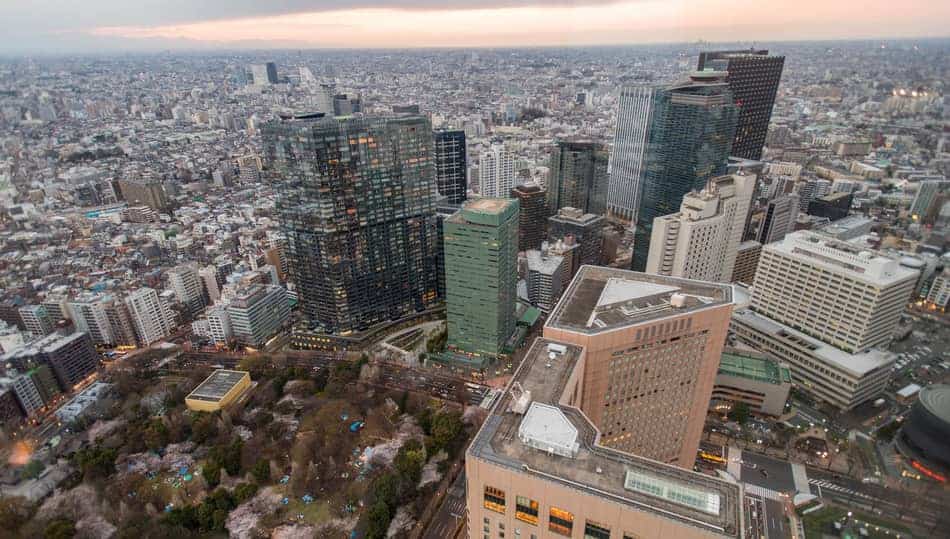
5 p.m. Dinner and Rest (Your Choice)
The way you spend the rest of the day is up to you. You can head back to one of the areas you enjoyed in the past few days, such as Ginza, Shibuya, and Shinjuku. You could grab a bite to eat at any of the plentiful restaurants. You might again choose to engage in some nightlife at Roppongi.
If you’re in Tokyo in September, May, or January, you might be lucky enough to be able to see a live sumo tournament . These last for about two weeks and only occur during those three months. You can also try an animal café. While cat cafes are incredibly popular in Japan, you can pet plenty of other fuzzy friends while sipping a hot beverage at Tokyo’s various animal cafes. There’s bunny cafes and even some that have hedgehogs, owls, and dogs.
If you liked the theming of the maid café, try a robot restaurant in Shinjuku. You might also elect to spend some more time shopping in Tokyo Midtown. If it’s early enough, you could even return to the Imperial Palace East Garden and pick up where you left off. Most days, the garden does close at 5 p.m. though, so you’d have to plan accordingly.
Once you feel like you’ve spent your day well, you can head back to your hotel, shower, pack, and rest up. Tomorrow will be a big travel day, but you sure did spend your three days well!
Other Considerations
As you follow this three-day Tokyo itinerary or plan your own, keep the following points in mind:
- Since you’ll be doing a lot of walking around outside, you don’t want your three days in Tokyo to be hampered by rain. While rain can occur any day, the rainiest times of year in Japan are June and July. Avoid traveling during those months if you can.
- Also, in July until September, weather in Tokyo can be very hot and humid , much like it is here in the US during the summertime. Again, since you’ll be outside so much, plan your trip around the weather.
- The subway metro system you’ll need to get around Tokyo requires a PASMO card. If you’ve ever been to New York City and used a Metro card, the concept is the same. You put a certain amount of money on the card and then run it through the turnstiles whenever you want to ride a subway. PASMO cards are available at train stations and airports. Don’t forget yours!
- You might have to stop at a convenience store to use an ATM with an American credit or debit card. ATMs throughout the city will not accept your card, so make sure you’re prepared with another source of funding for your trip.
- When you eat a meal in Japan, you’re not supposed to tip. Doing so could offend your waitstaff and lead to a potentially embarrassing situation for you.
- While Tokyo is regarded as a safe city , don’t be careless. Be aware of pickpockets and scammers. Keep your wits about you. Don’t bring all your money with you each time you leave your hotel. That’s what a hotel safe is for.
There are countless things to see and do in Tokyo, but with a tight, precise itinerary, you can hit most of the big spots and activities even if you only have three days to do so. I hope you enjoyed this guide and you were inspired by the itinerary. Feel free to tweak or otherwise change it any way you want so it matches your interests and level of enthusiasm. Good luck and enjoy yourself!
If you have any questions, you can always leave a comment, and I’ll do my best to answer it. 🙂
Why not pin it for later? You can also follow the The Tokyo Tourist on Pinterest. 🙂

Recent Posts
The 15 Best Animal Cafés in Tokyo
When you think of an animal café, Tokyo is probably one of the first places to come to mind for such an establishment, right? Originally getting their start in Taiwan, Japan took the idea of...
When Is the Best Time to Visit Tokyo? The Definitive Guide
You have no doubt in your mind that you want to visit Tokyo. The question becomes, when? Surely there are better times of the year than others, right? You wouldn’t mind traveling in the...
Turn your dream vacation into reality

3 Days in Tokyo (Itinerary + Mount Fuji Tour)
- April 22, 2024
The best itinerary for 3 days in Tokyo (+ a map with all top attractions, how to get to Mount Fuji and my favourite places for ramen and sushi).
Tokyo, with its ancient temples, zen gardens and towering skyscrapers, is a unique blend of historical charm and cutting-edge modernity. It’s a bustling and vibrant city known for its fantastic food scene and a rich history that goes back centuries.
Tokyo’s origins can be traced to a small fishing village known as Edo, established around the 12th century. In the early 17th century, Tokugawa Ieyasu, founder of the Tokugawa Shogunate, chose Edo as his administrative and military headquarters. In 1868 following the Meiji Restoration (the restoration of imperial rule), the Emperor moved the capital from Kyoto to Edo, which was renamed Tokyo. In fact, Tokyo means Eastern Capital in Japanese, distinguishing it from Kyoto in the western part of the country.
Best 3-day Tokyo Itinerary
As Tokyo is among the world’s largest cities, planning a trip might feel a bit daunting, especially if you’re visiting for the first time. There is so much to see – from historic temples (such as Meiji Shrine and Sensō-ji Temple) to iconic places like Shibuya Crossing and themed cafés. Also, as the city is vast, travelling between neighbourhoods will take up a good amount of your time.
My Tokyo itinerary for first-timers will guide you through the most popular attractions, historic sites and culinary experiences. I structured it in such a way, that you can make the most of your time in the city. I’ve also listed my favourite places to eat ramen, tonkatsu and tempura!
3 Days in Tokyo Itinerary (for first-timers)
- Day 1 – Tokyo Skytree, Sensō-ji Temple, Japanese dinner cruise
- Day 2 – Meiji Jingu, Shibuya Scramble Crossing, Hachiko Memorial Statue, Cat Café MoCHA
- Day 3 – Tokyo National Museum, Imperial Palace, Tokyo Tower
In my opinion, dedicating between 3 and 4 days in Tokyo is the ideal duration of time. This lets you see all the main sights without rushing and even take a day trip to Mount Fuji (on the 4th day). I also included some suggestions for those considering a 5-day stay in Tokyo, below the 3-day itinerary.
Tips on your 3-day Tokyo itinerary
Accommodation – already have a hotel reserved? Then check its location to ensure it’s situated near a station with both metro and JR lines (more info in my guide on where to stay in Tokyo first time ).
My favourite place to stay in Tokyo : The Blossom Hibiya Why : central location for sightseeing, easy access to metro and JR lines What I like : panoramic city views, Japanese sake bar, Western and Japanese breakfast buffet
Restaurants – restaurants often specialize in one specific type of food, for example, ramen, sushi, tempura, etc. Many are small and you often sit at the counter, facing the chef, watching the culinary preparation process. If possible make a reservation, because there are usually lines and if the place is really popular they could be hours long.
Map – find here a map of this 3-day itinerary for Tokyo (with all attractions and restaurants’ websites).
Internet – having an internet connection in Tokyo is essential for navigating between locations (using Google Maps) and translating restaurant menus. Consider renting a pocket WiFi or buying an eSim .
3 Days in Tokyo itinerary – Day 1
Breakfast at kameya.
09:00 AM – 09:40 AM
Start your first day with breakfast at Kameya . This lovely little bakery offers a good selection of pastries and sandwiches.
Tokyo Skytree
10:00 AM – 11:30 AM
With its impressive height of 634m (2080 feet), Tokyo Skytree is the tallest structure in Japan. Completed in 2012, the tower offers breathtaking panoramic views of the city and the surrounding region. You can even see Mount Fuji on a clear, sunny day!
There are two observation decks, located at heights of 350m (Tembo Deck) and 450m (Tembo Galleria). The Tembo Deck spans three levels, providing fantastic views from each floor. To reach the Tembo Galleria from the Tembo Deck, you have to take an elevator, which means you need to wait in an additional line. You can opt for a ticket for just the lower platform (Tembo Deck) or a combo ticket for both.
Booking in advance is recommended (tickets are timed-entry and often sold out) Entry ticket : Skip-the-line Tokyo Skytree
After dark (between 6:15 PM and midnight) the tower is illuminated in different colours. There are two main illumination patterns, which change daily – blue Iki (the spirit of Edo) and purple Miyabi (its aesthetics). On occasion, there is special illumination, featuring other colours like red or orange (considered a sign of good luck since ancient times).

Lunch at Kura Sushi Asakusa ROX
12:00 PM – 01:30 PM
Kura Sushi is a popular sushi restaurant chain, a great place to experience conveyor belt sushi. The conveyor belt carries plates of sushi throughout the restaurant, allowing you to take whatever you wish. Additionally, you can order freshly made sushi on a tablet, which will be delivered straight to your table via the conveyor belt. A unique and fun experience! I really loved the Shrimp Tempura Hand Roll and the Hokkaido Milk Creamy Tart.

Another option for lunch is Yoroiya Ramen . It’s a great place to try the classic Tokyo-style shoyu ramen and some crispy gyoza.
Sensō-ji Temple
01:30 PM – 03:30 PM
Sensō-ji Temple is a Buddhist temple with a rich history dating back to the 7th century. Built in 645, it stands as Tokyo’s oldest temple. Sensō-ji is dedicated to Kannon, the Buddhist goddess of mercy.
According to the legends, two fishermen accidentally caught a statue of the goddess Kannon, while fishing in the Sumida river. Despite returning it to the water, the statue kept coming back to them. Seeking guidance, they presented the statue to the village headman, who recognised the statue as the goddess Kannon. In reverence, the fishermen devoted their lives to her and built Sensō-ji Temple.
Sensō-ji is, in fact, a large complex, which consists of several buildings and gates, including a five-story pagoda and the Asakusa Shrine. The first gate Kaminarimon (Thunder Gate) is famous for its large red lantern, a symbol of Asakusa. The gate is decorated with statues of Fūjin (the Shinto god of wind) and Raijin (the Shinto god of thunder).

Beyond the Kaminarimon Gate, lies Nakamise-dori, a vibrant shopping street. It is lined with small shops selling all kinds of traditional Japanese goods like souvenirs, handcrafted items and snacks. Many of the shops here have been operating for centuries, and some of them can even trace their roots back to the 15th century. It is the best place to buy souvenirs and gifts in Tokyo!
The Asakusa Shrine was commissioned by Tokugawa Iemitsu in 1649 during Japan’s Edo period.
Sensō-ji Temple is free to visit. In my opinion, it is the most impressive temple in Tokyo and I highly recommend visiting it, including the market around it.

Dinner at Tempura Yasuda
Head to Tempura Yasuda for some delicious tempura or to Nishimura for tonkatsu. If you can’t make a reservation, go a few minutes before the opening times, as both restaurants are popular among locals and always packed.
Tempura Yasuda is one of my favourite restaurants for tempura in Tokyo. It is a small restaurant, hidden down a narrow staircase in the basement. They serve excellent crispy tempura, focused on the original taste of the ingredients.
Nishimura is a small tonkatsu restaurant, offering very good crispy and tender tonkatsu. In my opinion, one of the best tonkatsu in the city.

More ideas for 3 days in Tokyo – Day 1
Experience a traditional japanese dinner cruise.
Take this Japanese Traditional Yakatabune Dinner Cruise to enjoy the beautiful view of Tokyo Skytree and Tokyo Bay in the evening. You’ll cruise down the Sumida River toward the bay while savouring an authentic Japanese dinner with all you can drink.
Watch a sumo morning training
Sumo wrestling is one of the most popular national sports in Japan. To discover this Japanese martial art form and its long traditions, join this Sumo morning training experience . This tour gives you the opportunity to witness the morning training sessions of professional Sumo wrestlers from behind the scenes.
3 Days in Tokyo itinerary – Day 2
Breakfast at boul’ange.
Start your second day of this 3-day Tokyo itinerary with breakfast at Boul’ange Shinjuku Southern Terrace . Excellent pastries, I especially liked the croissants (the best ones in Tokyo)!

Meiji Jingu
Meiji Jingu is one of the most significant and revered Shinto shrines in Japan. Located in a serene forested area, the shrine is surrounded by over 100,000 trees, donated from all over the country. Even with the crowds, I found the temple very peaceful.
Meiji Jingu is built in 1920 and it is dedicated to Emperor Meiji and Empress Shoken. During their rule (1867 – 1912), Japan transformed from an isolated nation to a major world power.

Meiji Jingu covers a large area, featuring several structures, torii gates, forested pathways and gardens (see a map with all Meiji Jingu’s highlights ). The shrine is free to visit, but access to certain areas (like the museum or the inner garden) requires a fee.
Some of the highlights of Meiji Jingu are:
- a display of sake barrels donated by various producers from all over Japan
- the Inner Garden (formerly an imperial property), which is filled with azaleas in spring and irises in June
- Camphor Tree Couple – the two trees were planted during the construction of the shrine. Since then, they’ve been growing side by side, symbolizing a solid and happy marriage, much like the union of Emperor Meiji and Empress Shoken

Lunch at Udon Shin
For lunch head to Udon Shin or Afuri Harajuku .
Udon Shin serves one of the best wheat noodles in Tokyo. Don’t miss their signature meal carbonara udon or the tempura udon. As the restaurant is extremely popular, there is a queuing system implemented. You have to take a reservation ticket from the ticketing machine outside the store. Then you’ll receive an alert when you can join the physical queue outside the store. You can take your ticket before the opening times, so do it on your way to Meiji Jingu.
Afuri Harajuku is a famous ramen shop known for its unique chicken and dashi-based broth that is lighter than the traditional style. Their signature dish is Yuzu Shio – light chicken ramen with yuzu, a small yellow citrus fruit native to Asia. The restaurant is very popular, so expect long lines.
Shibuya Scramble Crossing
02:00 PM – 02:40 PM
Shibuya Scramble Crossing, often referred to simply as Shibuya Crossing, is an iconic pedestrian intersection. It is one of the busiest intersections in the world, with over 3,000 people crossing it every time the signal changes.
Shibuya Crossing is famous for its scrabble design, where traffic from all directions stops simultaneously. This allows people to cross in all possible directions, even diagonally. Surrounded by giant neon advertisements and signs, Shibuya Scramble Crossing is a symbol of Tokyo’s modernity.
For a view of Shibuya Scramble Crossing from above, head over to:
- Mag’s Park Rooftop Shibuya Crossing – observation deck, located on the rooftop of Magnet by Shibuya 109
- Shibuya Sky – a 360° observation deck at the rooftop of Shibuya Scramble Square, offering panoramic views of the city and Shibuya Crossing
- Starbucks Shibuya Tsutaya – where you can enjoy great views of the crossing with a cup of coffee

Hachikō Memorial Statue
02:40 PM – 03:00 PM
At one corner of the Shibuya Crossing, you’ll find the Hachikō Memorial Statue. It commemorates the touching story of Hachikō, an Akita dog known for his loyalty to his owner, Professor Hidesaburo Ueno.
Every day, Hachikō would accompany his owner to Shibuya Train Station and await his return in the evening. However, in 1925, Professor Ueno passed away unexpectedly while at work, leaving Hachiko heartbroken. Hachikō continued to come every day to the station for the following 9 years, patiently waiting for the professor’s return.
His loyalty and devotion deeply moved the Japanese people. In 1934, a bronze statue of the dog was placed near Shibuya Train Station to honour his loyalty and devotion.

Dinner at Gyopao Gyoza Shinjuku
For the best dumplings in the city, head over to Gyopao Gyoza . This small restaurant is a fusion of Taiwan-style Chinese cuisine and Japanese Izakaya. They offer various flavourful dumplings, including fried, boiled dumplings with gravy, and dim sum.
More ideas for 3 days in Tokyo – Day 2
Cat café mocha.
For cat enthusiasts, a visit to Cat Café MoCHA is a must! It’s the best cat cafe I’ve ever been to during my travels. They have several locations all over the city, featuring 15-20 cute cats per location in different breeds (I visited the one in Shibuya).
Twice a day (at 10:30 AM and 7:30 PM) the cats are lined up in a neat row for feeding. It’s a real show! For fewer people, consider visiting during the weekdays just after the café opens.

Samurai Experience and Lesson at a Dojo
For a glimpse into old Japan, join this Samurai Experience and Lesson at a Dojo . You’ll learn about the culture of the samurai, how to handle and use a katana and practice different techniques. The workshop ends with a test-cutting lesson, where you’ll use a real samurai sword to slice two poles!
Tokyo Pub Crawl
Discover the city’s nightlife on this Tokyo Pub Crawl and meet new people while exploring different bars and clubs. You’ll visit 3 bars and clubs, where you’ll enjoy free shots and drink discounts. The pub crawl ends with a visit to a dance club, giving you the chance to mingle with locals.
Check out Tokyo’s cutest 3D billboards
Tokyo has several awesome 3D billboards, but my favourites are the ones, featuring a calico cat and Akita Inu. You’ll find the Akita Inu on eight billboards in the area of Shibuya Crossing, Hachiko-mae Square and the Miyamasuzaka Intersection. And to see the giant calico cat head to Shinjuku Station, the billboard is opposite the east exit of the station (at Cross Shinjuku Vision).

Ramen Tasting Tour
Learn about the ramen origins, types and preparation on this Ramen Tasting Tour . You’ll visit 3 unique ramen shops, where you sample 6 different mini bowls of delicious ramen. You’ll get to taste unique curry ramen, pork ramen and fish-based ramen, that you wouldn’t find outside of Japan.
Sushi Making Class
To learn the art of crafting delicious sushi rolls, take this Sushi Making Class . With step-by-step instructions, you’ll learn how to make 8-9 kinds of sushi, including nigiri, inari and sushi rolls. You’ll also enjoy some miso soup alongside the sushi you’ve prepared.
3 Days in Tokyo itinerary – Day 3
Breakfast at andersen atre ueno bakery.
08:30 AM – 09:15 AM
Start your last day of this Tokyo itinerary with breakfast at Andersen Atre Ueno Bakery or Gouter Le Ble . Andersen Atre Ueno offers amazing Danish pastries, while at Gouter Le Ble you’ll find a wonderful selection of Japanese and French-styled baked goods.
Tokyo National Museum
09:30 AM – 11:30 AM
Tokyo National Museum is Japan’s oldest and largest museum. Its extensive collection is housed in several buildings, showcasing different periods of Japanese art, history, and culture.
Start with the Japanese Gallery (Honkan) and the Asian Gallery (Toyokan) – the two main (and in my opinion most interesting) exhibitions. The Japanese Gallery (Honkan) presents a collection of Japanese art and historical artifacts, including armour, weapons and antique Buddhist statues. The Asian Gallery (Toyokan) features artworks and items from places such as China, Korea, Southeast Asia, Central Asia, India, and Egypt.
Being a history buff, Tokyo National Museum was one of the highlights of my Tokyo visit, so I highly recommend it.

Lunch at Ebimaru Ramen
For lunch head to Ebimaru Ramen , the only ramen shop, which specialized in lobster bisque. The bisque is made using selected ingredients such as lobster shells, wine and many kinds of vegetables. It is not possible to make a reservation, so anticipate a wait of 30 minutes to an hour during lunchtime.
Even though I’m not a big ramen fan, I absolutely loved the ramen here. In fact, it was the best I’ve had in Japan during my entire trip.
Right next to Ebimaru Ramen, you’ll find a small taiyaki shop. Taiyaki is one of my favourite street foods. It’s a pastry shaped like a fish filled with red bean paste or vanilla custard. An excellent spot for dessert after a delicious ramen!

Imperial Palace and East Gardens
02:00 PM – 03:30 PM
The Imperial Palace has served as the primary residence of the Emperor of Japan since 1868. It is built on the grounds of the former Edo Castle, the seat of power of the Tokugawa Shogunate. After the end of the Tokugawa Shogunate in 1867, imperial rule was restored, an event known as the Meiji Restoration. The country’s capital was moved from Kyoto to Edo, renamed Tokyo, and Edo Castle was transformed into a royal residence.
The Imperial Palace itself is not open to the public, but you can visit the East Gardens. The gardens are divided into several sections – the East Gardens, Kitanomaru Koen Park and the Kokyo Gaien National Garden. For the best views of the Imperial Palace, make your way to Seimon Ishibashi Bridge, situated at the palace’s main entrance.
Entry ticket : free Best guided tour : there are free guided tours in English at 10 AM and 1:30 PM (you have to register in advance here ) or you can download this Imperial Palace self-guided tour

Dinner at Ginza Kagari Ramen
Finish the day with a delicious dinner at Ginza Kagari Ramen or Okonomiyaki Kiji . Ginza Kagari Ramen offers great chicken ramen (don’t miss their special ramen with slices of truffle). For tasty okonomiyaki (a Japanese-style savoury pancake with various ingredients) head to Okonomiyaki Kiji.

More ideas for 3 days in Tokyo – Day 3
Tsukiji outer market.
The Tsukiji Outer Market is one of the most popular markets in the city. The market is known for its wide variety of fresh seafood. You can find a rich selection of seafood stalls, sushi restaurants and various street food vendors. To learn about the Japanese food culture and sample some of the finest seafood, join this Tsukiji Outer Market Food Tour .
Yasukuni Shrine
Founded in 1869, Yasukuni Shrine is a Shinto shrine dedicated to Japan’s war dead. The shrine commemorates all who sacrificed their lives for Japan, particularly soldiers who died in wars. The spirits of almost 2.5 million people, who died during the Boshin War, Russo-Japanese War, World War I and II, and other war conflicts, are enshrined here.
Adjacent to the shrine, you’ll find the Yushukan War Memorial Museum. The museum is dedicated to Japan’s military history, particularly its involvement in various military conflicts since the Meiji Period.

Dress up in a kimono
If you are looking for a unique cultural experience, book your Kimono Dressing and photography session here . You’ll get the opportunity to dress in an authentic silk kimono and learn how to properly wear it and behave. The tour includes a walk through Yanaka, one of the city’s most traditional districts.
Tokyo Tower
Standing at 333m (1092 feet) height, Tokyo Tower is the second tallest structure in Japan. Completed in 1958, the tower was designed in the image of the Eiffel Tower, though slightly taller. Tokyo Tower has two observation decks offering 360-degree views of the city, at heights of 150m and 250m.
Don’t miss the evening illuminations, starting at sunset till midnight. In winter, the illumination is a warm orange, while in summer, it shines in white.
If you’re visiting during the peak season, I recommend booking your Tokyo Tower ticket in advance.

Zōjō-ji Temple
Next to Tokyo Tower, you’ll find Zōjō-ji, a 14th-century Buddhist temple. The temple is most known for its association with the Tokugawa Shogunate, which ruled Japan during the Edo period. In the 16th century, Tokugawa Ieyasu chose Zōjō-ji Temple to serve as his family temple. You can visit the mausoleum of the Tokugawa clan, which houses the tombs of six Tokugawa leaders who held the title of shogun.

Just to the right of the main hall of the temple is the Sentai Kosodate Jizō. There are more than 1,000 Jizō statues, adorned with bonnets and toys. The statues are dedicated to the souls of unborn and deceased children, as well as the health and well-being of living children.

Owl Cafe Akiba Fukurou
Located in the Akihabara district, Owl Cafe Akiba Fukurou is a must for every owl enthusiast. Featuring more than 40 owls, this is one of the largest owl cafes in Japan.
To visit the cafe you have to make a reservation in advance . I suggest making your booking at least one month ahead, given the limited availability of spots.
Must buy tickets in advance
Tokyo Skytree – with 4.3 million visitors per year this is the city’s most popular attraction, so ensure your Tokyo Skytree ticket by reserving here .
4-day Tokyo itinerary
If you’re visiting Tokyo for the first time, I recommend dedicating 4 days. This is the perfect amount of time to discover the city’s major attractions and see the famous Mount Fuji.
4 days in Tokyo
- Day 4 – day trip to Mount Fuji
5-day Tokyo itinerary
If you’re visiting during the peak season like cherry blossom, I’d suggest spending 5-6 days in Tokyo. You’ll need some extra time to explore the numerous stunning sakura spots. Find more information in my complete Tokyo sakura guide (+ festival dates and the best cherry blossom viewing spots).
5 days in Tokyo
- Day 1 – Tokyo Skytree, Sensō-ji Temple
- Day 2 – Meiji Jingu, Shibuya Scramble Crossing, Hachiko Memorial Statue
- Day 5 – Sumo morning training, Tsukiji Outer Market, Cat Café MoCHA, Japanese dinner cruise
Where to stay in Tokyo
If you’re a first-time visitor to Tokyo opt for accommodations in a central area near both metro and JR lines. Tokyo is a vast city, and even with its efficient public transportation, you could end up spending a lot of time on transportation.
In my opinion, the most convenient place to stay in Tokyo is Shimbashi. It’s a centrally located district, making it ideal for sightseeing and shopping. Several metro and JR lines pass at Shimbashi Station, providing direct access to Shinjuku Station and Tokyo Station (for the Shinkansen bullet trains).
The Royal Park Hotel – Best mid-range
Guest rating: 8.7 | 4,700+ reviews
The Royal Park Hotel offers breathtaking views of Tokyo Tower and Hama-rikyū Gardens. Its central and accessible location is just a 3-minute stroll from Shimbashi and Shiodome stations. You can choose from three dining options: Chayama Macrobiotics for organic cuisine, Harmony Restaurant for Western dishes, and Oshima Shiodome for Japanese delicacies.
Why book – 3min walk from Shimbashi and Shiodome stations (metro and JR lines), city views
Imperial Hotel – Best luxury
Guest rating: 9.0 | 550+ reviews
The Imperial Hotel enjoys a prime central position, conveniently located within a brief walk of the Imperial Palace, Shimbashi Station, and Tokyo Station. The hotel offers several dining choices, including 13 restaurants, 3 bars, and a traditional Japanese teahouse.
Why book – 5min walk from several stations (metro and JR lines), indoor pool, classical Japanese teahouse on-site

Getting around in Tokyo
Tokyo has an efficient and extensive train system, which consists of trains (Japan Rail) and metro (Tokyo Metro). These are two different companies and you’ll need different types of tickets for each of them. For example, you can’t use a JR Pass on the Tokyo Metro or use a metro pass on the JR lines.
Japan Railways operates several JR lines in Tokyo (see the city’s JR network map ). The most famous JR line is the Yamanote Line, which forms a loop around central Tokyo and stops at many key attractions. The metro system consists of multiple lines, each identified by a different colour and letter (find here a map of the metro ). The Tokyo Metro and Toei Subway are the two main operators of the metro lines.
In general, to get around Tokyo, you’ll have to use a combination of JR lines and metro. To save time and money buy an IC Card (most popular are Suica card or Pasmo card ). This is a prepaid contactless card, which is valid for both the metro and the JR lines. You can buy Suica and Pasmo at almost every metro or train station. To use the card, simply tap it on the reader at the station gate and then tap it again when you exit at the next station.
How to get to Tokyo
If you’re travelling from Osaka or Kyoto via the Shinkansen (bullet train), you’ll arrive at either Tokyo Station or Shinagawa Station. Opt for Tokyo Station, the central railway station, as it’s closer to the city centre. Check timetables and book tickets online for the Shinkansen here .
If you planning to visit multiple cities in Japan, get a JR Pass . The pass gives you unlimited access to all JR trains for 7, 14, or 21 days.
Tokyo is served by two airports – Narita Airport and Haneda Airport.
Narita Airport Narita Airport (NRT) is located about 60 kilometres east of central Tokyo. There are several options to get to the city centre:
- the easiest way is to book a private transfer directly to your hotel
- Narita Express – a limited express train that connects Narita Airport with Tokyo Station, Shinjuku Station and Shibuya Station (1h journey)
- Keisei – a high-speed train that connects Narita Airport with Ueno Station (45min journey)
Haneda Airport Haneda Airport (HND) is conveniently located within the city limits. To get to the city centre from the airport:
- book a private transfer , which takes you directly to your hotel
- Tokyo Monorail Line – connects Haneda Airport with Hamamatsucho Station (20min journey), from there you have to transfer to JR Yamanote Line
- Keikyu Line – connects Haneda Airport with Shinagawa Station (15min journey), then you have to transfer to local metro lines

Day trips from Tokyo
Mount Fuji is the country’s highest and most iconic mountain. It is famous for its perfectly symmetrical cone and natural beauty. Considered a sacred site in Japanese culture, Mount Fuji has been a source of inspiration for artists and poets for centuries.
Travelling between Tokyo and Mount Fuji by public transport takes between 2 to 3 hours in one direction and includes at least one transfer. You can travel by local trains or take the Fuji Excursion train, which connects the Mount Fuji area (Kawaguchiko Station) directly to Shinjuku Station. However, when you get there it won’t be possible to see all the famous spots in the area, as they are far from each other.
That’s why I highly recommend taking this organized Mt. Fuji Full-Day Sightseeing Trip (more than 1,100+ excellent reviews). It will take you to the most popular spots in the area, including Kawaguchi Lake, Arakura Sengen Shrine and Oshino Hakkai (where you can taste the water from Mount Fuji).
Nikko Toshogu Shrine
Nikko Toshogu Shrine, known for its rich decoration and historical significance, is one of the most famous shrines in Japan. This 17th-century shrine is dedicated to Tokugawa Ieyasu, the founder of the Tokugawa Shogunate that ruled Japan for over 250 years.
For a day trip from Tokyo to Nikko Toshogu Shrine, consider taking this organized Nikko Toshogu Shrine and Kegon Waterfall Tour . The tour includes also the Kegon waterfall, one of the three most beautiful waterfalls in Japan.
What to see next
If you plan to stay in Japan for more than a week, think about visiting Kyoto, the former imperial of the country. The journey from Tokyo to Kyoto is less than 2h30min by Shinkansen. To learn more, check out my 3-day Kyoto itinerary for first-time visitors.
Best time to visit Tokyo
If you want to visit Tokyo when the city is at its most beautiful, plan your trip during the spring or autumn seasons. The best time to enjoy the cherry blossom (sakura) is mid-March to early April. For beautiful fall foliage visit the city from late October to late November. However, remember that these are the busiest times during the year, so plan everything in advance.
The best months to visit Tokyo for nice weather and fewer crowds are April (after the sakura season), May, September and October. Avoid the summer months of June, July and August, as it is the rainy season and the weather is hot and humid. Also, it’s the peak season for domestic travel.
Faqs about visiting Tokyo
For those visiting Tokyo for the first time, I suggest planning a stay of 3-4 days. This duration allows you to visit the city’s top attractions (including Tokyo SkyTree, Sensō-ji Temple and Shibuya Scramble Crossing), watch a sumo morning training or visit the famous Tsukiji Outer Market.
While Tokyo has plenty to offer, 4 days can provide a good introduction to the city’s main attractions and experiences. You’ll be able to visit its iconic attractions such as Tokyo SkyTree, Sensō-ji Temple and Shibuya Crossing, enjoy some local cuisine and even take a day trip to Mount Fuji.
Tipping is not a common practice in Tokyo and it can even be considered inappropriate or rude in some situations.
Yes, tap water in Tokyo is entirely safe to drink. The water quality and treatment standards in Tokyo are very high, so you can confidently drink water straight from the tap in most places throughout the city.
Pin for later

Follow now for exclusive content
About the author
Leave a Reply Cancel Reply
Your email address will not be published. Required fields are marked *
Name *
Email *
Add Comment *
I accept the privacy policy
Post Comment
National Geographic content straight to your inbox—sign up for our popular newsletters here

In Harajuku, along a road that leads to the Meiji Shrine, Tokyo shoppers now pay their respects at Tokyu Plaza mall.
Here’s your ultimate Tokyo itinerary
Three days in Japan’s crazy cool capital reveals secret sushi, sumo masters, and a robot uprising.
2:47 a.m. I arrive early at Tsukiji Market , the largest wholesale fish market in the world [now relocated to nearby Toyosu in 2018]. For the high-stakes tuna auction, bidding begins at 5.30 a.m., and only 120 visitors are allowed to watch. Tsukiji (pronounced skee-gee) attracts 40,000 shoppers daily but wasn’t designed to be a tourist attraction; forklifts whiz by in tight alleyways, and one of the fishmongers actually gives us the middle finger—the Japanese equivalent of “I’m walkin’ here!” A buyer tells me about the most expensive tuna ever sold: a $1.76 million bluefin auctioned in 2013. At 5.20 a.m. we are ushered into a hangar where licenced buyers examine the fish. The whole thing feels like the floor of the New York Stock Exchange; a bell rings and men start shouting numbers and barking into cell phones. What jet lag?

A woman dressed as a chondara , a traditional clown from the Japanese island of Okinawa, participates in one of Tokyo’s many street festivals.
6:12 a.m. Compact sushi counters surround Tsukiji. While I wait 30 minutes for a seat at Daiwa Sushi, I get the skinny on Tsukiji’s long-delayed move to a modern facility, a transition mired in corruption accusations. Once seated, I ask the chef about the impending move as he serves me pieces of sea urchin and skipjack. “Next year,” he grunts. “Really?” I say. The safest bet: definitely before the Tokyo Olympics in 2020.

7:53 a.m. Full and happy, I check in to Hoshinoya , a modern ryokan, or Japanese inn, in the center of Tokyo . I change into a kimono, then make my way to the hot spring–fed baths on the 17th floor. This is a retreat like no other—a dimly lit pool with an open-air skylight, where you can get naked and soak to the soundtrack of the city.

11:32 a.m. The Tokyo train system is a marvel of efficiency and affordability in a city where taxis are stupid-expensive. I take the Chiyoda line to the Meiji-jingumae stop—admiring a businessman with his Samsonite luggage and Hello Kitty cell phone case on the way—and walk over to the Harajuku neighborhood, once the epicenter of forward-thinking fashion co-opted by Gwen Stefani and others, now the best place for people-watching. Teenagers eat rainbow-colored clouds of cotton candy, and women carry umbrellas to avoid getting a tan. Harajuku’s newish trend: cat cafés . For about a $10 entrance fee, you get a cup of coffee and 30 minutes playing with adorable kittens that tussle with each other and nap on your lap.
3:13 p.m. It’s off-season for sumo wrestling , but I luck out: There’s an all-day exhibition tournament of the yokozuna —the grand champions—in an arena in the center of the city, including an appearance by Hakuho Sho, a 32-year-old Mongolian superhero who holds the record for most career wins. When Hakuho first arrived in Tokyo, at age 15, he was so small no sumo “stable,” or training facility, would take him in; now he’s the Greatest of All Time. The main rule of sumo seems to be: Push your competitor out of the ring. The men square off, pulling the tassels around their waists to the side, and then slap their thighs. Actually I have no idea what’s going on. The last match of the day is a nail-biter: As his winning move, Hakuho somehow lifts up his 293-pound opponent and drops him outside the ring like a rag doll.

At a one-day sumo exhibition, top-ranked wrestlers dressed in ceremonial kesho-mawashi (aprons) start each bout with formalized rituals.
5:23 p.m. I follow the Japanese salarymen to Omoide Yokocho, nicknamed Piss Alley, a series of narrow, winding alleyways lined with yakitori joints beside the train tracks in Shinjuku . I pick a spot that looks the most fun, sliding open a glass door to Ucchan , which has 15 seats and as many people smoking. The bartender flips the menu over to the English side, which promises—for 1,650 yen (or about $15)—“6 kinds of Japanese skewered pork and beer set,” featuring “giblets, innards & organ meat etc.” I’m alarmed by the use of “etc.” But each stick is spiced to perfection.
- Nat Geo Expeditions
10:30 p.m. Kampai! That’s Japanese for “cheers!” Here’s another phrase I learned: nomikai. Which is a uniquely Japanese phrase that basically translates to “forced fun.” Or team drinking. If the boss takes the office out for drinks, you can’t go home until he does. For nomikai, there’s no better experience than the Golden Gai , a series of six snug Shinjuku alleyways packed with more than 200 Barbie-size bars—four-stool watering holes, including maybe the world’s smallest karaoke bar. From an architectural standpoint, it’s a time capsule view of old Tokyo. It’s also bonkers fun. At a locals-only place called Oku Tei, the bartender charges me a $10 cover. I don’t blame her. Everyone is trying to keep the Golden Gai real.
8:23 a.m. As I’m exiting the train station, an elderly Japanese man carrying a large satchel shuffles by, smiles at me, and says loudly: “I love you.” He lets out a belly laugh and shuffles away. I have to pause to catch my breath. I flew to Tokyo from my home in L.A. on the one-year anniversary of my father’s death. On paper my dad and I didn’t have much in common. He was a gym teacher who liked routine; he ate pasta practically every night for dinner; he hated traveling. I’m a gay travel writer who just ate raw fish for breakfast, again. Whenever I was away on assignment, I’d call to tell him about some surprising thing I’d seen. All I wanted this morning—every morning—was to be able to call him. I’m not saying this old Japanese guy was some celestial incarnation of my dad or anything. Probably he spotted a hopeless white guy and decided to practice the only three words he knew in English. But still.

Video gamers head to Club Sega in Akihabara for virtual reality games such as Mortal Blitz.
9:55 a.m. The Japanese word otaku means “fanatic,” or rather “obsession,” to the point that you can’t see how it’s ruining your social skills. Everyone in Tokyo seems to be video game-otaku. In Akihabara , or Electric Town—with its seven-story arcades and used-electronics stores—I visit Club Sega to play a virtual reality game called Mortal Blitz, which is the best $15 I’ve ever spent. You put on a backpack and VR gloves and walk to your starting position on the arcade floor. Pick up your rifle, put on the VR goggles, and—bam!—you’re standing on a spaceship battling winged aliens. How real does it feel? At one point, staring down into a digital abyss, I had to take the glasses off so I didn’t puke.
10:46 a.m. Beneath every building seems to be a shopping mall and food court.

Indie shops fill Takeshita Street, in Harajuku, ground zero for youthful kawaii (cute) fashion.
11:12 a.m. When I was 12, we had a garage sale where—against my father’s wishes—I sold my favorite toy for $15. It was a hefty metal robot called Voltron that starred in a Japanese cartoon I watched dubbed in English. I spend an hour roaming Akihabara’s manga toy stores looking for my Voltron in his birthplace. “Very rare,” one shopkeeper tells me, directing me to multistory vintage-toy shop Mandarake , where, between rows of ancient Godzilla toys and Hot Wheels, I find an original Voltron set from the ’80s, still sealed in its box, for $400. My dad was pissed that I’d sold Voltron, but he’d turn over in his grave if I paid $400 to get it back. Not when I could meet a real robot at …

3:13 p.m. … Tokyo’s National Museum of Emerging Science and Innovation , where Honda’s ASIMO demonstrates its talents four times daily. The four-foot-three robot runs into the pavilion at full speed. He waves to the crowd, which is frankly the creepiest thing I’ve ever seen—until he flat-out kicks a soccer ball. “Robots may change your life,” says the announcer. Which is what I’m afraid of. I ask one of the museum’s resident nerds, Matt Escobar, Ph.D.: “When will the robots take over?” He doesn’t laugh. “Hopefully never. But I think in 20 or 30 years they will be very smart.”

Step into the future with interactive robots, such as Honda’s ASIMO, at Tokyo’s National Museum of Emerging Science and Innovation.
6:32 p.m. Star Bar and High Five are both killer temples of mixology, but I’m partial to Gen Yamamoto —which is the name for both the bartender and his eight-seat, one-room space, where he mixes up sake and soju cocktails with seasonal ingredients picked daily at the market. For one drink, muddled fresh tomatoes mix with Japanese Nikka Coffey gin, local citrus, and peppercorns. It’s maybe the most delightful summer sip I’ve ever had.

Midnight Sofia Coppola’s Lost in Translation is a perfect movie about a special kind of loneliness one experiences in Tokyo, a gorgeous anonymity in a city where people are stacked on top of each other. In the film, Scarlett Johansson follows her photographer husband to Tokyo, and while he’s busy working, she wanders around town, ultimately meeting Bill Murray at the New York Bar on the 52nd floor of the Park Hyatt hotel , which is where I go tonight. Looking out the window at the insane views of Tokyo’s endless skyscape, I also spy a dozen tourists glued to their iPhones—which makes the film even more of a perfect time capsule. Would Scarlett’s character have met Bill if she’d soothed her loneliness with an iPhone?

10:30 a.m. Brian MacDuckston left his Bay Area tech job to teach English in Tokyo. But 10 years later his one-year adventure threatens to become something more permanent now that his blog, Ramen Adventures , has turned into a local institution. “Real ramen nerds eat 600 bowls a year,” he tells me. He eats 300. But the dude’s legit. He once hosted his own local TV show where he and the women of AKB48 (basically Japan’s Spice Girls) would go around town tasting ramen. The concierge at the Palace Hotel (a contemporary retreat with impressive views of the Imperial Palace gardens) arranges a tour for me with Brian, and we set out to hunt ramen. We hit Ginza Noodles for the triple ramen (which refers to three broths—dashi, chicken, and clam, plus some aromatic oils). With good ramen, Brian explains, you should experience “salt right off the bat, then a smooth, umami aftertaste.” At Kikanbo (recommended by Noma chef René Redzepi), droplets of pork-back fat float in a spicy broth. A woman next to me orders the Devil Spice ramen—made with Trinidadian scorpion peppers and served in a black bowl—but barely breaks a sweat.
12:58 p.m. Entering Meiji Shrine is like walking into Tokyo’s natural air-conditioning; the city is steamy in the summer, but a canopy of camphor trees covers the park-like entrance, offering cool shade. A girl sells prayer charms, and they’re very specific. “A charm for traffic safety.” “A charm for passing an entrance examination,” which would have made my dad laugh. I may have run away from memories, but I see him everywhere.

Visitors make offerings at the Senso-ji Temple, in Asakusa.
4:11 p.m. Overstimulation can be a problem in Tokyo. So I spend most of today being quiet, trying to listen to my own heartbeat. Tokyo may be a concrete jungle, but there’s still some tropical scenery—if you know where to look. Next to Meiji Shrine is Yoyogi Park . Even more peaceful is the garden at Nezu Museum , designed by Kengo Kuma, the architect behind Tokyo’s new Olympic stadium. Nezu Museum has premodern Japanese and East Asian art (including priceless Buddhist statues), but the garden’s the thing. It’s like you fell asleep next to a bonsai tree and woke up in an enchanted forest. I inhale deeply and smell something sweet. “A mosquito coil,” my guide says, laughing. “To kill bugs.” Everything is beautiful.
6:13 p.m. English isn’t widely spoken in Tokyo, and I don’t speak Japanese, so I’ve made do with sign language—which connects you to people in a deeper, often hilarious way. I’m dripping in sweat while riding the train back to the hotel when I notice a woman, probably in her mid-50s, wiping her brow with a handkerchief before handing the rag to her daughter. The mother and I make eye contact, and I mime dabbing my forehead, as if to say, “Me next?” She laughs.

Ascend the 2,080-foot Tokyo Skytree, the world’s tallest freestanding tower, for a panorama of this Asian megacity, home to 13 million residents.
8:29 p.m. For a decade, Chef Harutaka Takahashi apprenticed under famed sushi chef Jiro Ono (of the acclaimed documentary film Jiro Dreams of Sushi) before opening his own Michelin-starred spot, Harutaka , in Ginza. Like so many of the best things in Tokyo, you have to know where to look. Harutaka hides on the sixth floor of a nondescript office building. The elevator doors open on a brightly lit sushi bar with 10 seats. Guests are instructed not to wear perfume. Plates start arriving almost immediately after diners are seated: conger eel, otoro (superfatty tuna), tobiko (roe). We watch the chef’s number two slice a delicate fish with a sword. I ask Chef Takahashi what the secret is to his sushi. He hunts for the fish himself, he explains, emphasizing the need for the highest quality from Tsukiji Market. But the real secret, he says, is the “vinegar in the rice.”

Tokyo’s tuna auction has moved from Tsukiji to Toyosu, but you still need to get up early to catch the action.
11:32 p.m. Running out of steam but not wanting to go to bed, I hop a cab to hip Ebisu. As the streetlights pass by, I think of Haruki Murakami’s novel After Dark and this great line about Tokyo at night: “Time moves in its own special way in the middle of the night. You can’t fight it.” I visit a different kind of shrine, Bar Martha , one of a string of vinyl-music bars popping up in Tokyo. The joint is easy to miss; a blank cinder block wall and a sign marked BAR are the only indications something is happening here. But step inside, and you’ll find thousands of LPs beautifully shelved and a chill DJ spinning records on a serious stereo system. No photos, no requests. And no worries. Just top-shelf Japanese whiskey and Joni Mitchell reminding me that, yes, “California, I’m coming home.” We can escape from the everyday for only so long.
Don’t-Miss Spots
Ultimate View At 2,080 feet, Tokyo Skytree is the tallest freestanding tower in the world, and—on a clear day—you can see all the way to Mount Fuji from the observation deck on the 350th floor. (A high-speed elevator climbs a staggering 1,150 feet in just 50 seconds.) Feeling more daring? Take a second elevator up to the Tembo Galleria on the 450th floor. When you’re back on Earth, hop on the Japan Rail train one stop to the renowned Asakusa Shrine , where you can thank god—or rather, its three Shinto gods—for your safe return.
Cool-Kid Neighborhood Shimokitazawa is a quick train ride from Shibuya and a much needed respite from the madness of central Tokyo. You’ll notice the narrow streets and alleyways here are lined with dogwood trees; in 1912 the mayor of Tokyo gave Washington, D.C., a gift of cherry blossom trees , and D.C. sent dogwoods in return. Here you’ll browse an eclectic mix of vintage stores, shop for tea at Shimokita Chaen Oyama, and enjoy a cake doughnut made with soy milk at Ikkyu Donut before sipping a cocktail at Flower Bar Gardena (a flower shop that doubles as a watering hole).
Best Bespoke Goods At Kakimori —a chic, local stationery store that’s walking distance from Asakusa Station—customers queue at opening to make their own bespoke notebooks. Choose the cover, the paper insert, and binding, and watch a master craftsman put it all together before your eyes. K.Itoya , a branch of Tokyo’s more-than-100-year-old stationery store Itoya, offers a similar service in Ginza.
Most Beautiful Bookstore At Daikanyama T-site, in Shibuya, shop a deep selection of Japanese car magazines and T-shirts from Tacoma Fuji Records; then browse a vintage-magazine library upstairs while enjoying an adult beverage.

Where to Dine
Ichirin Shibuya Crossing at sundown is a juiced-up, neon party. But nearby, on the second floor of a residential building in Jingumae, lies Ichirin , a kaiseki ryori (or Japanese fine dining) restaurant, where Chef Mikizo Hashimoto changes the seasonal menu every 10 days. Chef Hashimoto was raised in Kyoto, the birthplace of kaiseki. The meal involves a parade of nine or 10 small plates, which always include a simmered fish, a sashimi dish, hassun (an expression of the season), and a grilled course. Here at Ichirin, the chef follows tradition but also breaks the rules. Yuzu shrimp is followed by a zucchini spiral, then squid and edible shiso flower and eel soup and a plate of bite-size morsels (eggplant, crab, fish eggs, jellyfish, squash), all chased with the most delicious mochi dessert (a gelatinous rice cake). The chef’s father was an art director, which makes sense—each dish is Instagram ready. The chef also hand-paints the drinks menu on a washi paper scroll, which you should take home and frame.
DEN Zaiyu Hasegawa is the Michelin-starred chef behind the modern kaiseki fusion spot DEN , which was named one of the top 50 restaurants in the coveted Asia’s 50 Best list, thanks to standout dishes like a whole freshwater smelt deep-fried in tempura batter and balanced on its back fins so it looks like it’s walking across the plate. When I asked Chef Hasegawa where he likes to eat in Tokyo when he isn’t working, he doesn’t hesitate: “Shake Shack in Aoyama, as it is close to our restaurant. I order a triple burger, and I can go with my dog, Puchi, Jr., as he can eat his dog biscuits too!” He isn’t joking. In 2017 he collaborated with Shake Shack in New York’s Madison Square Park on a one-day-only signature burger, the DEN Shack, which featured miso Shack sauce, sansho peppers, and house-pickled cucumbers.
Tsuta There are a whopping 227 Michelin-starred restaurants in Tokyo alone. But Tsuta was the first ever ramen shop to earn that honor. Up early? Head over and take a number. In response to five-hour wait times and an avalanche of foot traffic (upsetting the previously discreet “love hotel” operating across the street), Tsuta now hands out tickets beginning at 7 a.m. Simply return at the appointed time for the best nine-dollar lunch you’ll ever have.
Where to Sleep
Palace Hotel Overlooking the Imperial Palace, this contemporary luxe hotel (reopened in 2012) offers 290 rooms, stellar city views, and a Michelin-starred sushi chef.
Hoshinoya This upscale ryokan schedules a daily tea ceremony at 10.30 a.m. Each floor houses six rooms plus an ochanoma (the Japanese word for “tearoom within a living room”), where you can eat rice crackers and meet your neighbors.
Related Topics
- MARTIAL ARTS
- FOOD TOURISM
You May Also Like


Visiting Maine: Here’s what the locals love

A culinary guide to Tokyo
Free bonus issue.

Pawpaws are America’s hidden edible treasure. Here’s how to pick them.

How to spend a day following the rhythms of São Paulo

10 best things to do in Maine

7 travel gifts our editors can’t live without

At a remote temple in China, a Kung Fu master keeps the past alive
- Environment
- Perpetual Planet
History & Culture
- History & Culture
- Mind, Body, Wonder
- Paid Content
- Terms of Use
- Privacy Policy
- Your US State Privacy Rights
- Children's Online Privacy Policy
- Interest-Based Ads
- About Nielsen Measurement
- Do Not Sell or Share My Personal Information
- Nat Geo Home
- Attend a Live Event
- Book a Trip
- Inspire Your Kids
- Shop Nat Geo
- Visit the D.C. Museum
- Learn About Our Impact
- Support Our Mission
- Advertise With Us
- Customer Service
- Renew Subscription
- Manage Your Subscription
- Work at Nat Geo
- Sign Up for Our Newsletters
- Contribute to Protect the Planet
Copyright © 1996-2015 National Geographic Society Copyright © 2015-2024 National Geographic Partners, LLC. All rights reserved
Jetsetting Fools
Travel Far. Discover More. Spend Less.
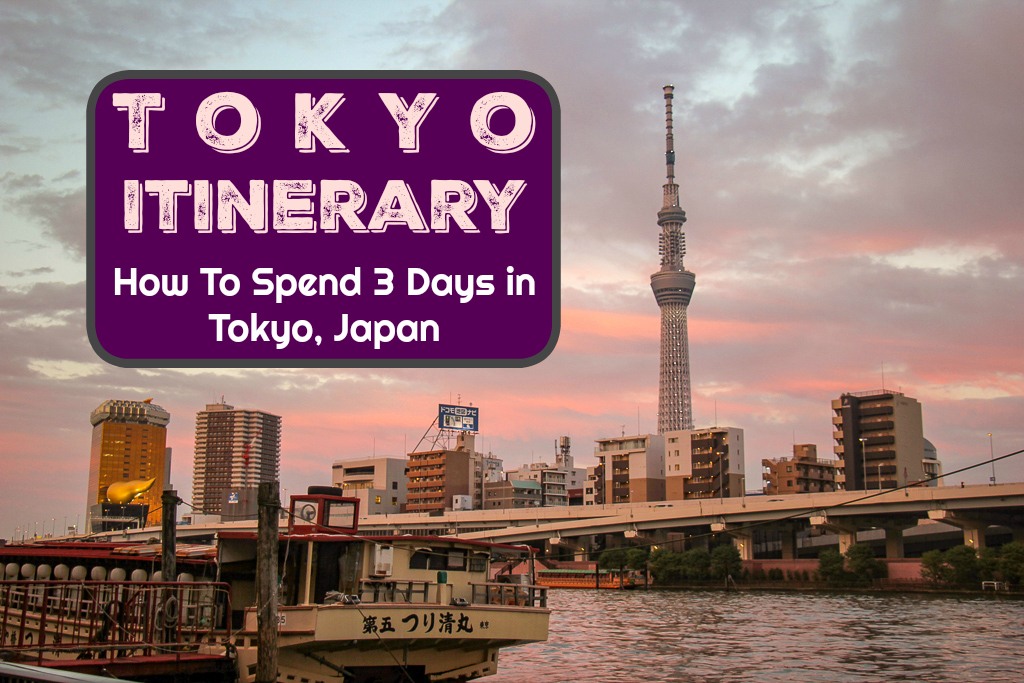
Tokyo Itinerary: How To Spend 3 Days in Tokyo, Japan
Welcome to JetSetting Fools, here you will find our best travel tips for destinations worldwide. Some of the links on this site are Affiliate Links and if you use them to make a purchase, we may earn a commission. For more information, read our Disclosure Policy .
Tokyo, Japan is a buzzing city unlike any other place we have visited. Dotted with famous Tokyo must-see sights – like Sensoji Temple and the Imperial Palace – hidden gems are found in the depths of the sprawling districts.
In the tangle of streets, we spent long days sightseeing in Tokyo, discovering a unique culture and tasting delicious cuisine. Our Tokyo Itinerary condenses our best experiences into 3 Days in Tokyo!
3-Day Tokyo Itinerary
Tokyo, Japan is densely packed with eateries, bars, people and culture. All of which may overwhelm a Tokyo first-time visitor.
It can be a daunting task trying to figure out what to see in Tokyo in 3 Days. However, a solid plan allows visitors just enough time to get acquainted with the city. Our Tokyo, Japan Itinerary focuses on the top experiences that you won’t want to miss!
Tokyo 3 Days Itinerary Tips

Before we dive into our list of things to do in Tokyo, Japan, we have a few initial tips about visiting the city.
Navigating Tokyo
Sights in our 3 Day Tokyo Itinerary are grouped by neighborhood and listed in order. Our Tokyo tour itinerary covers some ground and to get between sights we indicate our preferred method. We provide more information later about how to get around Tokyo.
Tokyo Maps and Details
To help make our Tokyo Itinerary simple, we have included information and/or links to each place. We also provide a pin drop for each sight in our Tokyo 3 Day Itinerary for easy navigation. At the end of our Tokyo travel itinerary, we include a map with all sights marked.
Having an internet connection is essential when sightseeing Tokyo! There are free Wi-Fi spots throughout the city, but it’s better to have your own. Plan accordingly – by either adjusting your phone plan prior to arrival, renting a mobile hotspot (also called Pocket Wi-Fi ) or purchasing an eSIM/SIM card.
3 Days in Tokyo Budget
Tokyo is a notoriously expensive destination. However, budget travelers will be happy to know there are several free things to do in Tokyo. Many of which are featured in our list of things to see in Tokyo in 3 days!
We have indicated if there is a fee to enter the sights on our Three Days in Tokyo Itinerary. Therefore, our Tokyo trip itinerary blog can be used by anyone traveling to the city – with some slight adjustments.
Tokyo Day Trips
There are many places to visit near Tokyo as well! Day trips out of Tokyo allow for further exploration. At the end of the article we share the top short trips from Tokyo – and ideas for weekend excursions, too!
Suggested Tokyo Itineraries
Below we provide a detailed outline of how to spend three perfect days in Tokyo. But what if you have more (or less) time? We can help with shorter and longer Tokyo trip planning, too! At the end of the post, we include Tokyo sample itineraries for 1 to 7 days.
Planning a longer trip to Japan? Use our 2-Week Japan Itinerary that includes seeing Mt. Fuji and Lake Kawaguchiko as well as spending 3 Days in Kyoto !
What To Do in Tokyo in 3 Days

Our Tokyo travel blog includes all the prime attractions. Top recommendations for food and drink are also provided to help make this the absolute best Tokyo Itinerary! That said, we share even more details in our articles: What To Eat in Tokyo and The Best Tokyo Bars .
Save, Bookmark or Pin this Tokyo Travel Guide to plan your trip to Japan!
Day 1 in Tokyo
On Day 1 of your Tokyo three-day itinerary, explore the Asakusa, Ueno and Sumida districts – starting (and ending) at the famous Sensoji Temple.
Sensoji Temple

The Sensoji Temple is the oldest and largest temple in the city – and visiting it is a Tokyo must-do! Founded 645, the key sights include the Kaminarimon Gate (Thunder Gate), the market on Nakamise dori, the temple itself, Sensoji Pagoda and the Asakusa Shrine.
Find more information about Sensoji and other must-see temples in our article, The Best Temples in Tokyo . Free | Subway | Map | Info
Asakusa Culture Tourist Information Center

In addition to free maps and information, the Asakusa Culture Tourist Information Center has a top-floor café with views of Sensoji Temple and SkyTree. The center is also a great place for Japanese culture for tourists.
They organize free Asakusa tours on weekends, free Geisha performances and a range of classes for visitors to learn more about the Japanese culture. We highly recommend the Geisha performance – as it was a highlight of our Tokyo trip! Free | Walk | Map | Info
Ameyoko Market

Located beneath the Yamanote Line tracks, the Ameyoko Market is one of the most popular open-air markets in Tokyo. Featuring more than 180 market stalls selling everything from fresh fish to fashionable clothing, Ameyoko Market is a feast for the senses!
Grab something to eat at the market for lunch. We recommend getting take-away menchi katsu croquettes from Niku no Oyama (Meat Dish and Beer). Subway | Map | Info
One of the oldest and most visited parks in Tokyo, Ueno was established in 1873. In addition to the numerous cherry trees (which attract many visitors during cherry blossom season), Ueno Park is also home to multiple museums. Free | Walk | Map | Info
Museums at Ueno Park

Among the open space and cherry tree-lined paths at Ueno Park, several of the city’s top museums are found. You could spend an entire day just visiting these museums, but with limited time in Tokyo, we recommend just going to one. We chose to visit the Tokyo Metropolitan Art Museum.
Tokyo Metropolitan Art Museum
Featuring a variety of artwork styles, the museum displays artwork from masters and budding artists. Free (some exhibitions cost) | Map | Info
Tokyo National Museum
Housing both permanent and rotating exhibits, the Tokyo National Museum displays art and antiquities from Japan and Asia. 1000 yen | Map | Info
National Museum of Nature and Science Tokyo
The National Museum of Nature and Science first opened in 1871. The exhibits focus on natural history and interactive science experiences. 630 yen | Map | Info
Established in 1882, the Ueno Zoo houses more than 3,000 animals – including giant pandas, gorillas and tigers. 600 yen | Map | Info
Tokyo SkyTree

The SkyTree Tower, which was built for broadcasting – features a rotating restaurant, observation deck and is a must-see in Tokyo, Japan. Other attractions near SkyTree include the Sumida Aquarium, Planetarium, Solamachi Shopping Center and the Postal Museum.
Visitors to SkyTree observation deck are treated to panoramic views of Tokyo. Tickets can be purchased in advance . Bus | Map | Info
Asahi Brewery Building
Tokyo’s iconic Asahi Brewery Building houses the company’s corporate headquarters (not the actual brewery). The building was designed to look like a tall glass of frothy beer and the Asahi Flame is meant to represent that same frothiness. However, many just refer to it as The Golden Poo!
The 22 nd Floor Asahi Sky Room bar offers patrons stellar views of the city. Drink Purchase | Walk | Map | Info
Azuma Bridge
Spanning the Sumida River, the Azuma Bridge dates to 1774, although the current structure was completed in 1931. The bridge and western riverside provide a great vantage point to see SkyTree and the Asahi Building. Free | Walk | Map | Info
DINNER: Sometaro Okonomiyaki

Okonomiyaki – or Japanese savory pancakes – are classic Japanese cuisine that every visitor should try. At Sometaro Okonomiyaki, guests sit on mats on the floor around a small teppan grill. After ordering from a range of standard and innovative options, the raw ingredients are brought to the table. Patrons then cook the okonomiyaki themselves – creating a unique and memorable experience! Walk | Map | Info
Hoppy Street, Tokyo

Running more than 250 feet along the west side of Sensoji Temple is Hoppy Street. Packed with small bars, the street is known for the “Hoppy” alcoholic mixer that most of the establishments sell. Tables and chairs spill out onto the street and a jovial atmosphere abounds. Whether stopping for a drink or just out for a stroll, Hoppy Street is entertaining, especially in the evening! Walk | Map | Info

For an after-dinner drink, stop by the historic Kamiya Bar. Dating to 1880, the classic beer hall is known for their ‘Electric Brandy’ drink, called Denki Bran. The cocktail is a secret concoction of brandy, gin, wine, curacao and herbs. Denki Bran is 400 yen; a liter of Asahi Beer is 1,450 yen | Walk | Map | Info
Sensoji Temple at Night

As stunning as Sensoji Temple is during daylight hours, it’s even more amazing at night. Although the temple and shopping street are closed, it is worth it to circle back around to see Sensoji, the pagoda and Thunder Gate lit up at night. Free | Walk | Map | Info
Day 2 in Tokyo
Today you’ll explore the sights in a few of Tokyo’s most iconic districts: Shibuya, Harajuku and Shinjuku.
Tokyo Metropolitan Government Building

Start Day 2 of your Tokyo, Japan travel itinerary at one of the tallest buildings in the city, the Tokyo Metropolitan Government Building. The soaring skyscraper houses the government offices for all 23 Wards of the city. The reason to include it on your itinerary for Tokyo, however, is that the building has two observation decks on the 45th floor – which are free!
There is no outdoor space, but the floor-to-ceiling windows provide sweeping views of the city. On clear days, it’s possible to see Mount Fuji! Free | Subway | Map | Info
Meiji Jingu Shrine

The Meiji Shrine is dedicated to Emperor Meiji and his wife, Empress Shoken and was built shortly after their deaths in 1912. Located in a city-center forest, visitors walk through the lush grounds to get to the shrine. Free | Walk or Subway | Map | Info
Yoyogi Park

One of the city’s most popular green spaces, Yoyogi Park features ponds and lush nature. It also has a historic past. Prior to becoming a park, the land was used as an airfield, army parade grounds, military barracks and the 1964 Olympic Village.
Today, the area is used by families and friends as a place to relax and enjoy nature. It’s especially crowded in the spring for the cherry blossoms and in the autumn when the leaves change colors. Free | Walk | Map | Info
Takeshita Dori

The pedestrian-only shopping street, Takeshita dori, is the epicenter of Japan’s Kawaii (“cute”) culture – and it ranks high on our list of Tokyo must-see sights!
Lined with boutique shops and candy stores, Takeshita dori is a haven for the city’s youth. Girls wear (and shop for) unique Kawaii fashion trends while ingesting rainbow-colored sweet treats. It can feel a little over-the-top, but strolling the length of the street is a great introduction to Kawaii.
Pop into Daiso, the Japanese dollar store, where most items are just 108 yen (which make great gifts and souvenirs!). We also highly recommend joining the masses and getting a sweet treat from Marion Crepes . Walk | Map | Info
Tokyo Plaza Omotesando

The Tokyo Plaza Omotesando mall provides a posh shopping experience with upscale boutique shops selling the latest trends. However, it isn’t just about the shopping. Many visitors go to the mall just to ride the escalators through the mirrored entrance, while others skip past all the shops and head straight for the Starbucks on the rooftop garden. Walk | Map | Info
Cat Street, Tokyo
Having absolutely nothing to do with cats, Cat Street is one of the trendiest streets in Tokyo for fashion and food. While Takeshita dori caters to the youth of Tokyo, Cat Street attracts a slightly older crowd. Featuring trendsetting international brands and local designers, the street runs a half-mile (but the side alleys shouldn’t be missed!).
There are numerous eateries along the route, but for a quick bite, we recommend Harajuku Gyozaro (a classic Tokyo snack!). Walk | Map | Info
Shibuya Center-Gai

Filled with fashion outlets, chain restaurants, bizarre shops and nightclubs, Shibuya Center-Gai boasts a lively atmosphere both day and night. Large signs, which are illuminated after dark, loom over the pedestrian paths that are packed with people.
A top destination is Shibuya 109, a mall with more than 100 boutique retailers. Visitors can easily be entertained for hours at Shibuya Center-Gai – whether shopping, eating, drinking or just people watching. Free | Walk | Map | Info
Shibuya Crossing

Also known as the “Shibuya Scramble,” Shibuya Crossing is one of the busiest intersections in the world. When all traffic lights change to red, hundreds (sometimes thousands) of pedestrians surge through the intersection. While joining the hordes on the journey from one corner to the other is an essential Tokyo experience, watching the spectacle from above is mesmerizing.
The best Shibuya viewpoint is from Mags Park, which is a rooftop space on top of MAGNET mall located on the northeast corner. Free | Walk | Map | Info
Hachiko Memorial Statue
Hachiko is Tokyo’s most-loved and loyal dog. He faithfully met his owner every day after work at Shibuya Station to accompany him on the walk home. His owner died suddenly at work, but for the next nine years, Hachiko waited at the station every evening for his return.
The story of Hachiko captured the hearts of the Japanese and has been made a legend in books and movies. His statue stands outside the station, just like he used to. Free | Walk | Map | Info
DINNER: Shinjuku Omoide Yokocho

The narrow alleys at Omoide Yokocho are densely packed with hole-in-the-wall Yakitori eateries. Smoke billows from grills while the scent of sizzling chicken and seafood fill the air. Some restaurants are so tiny that they can only accommodate six patrons.
Although the alleys are located just outside the Shinjuku Station, Omoide Yokocho (also known as Memory Lane or Piss Alley) is an intimate and fun Tokyo restaurant experience. Prices Vary | Subway | Map | Info
Kabukicho Nightlife

Known for its seedy entertainment, Kabukicho glows at night. The Tokyo red-light district is packed with more than 3,000 bars, hostess clubs, massage parlors and love hotels. Although the entertainment in ‘Sleepless Town’ is not for everyone, the lively area is a must-see at night.
Don’t miss the odd/interesting/creepy 40-foot-tall Godzilla Head that peeks over the top of the Toho building and lets out a screech every few minutes. Walk | Map | Info

There are nearly 200 bars in Golden Gai, all densely packing into six narrow alleys. Many of the bars can only accommodate a handful of patrons and most feature a specific theme. The close proximity of these establishments makes for a great night of Tokyo bar-hopping! Prices Vary | Walk | Map | Info
Day 3 in Tokyo
On day three of your Tokyo city tour itinerary, visit the fish market, discover the Odaiba district and then return to the center for more sightseeing.
Toyosu Fish Market (formerly Tsukiji Fish Market)

Relocated and reopened as the Toyosu Fish Market in October 2018, Tokyo’s fish market ranks as largest wholesale fish and seafood market in the world. Although an unseemly tourist destination, visitors can view the tuna auctions from a platform and feast on fresh seafood from the on-site restaurants. Market Prices Vary | Subway | Map | Info
Rainbow Bridge, Tokyo
The Rainbow Bridge straddles Tokyo Bay, connecting Minato to Odaiba. Despite the name, the Tokyo suspension bridge is white and is illuminated with solar lights (in red, green and white) at night. Visitors can walk across the 2,618-foot-long bridge on the pedestrian paths (free/limited hours) or take the metro. Map | Info
Odaiba Island
Odaiba is a man-made island in Tokyo Bay. The site serves as an entertainment district, featuring four shopping centers, as well as Sega World Joypolis , Madame Tussaud’s Wax Museum and Legoland Discovery Center . The area also has several museums, observations decks and restaurants. Subway | Map | Info
Odaiba Statue of Liberty

Standing on the Odaiba shore is a 40-foot-tall replica of NYC’s Lady Liberty. However, the Statue of Liberty in Japan has no connection to the United States, rather it represents Japan’s relationship with France. Free | Walk | Map | Info
Gundam Transformer
Fans of The Transformers will want to check out the 60-foot-tall Unicorn Gundam Transformer. Be sure to be there at the top of the hour when the Transformer moves! Free | Walk | Map | Info
Tokyo Station

A major transportation hub, Tokyo Station serves intercity trains and the city’s subway and buses. It is one of Tokyo’s busiest stations, with more than 415,000 passengers utilizing some 3,700 trains daily. Within the structure are numerous shops and restaurants. The original brick building dates to 1914, but only a portion still stands today (west side).
Tokyo Station is a great place to grab lunch! The location features everything from fine dining to grab-and-go options. Subway | Map | Info
Tokyo Imperial Palace

Protected by moats and imposing stone walls, the palace is home to Japan’s Imperial Family. The site is off-limits to visitors except on January 2 and December 23, but the plaza in front of the palace is open to the public.
The iconic Meganebashi Bridge (Eyeglass Bridge) is located near the entrance and is a popular Tokyo tourist photo-op. Free | Walk | Map | Info
Imperial Palace East Gardens

The Imperial Palace East Gardens are the previous site of the Edo Castle. All that remains is the base of the castle tower (which dates to 1638). A Japanese-style garden covers the grounds with many paths weaving through the park.
North of the garden are three large museums: The National Museum of Modern Art Crafts Gallery, the Science Museum and the National Museum of Modern Art Tokyo. Free | Walk | Map | Info
Hotel New Otani’s Garden

The 400-year-old garden at Hotel New Otani is a Tokyo hidden gem. The 10-acre park features red bridges, koi ponds, a waterfall and lush greenery. The beautiful park is open to the public. Free | Walk | Map | Info
Akasaka Palace State Guest House

Built in 1909 as the Crown Prince’s Palace, the Akasaka Palace now serves as a State Guest House, welcoming dignitaries from around the world. The Baroque palace and grounds can be visited when it is vacant. Main Garden admission is 300 yen; buildings and special gardens require separate tickets, starting at 1,500 yen | Walk | Map | Info

In Tokyo, many shrines and temples have become tourist attractions, but that is not the case at Hie Shrine. Located on a hill, visitors should look for the back entrance staircase, which is covered in a tunnel of bright red torii gates. Free | Walk | Map | Info
Tokyo Tower

Reminiscent of Paris’ Eiffel Tower, the Tokyo Tower stands at 1,092 feet. Ranking as the second-tallest structure in Japan, the tower is also a tourist attraction. In addition to the observation decks, there are museums, restaurants and shops at its base. Main Deck Adult Ticket 1200 yen; Top Deck Tour Adult Ticket 2,800 yen online and 3,000 in person | Subway | Map | Info
Zojoji Temple

The historic Zojoji Temple sits next to the Tokyo Tower. On the grounds is the Tokugawa Family mausoleum, where six of the Tokugawa shoguns are buried. Visitors can also walk through the Sentai Kosodate Jizo – or the Unborn Children Garden. Parents decorate their statues with clothing and toys. The main gate, Sangedatsumon Gate, is the oldest wooden building in Tokyo, dating to 1622. Free | Walk | Map | Info
Tokyo Midtown
Tokyo Midtown, a mixed-use space, was built in 2007 – and at the time, it ranked as the tallest building in Tokyo. Inside, visitors will find a mall and restaurants as well as the surrounding gardens at Hinokicho Park. Nearby attractions include the Roppongi Hills Mall, the Mori Art Museum, the Suntory Museum of Art and 21_21 Design Sight Gallery. Subway | Map | Info
DINNER: Ippudo Ramen
Proclaimed by many as the best ramen in Tokyo, Ippudo Ramen is dedicated to preparing high-quality ramen and innovative, seasonal specialties. Offering both counter and table seating, Ippudo Ramen has friendly staff and menus in English. Walk | Map | Info
Roppongi Nightlife

Roppongi is well-known as a Tokyo nightlife destination. Upscale restaurants and chic clubs abound in the district. One of the most famous clubs in Roppongi is V2 TOKYO, which occupies the top floor of the Roppongi Roa Building.
We prefer more low-key entertainment and craft beer. Our recommended spots in Roppongi to have a drink are Two Dogs Taproom, Tokyo Old Boys Brewing and BrewDog . Walk | Map | Info

Tokyo Sightseeing Map

Use this link to Google for an interactive Tokyo Map includes all the recommended sights for our 3-Day Tokyo Itinerary!
More Tokyo Exploration

We fit as much as we could into our 3-day Tokyo itinerary! Fellow travelers staying longer may want to add these attractions and sights to see in Tokyo into their trip plan.
Akihabara District
Nicknamed ‘Electric Town,’ the Akihabara District is known for its electronic shops, computer goods, video games, anime and manga. For gamers, it is a must-see Tokyo district; some of the top arcades to check out are Taito HEY, Super Potato, Club Sega and Game Bar-A-Button. The district also has an abundance of Maid Cafes and a 7-story sex shop, M’s.
Ginza District
Famous for its upscale retailers and dining establishments, the Ginza District is one of the places to visit in Tokyo for shopping. The area was once the site of the city’s silver mint (which is what Ginza translates to in English). Luxury retailers – like Cartier, Chanel and Bulgari – are located in Ginza, along with other high-end flagship stores.
Yokohama City and Chinatown
Just a half-hour train ride from Tokyo is Yokohama, the second-largest city in Japan. Many include visiting Yokohama on their Tokyo trip planner. Not to miss is Chinatown, which has a 150-year history and colorful streets. Another top attraction is The Cup Noodles Museum that traces the history of instant ramen with interactive displays.
Tokyo Karaoke
Karaoke is one of the top things to do in Tokyo, Japan! A mashup of the words kara (empty) and okesutora (orchestra), karaoke was created in Japan in the 1970s and is still very popular today. Tokyo visitors can belt out tunes at bars or in private rooms around the city. We highly recommend participating in the essential Japanese entertainment during your visit!
Pachinko Parlors
Pachinko is Japan’s version of a slot machine – and it’s wildly popular. Visiting a pachinko parlor can result in sensory overload – they are bright and obnoxiously loud. Although the game is a little confusing, it can be fun to try your luck on your Tokyo, Japan trip!
Tokyo Tours and Activities

It it fits into your timeline and daily budget for Tokyo, consider enhancing your experience by joining one of these popular tours or activities.
Tokyo Highlights Tour by Bus
Visit the city’s best in an all in one-day-in-Tokyo tour. See shrines and temples (including Meiji Shrine and Sensoji Temple), government buildings (including House of Parliament and Imperial Palace East Garden) and go shopping in the Ginza district. End your day on a 1-hour cruise in Tokyo Bay then take in the sights in Odaiba. Find out more!
Tokyo Landmarks and Culture Tour
Designed as a Tokyo 1-Day Itinerary Tour, this excursion is packed with top sights. Start the day by soaring to the observation deck of the Tokyo Tower, then participate in a traditional tea ceremony. Continue with the tour group to the Imperial Palace Plaza and learn the history of the emperor’s residence. Next, take a cruise on the Sumida River and make a final stop at the Sensoji Temple. Get the details!
Tokyo Geisha Cultural Experience
Spending time with a Geisha is a fantastic activity to add to your Tokyo travel plan. Spend 1.5 hours in the company of a geisha as you learn about the fascinating Japanese culture. While you enjoy refreshments, the geisha will perform songs, dances and play games. Book it!
Watch a Sumo Wrestling Practice
Most travelers don’t think of wrestling practice as a place to visit in Tokyo, Japan – but it is on this short tour! Learn about the Sumo wresting tradition while you observe morning practice. Spend two hours with your guide and wrestlers at this up-close experience. Find out more!
Go-Kart Street Tour
Get dressed up as your favorite character and then jump behind the wheel of a Go-Kart to explore Tokyo’s city streets. A guide will lead the way to iconic landmarks and top places to visit in Tokyo on this fun-filled adventure. Get the details!
Tokyo in a Day Private Tour
To ensure you tick off your list of Tokyo must see sights, hire a guide that will design a tour specifically to your interests.
Spend either 4 or 8-hours with a professional guide on a tour that features your top places to visit in Tokyo, Japan. Let your guide know exactly what you want to see and let them custom plan a perfect Tokyo sightseeing day for you. Book it now!
Day Trips From Tokyo

There are numerous Tokyo day trips for visitors who are interested in seeing more of Japan on a one-day tour. Both private and group side trips from Tokyo venture to nearby cities and nature parks.
Tokyo to Hakone Day Trip (Mt. Fuji)
Ranked as one of the best day trips from Tokyo, the Mt. Fuji and Lake Ashi by Bullet Train trip is a must for visitors who want to escape the city. On the full day Tokyo tour, guests travel to Hokone National Park where they will see Mt. Fuji, take a boat cruise on Lake Ashi and ride the Mt. Komagatake Ropeway for stellar views. Learn more!
Nikko National Park Day Trip from Tokyo
Visit the UNESCO World Heritage Toshogu Shrine and Kegon Waterfall at Nikko National Park on a one-day trip from Tokyo. Get the details!
Kyoto Day Trip from Tokyo
This Kyoto Day Tour includes roundtrip tickets between Tokyo and Kyoto, a professional guide, a Kyoto sightseeing route and provided lunch at an upscale hotel. The tour of Kyoto includes top attractions, like Heian Shrine, Kiyomizu-dera Temple and the Thousand-Armed Kannon at Sanjusangen Hall. Book this trip!
Kamakura and Tokyo Bay Day Trip
Visit historic temples, shrines and gardens in Kamakura on a one-day trip from Tokyo. Highlights include visiting a bamboo grove, seeing the famous Great Buddha, enjoying matcha green tea and eating a Japanese-style lunch on Enoshima Island. Find out more!
How Many Days in Tokyo

Before you think about how to plan a trip to Tokyo, you need to think about your interests, how fast you want to sightsee and your overall budget.
The list of what to see in Tokyo, Japan is endless. Our itinerary of things to do in Tokyo in 3 days is jam-packed with the top sights and neighborhoods. That said, we would have no problem spending a week in Tokyo.
Pro Tip: Consider using our Travel Planning Printables to get your vacation to Japan organized!

Planning a Tokyo Trip: 1-7 Days
Planning a trip to Tokyo, Japan can be overwhelming! We encourage other travelers to create their best Tokyo itinerary by using our list of things to see as a guideline. To help those with more (or less) time, we have created several sample itineraries for Tokyo, Japan.
Half Day in Tokyo
If you want to create a Tokyo half-day itinerary, we recommend picking just one or two sights that are close together. For example, you could pair Sensoji Temple and SkyTree, or the Imperial Palace and Gardens, or Shibuya Center-Gai and Shibuya Crossing. Alternatively, you could book a half-day Tokyo tour with a private guide .
One Day in Tokyo
Trying to see Tokyo in a day is tough. But, if 1 day in Tokyo is all you have then make the most of it! If you like to explore on your own, we suggest using just one-day from our above Tokyo 3-day tour. If the prospect of figuring out the details is too tasking, we recommend hiring a guide or joining a group for your Tokyo one-day trip.
Tokyo Itinerary 2 Days
With 2 Days in Tokyo, visitors can experience quite a bit of the city! We recommend following our detailed outline for any of the two days as outlined in our Tokyo 3-Day trip. Those interested in adding a cultural experience, could squeeze a Geisha experience or Sumo wrestling practice into their Tokyo two-day itinerary, too.
4 Day Tokyo Itinerary
To create a 4 days in Tokyo itinerary, use our outlined 3-day Tokyo itinerary as a base. Then spend the last day exploring one of the cool districts that we couldn’t fit in. We think a perfect Tokyo 4 days itinerary would be to spend the last day in Akihabara. Peruse electronic stores, play video games and try your luck at pachinko!
Tokyo Itinerary 5 Days
With 5 days in Tokyo visitors have enough time to explore the city and take a 1-day trip from Tokyo (or participate in a cultural tour). We recommend following the above outline of four days in Tokyo and then choose one of the day trips listed above – like Mt Fuji . Alternatively, stay in the city and participate in a Geisha experience.
6 Day Tokyo Itinerary
With 6 days in Tokyo, we recommend following our above advice on what to do in Tokyo in 5 days and then immerse yourself in the Japanese culture on day 6. To create a one-day tour in Tokyo that focuses solely on culture; join a food tour , visit obscure temples , dress in a kimono or learn to be a Samurai Warrior .
Tokyo Itinerary 7 Days
Planning a Tokyo 1-week itinerary allows visitors ample opportunity to explore and really get acquainted with the city! With 7 days in Tokyo we recommend following our outline above for 6 days then either go on a shopping spree in Ginza or revisit your favorite neighborhood.
Don’t forget to check out our complete 14 Day Japan Itinerary !

How To Get to Tokyo, Japan

Tokyo can be reached by plane, train, bus or car. There are two international Tokyo airports: Haneda Airport (HND) and Narita Airport (NRT). Haneda is much closer to the city, but both airports are well-connected to Tokyo with public transport.
We always start our search with Skyscanner to find the best flight deals .
Trains and buses arriving at Tokyo terminate in various stations around the city. Before choosing a train or bus route, determine how well the arrival station is connected to your Tokyo accommodations.
Getting Around Tokyo

Tokyo is well-connected by a network of trains, subways and buses. They are managed by multiple companies, but fares can be paid using a pre-paid IC card. Visitors can buy Suica and Pasmo pre-paid IC cards in Tokyo stations.
Tokyo Visitor Transportation Passes
Multiday passes that are valid for unlimited transport on limited networks are also available for purchase. The downside is that none of the multiday cards cover all modes of transport.
For example, visitors can buy a Tokyo 3-Day Pass for the subway, which is valid for unlimited use on all Toei and Tokyo Metro subway lines, but it won’t be valid on JR trains. The 3-day Tokyo pass can save money, but only if subways are going to be your sole mode of transport.
Where To Stay in Tokyo, Japan
We were International Housesitters during our first visit to Tokyo, however there are numerous options for Tokyo accommodations. Apartments, hotels, hostels and capsule hotels are available in a range of prices. We have since stayed in multiple Tokyo hotels in various locations around the city.
Tokyo Hotels
Although we usually prefer staying in Airbnb apartments, we opted for basic accommodations in Tokyo, rather than splurging on luxury stays, like the Keio Plaza Hotel . It is important to note that in most hotels in Tokyo the rooms are small and compact. It is not uncommon to have shared bathrooms, so double check and read our Top Hotel Tips before booking!
Asakusa Hotel
In Asakusa, we stayed in Hotel MyStays . Located near the sights, but tucked into a neighborhood, the rooms are small but well-equipped, including a small fridge and hotplate. Robes and umbrellas are provided for guest use – and there is a selection of toiletries available in the lobby.
Roppongi Hotel
During our time in Roppongi, we booked the Sotetsu Fresa Inn . The hotel is located just steps from the Roppongi Station and is convenient for sightseeing the area on foot. The rooms and bathrooms are also spacious. Amenities include slippers, robes and an assortment of toiletries. For a fee, a breakfast buffet is available in the adjoining ground floor restaurant.
Narita Airport Hotel
Due to an early flight, we spent our last night in Tokyo near the Narita Airport at the APA Hotel Keisei Narita Ekaime . We chose the APA Hotel because it was located right outside the Keisei Narita Train Station and provided a free shuttle to the airport. The tiny rooms are equipped with an electric kettle, fridge, slippers and toiletries.
Tokyo Itinerary Packing Tips

We have outlined what to do in Tokyo for 3 days, but still have some advice about what to pack ! You can also review our complete list plus read about our other packing hacks before your trip.
Walking Shoes for Tokyo
Our 3-Day Tokyo Itinerary includes a lot of walking! Don’t forget to pack a pair of lightweight and comfortable shoes for your trip. I (Sarah) have traveled with these shoes by Columbia . Kris prefers wearing these by Merrell . Find more in our reviews on The Best Travel Shoes .
Travel Camera
Tokyo is a city that begs to be photographed! If you are anything like us, you will be snapping tons of photos during your trip to Japan. Rather than relying on your phone to capture the sights, upgrade to an actual camera for high quality photos. We shoot with a Canon Rebel and a 18-135mm lens that is perfect for cityscapes and an all around excellent budget travel camera .
Travel Insurance
Trip insurance may reimburse for expenses related to illness , cancelled flights or lost luggage . If you haven’t already obtained coverage for your trip to Japan, consider traveling protected with World Nomads .
Start planning your trip to Japan ! Search for the lowest airfares , the best accommodations and fun things to do …then start packing ! Want more travel advice? Head over to our Travel Planning Page for tips on traveling – and for country-specific information, take a look at our Travel Guides Page !

Pin it! See all of our travel pins on our JetSetting Fools Pinterest Board .
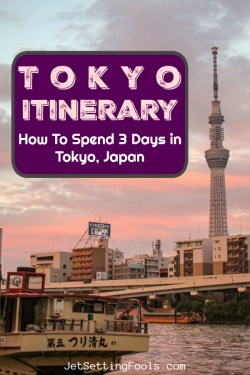
Share This Story!
- Click to share on Pinterest (Opens in new window)
- Click to share on Facebook (Opens in new window)
- Click to share on Twitter (Opens in new window)
- Click to share on LinkedIn (Opens in new window)
Leave a Reply Cancel reply
Your email address will not be published. Required fields are marked *
3 day Tokyo itinerary
Planning a trip to Tokyo? This detailed itinerary has everything you need to make the most of Japan’s biggest city!
Written by Michael Turtle
Michael Turtle is the founder of Time Travel Turtle. A journalist for more than 20 years, he's been travelling the world since 2011.
Michael Turtle is the founder of Time Travel Turtle and has been travelling full time for a decade.
Updated: August 21, 2023
Each part of the three day Tokyo itinerary
Jump down to a particular day - or keep reading for my complete itinerary for three days in Tokyo.
• Day 1: Morning • Day 1: Afternoon • Day 2: Morning • Day 2: Afternoon • Day 3: Morning • Day 3: Afternoon • Bonus things to do • Nightlife
Bold and modern. Refined and traditional. When it comes to Tokyo, you’ll find that contrasting descriptions are often just as accurate as each other.
Japan’s capital is one of the most exciting cities in the world and there are many layers to Tokyo. At first, it may seem hard to know how to spend three days in Tokyo!
From the religious to the imperial, and the crazy to the weird. There are temples, parks, high-rise buildings, colourful streets, world-class museums, and plenty more!
Combine that with a fascinating everyday culture, great food, vibrant nightlife – and you’ve got a city that will not disappoint.
There’s no shortage of things to do in Tokyo and, in fact, the real difficulty on a trip to Tokyo is deciding how to make the most of your limited time. With so many things to do, it can all seem a bit overwhelming – particularly if it’s your first time in Tokyo.
An option that might work really well if you’re travelling in a small group is to do a full-day private tour to see some highlights and get an insight into the local culture.
I’ve been here many times and have been able to explore different parts of the city and discover some of the best things to do in Tokyo. I thought it might be useful if I shared what I’ve learned in a way that you can use to plan a trip to Tokyo.
What I’ve done is put together this 3 day Tokyo itinerary because that seems to be the most common length of stay.
Of course, if you’re doing more than 3 days in Tokyo then you can just use all my suggestions and go a bit slower. Or, if you’re spending less than 3 days in Tokyo, you can just choose the suggestions that most appeal to you.
Is 3 days in Tokyo enough? Well, that’s for you to decide – but, as you’ll see, you can pack a lot into a 3 day trip!
At the end of the detailed 3 day itinerary, I’ll have some more suggestions for things to do that you could swap for any of my specific recommendations, so you can personalise your trip to your interests.
Map for 3 day Tokyo itinerary
I’ve put all my recommendations for this Tokyo itinerary in a map, so you can get a sense of how everything fits together:
If you’re using your smartphone, just click on the icon in the top right to open the map in your Google Maps app. Then, as you walk around, you can keep track of where things are.
Public transport in Tokyo
I have tried to limit the amount of travel you’ll need to do – but there will still be quite a few times where it might make sense to use public transport to move around.
My top tip for travel in Tokyo is to buy a Tokyo Subway ticket for 24, 48 or 72 hours. They are quite cheap and if you’re using public transport more than a few times each day, you’ll save a lot of money.
It also makes it much easier because you don’t have to use the confusing ticket machines each time. And the passes cover both the Tokyo Metro and Toei Subway lines, meaning you don’t have to worry about which company’s lines you want to take.
You can find out all the information about a Tokyo Subway ticket here .
I’ll mention the relevant Metro or Subway stops as we go through the itinerary.
For the first morning, let’s start in a part of Tokyo called Chiyoda. It’s not the geographic centre of the city, but it is considered to be the political centre of Tokyo because it’s where the most important national institutions are.
Yasukuni Shrine
The first stop is the Yasukuni Shrine (use Ichigaya or Kudanshita station) . This Shinto shrine was founded by the emperor in 1869 to commemorate Japan’s war dead.
It’s a beautiful shrine set in a lovely 600 metre long park that has different monuments along the approach and two large torii gates.
Although it’s a very pleasant location and a popular tourist attraction, Yasukuni Shrine is controversial because among the 2.5 million people who are honoured here are 1068 who have been convicted of war crimes.
Yushukan Museum
Next to the Yasukuni Shrine is a related museum called the Yushukan . The museum tells the story of Japan’s military and war history and is worth a visit.
There are lots of exhibits to see and it does a good job of telling the stories of different periods in Japan’s history. However, you’ll notice quite quickly that there is an obvious bias here towards Japan’s version of events.
If you know your modern history, you’ll be able to see when something is unbalanced – and seeing how things are presented from the Japanese perspective is quite interesting. However, if you’re hoping to learn an objective world history here, you’re in the wrong place!
Kitanomaru Park
From Yasukuni Shrine, walk down through the park and under the magnificent tori gates until you can cross the road and go into Kitanomaru Park.
The impressive entrance gates make sense when you find out that the park used to be part of Edo Castle, the castle that was built in 1457 as the most important part of Edo (the former name of Tokyo).
As you wander through, you’ll go past the Budokan , a martial arts sports arena that is also used for concerts these days.
Further along is the Science Museum , the National Museum of Modern Art Crafts , and the National Museum of Modern Ar t .
I wouldn’t really recommend the science or craft museum for the average tourist. The only museum that is probably worth seeing is the one with modern art.
However, if you only have three days in Tokyo, you’re going to be quite busy and it’s probably better to skip it.
East Gardens of the Imperial Palace
The Imperial Palace of Japan is now located in the centre of the site that was once Edo Castle. It’s an enormous piece of land (and during the property bubble in the 1980s was said to be worth more than the entire real estate market of California).
This is the primary residence of Japan’s Imperial Family and so it’s probably no surprise that it’s not all open to the public. However, you can go into a significant portion of the site, known as the East Gardens of the Imperial Palace.
It’s a lovely area with traditional buildings, ponds, landscaped gardens, and small forests. I would suggest entering from the northern Hirakawa Gate and then leaving from the eastern Otemon Gate.
By now, you’re probably getting hungry. I’m not going to make any specific recommendations for food because there are so many possibilities. But I would suggest walking over to the Nihonbashi area for the best selection.
For the afternoon, let’s head to the Asakusa part of Tokyo. This was an entertainment district of the city between the 17 th and 20 th centuries but it’s now more about the history than the nightlife. Catch the Metro to Asakusa station and start from there.
Senso-ji Temple
As you approach Senso-ji Temple, you’ll need to walk through the 1000-year-old (but restored) Kaminarimon Gate and then down a long avenue of stalls known as the Nakamise Shopping Street. There’s a decent selection of local snacks here and you’ll also find some nice (but not cheap) souvenirs.
The main temple is at the end of the street, where you’ll also find another impressive gate called the Hozo-mon and a five-story pagoda.
Senso-ji is one of Tokyo’s most important temples and, having being founded in 645, it is officially the city’s oldest. There’s always a lot of action happening around it but there are also opportunities for some quiet reflection.
Asakusa Shrine
Next to Senso-ji Temple is a smaller Shinto site called Asakusa Shrine.
It was founded in 1649 and was built to honour the three men who founded the Senso-ji Temple. It’s a good example of the complicated relationship between the Buddhist and Shinto religions in Japan, which are peacefully intertwined.
The Asakusa Shrine is not nearly as impressive a building as its neighbour but it’s still worth having a look.
From here, it’s also just a short walk of about 5 minutes to the Sumida River, where you’ll get a quite nice view of the water and the Tokyo Skytree on the other side.
If you would like to have a local show you around some of these historic sites and tell you the stories behind them, there are some good tours. I would recommend one of these:
Hanayashiki Amusement Park
On the other side of Senso-ji is Hanayashiki Amusement Park. Don’t expect Tokyo Disneyland or anything on that scale. This is a small boutique amusement park.
Hanayashiki is the oldest amusement park in Japan and was first opened in 1853 as a flower park that gradually had other attractions added to it.
The rides are all packed close together and there’s nothing too dramatic. In fact, most of the attractions seem quite old compared to modern expectations so don’t expect huge thrills.
You have to pay to go in and then you also pay for each ride. I wouldn’t suggest it’s worth the cost unless you have young children. But, having said that, you can have a quick look from the outside and maybe you’ll be in the mood for a bit of an unusual experience!
Next, let’s head over to Ueno Park (use Ueno station) , which is just to the west of Asakusa. It was one of the first public parks in Japan and was opened in 1873.
The park itself is quite pretty (especially with cherry blossoms in spring) and you can easily see some of the small attractions like the Tosho-gu Shrine. But the main reason I’m recommending it is because of the important museums that are here.
In Ueno Park, you’ll find the Tokyo National Museum, the National Science Museum, and the Tokyo Metropolitan Art Museum. They are all very good and you could visit any of them, if you’re interested.
However, if you only have 3 days in Tokyo, you’re going to be short of time so I would recommend just visiting one museum in Ueno Park – the National Museum of Western Art.
National Museum of Western Art
The National Museum of Western Art is worth visiting for two main reasons.
The first is the collection. There’s an impressive collection of art from the Renaissance period through to the 20 th century. Works from some of the world’s most important artists are here – including Picasso, Monet, Van Gogh, Rodin, and Pollock.
But the more important reason to visit the National Museum of Western Art is for the building itself. The architecture is quite amazing and is internationally-acclaimed.
The museum was designed by the Swiss architect Le Corbusier and it was added to the World Heritage List in 2016, alongside some of his other buildings in six other countries.
From Ueno Park, I suggest you head to the Akihabara area. It’s just a 15 minute walk or you can catch the Metro to Akihabara station.
When you think of the quirky side of Japan, you’ve probably got something like Akihabara in your mind’s eye. This is the centre of the die-hard fans of things like manga and anime and many of the shops here are aimed directly at them.
I think it’s great fun to wander the streets and look into these shops. You’ll find all sorts of fascinating things related to Japanese pop culture for sale.
It’s also been taken a step further and this is the area where you’ll find some of the strange venues like maid cafes, owl cafes, and other places with anime characters.
Akihabara is also famous for electronics stores and it’s interesting to look through the shops to see the new technology that’s on sale. If you’re interested in picking up any electronic goods, this is a good place to look.
There are also some quirky tour experiences you can have here. You might be interested in one of these:
And that’s the end of the first day of my suggestions on how to spend 3 days in Tokyo. Later on, I’ll give you some options about what to do in the evenings because I’m assuming not everyone is interested in the same kind of activities.
For the first day of my suggested 3 day Tokyo itinerary, we looked the eastern side of central Tokyo. Today we’re going to explore some things on the western side.
Kyu Asakura House
When you think of Tokyo, you tend to think of the busy modern areas or the popular historic sites. But there is a quieter traditional side to Tokyo too, if you know where to look.
It’s why I’m suggesting the Kyu Asakura House as the first stop this morning (use Ebisu or Naka-Meguro station) .
The house was built for a politician called Torajiro Asakura in 1919 so it’s grander than your average family home and is a wonderful example of traditional Japanese design and architecture. The main building is made from wood with screen doors, tatami mat floors, and the usual minimalistic design.
There’s also a large garden that has been carefully manicured that takes 10 minutes or so to explore. It’s a nice way to see a bit of quiet heritage in this bustling metropolis.
It’s worth noting that the area around the Kyu Asakura House, called Daikanyama, is very posh these days so if you’re interested in looking at high-end boutiques or fancy cafes, you might like to explore the streets a bit.
Shibuya crossing
Next, head to near Shibuya, which is just a 20 minute walk or catch the Metro from Ebisu station.
Shibuya is one of Tokyo’s most hectic neighbourhoods and, for tourists, it’s become particularly famous for the world’s busiest pedestrian crossing, which is outside the main train station.
It is quite interesting to do some people-watching at the intersection and you might like to get a coffee from the Starbucks there so you can get a window seat and look down on all the action (although getting a good seat can be difficult).
Shibuya doesn’t have a lot of specific things to see for tourists but there’s plenty here to keep you entertained. Just walk the streets and experience all the action.
It’s famous for its shopping – particularly with younger trendy fashion – so it’s a good place to check out the stores.
When you’re done, catch the Metro to Omotesando station (or it’s a 20 minute walk). This puts you in the centre of Tokyo’s most important fashion district.
Even if you’re not interested in shopping, seeing the stores and (more interestingly, I think) the people is a fascinating view into contemporary Tokyo. The styles here are really interesting and some are pretty crazy!
Walking along the main Omotesando avenue will take you past the big name fashion brands and it’s easy to see why it’s been dubbed the Japanese Champs-Elysees. I would suggest going to the top floor of the Louis Vuitton store to see their special (and free) art gallery.
As you head to the west, you’ll come into the famous area called Harajuku . Get off the main avenue and explore the side streets, which have all the coolest youth fashions and trends. There are some great little cafes and restaurants here too and I would suggest it’s a good place to get lunch (unless you want to eat in the park, as I’ll mention next).
If you’re interested in getting a local’s perspective of Omotesando and Harajuku, there are some interesting tour options here:
From Harajuku you can walk to Yoyogi Park (or, if you’ve changed the itinerary slightly, catch the Metro to Yoyogi-Koen station).
Yoyogi Park
Yoyogi Park is one of Tokyo’s most interesting parks but not because of the landscaping – because of the people. For a long time it’s been a place for performers, for cosplay, for musicians, and other hobbies involving fashion and arts.
These days, you see less of the costumed people than you might have a decade ago, but there’s still a fair amount of action – particularly on weekends.
You may like to pick up some takeaway lunch from somewhere – a bento box from a convenience store, for instance – and eat it in the park while you watch the action.
Meiji Shrine
Within the same gardened area as Yoyogi Park is one of the most important landmarks in Tokyo – the Meiji Shrine . (Although you can’t access it directly from Yoyogi Park and you’ll need to come in the entrance on the eastern side.)
This Shinto shrine was opened in 1920 and dedicated to Emperor Meiji (who had died eight years earlier) and his wife. He was one of the most important Japanese emperors in history and is credited with bringing Japan into the modern era and opening it up to the world.
There’s a long leafy approach to the Meiji Shrine (also called the Meiji Jingu Shrine), which is set in a quiet forest. You can pay an entrance fee to walk through the large inner garden here, but I don’t think it’s necessary. The main hall of the shrine and the associated museum in the treasure house are interesting enough on their own.
Tokyo Metropolitan Government Building
There are quite a few locations throughout Tokyo where you can get incredible views of the city and I’m going to mention a couple of them in this itinerary.
The first is the Tokyo Metropolitan Government Building, which is where I recommend you head next. If you head out the northern entrance of Meiji Shrine, it’s about a 20 minute walk or you can catch the Subway from Yoyogi station to Tocho-Mae station.
The Tokyo Metropolitan Government Building has two observation decks (one in each of its towers) and they’re both 202 metres high. You get great views of Tokyo and, if the weather is good, you can even see Mount Fuji!
One of the observation decks is open in the evening and I’ll tell you a bit more about that in the nightlife section later on. But the other most important thing you need to know now is that it is free to go up to the viewpoints!
Now you will have ended up in Shinjuku, one of the most vibrant neighbourhoods of Tokyo. You’re not going to find yourself short of things to do here!
Shinjuku is jam-packed full of restaurants, bars, shopping, and entertainment. Like Shibuya, there aren’t many sights in the traditional tourist sense. This is somewhere to be explored, rather than visited.
I would suggest just taking some time to walk the streets and soak up the hectic Tokyo lifestyle. You may want to pop into a video game arcade, do some shopping at a department store, or just do some people-watching.
If it’s approaching evening time, Shinjuku is the ultimate nightlife area so you’re in the right spot for dinner and drinks – and a bunch of other fun activities that I’ll cover later on.
Now, for the final day of my suggestions for how to spend 3 days in Tokyo, we’re going to start at the southern side of central Tokyo, with a mix of historic and modern.
Toyosu Fish Market
There was a time when I would have said an early morning trip to the fish market was a must-do in Tokyo. But things have changed a bit since then.
In October 2018, the fish market moved from the chaotic but colourful Tsukiji Market to the modern but sterile Toyosu Market (use Toyosu station) . It means the experience of visiting the fish market in the morning is not quite as exciting as it once would have been – but it’s still worth doing.
The highlight of a visit for many people is the early morning tuna auction and you can see this from behind a glass window between 5:30 and 6:30. But if you don’t want to get up early, there are other things to see.
There’s plenty of action at Toyosu Market but it’s worth getting there sometime before 8:00 to see the best of it. You’ll be kept a bit further away from the stalls than at Tsukiji, where you could walk amongst the vendors, but it’s still interesting.
If you crave some nostalgia, you could still head to Tsukiji Fish Market (use Tsukiji station) where all the outer stalls and restaurants still exist. You’ll see quite a lot going on and it’s a great place to get a fresh sushi breakfast from fish that has come straight off the boat.
A fun way to explore is with this excellent tour of the fish market , or have a look at these other options:
Hamarikyu Gardens
The beautiful Hamarikyu Gardens is one of the most beautiful parks in Tokyo (use Shiodome station) . This large landscaped area is on a site that used to be a feudal lord’s villa and hunting grounds, and is where the Sumida River meets Tokyo Bay.
As well as the beautiful garden layout, there are specific things to see here like flower gardens, shrines, and viewpoints. There are teahouses where you can rest and there’s a water bus station if you wanted to go on a boat trip.
There’s a small entrance fee to get in but I think it’s worth it. Each season has its own colours but it’s particularly beautiful in spring and autumn.
After the gardens, I would suggest catching the Metro to Yurakucho station (or any of the Ginza ones). This brings you into the heart of Ginza, the most upscale district of Tokyo.
You may have had enough of shopping (or window shopping) but, if not, this is where you’ll find some of the best boutiques and department stores. I love the shops that specialise in just one thing – chopsticks, chocolate, pens – you name it, you might find it here.
Ginza also has high-end cafes and restaurants with specialist sweets and dishes, so it’s a good place for a rest.
I’ve also suggested you come here because there are quite a few interesting things in the area to explore beyond just the streets – which are lively enough to catch your attention.
You can head into Hibiya Park which is always full of interesting activities like concerts, street performers, art, and flowers shows.
You could have a look if there’s an exhibition that takes your fancy at the Mitsubishi Ichigokan Museum – and a new art gallery called Artizon Museum will be opening soon. You could pop into the Kabukiza Theatre for a a traditional Kabuki performance, or visit the National Film Centre .
Tokyo International Forum
One thing I would recommend doing in Ginza is visiting the Tokyo International Forum. It’s a large exhibition centre that most likely won’t have anything you’re interested in (it’s used for conventions and trade shows).
But I think you will love the architecture and so it’s worth going in to have a look at that alone!
It was built in 1996 but still looks modern and cutting edge. It was designed by the same architect who did the Walkie-Talkie building in London (Rafael Viñoly) and has curved steel and glass, looking like a boat.
It’s always free to go in and walk through the main section, so don’t worry if there’s something going on inside.
Tokyo station Ramen Street
And this brings you to the main Tokyo station, which is so enormous that the underground passageways feel like they’re taking you across the whole city.
One of the popular parts of Tokyo station is the Ramen Street, where there’s a collection of good ramen restaurants in a little underground alleyway. You would definitely be able to find better ones across the city if you knew where to look but there’s something fun about this experience.
It’s a good place for lunch today so choose your favourite, buy a ticket for your meal from the machine at the entrance, and wait in the queue for a spare seat.
For this final afternoon of my itinerary for 3 days in Tokyo, I’m going to do something a bit different and not give you any specific recommendations. Instead, I would suggest that you use the time to focus on anything you may be particularly interested that I haven’t mentioned.
You may have realised by now that the days I have already outlined are quite busy so perhaps there are some things you have skipped because you’ve run out of time that you can do this afternoon.
Or perhaps you would like to go back to some of the neighbourhoods I have introduced you to so you can do some shopping, hang out at the cafes, or go to another museum.
Another great idea is to have an ‘experience’ in Tokyo, rather than just see the sights or explore the neighbourhoods. There are lots of really cool things you ca do with locals – I would recommend one of these:
You may also be looking for some more things to do. Well, in that case, you’re in luck. I have a lot more suggestions for things to do in Tokyo that I haven’t put into the itinerary because they were a bit out of the way geographically or I didn’t think they were of general interest enough.
Bonus things to do
Let me now give you a whole bunch more suggestions for things to do that you can fit into your 3 days in Tokyo. Some of these may seem a bit strange – but that’s the point.
Tokyo may be full of tradition but it’s also one of the quirkiest places in the world and you’ll want to experience a little bit of that as well to get a true impression of the city.
Yayoi Kusama Museum
The Yayoi Kusama is relatively new, having opened at the end of 2017, and is one of the city’s most popular museums. It exhibits the works of the Japanese artist Yayoi Kusama who has made a name for herself internationally with her unique polka dot designs.
It’s an incredible museum and is quite conveniently located in Shinjuku. I would have included it in the itinerary except that you can only visit by booking tickets well in advance for a specific 90 minute slot, so it can be hard to get in.
teamLab Planets
Another of Tokyo’s new and popular art museums is run by teamLab. The Mori Building Digital Art Museum closed in 2022 and will reopen in a new space in 2023.
In the meantime, there’s teamLab Planets, a massive museum with four large exhibition spaces and two gardens. With incredible light shows, projections, mirrors, and other special effects, it’s an immersive experience.
The idea is that, as you explore the physical space, the art that is being projected changes. Every person’s experience will be slightly different and every time you visit it will also be a new discovery.
Tickets are a bit easier to get than the Yayoi Kusama Museum but you should still definitely book in advance , especially during holiday periods.
Nezu Museum
If you enjoying art museums, another one to consider is the Nezu Museum. This beautifully-designed museum is a pleasure to visit for the building alone, but there’s also a wonderful collection of traditional Japanese and Asian art.
The garden of the Nezu Museum is another highlight and quite a few people visit just to spend time there. It’s not one of the most famous spots in Tokyo but it’s high on the to-do list of people in the know.
The museum is very close to the Omotesando area I suggested on day two, so you could add it into your plan for that morning.
You may have had enough of temples and shrines but there’s one more I would like to recommend. I didn’t include the Hie Shrine in the original itinerary because it wasn’t close to anything else, but it is a very special spot.
The Hie Shrine is one of the major shrines of Tokyo and is set at the top of a small serene hill that hides from the commercial buildings around it. The current buildings date from 1958 but it was established around the 15 th century.
The highlight is the back (western) entrance, which has a staircase lined by 90 bright red torii gates.
Meguro Parasitological Museum
It may sound strange to go to a museum about parasites and, well, it is. But that’s why I found it so interesting.
The small Meguro Parasitological Museum has free admission to the exhibition space where it shows all sorts of parasites that have been recovered from humans and animals. The centrepiece is the 8.8 metre long tapeworm.
It may not be worth going out of your way to see the museum but if you would like something a weird, it’s quite close to the Kyu Asakura House.
Ikebukuro Life Safety Learning Centre
This centre, which is also called the Ikebukuro Earthquake Museum , is another strange Tokyo attraction. Its main reason-for-being is to educate Japanese people about the dangers of earthquakes and fires and the best ways to stay safe.
It’s run by the Tokyo Fire Department and has some museum areas and short presentations. But the reason you might want to visit is to experience an earthquake in its simulator. You can also practice using a fire extinguisher.
The centre is more than happy for foreign tourists to come along. They know we’re doing it for a bit of fun but are pleased that we’ll also learn some safety messages.
Taimeiken Kite Museum
This small museum may not take up much space but it is absolutely full of things to see.
The Taimeiken Kite Museum is a personal collection of hundreds of kites and related items. There isn’t too much in the way of explanations – just lots of colourful kites in display from traditional Japanese designs through to modern commercial ones.
It’s a fun thing to pop in and see and doesn’t take too long if you don’t have a specific interest – although you could spend much longer if this is a hobby of yours.
It’s in Nihonbashi near Tokyo station so it won’t be too far out of your way to visit.
Weird cafes
Japan has gained a reputation in recent years for having weird cafes and it seems to have become self-perpetuating. What may have originally been organic and of genuine interest to locals has become a marketing trend where people are always looking for the next idea to catch the public’s attention.
I think a visit to a cat cafe is still a nice Tokyo experience because this is where it all started – and playing with some friendly cats for an hour is quite fun for most people.
Whether you would also be interested in an owl cafe , a hedgehog cafe, a reptile cafe, or anything like that is up to you!
You’ll find other things that may take your interest – the maid cafes in Akihabara, a ninja cafe, a dungeon cafe, a Moomin cafe, and much more!
Odaiba is a large artificial island in Tokyo Bay that has become an entertainment and shopping hub. It’s where the Mori Building Digital Art Museum, which I mentioned earlier, is located.
There’s much more to it than that, though, and you’ll find shopping malls, small amusement parks, restaurants, museums, and interesting architecture. It has attractions like Legoland and Madam Tussauds – so you can probably get a sense of what it’s like from that.
I didn’t recommend it in the main itinerary because I don’t think it’s as authentic as everything else but it’s well put together and is probably particularly interesting to children. There’s certainly lots to see and you could easily spend an afternoon here going to a couple of the museums.
Tokyo Disneyland
Finally, I’m going to remind you that there’s a Disneyland here in Tokyo. I’m not going to dwell on it because you know what a Disneyland is but I think it’s worth mentioning.
There’s so much to do in Tokyo and so much of it is unique to this city, I don’t know why you would want to spend a day at a Disneyland. But if you have more than 3 days in Tokyo and if you have children with you, it could be a fun way to spend a day.
So, I’ve just given you a huge amount of suggestions on what to do in Tokyo in 3 days – but I haven’t mentioned the evenings. That was intentional.
While sightseeing during the day can be quite similar for most people, nightlife is different. So I wanted to give you that information separately.
I would definitely recommend you go up at least one viewpoint at night to see Tokyo when it’s all lit up – and there are a few options for that.
I would also suggest you consider a food tour or at least try a few different types of dining options, such as izakayas, to get a true Japanese experience.
This food and drink tour in Shinjuku is excellent, or there are a few more options here:
There are lots of fun activities you can do at night like arcade games, karaoke, and baseball.
And, of course, you will likely want to go for a drink or two – and there are some good districts where you can do that as well.
Rather than go into all these options in great detail here, I have written a separate story with my suggestions for things to do in Tokyo at night. For all the extra information, you can have a read of that.
And that brings me to the end of this epic story about the best way to spend 3 days in Tokyo. I hope you’ve found this 3 day itinerary helpful.
If you have any feedback or any of your own suggestions, please use the comments section below to leave a note.
THE BEST ACCOMMODATION AT TOKYO STATION
Tokyo is a huge city and there are lots of different areas you could stay. For tourists, I would recommend either around Tokyo station or Shinjuku.
If you’re looking for a backpacker option, you can get comfortable dorm beds at the great Wise Owl Hostel .
Tokyo is expensive but APA Hotel Ginza-Takaracho is a g ood price for a nice hotel near the station.
For a trendy modern hotel close to the station, I think you’ll like The Gate Hotel Tokyo by Hulic .
And for one of the best hotels in Tokyo, I would recommend The Peninsula .
THE BEST ACCOMMODATION IN TOKYO: SHINJUKU
Staying in Shinjuku puts you in one of the busiest parts of city, which is great for exploring during the day and at night.
For backpackers, you can get good dorms beds at the cool Imano Hostel .
An affordable hotel in central Shinjuku is IBIS Tokyo Shinjuku .
If you’re looking for a cool design hotel, then Bespoke Hotel Shinjuku is a great choice.
And for a luxury stay, you can’t go past the gorgeous Park Hyatt .
More stories about Japan
- The best places to visit in Japan
- Is the Japan Rail Pass worth it?
- A 3-day itinerary for Tokyo
- Tips to save money in Japan
- How do to a Kamakura day trip
- The best things to do in Osaka
- Exploring the World Heritage of Kyoto
- Things to see in Kanazawa
- What to do in Sapporo
- Seeing snow monkeys in the hot springs
12 thoughts on “3 day Tokyo itinerary”
What a comprehensive guide will save it for my future trip!
I hope it helps! Please let me know if you have any other suggestions after your trip.
This is a great 3 day Tokyo adventure Michael. Can you suggest the best thing to do in a one day tour?
One day is such a short time for Tokyo, you’ll just have to choose a few things to get a quick sense of the city. If you’re trying to fit in as much as possible, I would suggest Ueno and the Imperial Gardens in the morning, Meiji Shrine and Harajuku in the afternoon, and Shinjuku in the evening.
Great ideas and suggestions. Loved it. Tokyo is really beautiful.
Yeah, Tokyo is one of my favourite cities in the world. There’s so much to do so I just had to choose some of the highlights to recommend.
This is very extensive guide.
It requires weeks to produce such informative blog post. If you get chance to visit Bengaluru, India then coffee on me.
Ha! Thank you very much. I’ll kindly take you up on the offer if I’m ever passing through! 🙂
Very useful guide and suggestions. I will surely go back to it formy trip. Thank you.
Excellent ideas and proposals. It was fantastic. Tokyo is insanely gorgeous.
I’ve been to Ueno Park, it’s a very nice place. I hope I can go back there next year.
Loved it. Tokyo is really beautiful.
Leave a comment Cancel reply
Find me on the socials:, subscribe for news and deals:.
top stories:
Public transportation: The best way to get around Tokyo to different districts is to use their extremely well-connected and world-famous train and subway system. This consists of the JR above-ground trains, and Tokyo’s 2 privately owned subway companies: Toei Subway (4 lines) and Tokyo Metro (9 lines). With trains running at regular intervals and always on time, you can pack in a lot of exploring in one day.
Prepaid Travel Cards: Upon touchdown in Japan, you should purchase a Suica card or Pasmo card, which is a prepaid public transportation card that you can load yen onto at any station. You can easily tap on and off of public transport, and the card will automatically deduct the fare amount for the trip. This transport card is very handy and you can use it throughout Japan if you are traveling further beyond. You can also use it on Tokyo’s extensive routes for buses (but this is not recommended for a first timer in Tokyo as it can be a bit confusing). Some stores offer the option of using the Suica/Pasmo to pay for items. If you are only staying in Tokyo, we do not recommend that you buy a JR Pass.
72-Hour Tokyo Subway Pass: Another option for getting around Tokyo is to purchase a multi-day Tokyo Subway Pass , which is one of the cheapest and easiest ways to get around Tokyo. For a Tokyo 3-day itinerary, you can purchase a 72-hour ticket pass that allows you to use all Tokyo Metro and Toei Subway lines unlimitedly for up to 72 hours after your first use through the automatic ticket gate.
NOTE: The JR Lines fares are generally cheaper individually but are not included in this pass, and you can see more of the city out the windows when traveling above ground!
Taxis & Rideshares: Taxis are notoriously expensive in Tokyo so it's best not to use them unless in an emergency. The good thing is that it's unlikely that you'll need to, considering that the trains and subways are so well interconnected. Rideshare apps are available in Tokyo but they are more expensive than traditional taxis, so we recommend sticking to public transport when getting around Tokyo. Some neighborhoods are next to each other, so walking between them allows you to see more of the city (but chews up sightseeing time).
Tokyo 3-Day Itinerary for First Timers to Japan's Capital
Here is an overview of the highlights of this 3-day itinerary:
- Day 1: Adventure through the western side of Tokyo and check out the modern pop culture and fashion of Harajuku, brave the Shibuya Crossing, and try a range of award-winning ramen dishes! Eat dinner in Shinjuku and drink with locals in the Golden Gai or Memory Lane after taking in the brilliant views from the top of the Tokyo Metropolitan Government Building.
- Day 2: Transport yourself to the traditional side of Eastern Tokyo, and visit Sensoji Temple and Nakamise Dori in Asakusa. Enjoy a lunch of street food in Ameya Yokocho in Ueno, relax in the grounds of Ueno Park , then learn about Japanese history at Tokyo National Museum. Jump back into modern Tokyo and explore the anime and manga crazed district of Akihabara before returning for an early night.
- Day 3: Get up early to eat sushi for breakfast at Tsukiji Outer Market or Toyosu Wholesale Fish Market , the largest in the world. Immerse yourself in teamLab’s Borderless digital art installation exhibition, and then enjoy shopping in Ginza. Wrap up the day with dinner in Roppongi, a visit to the Mori Art Museum, and a drink or two at one of the bars and pubs in the area.
Tokyo Itinerary Day 1: Explore the Eastern Side of Modern Tokyo
Morning: Harajuku, Omotesando, Meiji Jingu Shrine, Yoyogi Park
Hit the ground running and dive straight into the infamously colorful youth hub known as Harajuku , located on the western side of Tokyo. Spend the morning strolling through the weird and wacky shops along bustling Takeshita Dori Street , Harajuku’s long shopping street. Check out the latest fashion trends, kawaii culture and Harajuku’s famous crepe shops as you wind your way down.
If you want to learn more about Japanese pop culture and the ins and outs of this wondrous centerpiece, consider kicking off your Tokyo 3-day itinerary with an Instalicious Food Adventure Tour . Joining this food tour is a great way to learn about Harajuku in a nutshell, and to discover the some of most Instagrammable food in Tokyo! Your local guide can also give you tips about Tokyo and Japanese food in general to help with the rest of your trip.
Once you’ve seen enough glitter and pink and people packed into Takeshita Street, take a walk through the designer shops of the glamorous Omotesando area, Harajuku’s classy next door neighborhood.
Next, head towards Yoyogi Park , and visit Meiji Jingu (Meiji Shrine) . The paths past the iconic sake barrels wind through to one of Tokyo’s most popular Shinto shrines, where you can learn more about traditional Japanese culture and rituals. (If you’re lucky, you could see a Japanese wedding!)
After visiting Meiji Shrine, take a break in the grassy lawns of Yoyogi Park. It’s a massive park that sprawls just beyond Meiji’s grounds where you can find groups of friends relaxing on the lawns, playing games and practicing dance routines. It’s a welcome break from the bustle of Harajuku!
Afternoon: Shibuya
Make your way towards Shibuya , accessible on foot from Harajuku or by train. Experience the madness of Shibuya Crossing and say “hi” to the resident Hachiko statue, a local muster point for Tokyoites meeting up with friends.
Wander through the spunky shops and busy restaurants of Shibuya, mixed amongst karaoke joints, game centers, and retail stores on every corner, marked with dazzling neon. Check out the multi-storied Tokyu Hands department store (or Isetan in Shinjuku when you head there - especially the basement food hall!)
Learn about some of the best ramen in Tokyo with a local expert, and join a Ramen Tour with Frank . Frank can teach you more about dining etiquette in Japan, as well as offer a wealth of knowledge on one of Japan’s most iconic dishes and different variants of the Japanese noodle soup.
Evening: Shinjuku
Head to Shinjuku in the evening. Get a view of the sprawling city from the 45th floor of the Tokyo Metropolitan Government Building ’s observation decks (free of charge and open 9:30AM-11:00PM).
Enjoy dinner and drinks in Omoide Yokocho , AKA “Memory Lane.” It’s a small street reminiscent of the pre-war days, filled with traditional bars offering drinking snack foods such as yakitori.
For those who want to party on, make your way to Shinjuku Golden Gai and settle in for a drink or two. This small drinking area features over 250 small bars in Shinjuku seating up about 5-10 people, each with a different theme and local bartender. There are also plenty of other restaurants and bars in the Kabukicho area of Shinjuku if you want to explore further beyond, or consider going bar hopping in Shinjuku with a local guide.
Tokyo Itinerary Day 2: Explore the Western Side of Traditional Tokyo
Morning: Asakusa
Head to Asakusa, Tokyo’s main cultural district. Explore Asakusa Sensoji Temple , the largest Buddhist Temple in Tokyo. With its iconic lantern marking the entrance, you can’t miss it as a key cultural experience to tick off your Tokyo bucket list.
Learn about the history and religion firsthand before checking out the street food stalls and traditional souvenir shops running along Nakamise Dori Street , Asakusa’s traditional outdoor shopping street. You’ll find a range of street foods and traditional Japanese wagashi sweets, as well as shops selling cultural wares and handmade crafts.
After some shopping, try your hand at sculpting candy the Japanese way by joining a Traditional Amezaiku Candy Sculpting Class ! Learn Japanese candy art and make a sugar rabbit with the help of your instructors.
If it happens to be cherry blossom viewing season in Tokyo, walk over to Sumida Park by the Sumida River for a stunning view of Tokyo Skytree and pink Japanese sakura flowers in bloom.
Afternoon: Ueno
Head to Ueno, and visit Ameya Yokocho for lunch. This is an outdoor market area running below the train lines, with plenty of street food stalls and restaurants. This area was known for selling sweets back in the day, so you can wander through the stalls and see if you can grab a bargain, or consider an Ueno Food Tour with a guide to make sure that you don’t miss out on any morsels of the best local food.
After lunch, walk to Ueno Park , home to a number of museums and Ueno Zoo . Learn about Tokyo and Japanese culture at Tokyo National Museum and wander through its exhibits.
Visit the vibrant pop culture hub of Akihabara . This is where manga and anime fans come together with electronics and game centers overflowing with merchandise. You can even visit a maid cafe , or another specialty cafe. Head home to get some rest for an early start tomorrow.
Tokyo Itinerary Day 3: Sushi, Art and Shopping from the Future
Morning: Tsukiji & Toyosu Fish Markets, teamLab Borderless
Rise and shine! Get up early to visit Toyosu Fish Market on the Tsukiji and Toyosu Fish Market Tour and have sushi for breakfast, the freshest you’ll ever taste. Wander through the market and see the hustle and bustle of the world’s largest fish market. Then, you'll stroll through Tsukiji Fish Market , where the market itself is closed but the restaurants still operate, to have breakfast and sample the local products.
Alternatively, if you want to learn more about Japanese ingredients and sushi preparation, you could spend the morning on a Tsukiji Fish Market and Sushi Making Tour where you can explore the markets with a guide and learn to make sushi for yourself.
Next, make your way to the teamLab Borderless Art Museum . This i nteractive digital art exhibition is one of Tokyo’s most iconic attractions. You can get lost in there, with lots of light exhibitions that are unimaginably Instagram-worthy! (Be sure to book your tickets early.)
Afternoon: Ginza
Back to reality (or maybe it’s not for all the glitz and glamor) and head off to Ginza for lunch in the afternoon. If you’ve got the budget behind you, consider booking a Tokyo dining experience for a Michelin-starred meal!
Take it easy and stroll through this high-fashion shopping area at a leisurely pace, taking in the glamor of Ginza. For more moderately-priced yet high-quality fashion trends, be sure to visit the multi-floor UNIQLO and the Muji flagship store in Ginza!
Watch a kabuki show at Ginza’s Kabukiza Theatre , or at least pass by to check out the traditional style building. Alternatively, you can take the train to visit the gardens of the Imperial Palace near Tokyo Station, for a peaceful afternoon.
If you want to relax with a drink or two in the late afternoon to early evening, book a Tokyo Mixology Tour in Ginza , which includes drink pairings with foods and concludes at a hidden bar that specializes in tea cocktails.
Evening: Roppongi
Go to the ritzy Roppongi district for dinner. This is another upscale area in Tokyo, featuring the Roppongi Hills Mori Tower building and the modern Mori Art Museum , which stays open late and also features a great observation deck. For those who like to party, there are plenty of bars, clubs, and izakayas in Roppongi that are foreigner-friendly.
If you’re wondering what to do in Tokyo, look back over this guide for a 3 day Tokyo trip. While this is certainly a jam-packed Tokyo 3-day itinerary, it aims to give you a first timer's overview of this diverse and exciting city in terms of culture, nature, food experiences, and activities.
If you’ve got more time in Tokyo, consider checking out these day trip from Tokyo ideas . Whether you’re a first-time visitor or a seasoned traveller, these are some more of the best things to do in Tokyo if you have just a few days in Japan's capital!
Browse food experiences in Japan and check out our YouTube channel for more travel inspiration!
Planning a quick getaway to Tokyo, Japan? Well, here’s the ultimate Tokyo 3-Day Itinerary For Winter so you can squeeze in the best places to go to in Tokyo during your short trip!
As a native Tokyoite born and raised in the bustling metropolis, I’ve had the privilege of exploring every nook and cranny this vibrant city has to offer.
From the towering skyscrapers of Shinjuku to the serene tranquility of Meiji Jingu Shrine, Tokyo has captivated me with its rich culture, diverse experiences, and endless possibilities.
Having navigated the city’s labyrinthine streets and experienced its dynamic energy throughout the seasons, I’ve curated a 3-day winter itinerary that encapsulates Tokyo’s unique charm during the chillier months.

Prepare to immerse yourself in the city’s enchanting winter wonderland, where snow-dusted landscapes, twinkling illuminations, and heartwarming traditions come alive.

Page Contents
- Tokyo 3 Day Itinerary For Winter
Senso-ji Temple
Gala yuzawa ski resort, toyosu outer market, hamarikyu gardens, tsukishima monja street, tokyo winter weather 2024, what to pack and wear in winter in tokyo, tips on getting around tokyo, day 1: exploring winter wonderland in tokyo.
Start your day with a hearty breakfast at a cozy local café, savoring warm beverages and local specialties.
Suggested Breakfast: Delight your taste buds with a traditional Japanese breakfast. Try tamagoyaki (sweet omelet), miso soup, rice, grilled fish, and pickles.
Head to Ueno Park for a winter stroll among picturesque landscapes and perhaps catch a glimpse of cherry blossoms in their winter slumber.
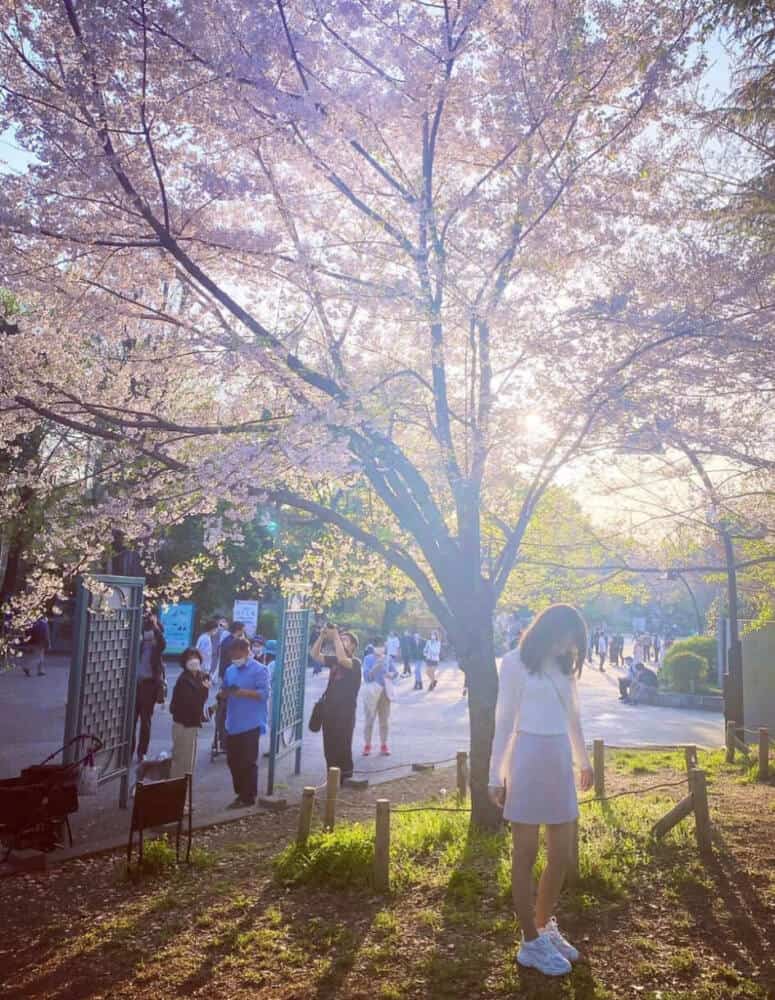
- How to Get There : Ueno Park is easily accessible by train. Take the JR Yamanote Line to Ueno Station.
- Additional Information: Ueno Park is home to several museums in Tokyo , including the Tokyo National Museum. Consider exploring the museums if you’re interested in art and history.
There are many activities you can do within Ueno park alone. But here are two of my suggestions:
Option #1 — Visit the Tokyo National Museum: It’s one of the oldest museums in Japan and definitely one of the top things to see in Tokyo. It’ll cost you about 620 JPY to enter the museum.
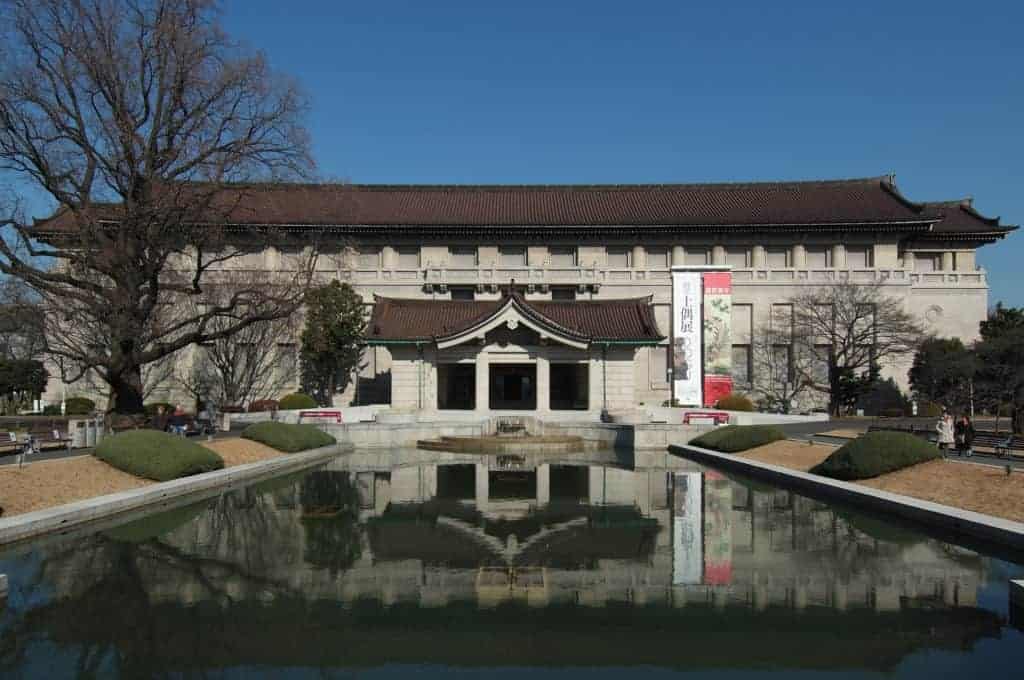
Option #2 — Architecture Tour Of Ueno Park: The tour will take about 3 hours as you walk around marveling at the different items of architecture.
The bigger the group, the lesser the price per person – For a single person the tour costs 14,000 JPY, and for a group of 5, the tour costs 7,000 JPY per person, and that’s a total of 35,000 JPY. You have to book your tickets in advance if you wish to take a tour.
Click here for information on tickets and booking!
Indulge in a traditional Japanese lunch at a local restaurant.
- Suggested Lunch: Warm up with a bowl of hot ramen or indulge in a delicious bento box filled with a variety of seasonal treats.
Explore the historic district of Asakusa, with a visit to Senso-ji Temple and its surrounding vibrant streets.
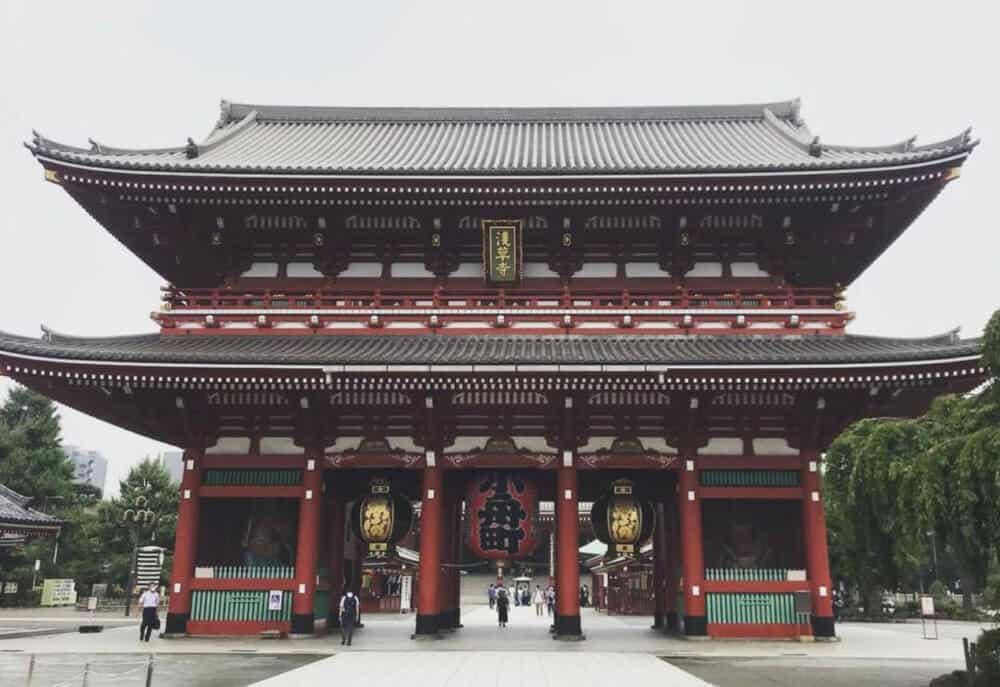
- Optional Activity : Take a rickshaw ride through the streets of Asakusa for a unique cultural experience.
- Additional Information: Don’t miss Nakamise Street, a shopping street leading to Senso-ji, where you can buy traditional crafts and snacks.
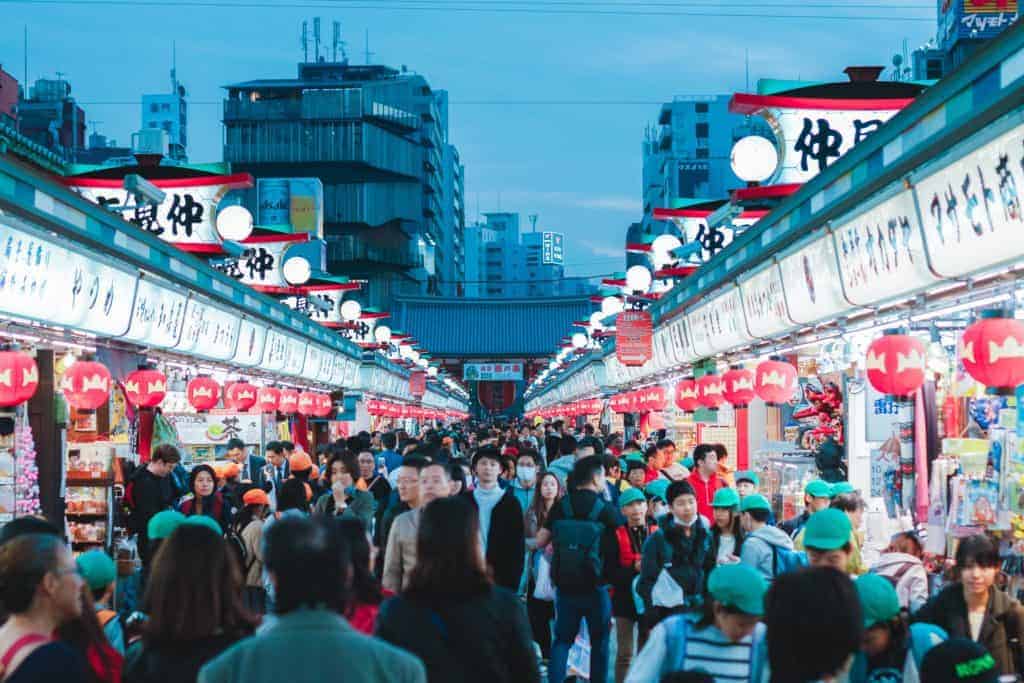
Dine at an izakaya, immersing yourself in the lively atmosphere of a Japanese pub.
- Suggested Dish : Immerse yourself in the izakaya culture with yakitori (grilled chicken skewers), edamame, and a warm cup of sake.
- Wrap up the day by attending a winter illumination event, such as the enchanting Tokyo Dome City Winter Lights.
- Alternative Activity: Explore Roppongi Hills Winter Illumination for a different perspective of Tokyo’s lights.
- Additional Information: Tokyo Dome City Winter Lights features a stunning display of lights, rides, and attractions. Check the event schedule for special performances.
- Related: Best things to do with k ids in Tokyo
Day 2: Skiing Adventure in the Tokyo Area
Embark on an early morning adventure with a day trip to Gala Yuzawa Ski Resort.
- How to Get There : Take the Shinkansen (bullet train) from Tokyo Station to Gala Yuzawa Station.
- Additional Information: Gala Yuzawa is a convenient choice for a day trip as it is directly accessible by the Shinkansen. The resort provides rental equipment, making it suitable for both beginners and experienced skiers.
Grab a quick breakfast on the go, fueling up for a day of skiing and snowboarding.
- Suggested Grab-and-Go : Pick up a convenience store bento for a quick and tasty meal.
Enjoy the slopes and stunning winter landscapes at Gala Yuzawa.
- Optional Activity : Take a ski lesson for beginners or explore more challenging trails for experienced skiers.
- Additional Information : Gala Yuzawa offers a variety of slopes, and the scenery is breathtaking. Take advantage of the ski school if you’re a beginner.
Savor a satisfying lunch at one of the ski resort’s cozy restaurants.
- Recommended Dish : Warm up with a hot bowl of sukiyaki, a Japanese winter favorite.
- Additional Information : Many ski resorts in Japan offer delicious hot meals, and sukiyaki is a perfect choice to replenish your energy.
Return to Tokyo in the evening, tired but fulfilled.
- How to Get Back : Board the shinkansen from Gala Yuzawa Station back to Tokyo.
- Additional Information: Consider stopping by an onsen (hot spring) in Gala Yuzawa before heading back to Tokyo for a relaxing soak.
Unwind at a local onsen to soothe tired muscles, followed by a relaxing dinner at a warm and inviting pub.
- Alternative Activity : Explore the nightlife in Shinjuku or Shibuya for a different Tokyo experience.
- Additional Information : Tokyo has a vibrant nightlife scene. Choose a local pub or bar to unwind and share your skiing adventure with locals.
Day 3: Tokyo City Culture and Winter Markets
Start your day with a seafood breakfast at Toyosu Outer Market.
- Suggested Breakfast: Dive into a bowl of chirashi-don, a rice bowl topped with a variety of fresh sashimi.
- Additional Information: Toyosu Outer Market is a haven for seafood lovers. Try different variations of sushi, sashimi, and seafood bowls.
Visit The Toyosu Fish Market For a Unique Experience
Note: Toyosu fish market is closed on Sundays and national holidays
The Toyosu fish market is the new Tokyo fish market that reopened after the Tsukiji fish market was closed to the public. Formerly known as the Tsukiji fish market, it relocated in October 2018.
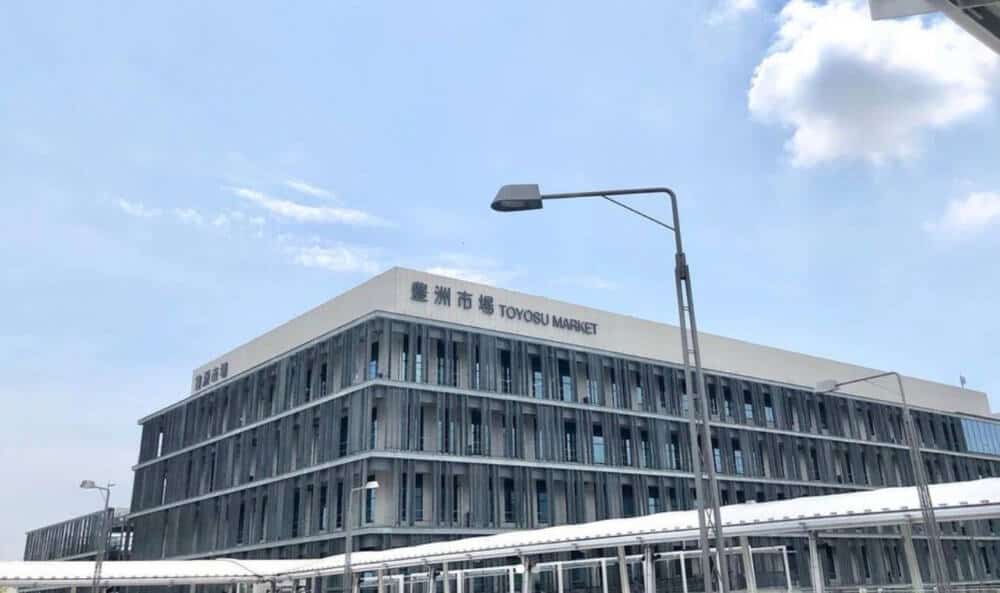
But why am I sending you to a fish market? To see the Tuna auction! (and have some brilliant sushi after!)
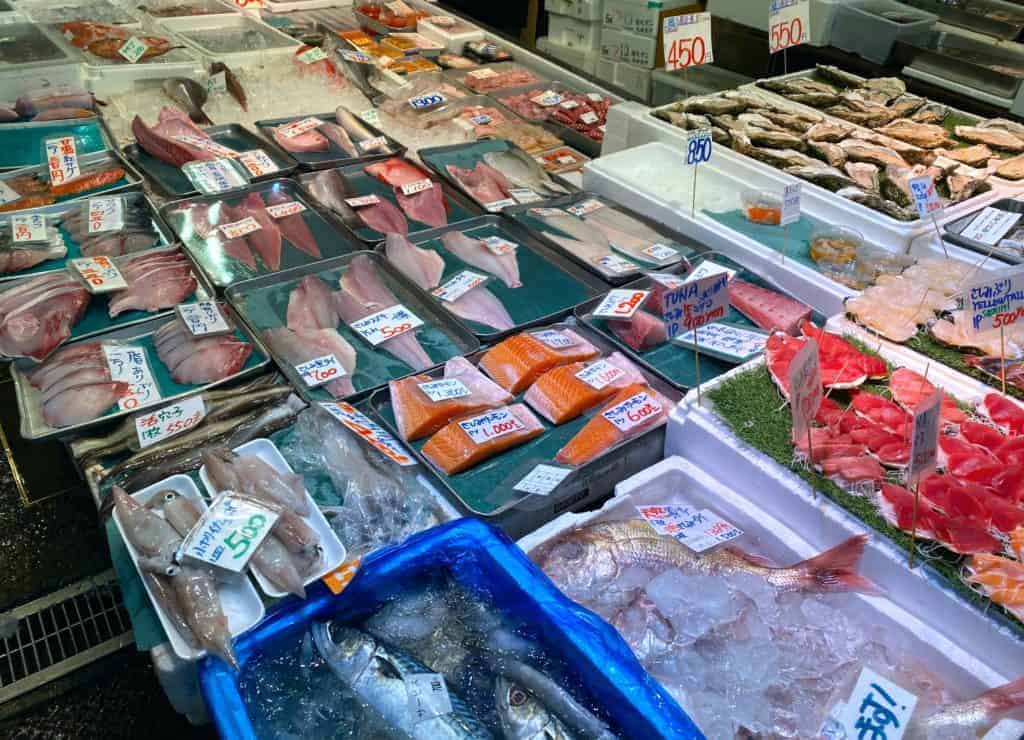
So if you want to catch the Tuna auction, you’ll have to take a taxi to the Shijomae station. This station is directly connected to the Toyosu fish market. (also, taxis aren’t allowed to stop in front of the fish market, which is why you’ll have to ask the driver to drop you off at the Shijomae station).
Trains to Toyosu fish market only commence from around 5:30 onwards so you’ll have to take a taxi if you wish to watch the auction.
If you want to watch the auction, you have to apply in advance on their official website.
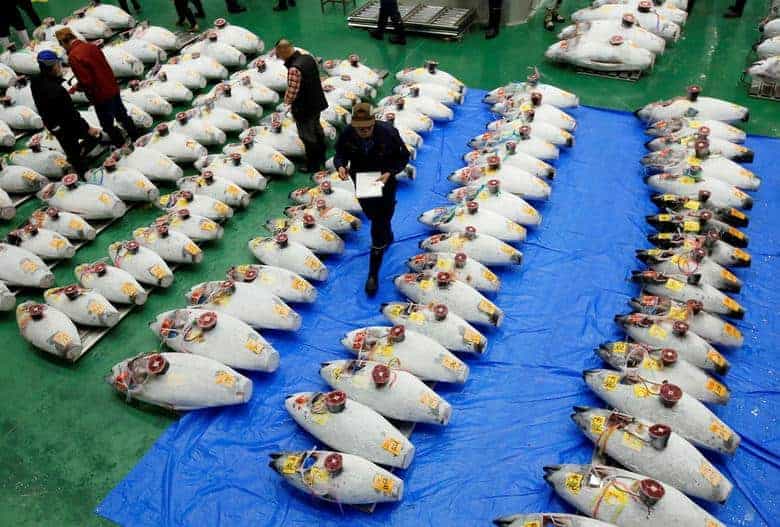
My fav is the Daiwa sushi restaurant. They will replace any sushi that you might not like. And the restaurant staff is especially accommodating to tourists and most of the staff there speak a bit of English so you shouldn’t have any problems communicating!
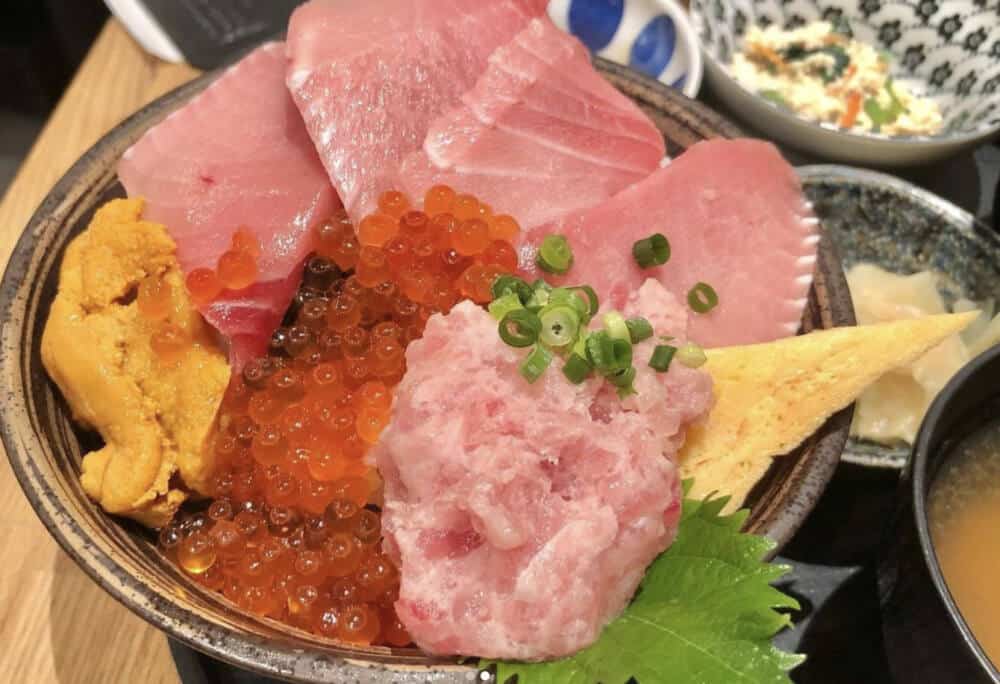
You can apply for a spot to watch the Tuna auction on Toyosu fish markets official website. Click here to know more!
Stroll through the serene Hamarikyu Gardens, appreciating the winter landscape.
- Optional Activity : Experience a traditional tea ceremony in the gardens for a deeper cultural immersion.
- Additional Information : Hamarikyu Gardens offer a tranquil escape in the heart of Tokyo. Enjoy the seasonal beauty and traditional Japanese landscaping.
Lunch at Tsukishima Monja Street area, experiencing the savory delights of monjayaki.
- Suggested Lunch : Try different variations of monjayaki, a Tokyo specialty where the batter is mixed with various ingredients.
- Additional Information: Tsukishima is known for its monjayaki street, where you can find numerous restaurants offering this unique and delicious dish.
Discover the futuristic delights of Odaiba and explore winter-themed attractions.
- How to Get There : Take the Yurikamome Line from Shimbashi Station to Odaiba.
- Alternative Activity : Visit teamLab Borderless in Odaiba for a mesmerizing digital art experience.
- Additional Information: Odaiba offers a mix of entertainment, shopping, and dining. Don’t miss the iconic Rainbow Bridge view.
Dine with a view of Tokyo Bay, relishing a mix of city lights and seaside charm.
- Recommended Restaurant : Aqua City Odaiba offers various dining options with a scenic view.
- Additional Information : Odaiba’s waterfront restaurants provide a picturesque setting. Enjoy a leisurely dinner with a view of Tokyo Bay.
Conclude your Tokyo winter adventure at one of the city’s winter markets, perhaps the Yoyogi Park Winter Market, and end the day with a warm cup of matcha at a traditional tea house.
- Alternative Activity : Explore Nakameguro’s riverside illuminations for a more intimate winter atmosphere.
- Additional Information : Yoyogi Park Winter Market features local crafts, food stalls, and festive performances. Enjoy the winter atmosphere and support local artisans.
In just three days, this winter itinerary offers a comprehensive experience of Tokyo’s diverse winter offerings.
From the serenity of Ueno Park to the thrill of skiing at Gala Yuzawa and the vibrant energy of Tokyo’s winter markets, this journey captures the essence of Tokyo’s winter magic. Bundle up and get ready to make unforgettable winter memories in the heart of Japan
Related: Check out best things to do in an isolated Island called Ishigaki Islands in Japan!
Winter in Tokyo is generally mild compared to other parts of Japan, with average temperatures ranging from 5°C to 10°C (41°F to 50°F). However, it can get quite chilly at night, with temperatures dropping to as low as -1°C (30°F).
Here is a detailed look at the weather in Tokyo during each winter month:
- Rainfall: The winter months (December to February) are relatively dry in Tokyo, with an average of only 4-5 rainy days per month. However, occasional snow flurries are not uncommon, especially in January and February.
- Sunshine: Although the days are shorter in winter, Tokyo still enjoys an average of 5-6 hours of sunshine per day.
Here is a more detailed breakdown of the weather for each winter month in Tokyo:
- December: Average high of 12°C (54°F), average low of 3°C (37°F). December is the driest month of the year, with an average of only 3 rainy days. There is a small chance of snow.
- January: Average high of 9°C (48°F), average low of 1°C (34°F). January is the coldest month of the year, with an average of 5 rainy days and a slightly higher chance of snow.
- February: Average high of 11°C (52°F), average low of 2°C (36°F). February is the warmest month of winter, with an average of 5 rainy days and a decreasing chance of snow.
Packing for a winter trip to Tokyo requires smart layering and versatile pieces to combat the chilly temperatures. Here’s what to pack:
- Warm base layers: Thermal underwear, long-sleeved shirts, and leggings will keep your core warm.
- Insulating mid-layers: Fleece sweaters, wool cardigans, and down jackets provide warmth without bulk.
- Outerwear: A waterproof and windproof parka or coat is essential for protection against the elements.
- Accessories: Scarves, hats, gloves, and earmuffs will keep your extremities cozy.
- Footwear: Waterproof boots or shoes with good traction are ideal for navigating icy sidewalks.

Packing winter clothes can take up a lot of your luggage space. So you can always come to Tokyo and shop for some great winter clothes in stores like UNIQLO that have a a great collection of winter wear for Tokyo’s winter weather!
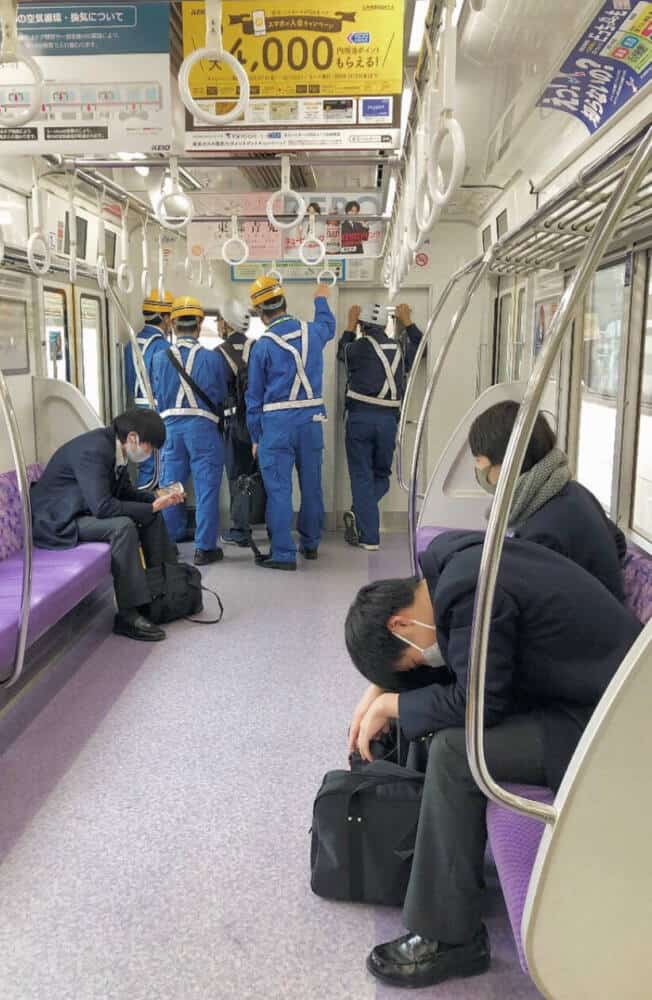
Since you’re in Tokyo for only 3 days, your best bet is to pick up 72-hour Tokyo metro tickets . You can buy these tickets at the Tokyo airport, metro station in Tokyo, foreign information tourist offices, or BIC camera shops. Many hotels in Tokyo also offer these tourist metro tickets.
Check out Tokyo’s official metro website for more information on that!
Another tip I have for you is to get the SUICA smart card so you can have a seamless experience in Tokyo.
SUICA cards are like these prepaid cards that are used in Japan to basically pay for everything – metro, convenience stores, vending machines, restaurants, and more.
You can purchase a SUICA smart card at any major JR EAST stations like Narita Airport Terminal 2/3 Station, Narita Airport Terminal 1 Station, Tokyo Station, Haneda Airport International Terminal Station, Hamamatsucho Station, Ikebukuro Station, Shinjuku Station, and Ueno Station.
Click here for more information on where and how to get a SUICA card in Tokyo!
SUICA cards for adults and children range from JPY 1,000 – JPY 10,000, this includes a JPY 500 deposit. The difference between an adult and child SUICA card is the amount being deducted per train ride.
- Don’t miss the Cherry Blossom season in Tokyo . Check out the dates right here
- Don’t miss the Sumo match in Tokyo. Here’s how you can get the tickets!
- Stop by a Japanese Izakaya. Here’s what you should order!

Hiya! I’m the main author of Japan Truly. I love everything Japan and love testing out Japanese products, be it skincare and makeup or gadgets! You’ll find reviews of some of the best selling Japanese products (tried and tested) right here!
What do you think?
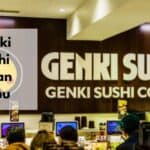
Genki Sushi Japan Menu 2024

Yoshinoya In Japan Menu 2024
© 2024 by Novatise Pte Ltd
Username or Email Address
Remember Me
Forgot password?
Enter your account data and we will send you a link to reset your password.
Your password reset link appears to be invalid or expired.
Privacy policy, add to collection.
Public collection title
Private collection title
No Collections
Here you'll find all collections you've created before.
Ship viral Japanese Products to your doorstep! Dismiss
Privacy Policy - Terms and Conditions
- Itineraries
- Tours and Activities
- Travel Guides
- Best of Japan
JRailPass.com » Japan Travel Blog » 3 days in Tokyo itinerary and what to do
3 days in Tokyo itinerary and what to do
February 12, 2019
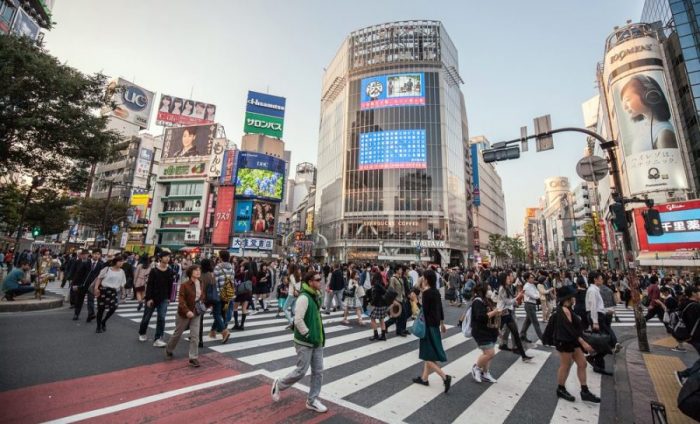
As most trips to Japan begin their story in Tokyo, here is a three days itinerary, which will take you to all the great places this ever-surprising metropolis has to offer.
By taking all of the advantages of your Japan Rail Pass, in this compact travel guide we will show you how to make the most out of your stay in Tokyo: where to go, what to see and what to do, for the best prices!
Day 1: Landing in Tokyo, Shibuya and Ueno
Exchange your Japan Rail Pass at any of two terminals in Narita Airport or the Haneda Airport International Terminal:
- Narita Airport Terminal 1 JR EAST Travel Service Center – Exchange Office Working hours: 8:15 – 19:00; every day
- Narita Airport Terminal 2-3 JR EAST Travel Service Center – Exchange Office Working hours: 8:15 – 20:00; every day
- Haneda Airport International Terminal JR EAST Travel Service Center (Tokyo Monorail 2F Ticket Gate – Arrival lobby) Working hours: 7:45 – 18:30; every day
After having exchanged your Pass, take the Narita Express, (included in your Japan Rail Pass) and travel to any of the following Tokyo stations: Shinagawa – Shibuya – Shinjuku – Ikebukuro – Omiya – Yokohama – Ofuna.
Note: The Narita Express requires a seat reservation, which is why we recommend reserving a seat during the exchange process. There will be no extra reservation charges for owners of the Japan Rail Pass (for those coming from Haneda airport, the Tokyo Monorail stops at Hamamatsucho station).
Travel tip: When in Tokyo, you can use your Japan Rail Pass on the following lines:
- Narita Express
- The Yamanote JR line
- Other JR metro lines in Tokyo
Please refer to our Tokyo metro map for details on which lines you can use. For the rest of the city transport in Tokyo, we recommend you purchase a PASMO or a SUICA card .
The Narita Express , as well as the JR Yamanote Metro line , will take you to one of the most famous, visited and pictured places in Tokyo: the Shibuya Crossing. Google already considers it a fully-functional synonym of the Times Square of Tokyo , because it is!
Book your Japan Rail Pass now
Shibuya crossing
Let’s be honest – Shibuya is amazing! It is the world center of the city centers, it is where many Tokyo-natives like to drink after work, it is where the story of the most loyal dog – Hachiko – began, and also where everyone wants to take a picture. Pedestrians stand still on red light, but the second it turns green, the river of people in a hurry cannot be stopped.

It is the place where the magic happens and where magic has been captured through the centuries. You can spend a whole day around the ward of Shibuya and still not get to see all of it.
After your visit, take the Yamanote line from Shibuya Station, using your Japan Rail Pass, and visit the biggest and most famous park in Tokyo – Ueno Park.
Ueno Park and Ueno Zoo
It is precisely here, where some of the most spectacular views of cherry blossoming (usually between the last week of March and the first week of April) is happening. Perfect for picnics, long walks and talks.
Just next to the Ueno Park is located the famous Ueno Zoo , where children and adults of all ages can enjoy the experience of seeing over 2,600 animals, including giant pandas, red pandas, pelicans, lemurs, wolves, lions, tigers and more.
Children younger than 12 years of age can enter for free, while the price for students is 200¥ Yen and for adults 600¥.
Day 2: Odaiba, Ginza and Hamarikyu Gardens
A waterfront district built upon a man-made island in Toyko Bay, Odaiba has developed into one of the city’s most popular and modern districts. Getting to Odaiba means crossing the Rainbow Bridge from mainland Toyko, which boasts stunning illumination during the night.
Odaiba offers a range of unique attractions including the Oedo-Onsen Monogatari hot springs theme park , futuristic technology at the Miraikan Science museum, and even a miniature Statue of Liberty in Shiokaze Park.
The district offers some of the best views of Toyko’s skyline , from either the spherical observation deck of the futuristic Fuji TV Building, the Palette Town Ferris wheel, or by taking a Sea Bus across the bay to Hinode Pier.
Odaiba is also the location of the new Toyosu Fish Market , where visitors will be able to experience the relocated inner market and famous tuna auctions of the old Tsukiji Market. Tsukiji’s outer market and its numerous retail outlets and restaurants can still be visited in the same location in central Toyko.

Ginza shopping area and Hamarikyu Gardens
While in the neighborhood, don’t miss out on the Ginza area , which will sweep you off your feet once again. The Tokyo version of Manhattan attracts many people for its clean, organized and diverse stores and restaurants.
If it is only logical to take a rest, after a long morning and a tiring day of crowded streets and stores, take a deep breath and head to the Hamarikyu Gardens . They may not be the most famous, but sure are what anyone would like to experience after a busy day.
Surrounded by nearby tall constructions, it is a little piece of nature, in between the concrete jungle of Tokyo. These Japanese gardens will fascinate you with a little teahouse , located on an island in one of the lakes. Visitors can sip on their tea in peace and quiet while enjoying the cultural experience.
Day 3: Asakusa, Harajuku, Meiji Shrine and the Tokyo Metropolitan Government Building
Asakusa and senso-ji temple.
Last day in Tokyo, a day to remember, a day to take the most out of the old Japanese spirits.
Located in Asakusa , one of the Tokyo center districts lays the area’s most famous and beautiful Sensoji temple . Build in the 7th century, it represents one of the oldest and most famous temples in Japan. However, bear in mind that most of the current building is post-war reconstruction, due to massive bombings, which destroyed large parts of the city.

Most of the district has been rebuilt and has regained its popularity amongst locals and international visitors. It will take you nearly 2 hours to take a walk and enjoy everything there is to see.
Don’t be blinded by the endless typical souvenir shops on the main streets and dig deeper into the hidden narrow streets of the area. You will be surprised to discover traditional kimono tailors, purse tailors, even UFO catchers! There is nothing typical about this neighborhood, just step out of the main streets.
Then, after getting to know Asakusa better and enjoying the diverse and beautiful cultural experiences, cross the river and head to the Asahi Beer Hall , where you can have a cold beer on the rooftop.
Harajuku, Meiji Shrine and Yoyogi Park
Tokyo is a city of contrasts, and you are going to understand this even better by taking a walk down to Harajuku area , located just next to the Harajuku station. Seeing up close the old and the new from Tokyo’s districts will tell you the story of how Japan has changed throughout the years.
Going down the Takeshita Dori ( Dori stands for street ), you will discover the young and vibrant Japanese shopping and clothing culture. To the east, west, south or north of this point, you will find high-end stores, tiny jewelry shops, broad and diverse streets, all in one: the perfect combination of food, shopping, and culture.
The only thing that might be missing in this combination is the nature aspect – not to worry! The Meiji Shrine entrance is just next to the Harajuku station.

The temple is dedicated to the first emperor of modern Japan (Emperor Meiji and the Empress Shoken), and it was one of the severely damaged spiritual places during the World War II, rapidly rebuilt shortly after.
Located within walking distance from the Yoyogi Park (picture below), this is a place preferred by many for its serenity, green fields and a chance to sit down, have a picnic and relax with your family and children.
Tokyo Metropolitan Building

Finally, we recommend seeing Tokyo from above, before saying “goodbye.” The spectacular views from different heights and during different times of the day can completely change your perception. Visiting the Tokyo Metropolitan Government Building in Shinjuku offers the chance to see the entire city from 202 meters height, at the observation deck on the 45th floor.
Related posts
Related tours & activities.
Hi, I will be arriving to Narita Terminal 2 on a Tuesday night at 20:35. I’m concerned there won’t be enough time to get luggage, activate my JR Pass at the office, and make it to the very last train to Shibuya at 21:44. Can we make it?
Also, while this page here says the exchange office closes at 20:00, another website says 21:45 (). Can you help clarify?
Hi Kenneth! Please check our FAQ Where to activate my Japan Rail Pass? to get the Exchange Offices full list with its updated opening hours. Regarding the time to catch the train, it wil of course depend on many factors and we are unable to predict 😉 We hope you enjoy your stay!
Hello! I tried to use the website to order the JR pass but it requires delivery. Added country and PO box to get estimated delivery date but with no luck. Do you deliver in UAE and if yes how long does it take? If not, is there any online option available so I can utilize the pass from the first day i.e. travelling from the airport to the city? Also, I was wondering how it gets activated?
Hi Catherine!
Yes, at jrailpass.com we do delver worldwide, which includes UAE. maximum dleivery time is 72 business hours, however we will need a physical address to deliver your order to (PO Box delivery is not available).
To activate your Japan Rail Pass , please go to any JR office . They are spread through most Japanese Airports, such as Narita and Haneda. You can also find them at all the main train stations, located across the country. Once at a JR office, you will be asked to show your passport (the JR staff will look for the Tourist visa stamp/sticker) and your Japan Rail voucher (exchange order). After your personal data has been verified, you will be asked to select the activation date of your pass. This can be up to 30 days following the exchange date. After activating your JR Pass, you will be able to use it on all JR trains, buses, and ferry services.
Happy travels!
I can’t get a clear answer. The separate JR companies (east, west, central, kyushu) have different passes but is there a general pass that can be covered all over Japan? It seems that your typical responses to previous comments say the pass covers all trains, but I want to be sure before I purchase them for my parents that will be visiting. Thanks a lot!
Hi JP! The Japan Rail Pass is a multi-use all-you-can-ride discounted rail ticket. It gives you unlimited access to all Japan Rail National trains, as well as JR bus services, ferry services, and airport transfers. Happy travels!
Hi, we have a family of 5 going to NRT Tokyo on 6/23, from tokyo to Hakone on 6/26, onto Kyoto 6/27, then back to Tokyo 6/30 and to the NRT airport 7/1. It’s 9 days of traveling, but the JR tickets is only 7 or 14 days. What is my best option?
Hi Sue! Your best option would be to purchase a 7-day Japan Rail Pass and activate it for the last part of your trip since it’s when you will be travelling further distances. The JR Pass gives you unlimited access to all Japan Rail National trains, JR bus services, ferry services, and airport transfers. A 7-day JR Pass only costs ¥29.110 which is actually cheaper than a return ticket from Tokyo to Kyoto on a Shinkansen bullet train . Happy travels!
Hi, our family of five will arrive in Tokyo on 1/31. Booked flight to Sapporo from 2/4 to 2/6. Last day is 2/8. Please advise how to squeeze in Osaka. Is it worth it to get JR pass to travel to Osaka or only buy the Nozomi train? Thank you in advance for your recommendations
Hi Megan! The JR Pass gives you unlimited access to all Japan Rail National trains, JR bus services, ferry services, and airport transfers. A 7-day JR Pass only costs ¥29.110 which is actually cheaper than a return ticket from Tokyo to Kyoto on a Shinkansen bullet train . This means that if you make just one long-distance trip you can already save money. If you make multiple trips then you start saving thousands of yen. Happy travels!
Hi, I will be arriving in Narita at the end of January 2019 and travelling straight to Osaka. This is my planned itinerary. My question is should I get JR Pass or go for regional pass? Day 1 Narita – Osaka Day 2 Osaka Day 3 Osaka – Kyoto Day 4 Kyoto Day 5 Kyoto – Nara Day 6 Kyoto – Tokyo Day 7 Tokyo – Enoshima & Kamakura (Can I use JR Pass here?) Day 8 Tokyo – Disney Theme Park (My JR Pass would have expired. What should I get?) Day 9 Tokyo – Narita (return) Without JR Pass how can I get to NARITA Airport from Shinjuku economically?
Hi Chris! The JR Pass gives you unlimited access to all Japan Rail National trains, JR bus services , ferry services, and airport transfers. A 7-day JR Pass only costs ¥29.110 which is actually cheaper than a return ticket from Tokyo to Kyoto on a Shinkansen bullet train. This means that if you make just one long-distance trip you can already save money. If you make multiple trips then you start saving thousands of yen. Happy travels!
I am planning a 8 day trip in Japan for my family, we are intending to arrive at Narita Airport and take the airport transfer to central Tokyo. Following which we would like to go to Kyoto and then Osaka and return home from Osaka, may I as if the JR tickets do include all the airport transfer from Narita to Central Tokyo and also Kansai in Osaka, or would you recommend a better route to go about? 🙂
Hi gaoertou!
Yes – mentioned transfers are fully covered by the Japan Rail Pass .
– The Narita Express – also known as N’EX – is the most convenient Tokyo city transfer from and to Narita International Airport. – The Kansai International Airport (KIX) services the cities of Osaka, Kyoto, Nara, and Kobe. If you hold a Japan Rail Pass, travel from the airport can be a simple and exciting process, as the Japan Railway West’s Express Haruka train offers direct transportation from the Kansai International Airport to downtown Osaka and Kyoto.
Dear I am planning to travel to Tokyo, Osaka and Kyoto. The following are my plan:- 1. 14 May 7 am arrive at Haneda and plan to stay in Tokyo from 14 May till 17 May. Between 14 till 17 May will spend most of the time around Tokyo and plan for one day for Mt Fuji. 2. 17 May will travel to Osaka/Kyoto and stay there from 18 May till 21 May will be spend around Osaka, Kyoto and Nara. 3. 22 May will depart from Osaka (KIX) airport.
Appreciate your advise should purchase 7 day JR pass or any suggestion of the transportation arrangement.
Thanks in advance for your advise.
The JR Pass gives you unlimited access to all Japan Rail National trains, JR bus services, ferry services, and airport transfers. A 7-day JR Pass only costs ¥29.110 which is actually cheaper than a return ticket from Tokyo to Kyoto on a Shinkansen bullet train.
This means that if you make just one long-distance trip you can already save money. If you make multiple trips then you start saving thousands of yen.
In addition, when you start factoring in the money you would spend on the metro, buses, transfers, and ferries, then the savings become a must. A return transfer from Narita Airport is over ¥2.600 and a one-day metro and bus pass in Tokyo costs around ¥1.590.
Hallo! Wir kommen am späten Nachmittag (22.Oct.) in Narita an und möchten zu unserem Hotel (Villa Fontaine Tokyo-Kayabacho, 1-8-2 Shinkawa Chuo-ku, Tokio 104-0033 JP) gelangen. Einen 21-Tage Japan railpass haben wir bereits, den wir aber erst mit dem Mittw. 24.Oct. aktivieren möchten. Es sind zwei Tage in Tokio geplant. Welches Ticket für die öffentlichen verkehrsmittel würden Sie empfehlen? Können wir mit dem Tokyo Subway Ticket auch vom Narita Flughafen in das Hotel gelangen? Herzlichen Dank
Hi there, I will be in Tokyo in October for 3 days, then I will head to Kyoto where I am going to stay for four days before coming back to Tokyo. It seems the JRails pass card doesn’t cover most metro lines in Tokyo and I would need to buy extra tickets. It covers the train trip to Kyoto though. Since I have only 3 days, I need to reach the main sightseeing points in the city as fastest as possible… Is there any other integrated system that covers the metro as well? Can you please advise me on it? Thanks a lot.
I plan to be in Japan (visiting Tokyo/Kyoto) for a total of 8 days (including the arrival and departure days) in October. Im looking at the JR pass options: the 7 days option falls just short while the 14 days is just too much. I land (fly into) in Tokyo the afternoon of day 1 and plan to stay in Tokyo the first night in Japan. Does it make sense for me to purchase an IC card for my family for the first day and the JR pass (7 days) to cover the rest of my stay in Japan? Additional question, with IC card is travel for kids (4 years old) free or do I need to purchase an IC card for my kid as well? Thanks in advance.
Your idea sounds great since the Japan Rail Pass is more cost effective when one travels. Should you be staying at Tokyo for the first day of use, it makes perfect sense to get a prepaid IC Card and then make use of the nation-wide pass. Generally those cards such as PASMO and SUICA are free for kids under 6 years old as long as they travel on their parents’ lap in case of full trains – that is, they cannot occupy a seat for themselves.
We are going to Osaka in October for a week. Is a little unsure if we also want to Tokyo. The only option to buy JR Pass is abroad, if we do so and do not want to use the tickets, you will get the money back?
From Osaka we want to travel to Suzuka Circuit just for a day to watch F1, there are buses or regular trains on this stretch?
Would go early in the morning and come back to Osaka after the race. What do you think is it possible?
Upon purchasing the Japan Rail Pass from an official vendor such as JRailPass you will be entitled to get a refund as long as you haven’t exchanged the voucher into the actual pass.
The trip between Osaka and Suzuka Circuit is partially covered by the Japan Rail Pass. You can get the JR Kawarada (included) and from there you can take the non-JR Ise Testudo line (approximately 300 JPY the single ticket). It will get you straight to the circuit.
Btw. The pocket wi-fi is rentable, no need to buy one.
Yes! The Pocket WiFi can be rented from multiple providers such as here 😉
hi i am planning to travel to japan next month. will stay in tokyo for 4 day and go to osaka for 2 days. then flight to sapproo. is it worth buying JR pass .thanks
Hi! Me and my partner were planning a visit to Japan from November 20-27 2018. we’ll be doing a Tokyo-Kyoto-Osaka tour. Which card would you recommend that we can use both trains and buses? Thanks in advance
Hi Florida! We would go for the Japan Rail Pass since it seems you will be covering different areas of the country. The Japan Rail Pass is a multi-use all-you-can-ride discounted rail ticket. It gives you unlimited access to all Japan Rail National trains, as well as JR bus services, ferry services, and airport transfers. To travel with your 7-day Japan Rail Pass, means to have the unique opportunity to discover the whole country at a cheaper price than a Tokyo to Kyoto return ticket, on a Shinkansen bullet train. Compared to standard Japan train tickets, the JR Pass represents the biggest discount on Japanese public transportation that you can get. Happy travels!
Hello, Thanks in advance for your help! I’ll be visiting Japan for 7 days, spending time in Tokyo, Kyoto and Osaka. I tried buying a 7 day JR pass but the price is for 2 people. I tried to change the #of travelers to one, it still shows the price for 2. How can I purchase a pass for one? Also, on this site you have mentioned for single train tickets there is an option to use Hyperdia. I tried the site , there’s useful information but no where to book train tickets. Please help. Many thanks, Mitra
Hi Mitra! When purchasing at http://www.jrailpass.com you can delete passengers all over the buying process. Should you have difficulties we strongly recommend you to send a message to [email protected] .
Hi, my family (2 adults 1 child) are going to Japan for 10 days and 9 nights around the country, arriving in Narita Airport and staying in Tokyo for the first 3 nights. We are thinking of buying the Narita Express (One Way) to get from the airport, and the Japan Rail Pass for 7 days to use all of the Shinkansen lines when we leave Tokyo. For the other two days in Tokyo, would you recommend daily rail passes, or something else, or is it better value to buy a 14-day Japan Rail Pass?
If you are not leaving Tokyo during these 2 days, it might be better to acquire an IC prepaid card such as SUICA or PASMO. Which one you choose will likely depend on which station you come to first.
Enjoy your stay!
Hello –
Our family is visiting Japan this summer. We will be in Tokyo for 4 days & then Kyoto for 3. We only need train tickets to go from Tokyo to Kyoto (by bullet train) & then Kyoto to Kansai International Airport (Osaka area). When I priced it out, it seems more economical to buy individual tickets rather than JR passes (approximately $150/person versus $261/person for standard JR pass).
* Can I buy individual train tickets online before we travel? * If not, can I purchase them at Tokyo Station & Kyoto Station on the days we want to travel? Or do you recommend buying them a few days before we want to travel since summer is a busy tourist season? * And lastly, do you recommend upgrading to first class (if available)?
Many thanks for your time & help, Paige
Hello! We will be arriving at Narita Airport in the late afternoon on Sunday, then spending the night in Tokyo. The following day (Monday) we want to travel to Kyoto and stay for 6 days. During those 6 days we will tour Kyoto then take day trips to Osaka and Nara. We will then return to Tokyo on the 6th day (Saturday). We want to then tour Tokyo for the next 5 days. What is the best ticket option(s) for us to travel by train, bus and subway on this trip? We were thinking the 7 day JR Rail Pass to use during the first 7 days, then getting a Suica or Pasmo for our stay in Tokyo. Also, what is the easiest way to pick up a JR Pocket Wi Fi if we are arriving at Narita Airport? Thank you for your help!
Hi! I will travel from Okayama station by JR bullet train Nozomi 124 to arrive to Shin Osaka station at 11:18AM and then I need to connect to JR Ltd Exp Haruka 21 that departs at 11:30 AM to go to Kansai Airport (my flight departs at 15:30). I am worried of the transfer time needed in Okayama station; is 12 minutes enough not to miss my departure to Kansai Airport? I have been looking for a map that tells me what door or platform I arrive to and to which one I need to transfer. Also, is this included in the JR Pass? Thanks guys!
The JR Pass is valid on the Kodama, Hikari and Sakura types of Shinkansen, but is not valid on the Nozomi and Mizuho classes. You will not have access to the ‘Nozomi’ and ‘Mizuho’ Shinkansen that are the fastest trains on the Tokaido and Sanyo lines. However, you have access to the ‘Hikari’ or ‘Sakura’ Shinkansen that cover the same routes. The Hikari and Sakura bullet trains reach the same top speed as the Nozomi and Mizuho trains and use the same type of actual train, but have more stops along each route. For example, from Tokyo to Kyoto, the Hikari takes 15mins more than the equivalent Nozomi.
Should you travel with a Japan Rail Pass, we recommend you to search for the equivalent Hikari train. Haruka Express is fully covered by the pass.
We hope you enjoy your trip!
hello I will arrive at Haneda on Apr-6 around midnight and depart from Haneda on Apr-13 at midnight. I will have a 7-day JR pass and my last train would be from Kyoto to Haneda on Apr-13 around 19:00. When should I activate it ? is it valid for 7 calendar days or 7*24hours ? Many Thanks
Hi Dimitris!
The Japan Rail Pass validity period is calculated in days, not in hours. Therefore, if you have purchased a 7-day pass and your activation date (when you first use the pass) is the 6th of April, the exact expiration time will be midnight on April 12.
Hi, I will be travelling to Japan in September, I will be adding the J rail pass because of the travels, however I planned in going to Nasu to see the Alpaca Ranch from Tokyo, does the Jrail cover this? I know that to Kyoto, Osaca and Nara which I be travelling too it covers, however to Nasu, I am still unsure. Thank you for your time 🙂
Hi Stephanie!
Tokyo and Nasu-Shiobara Stations are connected by hourly trains along the JR Tohoku Shinkansen – 75 minutes and fully covered by the Japan Rail Pass ! Nasu Alpaca Farm is about 35 km from JR Nasu-Shiobara station. To assess how to get from the station to the farm we recommend you to check their official website.
Hi, We are traveling to japan on july for 4 days. 1 day in tokyo mostly akihabara, shibuya, harajuku and ikebukuro. 1 day round trip from tokyo to kyoto. And spend the rest of our time in tokyo. Will the 7 day jr pass cover all this trip and save a lot more or should we just get a suica card and link the card for the shikansen app. Thank you for your help.
The cost of a round trip between Tokyo and Kyoto costs between 26,000-27,000 yen. Since the Japan Rail Pass costs 29,110 yen it should pay off should you add any further trip. Please note that with your Japan Rail Pass is included:
– Transfer from Narita Airport to central Tokyo in the Narita Express , which would cost you between 3,020 and 6,160 yen each way depending on the destination you are travelling to. – JR lines within Tokyo: the Yamanote Line , the Keihin-Tohoku Line, the Rapid Chuo Line, the local Chuo-Sobu line and other metropolitan lines that circulate on the outskirts of the city such as the JR Keiyo, Musashi, Nambu and Yokohama lines.
We also recommend you to check our article Best 5 day trips from Tokyo by train to assess on the best day trips you can make from Tokyo using your Japan Rail Pass in case you have spare time.
Hi, We are looking to use the JRail Pass to travel from: Tokyo to Kyoto (stay 2 days) Kyoto to Osaka (stay 2 days) Osaka to Hiroshima (stay 2 days) Hiroshima to Tokyo return
Can we use the 7 day pass to travel to all these locations and return back to Tokyo?
Yes you can use the Japan Rail Pass on all mentioned locations:
– Getting from Tokyo to Kyoto with the Japan Rail Pass is easy. You should take the Shinkansen Hikari train from either Tokyo Station or Shinagawa Station in central Tokyo, and arrive at Kyoto Station. – Use of local JR lines in Kyoto, which include the Sagano Line and the Nara Line. – Travelling between Kyoto and Osaka is now easier than ever. Just take the Hikari train on the Tokaido Shinkansen line. You will get between Kyoto Station and Shin-Osaka Station in less than 30 minutes. – Unlimited trips in the Osaka Loop Line , which “loops,” or circles, through downtown Osaka. – Going to Hiroshima will also be easy: from Osaka city center, take the JR Haruka Express to Shin-Osaka Station, then transfer to the Sanyo Shinkansen line (westbound, Hikari trains). This trip takes approximately 2 hours and 40 minutes. – To get from Hiroshima to Tokyo, you can take the Sakura train that will take you to Shin-Osaka station. You will then transfer to the Sanyo Shinkansen line’s Hikari bullet train from there to Tokyo Station.
And not only this, but you will also entitled to use your Japan Rail Pass for your transfer from the airport (either Haneda or Narita) to central Tokyo and in 5 local JR in Tokyo (the Yamanote Line , the Keihin-Tohoku Line, the Rapid Chuo Line, the local Chuo-Sobu line and other metropolitan lines that circulate on the outskirts of the city such as the JR Keiyo, Musashi, Nambu and Yokohama lines).
We hope you have an amazing trip!
Planning on going to Tokyo in July with 7 day pass. Would like to visit Niihama for a day. Can I use JR pass from Tokyo to Niihama? How long will it take to get there? Is it worth traveling to Niihama for just a one day stay there?
Travelling from Tokyo to Niihama can be made at no additional cost if you are holding a Japan Rail Pass . The trip is quite long (around 6 hours each way) so might be tight for a day trip. Your journey would be as follows:
– From Tokyo Station , take the Hikari train on the JR Tokaido/Sanyo Shinkansen Line to Okayama Station. The trip takes about four hours – Once you get to Okayama you need to transfer to Shiokaze Limited Express train and travel all straight to Niihama.
We hope you enjoy your stay!
is JR pass an option to travel from osaka to KIX?
Yes it is! Japan Rail Pass holders are grantes access to the Haruka Express , which will take you between Kansai Airport and Shin-Osaka Station in a joruney of about 1 hour.
We hope you have a great trip!
hi. we will travel on dec with my family.are we going to use jr pass from shinjuku to osaka? if yes how can we purchase it?
Yes, you can travel from Shinjuku (Tokyo) to Osaka using the Japan Rail Pass. You will just need to take the Yamanote line at Shinjuku and travel to either Shinagawa or Tokyo stations. To get from Tokyo to Osaka , you will need to take wither the Hikari bullet train or Kodama. Both run on the Tokaido Shinkansen line, connecting the two cities.
The Japan Rail Pass can be purchased here .
We hope you have an awesome trip!
I’ll be spending 6 days in central Tokyo for buisness and has to travel to Kyoto for the weekend. Is JR 7 days pass the most economical round trips from Tokyo to Kyoto, narita airport to Tokyo and travel subway within central Tokyo? Thanks!
The Japan Rail Pass will cover most of your trip but not all subway transportation within Tokyo. To assess if the nation-wide pass is the most economical one for your concrete trip we recommend you to check which would be the price for the individual ticket of each part of the itinerary at Hyperdia , and them compare them all to the cost of the Japan Rail Pass.
Have an amazing trip!
Hi ! We are travelling to Tokyo in 03 till 06 Nov from Singapore. If i purchase the JR pass online now , how do I get my exchange order ? And the shortest is 7days and there’s no 72 hours kind ? If to travel from Tokyo to Mt Fuji, possible to use JR pass? And what’s the best recommended route?
If you purchase your exchange order in http://www.jrailpass.com you will receive my ordinary mail the physical order. Please note it is not possible to use any electronic confirmation: Japanese regulation regarding Japan Rail Pass is very strict and thus you won’t be able to exchange your pass without the physical exchange order.
The validity period of the Japan Rail Pass is either 7, 14 or 21 consecutive days. JR Pass cannot be extended by 1,2, or more days. It is available for 7,14, and 21-days, non-extendable and non-transferable.
To go to Mount Fuji from Tokyo we would recommend the Gotemba trail, here is how to get to it: · Take JR Tokaido line for Kozu from Tokyo Station, using your JR Pass · Once at Kozu (Kanagawa), take the JR Gotemba Line for Numazu · Get off at Gotemba Station | final destination
Very happy travels!
My wife and l (both 70+) are going on a organised 11 day tour in late March 2018 of Japan which uses Shinkansen (Bullet Trains) and buses. The tour starts in Tokyo (only 1 day)and finishes in Osaka, and we’d like to return to Tokyo to see more for about 3 more days, before flying back to New Zealand. We haven’t as yet organised any tickets to get back to Tokyo (Ginza / Tokyo Station area. 1) Should we purchase a 7 day Rail Pass or buy a One way ticket or fly ? 2) If we purchase a 7 day Rail Pass can we use it on Tokyo subway or Metro, plus can we use it to get to Narite Airport when we leave ?
We’re going to finish an organised tour in Osaka, and would like to go back to Tokyo. Should we purchase a 7 day Rail Pass, or buy a One way ticket ? If we purchase a 7 day Rail Pass can we use it onTokyo’s subway and get to Narite Airport ?
For the exact cost of each train ride please check Hyperdia – the number 1 Japanese online transportation planning tool. Please note that the Japan Rail Pass is more useful the more you travel and the far you do so it will always depend on the use you are going to give to the pass.
Please note all subway in Tokyo is not included in the Japan Rail Pass. Included lines are the following: the Yamanote Line , the Keihin-Tohoku Line, the Rapid Chuo Line, the local Chuo-Sobu line and other metropolitan lines that circulate on the outskirts of the city such as the JR Keiyo, Musashi, Nambu and Yokohama lines. Regarding transport to Narita Aiport, the Narita Express is fully included in the Japan Rail Pass. It will take you from central Tokyo to Narita Airport.
I understood that we have to exchange the Japan Rail Pass at the airport once we arrive to Japan (we will be landing in Narita Airport Terminal 1), question is we will be landing at the time where the working hours of the Service centre – Exchange office will be closing (we land at 7pm local time). So is there other alternative to exchange the pass? Please advise.
Thanks in advance.
To activate your Japan Rail Pass you will need to go to any JR office. They are spread through most Japanese Airports and you can also find them at all the main train stations, located across the country. For detailed information on the JR Offices, their location and opening times, take a look at the JR Exchange Offices full list.
Have a nice trip!
Hi! My family and I will be arriving in NRT. We will be in Tokyo for 4 days and then head to Gunma for 6 days. What the JR rail pass help us get around in Tokyo or do we need to get the Suica card as well for other subways? Also, how can we get to Gunma, Takasaki using the JR pass? Thank you
For your stay in Tokyo you will be entitled to use the transportation mentioned in this article at no additional cost. Should you want to visit any other corner of the city that is not reachable with the stated lines you should use any other Japanese IC card .
You will also be able to reach Gunma with your Japan Rail Pass, specially if you want to reach Takasaki which is the biggest station of the prefacture.
I will be traveling to Tokyo in October for business, which will require me to also travel to Nagano. I arrive in Tokyo Tuesday, then depart for Nagano on Wednesday. On Saturday I am meeting my sister in Kyoto for 4 days to sightsee and then we will travel back to Tokyo to fly out. What’s the best option for bullet train tickets and travel for me? Is it better to do one way ticket on travel days or purchase a pass 7 or 14 day pass. Other than traveling to and from destination cities, we won’t be on the train. Thanks!
Please be aware that the Japan Rail Pass is only aimed for those travelling to Japan under a Tourist Visa. Should you be granted any other type of visa, you wouldn’t be entitled to use it. The Japan Rail Pass would cover your trips from airport to central Tokyo, from Tokyo to Nagano and from Nagano to Kyoto.
Enjoy your trip!
Hi! My family and I (5 people) are arriving in Narita on 8/6. With the arrival day, 8/6 early afternoon and departure day, 8/10 at 2:00 PM are what I consider as travel days, should I purchase a JRP for each of us that’s good for 3 days of sightseeing only? If so, how much would it cost for each of us? Please give me suggestions and recommendations as to what is best. We will be staying in Nagatacho, Chiyoda-ku. Thanks!
The Japan Rail Pass is valid for either 7, 14 or 21 consecutive days. It is not possible to purchase an option with fewer days. The most updated price can be found at jrailpass.com . The best option for your will always depend on your travel plans: the Japan Rail Pass should a better fit if you are planning to travel through the whole country than if you plan to stay within the same city.
hello there, i am angus . just wanna know about the type of trains and the timetable to mount fuji and hakone. tq
We recommend you to read our article on Mount Fuji and Hakone: day trip itinerary with the JR Pass . There you will find the most interesting tips and recomendations for a visit to that amazing corner of the country. Regarding times please make sure to check Hyperdia for the most updated information. It will enable you to precisely plan your trip in Japan from station to station with punctuality to the second – Japanese style 😉
can We use the Japan Rail Pass for bus or subway / tram at Tokyo – osaka or Kyoto ? Thx
Sure! The JR Pass affords access to five different Tokyo railway lines: – The Yamanote Line is a loop line which passes through Tokyo’s various city centers and numerous stations, including Tokyo, Ueno, Ikebukuro, Shinjuku, and Shibuya Stations. – The Keihin-Tohoku Line runs parallel to the eastern side of the Yamanote, and can be accessed from Tokyo, Ueno, and Shinagawa Stations. On the western side, the Yamanote is complemented by the Saikyo Line. – The Rapid Chuo Line can be accessed from Tokyo and Shinjuku Stations. – The local Chuo-Sobu line services both east and west Tokyo, from Chiba to Mitaka, passing through Akihabara, Yoyogi and Shinjuku Stations. Ryogoku Station can be reached from this line, providing access to the Kokugikan Sumo tournament arena.
In Osaka you will be able to use the Osaka Loop Line , which circles through downtown Osaka. Numerous trains in and around Kyoto can be accessed using your Japan Rail Pass in Kyoto . Local Kyoto JR lines include the Sagano Line and the Nara Line.
Comments are closed.
Little City Trips
3 days in Tokyo: A Family itinerary
Tokyo is a big bustling city full of excitement and colour, but how easy is it to tackle with kids?

With the help of Anne Sutherland-Smith from Pre-Traveller , we have put together this fabulous 3 day Tokyo Itinerary for Families to make sure you get all the very best out of a short trip to Tokyo, Japan
You can listen to an interview between our editor Marianne and Anne on our City Travel with Kids Podcast below – full show notes can be found here .
Day 1 Tokyo with Kids Itinerary
Spend the morning indulging in the art of Sumo in the Ryogoku area . This can be watching a sumo tournament , or watching a sumo training session if your children are old enough (they need to be able to sit still and quiet).
Explore the Asakusa area of Tokyo, here you will find the Senso-Ji Temple, the oldest Buddhist Temple in Toyko.
You can also head into the Asakusa Culture Tourist Information Centre . Not only a fabulously designed building with great city views, but you can also arrange city walking views from here as well as enquire (in English) on local sightseeing, cooking classes and kimomo-wearing experiences.

Look for some unique foodies experiences – from the convenience stores to the street stalls, get to know your local streets and sample local delicacies.
Where to stay in Tokyo with Kids
There are many places for families to stay in Tokyo, depending just how deep into the action you want to be, or if you’d prefer a suburban experience away from the crowds which can be a little overwhelming with little ones.
Top areas to stay in for families include:
- Asakusa : An atmospheric older part of town has a lot of good cheap Tokyo hotel options including larger rooms in triples and quads.
- Shinjuku : Close to one of Tokyo’s main transport hubs and is on the Yamanote line , making it easy to get everywhere from here.
- Shibuya : Also has easy transport options, a huge choice of restaurants and good shopping options. A fun option for families with older kids and teenagers.
- Hilton Tokyo Bay: If your primary aim is the Disney theme parks
It’s important to check out exactly how much space you will actually get; even if advertised as a family room there may be an exceptation that children share with an adult which does not work with older kids Family rooms at a hostel can be a good budget alternative.
Some top Tokyo family-sized hotel rooms include:
- Ryokan Kamogawa Tokyo – for an authentic Japanese experience
- Park Hyatt Tokyo – for a luxury stay in the heart of the action
- Asakusa View Hotel – A modern western-style hotel in the heart of Asakusa, just a 5-minute walk to Senso-ji temple
Check out our complete selection of Tokyo hotel rooms to suit all budgets here.
Day 2 Tokyo with Kids Itinerary
Try one of the teamLab Experiences – Digital Art Museums. There is one in Odaiba ( Teamlab Borderless ) and in Toyosu ( TeamLab Planets ).

Afterwards, explore the Odaiba Area . See the big Gundam Statue , a small version of the Statue of Liberty, a giant Ghibli Clock and even squeeze in a riverboat cruise from here.
Do a Harajuku food tour ! A great taster of Tokyo’s Pop Culture, exploring and tasting your way around Harajuku.

Day 3 Tokyo with Kids Itinerary
Head on an early morning train out west of the city to visit the Ghibli Museum and Hayao Miyazaki Movies Tour.

Arrive back into Shinjuku Station on the western side of Tokyo
- See the Big Godzilla towering over the Toho Building.
- Catch a show at the Robot Restaurant .
- With younger children, explore the Tokyo Toy Museum – including indoor and outdoor play areas.

Further family activities in Tokyo
If you have more than 3 days to spend in Tokyo and surrounding areas, you could add these activities:
- Disneyland Tokyo if you have younger children or love the original themed Disney Parks.
- DisneySea Tokyo is more thrill rides, better for older kids and a more unique Tokyo experience
- Attend a baseball match
- A day trip west to Mount Fuji
- Fuji-Q Highland Amusement Park
- Oshino Ninja Village
- Foodie Tours through Nishiki Market
- Family-friendly tour through the most famous temples and Kyoto Railway Museum
- Nara Deer Park

You can catch all our suggested Tokyo highlights with kids here.
How to get around in Tokyo
Tokyo is a very large city to navigate so you are best to base yourself near to a Metro line and avoid travelling with kids during peak commuter rush hour times.
You only need to invest in a Japan Rail Pass (JR Pass) if you are intending to travel beyond Tokyo, otherwise, you will only need a Tokyo Metro Pass .
You can read our complete guide on how to get around in Tokyo here.

What to pack for Tokyo
We suggest packing light so you are not dragging too much luggage around with you, but you do need to pack appropriately for the seasons with summers being very hot and winters cold.
Our full guide on what to pack for Tokyo can be found here.
Sign up to receive the Little City Newsletter

Visit our Tokyo with Kids Home Page
Remember to pop on over and listen to the podcast if you would like to learn more about all the places we mention from Anne & the Little City team.
Little City Trips is a participant in the Amazon Services LLC Associates Program, an affiliate advertising program designed to provide a means for sites to earn advertising fees by advertising and linking to Amazon.com
This post contains affiliate links. If you make a booking or purchase using one of these links, we may receive a small commission – at absolutely no extra cost to you.
Have you joined our City Insider community?
- Car Rentals
- Airport Transfers
- Attractions & Tours
- Bundle & Save
- Destinations
- Trip.com Rewards
Tokyo & Hakone in 4 Days: A Journey Through Modernity and Nature

April 22, 2024 · 3 min read

Embark on a captivating 4-day journey through the bustling cityscape of Tokyo and the tranquil retreat of Hakone. Begin your adventure in the lush greenery of Shinjuku Gyoen National Garden, a perfect introduction to Tokyo's blend of traditional and modern. Spend the rest of your first day getting lost in the characteristic neighborhood of Shinjuku City, where the pulse of Tokyo's heart beats the strongest. Day two is dedicated to the electric vibes of Akihabara Electric Town, a paradise for tech enthusiasts and anime fans alike, followed by a peaceful stroll in Ueno Park, an urban oasis rich with cultural landmarks. The third day takes you to the historic Sensō-ji temple, where spirituality meets the bustling Nakamise-dori Street, and then to Sumida Park for a serene break, capped off with breathtaking views from Tokyo Skytree's observation deck. Your final day transports you to the volcanic valley of Owakudani in Hakone, known for its active sulphur vents and hot springs, before unwinding by the picturesque Lake Ashi, surrounded by Mount Fuji's iconic silhouette. This itinerary promises a blend of urban exploration and natural wonders, curated for an unforgettable experience.
- Day 1: Serene Beginnings and Vibrant Explorations in Tokyo
Shinjuku Gyoen National Garden

Kicking off our Tokyo adventure, the first stop is the tranquil oasis of Shinjuku Gyoen National Garden, nestled in the heart of the bustling city. As you step into this serene landscape, allow yourself a couple of hours to meander through the elegantly designed gardens that blend three distinct styles: traditional Japanese, formal French, and an English landscape. With sprawling lawns, tranquil ponds, and the seasonal beauty of cherry blossoms and autumn leaves, it's a picturesque retreat from the urban energy awaiting you later in Shinjuku City.
Attraction Info
- 11 Naitōmachi, Shinjuku City, Tokyo 160-0014, Japan
- Suggested tour duration: 2-3 hour
- Open from 10/1-3/14,Tue-Sun,9:00am-4:30pm;Open from 3/15-6/30,Tue-Sun,9:00am-6:00pm;Open from 7/1-8/20,Tue-Sun,9:00am-7:00pm;Open from 8/21-9/30,Tue-Sun,9:00am-6:00pm;Closed on Mon,*The park is open every Monday from March 25 to April 24 and November 1 to 15; Rest days: year-end and New Year holidays (December 29th to January 3rd).
Recommended Nearby Restaurants
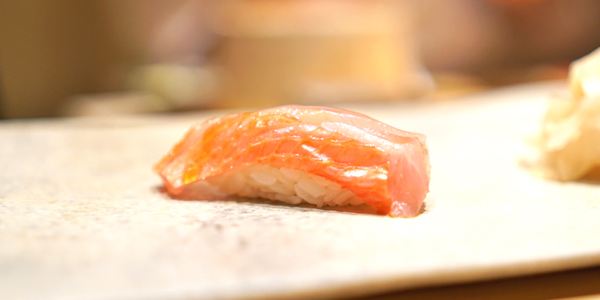
Shinjuku City
After rejuvenating your senses at Shinjuku Gyoen, immerse yourself in the characteristic neighborhood of Shinjuku City. Spend the day exploring this iconic district known for its skyscrapers, shopping havens, and entertainment hotspots. From the neon-lit streets of Kabukicho to the local bars in Golden Gai, Shinjuku offers a slice of Tokyo life that's as diverse as it is dynamic. Don't miss the chance to witness the city's pulse, taste its culinary delights, and experience the blend of modernity and tradition that defines Tokyo.
- Tokyo, Japan
- Suggested tour duration: 0.5-1 day
- Open 24 hours
Where to Stay Tonight
Shinjuku kuyakusho-mae capsule hotel, hotel yuyukan.
- Day 2: Tokyo's Tech & Nature - Akihabara and Ueno Park
Akihabara Electric Town
Kickstart your second day in Tokyo with the electrifying vibes of Akihabara Electric Town, a buzzing hub that's a paradise for tech enthusiasts and anime fans alike. Nestled in the heart of Chiyoda City, Akihabara is a vibrant district where the latest gadgets, electronic items, and pop culture merge to create an experience that's uniquely Tokyo. Spend your day exploring the myriad of shops, each offering a glimpse into Japan's cutting-edge technology and otaku culture. Whether you're hunting for rare collectibles or just soaking in the neon-lit atmosphere, Akihabara is sure to energize your Tokyo adventure.
- 1 Chome-12 Sotokanda, Chiyoda City, Tokyo 101-0021, Japan

After immersing yourself in the high-tech world of Akihabara, find tranquility amidst the bustling city at Ueno Park. A short journey from the electronic paradise, this expansive city park offers a peaceful retreat with its scenic beauty and cultural landmarks. Spend a couple of hours strolling through the cherry blossom trees, visiting temples, and perhaps catching a performance at the open-air stage. Ueno Park isn't just a green oasis; it's also home to several prestigious museums and a zoo, making it a perfect blend of recreation, education, and relaxation in the heart of Tokyo.
- Uenokoen, Taito City, Tokyo 110-0007, Japan
- Open from 5:00am-11:00pm
Hotel Kangetsuso
Hotel new ueno.
- Day 3: Spiritual Beginnings and Sky-High Views in Tokyo
Kicking off the third day with a serene visit to Sensō-ji, Tokyo's oldest temple, sets a tranquil tone for the day's explorations. As you step through the Kaminarimon ('Thunder Gate'), the vibrant hues and rich history of this Buddhist temple invite you to discover its ancient wonders. Spend an hour wandering the temple grounds, admiring the Five-story Pagoda and the majestic main hall, which houses a golden image of Kannon, the Goddess of Mercy. The temple's atmosphere, a blend of spiritual calm and the lively chatter of visitors, provides a unique glimpse into Tokyo's cultural heritage.
- 2-chōme-3-1 Asakusa, Taito City, Tokyo 111-0032, Japan
- Suggested tour duration: 1-2 hour
- Open from 4/1-9/30,6:00am-5:00pm;Open from 10/1-3/31,6:30am-5:00pm

Nakamise-dori Street
Just a short stroll from the temple's tranquility, Nakamise-dori Street awaits with its bustling array of shops and stalls. This shopping street is the perfect place to immerse yourself in local flavors and crafts for a couple of hours. As you meander down the street, the aroma of fresh senbei (rice crackers) and the sight of colorful yukata will tempt your senses. Nakamise-dori is not just a shopper's paradise but a cultural experience, offering everything from traditional souvenirs to tasty street food, ensuring that your visit is both memorable and delightful.
- 1-chōme-36-3 Asakusa, Taito City, Tokyo 111-0032, Japan
Sumida Park
After indulging in the delights of Nakamise-dori, a leisurely hour at Sumida Park offers a refreshing change of pace. This city park, nestled along the banks of the Sumida River, is a verdant oasis amidst the urban landscape. The park's scenic walking paths and seasonal cherry blossoms provide a picturesque backdrop for relaxation and reflection. Whether you're enjoying a peaceful boat ride on the river or simply lounging on the grass, Sumida Park's natural beauty is a welcome respite from the city's hustle and bustle.
- 1 Chome-1 Hanakawado, Taito City, Tokyo 111-0033, Japan
- Suggested tour duration: 1-3 hour
Tokyo Skytree
Concluding the day's journey, Tokyo Skytree towers above the cityscape, beckoning you to ascend to its observation deck for a breathtaking panorama. In just an hour, you can experience Tokyo from a new perspective, with the city's vastness unfolding beneath you. As the tallest structure in Japan, the Skytree offers not only stunning views but also a variety of shops and restaurants. As the sun sets, the Skytree's illumination transforms it into a beacon of light, symbolizing Tokyo's fusion of tradition and modernity, and providing a fitting end to a day filled with discovery.
- 1 Chome-1-2 Oshiage, Sumida City, Tokyo 131-0045, Japan
- Open from 04/01-04/06,10:00am-10:00pm;Open from 04/08-04/13,10:00am-10:00pm;Open from 04/16-04/20,10:00am-10:00pm;Open from 04/22-04/27,10:00am-10:00pm;Open from 05/07-05/11,10:00am-10:00pm;Open from 05/13-05/14,10:00am-10:00pm;Open from 05/16-05/18,10:00am-10:00pm;Open from 05/20-05/25,10:00am-10:00pm;Open from 05/27-05/31,10:00am-10:00pm;Open 10:00am-9:00pm on 04/15;Open 10:00am-9:00pm on 05/15;Open 9:00am-10:00pm on 04/07;Open 9:00am-10:00pm on 04/14;Open 9:00am-10:00pm on 04/21;Open from 04/28-05/02,9:00am-10:00pm;Open 9:00am-10:00pm on 05/12;Open 9:00am-10:00pm on 05/19;Open 9:00am-10:00pm on 05/26;Open from 05/03-05/06,8:00am-10:00pm,Last admission for the TOKYO SKYTREE Tembo Deck is 8 p.m. for the TOKYO SKYTREE Tembo Galleria is 8:30 p.m
Hotel Livemax Asakusa Sky Front
Entire typical japanese house1min walk to skytree.
- Day 4: Serene Farewell with Nature's Wonders in Hakone
Begin your final day with the steaming vistas of Owakudani, a volcanic valley with active sulphur vents and hot springs in Hakone. As the first stop of the day, it's a chance to witness the earth's raw power before you say goodbye to this enchanting region. Spend an hour marveling at the bubbling pools and the unique opportunity to try the famous black eggs, a local delicacy colored by the sulphurous waters, which are said to extend one's life by seven years.
- 1251 Sengokuhara, Hakone, Ashigarashimo District, Kanagawa 250-0631, Japan
- The specific business status is subject to the opening situation on that day.

Conclude your Hakone adventure with a tranquil visit to Lake Ashi, a crater lake with Mt. Fuji views that's perfect for a day of reflection and relaxation. Here, you can indulge in a leisurely cruise, embrace the serenity of the surrounding nature, and ponder the beautiful moments of your journey. The lake's mystical atmosphere, enhanced by the reflection of the surrounding mountains, provides a fitting and peaceful end to your four-day Tokyo Hakone itinerary.
- Lake Ashi, Motohakone, Hakone, Ashigarashimo District, Kanagawa 250-0522, Japan

The Prince Hakone Lake Ashinoko
* All user reviews in this article have been translated by machine.
* The information above is subject to change at any time. For the latest information, please check the websites of hotels and attractions.

<h3>Trending Searches</h3>
Popular Content
- Lijiang Shangri-La 5 Days Itinerary
- Lagoa 1 Day Itinerary
- Madrid Granada Province 4 Days Itinerary
- Toronto Niagara Regional Municipality 5 Days Itinerary
- Watsons Bay 1 Day Itinerary
- Philadelphia 3 Days Itinerary
- Abu Dhabi 2 Days Itinerary
- Lausanne Geneva 4 Days Itinerary
- Granada 3 Days Itinerary
- Davos 1 Day Itinerary
- Yingde 2 Days Itinerary
- Oslob 1 Day Itinerary
- Huidong Guangzhou 3 Days Itinerary
- Honghe 5 Days Itinerary
- Jinhua Lishui 4 Days Itinerary
- Customer Support
- Service Guarantee
- More Service Info
- Website Feedback
- About Trip.com
- Terms & Conditions
- Privacy Statement
- About Trip.com Group
Other Services
- Investor Relations
- Affiliate Program
- List My Property
- Become a Supplier
Nomadic Matt's Travel Site
Travel Better, Cheaper, Longer
The Perfect 7-Day Japan Itinerary for First-Time Visitors

Japan captured my heart from the moment I firs visited. The delicious food, the rich culture, breathtaking landscapes, vibrant history, and the very friendly and polite people – it all blew my mind.
But Japan often feels impenetrable, especially to first-time visitors. While I think Japan deserves a minimum of 10 days, I get that some people might only have a week, so I wanted to write this, my ideal seven-day itinerary for Japan for a first-time visitor.
With only a week, there’s not much you can see unless you really rush it. And I don’t think you should do that.
So this itinerary only focuses on Tokyo and Kyoto (the most popular destinations) as well as some day trips from each. If you wanted to rush things a little, you could add in Osaka (more on that at the end).
(Note: If you purchased a Japan Rail Pass , activate it on arrival. That way, you can take advantage of the free JR trains throughout the city.)
Table of Contents
Japan Itinerary Day 1: Tokyo
Japan itinerary day 2: tokyo, japan itinerary day 3: tokyo, japan itinerary day 4: kyoto, japan itinerary day 5: kyoto, japan itinerary day 6: nara, japan itinerary day 7: tokyo, an alternative itinerary.

Tsukiji and Toyosu Fish Markets Cure your jet lag with some food! In 2018, Tokyo’s main fish market moved to Toyosu. It is now twice the size of Tsukiji (the old one), making it the largest such market in the world. Here you can eat fresh sushi for breakfast, just a few feet from where it was hauled in from the sea, while marveling at the chaotic atmosphere.
You can still head to the old market in Tsukiji to eat, shop, and wander as well. I like it a lot, because there are more food options! Food and drink tours of the Tsukiji Outer Market are available for around 15,000 JPY.
Toyosu Fish Market is open Monday-Saturday 5am-5pm, though most shops don’t open until 7am. Admission is free, but you have to pick up a visitor’s pass when you enter. Tsukiji Fish Market’s hours vary by shop (usually 5am-2pm). Admission is free.
teamLab Planets This digital art installation is a multi-sensory and immersive experience in which you become part of the artwork, walking barefoot through the four exhibition spaces and gardens as you interact with the installations’ elements in unique ways. It’s really fun! TeamLab is generally sells out in advance, so I recommend getting your tickets online ahead of time .
Take a walking tour Walking tours are a great way to get the lay of the land while connecting with a local guide. I always go on one or two when I arrive somewhere. Tokyo Localized offers many free tours, including a classic overview and ones of both the famed Harajuku and Shinjuku neighborhoods. Its Imperial Palace tour would be the most convenient one after teamLab.
The Imperial Palace Formerly Edo Castle, the Imperial Palace was built in the 15th century, and some of the walls and moats from that time are still in use to this day. When the emperor moved from Kyoto to Tokyo in 1869, he took Edo for his new palace and renamed it. While you can’t go inside, it is surrounded by beautiful grounds, a moat, and a park worth wandering through. You can also see the changing-of-the-guard ceremony (though it’s relatively low-key and unassuming). Admission to the grounds is free.
Shinjuku Gyoen National Garden This park is over 144 acres and home to some 20,000 trees. Most of the original park was destroyed in World War II but was rebuilt and reopened in 1949. During spring, it is one of the best places to see cherry blossoms. My favorite area is the landscape garden, which has several ponds with bridges and islands. It’s a peaceful oasis away from the urban hustle and bustle.
Depending on how you feel relative to your jetlag, you could fit a few more activities before you end your day. Check out this post for suggestions .

- Senso-ji – This is Tokyo’s most popular and famous temple. Beautifully painted, it sits in a scenic spot near a pagoda and the lovely Kaminari Gate. There’s a huge statue of Kannon, the goddess of mercy, inside the main hall. It’s very busy during the day, so maybe check out the grounds in the evening.
- Asakusa Shrine – This nearby Shinto shrine is much more peaceful, with fewer visitors, but with people praying, meditating, or performing traditional rituals. It was built during the Edo period (1603–1868) and survived the air raids of World War II.
Afterward, head to Ueno Park . Spanning over 133 acres, Ueno Park was established in 1873 on land formerly owned by a 17th-century Buddhist temple. It gets super busy in cherry blossom season, as there are over a thousand trees here. Throughout, you’ll find various stalls and vendors selling snacks, drinks, and souvenirs. On weekends, there are usually cultural events or festivals showcasing traditional arts, music, and dance. Four of Tokyo’s main museums are here:
- Tokyo National Museum – Established in 1872 on the north end, this massive building is the oldest and largest art museum in Japan. It houses one of the world’s largest collections of art and artifacts from Asia, particularly Japan.
- Tokyo Metropolitan Art Museum – This museum showcases rotating exhibitions of contemporary and traditional Japanese art.
- National Museum of Nature and Science – This museum features a wide range of permanent and temporary exhibitions covering natural science and history.
- Tosho-gu Shrine – This beautiful 17th-century Shinto shrine has carved gold doors and other ornate carvings. It’s worth seeing up close!
Afterward, walk down to Akihabara to explore the video game parlors, arcades, and anime shops. This very buzzy area is ground zero for all things electronic, and it’s fun to play many of the games. This is where you’ll find the famous maid cafés, where servers dress up as maids and serve you food and drinks. These range from big touristy ones to holes-in-the-wall (the girls on the street are promoting the latter, which are a lot more culturally fun). They aren’t cheap, though, as you have to buy drink packages and pay a fee, but they’re kitschy and fun.
In the evening, visit Shinjuku and then drink in Golden Gai . In Shinjuku, you’ll find a plethora of cool bars, bright lights, and tiny hole-in-the-wall eateries. Be sure to wander down Memory Lane (aka Piss Alley) for tiny izakaya joints and bars. Afterward, head over to Golden Gai, a warren of narrow alleyways with a bit of a red-light-district feel, flanked by diminutive backstreet bars. It’s quite touristy but also a lot of fun. I’ve had some wild nights here!
With Arigato Tours , you’ll learn about the neighborhood while stopping to sample Japanese classics like sushi, yakitori, and ramen. The 23,900 JPY cost includes a drink and dishes at four stops.

Kamakura Here you can see a 13-meter (43-foot) bronze statue of Buddha that was built in 1252. It was initially constructed within Kotoku-in Temple, but that has since been washed away by several storms, so it now sits in the open air. Admission to enter the temple grounds is 300 JPY, while it’s 20 JPY to go inside the statue. The journey there — around an hour — is free with a Japan Rail Pass .
Tokyo Disneyland I’m a sucker for Disney. You’ll find many of the same classic rides from Disney World here, like Splash Mountain, Big Thunder Mountain, The Haunted Mansion, and everyone’s favorite teacup ride, The Mad Tea Party. But there are several unique attractions as well, like Pooh’s Hunny Hunt and Journey to the Center of the Earth.
Ticket prices vary depending on the day and time, but full-day admission begins at 7,900 JPY for adults and 4,400-6,200 JPY for children. It’s best to book in advance .
Mount Fuji Mount Fuji is located an hour outside of Tokyo. An active stratovolcano (which last erupted in 1708) and covered in snow for almost half of the year, it stands an impressive 3,776 meters (12,389 feet) and provides one of the most iconic views in the country. One of the Three Holy Mountains of Japan, Mount Fuji is both a Special Place of Scenic Beauty and a UNESCO Cultural Site. In the summer, the mountain is open to hikers, who take 5-12 hours to reach the summit (traditionally, they depart at night to arrive at the top for the sunrise).
If you don’t want to hike, you can simply visit on a day trip. There are buses that can take you partway up, where you’ll be offered sweeping vistas of the surrounding area. Guided day tours from the city cost around 12,000 JPY.

Wander the Bamboo Forest For a relaxing break, head to Arashiyama and let the dense and towering stands of bamboo envelop you. Located near the famous Tenryu-ji temple, it’s one of the most beautiful places in the entire country. It’s not that big, but there are some hidden areas to explore. Just make sure to arrive early if you want to enjoy it without the crowds (it fills up fast after sunrise).
While there, I would also recommend visiting the Okochi Sanso Garden, which (along with the home) belonged to the famous Japanese actor Denjir? ?k?chi (1898–1962). It’s not free (it’s 1,000 JPY), but it’s really nice and has some wonderful views.
Visit the Golden Pavilion Originally built in the late 14th century as a retirement villa for the shogun (military governor), this iconic structure was later converted into a Zen Buddhist temple. The present-day edifice dates only to the 1950s, however, when a monk attempting to kill himself burned the historic original to the ground. The rebuilt temple is covered in brilliant gold leaf, symbolizing purity and enlightenment. Each of the three stories exhibits a different architectural style. Completing the scene are the serene reflecting pool and traditional Japanese gardens that contain lush foliage, manicured trees, and scenic walking paths.
1 Kinkakuji-cho, Kita-ku, Kyoto-shi, Kyoto, +81 075-461-0013, shokoku-ji.jp. Open daily 9am-5pm. Admission is 500 JPY.
Admire Ryoan-ji Temple This is my favorite temple in Kyoto. Originally established in 1450 as a residence for a high-ranking samurai, it was soon converted into a Zen temple and is now a UNESCO World Heritage Site, with a mausoleum that houses the remains of seven emperors. Its traditional rock and sand garden is considered one of the best in the country. There’s also a teahouse where you can experience the traditional Japanese tea ceremony ( chanoyu ) as you overlook the Kyoyochi reflecting pool.
There are other temples in the area to check out as well:
- Daitoku-ji Temple – This massive complex dating back to 1315 covers almost 60 acres. It contains several dozen temples and is a good place to see a variety of Zen gardens and architectural styles. It’s also deeply linked to the Japanese tea ceremony, as several of the country’s most noteworthy masters studied here.
- Toji Temple – This is home to Japan’s tallest pagoda (five stories high). Founded in 796, just after Kyoto became the capital, it was one of only three Buddhist temples allowed in the city.
Go on a sake brewery tour Kyoto has a sake (rice wine) brewing tradition going back 400 years and is known for some of the best in the world, due to using the area’s pure natural spring water in the brewing process. Arigato Tours offers an excellent three-hour tour of Fushimi (the brewing district) for 23,320 JPY, including stops at several breweries, a guided tour of the Gekkeikan Okura Sake Museum, and tastings.

See the Fushimi Inari Shrine This mountainside Shinto shrine, dating back to 711, is dedicated to Inari, the god of rice and prosperity. It’s known for its thousands of vibrant orange torii gates that form a network of trails leading up Mount Inari. You can hike the trails on your own while enjoying panoramic views of Kyoto below or join a guided hiking tour , on which you’ll get off the paved paths and into hidden bamboo groves. Get here as early as possible to avoid the crowds.
68 Fukakusa Yabunouchicho, +81756417331, inari.jp. Open 24/7. Admission is free.
Walk around Higashiyama Spend an afternoon walking along the narrow streets of one of the oldest and best preserved districts on your own or on a walking tour . The traditional machiya buildings (traditional wooden townhouses) are filled with small shops selling local specialties and handicrafts, as well as restaurants and teahouses. It’s a popular area in which to participate in a tea ceremony . Another nice place to stroll in this neighborhood is the Philosopher’s Path, which follows a cherry-tree-lined canal that’s beautiful and meditative even when the blossoms aren’t in season.
Visit Kiyomizu-dera One of a number of UNESCO sites in ancient Kyoto, Kiyomizu-dera (meaning “pure water temple”) is located in the foothills of Mount Otowa in the eastern part of the city. It’s one of the most famous temples in all of Japan. It was established in 778, but most of the existing buildings date to the 17th century. There’s not a single nail used in the construction, which becomes all the more impressive once you see how large the temple is, which is best known for its wooden terrace that juts out over the hillside. The temple’s name comes from the nearby waterfall whose waters (from which you can still drink today) are said to have wish-granting and healing powers.
1 Chome-294 Kiyomizu, +81 75-551-1234, kiyomizudera.or.jp. Open daily 6am-6pm. Admission is 400 JPY.
Explore Shorin-ji Temple This small temple dates back to the 16th century. What makes it worth visiting is its meditation classes. You’ll get to tour the temple and then be instructed in zazen , the Japanese style of meditation. It’s a very unique experience and something that I think will add a lot of depth and nuance to your visit (especially if you’ve seen a lot of temples). Just make sure to dress comfortably.
15 Chome-795 Honmachi, +81 75-561-4311, shourin-ji.org. Open daily 10am-4pm. Admission is 800 JPY.
Wander the Nishiki Market Nishiki Ichiba is now one of the biggest indoor markets in town. Known as “Kyoto’s Kitchen” and spanning over five blocks, it is full of vendors selling traditional dishes from the region, classic Kyoto souvenirs, and really just about anything else. There are over a hundred stalls here, many of which have been in the same family for generations. Opening hours depend on the shop but are typically from 9am to 6pm.
To dive deeper into Japanese food culture, you can take a food tour of the market . It’s the best way to learn about all the food you’ll see, as well as the market’s history.
Explore Gion Gion, the historic geisha district, is renowned as being one of the most iconic and atmospheric areas of town. It’s known for its traditional wooden machiya houses, narrow alleyways, cobblestone streets, and preservation of geisha (known locally as geiko) culture. Lining the main street are ochayas (teahouses where geishas entertain), small shops, and many restaurants, ranging from upscale kaiseki restaurants serving traditional Kyoto cuisine to casual eateries.
To really learn more about this amazing party of town and its past, take a walking tour of Gion . You’ll learn a ton and get a lot of context. They cost around 1,800 JPY.
At night, go to the Pontocho Row , a narrow street lined with restaurants, hole-in-the-wall bars, and jazz clubs. It’s one of the more lively areas in Kyoto.

Nara was the capital of Japan in the eighth century, so there are lots of buildings and temples here that are upwards of a thousand years old (which is rare in Japan, due to the prevalence of fires and earthquakes, as well as World War II). Some things to do:
- Frolic with deer – The real draw in Nara are the deer. Since the 17th century, those in and around the city have been considered sacred. You can buy crackers to feed them or just watch them stroll around carefree.
- See the Buddha – Don’t miss a visit to Todai-ji, the world’s largest wooden building, home to a 16-meter (52-foot) Buddha statue. It was built in 738 and is now a UNESCO World Heritage Site.
- Take a walking tour – This guided half-day walking tour for 11,500 JPY includes all of Nara’s highlights as well as a traditional lunch.

Ryogoku Kokugikan, Japan’s most famous sumo wrestling arena, hosts tournaments three times each year, in January, May, and September. Tickets sell out quickly, so book online in advance. Prices vary but start around 3,200 JPY for arena seats. You can book a ticket online here (you’ll be accompanied by a guide too, so you can learn more about the tradition as it unfolds before your eyes).
To learn more about the sport in in the off-season, book a tour of a sumo stable .

So, if you want to add another city to this itinerary you can follow this breakdown:
- Days 1 & 2: Tokyo
- Days 3 & 4: Kyoto
- Day 5: Nara
- Days 6 & 7: Osaka
Tokyo, Kyoto, and Nara are all covered above. As for Osaka, some of my favorite things to see and do:
Take a food tour Known as “the Kitchen of Japan,” Osaka boasts a diverse culinary scene. Mouthwatering sushi and sashimi, Kobe beef and Japanese BBQ, and flavorful ramen can all be found here in abundance. Plus, there are local specialties like okonomiyaki (a savory pancake with egg and vegetables) and kushikatsu (kebab skewers). You can take a food tour for around 13,000 JPY, a ramen and gyoza cooking class for 9,500 JPY, or just wander and eat.
Osaka Castle One of the most famous landmarks in the country, the castle was originally built in the late 16th century by Toyotomi Hideyoshi and played a pivotal role in the unification of Japan during the Sengoku period (1467-1615). Over the centuries, it has been destroyed and rebuilt multiple times due to wars, fires, and natural disasters. The current version dates to 1931. The castle is situated amid sprawling grounds and surrounded by a moat. It’s also home to a small but insightful museum and an observation deck that offers some picturesque urban views.
Dotonbori This is arguably Osaka’s most iconic district, known for its vibrant nightlife (bars, clubs, theaters, and music venues), colorful signage, and delicious food. It’s best seen at night due to the plethora of huge neon lights and signs lining both the canal and streets, which have become symbols of Osaka’s nightlife. A guided walking tour that includes Dotonbori as well adjacent neighborhoods is 6,500 JPY.
Shitennoji Temple This temple is one of the oldest Buddhist temples in Japan, founded in 593. The architecture is a blend of traditional Japanese and East Asian styles, featuring impressive pagodas, gates, and shrines set amid serene gardens. Stroll through the tranquil grounds, admire the beautiful architecture, and learn about the temple’s historical and cultural significance at the museum. The temple is 300 JPY to enter, the garden is 300 JPY, and the museum is 500 JPY.
Japan is one of my favorite countries. While it’s relatively small, it offers an amazing array of things to see and do (as well as some of the best food in the world). With seven days, you can easily see a good number of the main highlights and get a taste for the incredible history and culture. It will be a busy week, but this itinerary ensures you’ll still have some time to slow down, relax, and take in the local pace of life.
Just make sure you get a Japan Rail Pass before you go. While it’s not as cheap as it used to be, it will likely save you time and money!
Book Your Trip to Japan: Logistical Tips and Tricks
Book Your Flight Find a cheap flight by using Skyscanner . They are my two favorite search engines, because they search websites and airlines around the globe, so you always know no stone is being left unturned!
Book Your Accommodation You can book your hostel with Hostelworld as they have the most comprehensive inventory so they are best for booking a hostel. If you want to stay in a hotel or guesthouse in Japan, use Booking.com as it consistently returns the cheapest rates for guesthouses and hotels.
Don’t Forget Travel Insurance Travel insurance will protect you against illness, injury, theft, and cancelations. It’s comprehensive protection in case anything goes wrong. I never go on a trip without it, as I’ve had to use it many times in the past. My favorite companies that offer the best service and value are:
- Safety Wing (best for everyone)
- Insure My Trip (for those over 70)
- Medjet (for additional evacuation coverage)
Looking for the Best Companies to Save Money With? Check out my resource page for the best companies to use when you travel! I list all the ones I use to save money when I travel — and I think they will help you too!
Be sure to check out the Japan Rail Pass if you’ll be traveling around the country. It comes in 7-, 14-, and 21-day passes and can save you a ton of money!
Looking for More Travel Tips for Japan? Check out my in-depth Japan travel guide for more ways to save money, information on costs, tips on what to see and do, suggested itineraries and reading and packing lists, and much, much more!
Got a comment on this article? Join the conversation on Facebook , Instagram , or Twitter and share your thoughts!
Disclosure: Please note that some of the links above may be affiliate links, and at no additional cost to you, I earn a commission if you make a purchase. I recommend only products and companies I use and the income goes to keeping the site community supported and ad free.
Related Posts

Get my best stuff sent straight to you!
Pin it on pinterest.

Tokyo with Kids (4-Day Itinerary + 12 Fun Things to Do)
F rom neon lights and tall buildings to theme parks and quirky dining experiences, visiting Tokyo with kids will be one that your children remember for years to come. In fact, the entire country of Japan is an incredible place to visit as a family.
One of the most popular destinations for family travel in Asia , Tokyo is easy to navigate and filled with unique activities and attractions. Not to mention, there are a lot of fun things to do in Tokyo for kids.
Whether you are looking for cultural experiences and educational elements for older children or fun theme parks and kid-friendly places in Tokyo, this larger-than-life city is a must-visit for families, and one of the best places to visit in Japan with kids .
Our experience in Tokyo with kids
We visited Japan with kids in 2018. However, so many things have changed since then. Some businesses have permanently closed, others have moved, many places have changed how they operate, and new businesses have opened.
So, we have researched and completely updated this Tokyo with kids itinerary with the latest information to help you plan your next trip.
Tokyo was the last stop on our 2-week trip to Asia, which included a short stay in Beijing, China to see the Forbidden City and the Great Wall of China , and a full 10 days exploring Japan.
We spent four of those days in the capital city of Tokyo and the surrounding area. The rest of our time in Japan was split between Kyoto , Nara , and Osaka.
We had 4 days in Tokyo, but giving yourself five days in Tokyo or even more would be better, as there are so many fun things to do in Tokyo for families.
How to get around Tokyo and the rest of Japan
We arrived in Tokyo by train after spending 3 days in Kyoto . Luckily, Japan has an awesome public transportation system, so there is no need to rent a car. Navigating the rail and metro system in Japan can be overwhelming at first, but is fairly easy once you get the hang of it.
We arrived at Tokyo Station, which is in the center of the city. This is the primary train station that connects Tokyo to other cities across Japan.
Tokyo Station is a sight to see! The central train station has lots of food vendors, shops, and the most unique vending machines you’ll ever see.
Kids will particularly like choosing a toy from one of the dozens of capsule toy vending machines clustered together inside the train station. Vending machines are quite impressive in Japan, and have become one of the things that the country is known for . You can get everything from toys, to beer, to full meals in a vending machine.
In and around Tokyo Station, you’ll find plenty of great places to buy unique and meaningful souvenirs from Japan .
Where to stay in Tokyo with kids
There are several convenient neighborhoods in Tokyo if you are visiting as a tourist. Shinjuku, Shibuya, and Ginza are perhaps the most popular areas to stay in Tokyo.
Ginza is the area nearest to Tokyo Station. Many chose to stay here for the sheer convenience of being close to the main train station, a lot of restaurants, and great shopping. This is exactly what we did. Not having to take another train or the subway with all of our luggage was a huge bonus to staying near Tokyo Station.
The hotel prices can be quite high in the area, but we found Hotel SUI Ginza Kyobashi reasonably priced and just a couple of blocks away from Tokyo Station. The rooms at Hotel SUI Ginza are nice but extremely small by western standards. The bathroom was slightly larger than an airplane lavatory.
The small room size is not uncommon in Tokyo or the rest of Japan.
Many of the places to stay in Kyoto and Osaka are also small by western standards.
If you have a larger family or simply prefer more space, Oakwood Premier Tokyo and the Four Seasons Hotel Tokyo are located just 2 minutes from Tokyo Station. Although a bit pricier, the location is ideal, which makes it easy to get around Tokyo with kids.
If you choose to stay in a different area of the city, there are lots of family-friendly hotels in Tokyo that cater to those traveling with kids in other districts, as well.
CLICK HERE TO COMPARE PRICES AND FIND HOTELS NEAR TOKYO STATION.
Itinerary for 4 days in Tokyo with kids
There are so many Tokyo activities for kids, museums, restaurants, and even complete districts in Tokyo that are seemingly designed with children in mind. For this reason you could spend weeks in Tokyo with kids and have plenty to keep your family entertained.
It is one of only six cities in the world that has a Disney Resort. In fact, Tokyo has both Tokyo Disneyland and DisneySea .
Our daughter was still a toddler when we went to Tokyo, so we decided to hold off on visiting a theme park until she is a little older. But if you are visiting Tokyo with school aged children – Disney should definitely be part of your Tokyo with kids itinerary.
Here is a look at our suggested 4 day itinerary for Tokyo with kids:
Tokyo Itinerary with kids: Day 1
- Arrive in Tokyo
- Check into hotel or drop off luggage
- Head directly to the Shibuya District
- Take the Scramble Crossing
- Shop and find a sweet snack in Harajuku
- Head to Shinjuku District to explore
- Walk through “Piss Alley”
- Dinner in a Shinjuku
Tokyo Itinerary with kids: Day 2
- Visit the Imperial Palace and Gardens
- Check out an arcade or two in Akihabara
- Tour the Sensoji Temple and Asakusa District
- Go up the Skytree Lookout
- Lunch in Asakusa
- Head to Tsukiji Fish Market
- Check out Kabukiza Theatre (pass on way from Tsukiji to Ginza)
- Enjoy some high-end window shopping and dinner in Ginza
Tokyo Itinerary with kids: Day 3
- Day trip to Hakone and Mount Fuji or Tokyo DisneyLand and DisneySea
Tokyo Itinerary with kids: Day 4
- Spend the morning in Odaiba District
- See the Rainbow Bridge, Statue of Liberty, and the Gundam Robot
- Play at Legoland Discovery Center
- Lunch at Tokyo Ramen Kokugikan Mai in Aqua City mall
- Museum of Emerging Science
As you may have noticed, this itinerary has some options. For example, we took a day trip to the town of Hakone , near Mount Fuji, during one of our four days in Tokyo.
While it was incredible, if you plan to visit one of the Tokyo Disney theme parks and you have only a limited number of days in Tokyo with kids, I would recommend skipping Hakone and doing Disney instead.
12 awesome things to do in Tokyo with kids
Now that we’ve laid out a solid – and jam-packed – 4-day Tokyo itinerary, here are a few of the things to do in Tokyo with kids that we mentioned on the itinerary above.
We have included what we consider the 12 best things to do in Tokyo with kids, going through our itinerary day-by-day.
But if 12 isn’t enough, you can read about some of the other quirky, and unique things to do in Tokyo that you might want to add to your itinerary.
Shibuya District and the Shibuya Crossing (AKA the Scramble)
Shibuya is the first place you should head after arriving in Tokyo and dropping off your luggage at your hotel.
The area of Tokyo known as Shibuya is home to the busiest crosswalk in the world. Often called ‘The Scramble’, at its peak time of day, 3,000 people cross the street at the same time.
While crossing the street may not seem like a tourist activity, the sheer number of people crossing the street at the same time is overwhelming! The Shibuya Scramble is the most “Tokyo” experience you can have, and a great place to start your Tokyo family vacation.
There are so many people, bright lights, and big city sounds in Shibuya that the district can be somewhat of an assault on the senses. But it is a sight worth seeing.
To escape the chaos of the crowds, head into one of the specialty chocolate shops in this area of Tokyo and indulge in a sweet treat or grab lunch at Katsumidori Seibu Shibuya , a unique sushi restaurant where the sushi comes out on a conveyor belt.
Known as kaiten sushi, or conveyor belt sushi in English, you’ll find several of these types of restaurants around Tokyo where your dishes go around on a conveyor belt so you can see and select what you want to order.
Harajuku and Takeshita-dori Street
If you are visiting Tokyo with older kids, particularly preteens and teenagers, Harajuku and the street known as Takeshita-dori is a must-visit. Known in Japan as “Teen Holy Land”, Takeshita-dori is practically the headquarters of teen fashion and pop culture in Japan.
You’ll find lots of inexpensive stores carrying the latest in teen fashion as well as lots of food stalls and cafes specializing in fun and Instagrammable food.
Japan is known for its “Kawaii culture” where everything is cute and little, and there is no better place to experience this cutesy culture than Takeshita-dori.
Wander through the crowded streets of Harajuku and give your kids a little money to spend on whatever they want.
Then head to one of the popular creperies on Takeshita Street for a crepe almost too pretty to eat or check out Totti Candy Factory for the giant, colorful cotton candy your whole family can share.
If you’re visiting Tokyo with children, ordering a massive cotton candy will be a fun Tokyo activity!
Takeshita-dori is roughly a 20-minute walk from Shibuya Station, but if you prefer a guided tour or want to make sure you see all the hidden gems of Shibuya and Harajuku you book a private guide here .
Shinjuku District
With your bellies full of sweet treats, head to the Shinjuku District. You can either take the metro which takes about 7 minutes or walk, which takes about 30 minutes.
If you decide to walk, you can also make a detour through Meiji Jingu Shrine . This beautiful shrine is surrounded by a beautiful park and forest in the middle of the city and is free to visit. It is a serene break from the busyness of Shibuya and Harajuku and the lights and city sounds.
If you have an hour to spare, you can even take a guided walking tour where you and your kids can learn about the history of the shrine and the culture of the Shinto religion. This is a great way to familiarize yourself with shrine etiquette and Japanese habits and ways of life.
When you arrive in Shinjuku, be sure to check out Shinjuku Station, the busiest train station in the world. Shinjuku is another district in Tokyo that is large, and at times, overwhelming.
In this particular area of Tokyo, you’ll find several ‘only in Tokyo’ experiences, including various cat cafes and other animal cafes, and Piss Alley.
Piss Alley is a narrow side street lined with small bars and cheap food stalls. Piss Alley got its name in the 1940s when it was an illegal drinking spot. Because of the lack of public restroom facilities, patrons who had a few too many would wander off and relieve themselves on the nearby train tracks, thus earning this small, lovely street its rather-unlovely nickname.
It can get quite crowded, so I’d recommend visiting on a weekday if possible.
If you’re a meat eater, definitely grab some yakitori while you’re there. Yakitori is a small skewer of flavorful grilled chicken, and basically the only thing our toddler wanted to eat the entire time we were in Japan.
If you plan to visit one of the animal cafes in Shinjuku or anywhere else in Japan, check the age restrictions ahead of time. Most of the cat cafes do not allow kids under the age of 11 to enter.
Shinjuku is a great place to end your first day in Tokyo with kids. Grab a bite to eat at one of the many restaurants or cafes in the district before heading back to your hotel for the night.
Imperial Palace and Outer Gardens
Your second day in Tokyo with kids will start at the Imperial Palace . The palace and outer gardens are perhaps the most iconic setting in Tokyo and one of the top tourist attractions in Tokyo, Japan.
It is just a short 10-minute walk from Tokyo Station, so if you stay in a hotel in this central area, it is the perfect place to start day 2 of your Tokyo family itinerary.
Although you can’t actually enter the Imperial Palace or inner gardens because it is the actual home of the emperor of Japan and the imperial family, the outer gardens are lovely and offer a fair amount of space for kids in Japan to run around.
This is just one of many incredible parks and gardens in Tokyo to experience during your visit.
You can book a walking tour through the outer gardens and public facilities with a local guide to see the highlights and learn more about the palace and history of Japan.
Akihabara is known as the electronics district in Tokyo. If your children love video games, this is the district to visit. There are even video games attached to some of the urinals in the 4-story Sega arcade.
Akihabara is also the center of anime in Tokyo, which is an extremely popular form of Japanese animation. Not familiar with anime? Some of the best movies about Japan are anime.
And if your child loves Pokémon, Akihabara is like a real-life setting from the children’s movies . We’d recommend checking one out before your trip so you’ll better appreciate Japanese animation.
While we are not personally big on video games or anime, we found that the district personified the uniqueness of Tokyo in an interesting and colorful way.
One of the best things to do in this district of Tokyo with kids is to meet the owls at the Owl Cafe in Akihabara . This is one of the few animal cafes in Tokyo that younger children can enter.
Or if you prefer, this is another great district to experience Kawaii culture at the Maid Cafe. It is another one of those places where you’ll find yourself saying “Only in Tokyo.”
Another fun option in Akihabara, if you visit the district at night, the Samurai Entertainment Night is a theater restaurant where you can enjoy a live performance while you eat dinner.
Sensoji Temple and Asakusa District
After spending a few hours in Akihabara, head to the Asakusa district. If you didn’t eat lunch at the Owl Café or Maid Café in Akihabara, Asakusa has a wonderful array of restaurants.
It is also home to the oldest temple in Tokyo, Sensoji Temple . This popular Buddhist temple and tourist attraction is unlike most temples in Japan that have a very serene and calming appeal. In fact, upon entering the outer gates of Sensoji Temple, you’ll find a bustling market where vendors sell a variety of trinkets, souvenirs, and food.
Inside the main temple area, you’ll find the main hall, a five-story pagoda, several small shrines, and different areas where you can take part in Buddhist rituals. It is a beautiful place to learn about Japanese culture in Tokyo with kids.
Asakusa is home to the oldest theme park in Japan, Hanayashiki .
If you have the time, you can book a private family tour of Sensoji Temple, Asakusa and enjoy Hanayashiki, or if you need a break from walking you can book a rickshaw tour through the district that will take you by all of the attractions in a private chariot pulled by your tour guide.
Tokyo Skytree
Also in Asakusa, you’ll find the tallest structure in all of Tokyo – the Tokyo Skytree .
The lattice tower is more than 2,000 feet tall. From the top of the Skytree you’ll get 360° views of the city. In fact, on a clear day, you’ll be able to see the shy giant, Mount Fuji, off in the distance.
Going up to the viewing platform at Tokyo Skytree is a great way to see Mount Fuji if you decide to spend day three in Tokyo with kids at Disneyland rather than taking a day trip to Hakone from Tokyo .
Although there is a small price for admission to Tokyo Skytree, the views make it well worth it!
Tsukiji Fish Market
After exploring Asakusa and seeing the epic views from atop Tokyo Skytree, head to the Tsukiji Fish Market . It is one of the most unique experiences in Tokyo.
You used to be able to watch a live wholesale fish auction if you arrived early, early in the morning. But the wholesale auction moved to the outskirts of the city. However, you’ll still find vendors selling the freshest sushi and seafood you will ever taste in Tsukiji.
Tsukiji Fish Market is a foodie’s paradise! We ate until we couldn’t possibly eat anymore. It truly is one of the best specialty food streets in Tokyo .
For children who are less adventurous eaters, there are stalls that sell things other than fish. In fact, you can find all sorts of unique and delicious foods from Japan .
You can purchase things like gyoza, yakitori, fruit, and mochi, all of which children will love!
To truly experience and appreciate Tsukiji Fish Market, join a food and drink walking tour where you can explore the outer market with your taste buds and sample a range of foods with a local guide who will explain what you’re eating and details the famous market’s unique history.
Not far from Tokyo Station, Ginza is a great place to window shop and people watch. Every high-end fashion brand is represented in this posh district.
Even if you have no plans of buying anything, it’s still a cool place to visit. While we were there, we were able to watch a 3D printer building a Nissan concept car.
There are also a ton of great restaurants from which to choose. Whether you want to try out another conveyor belt sushi restaurant or dine in a private room where you can close a door and keep the kids contained, there are a lot of great family-friendly options in Ginza.
On your way back from the Tsukiji Fish Market, walk past the famous Kabukiza Theatre on your way to Ginza.
Odaiba District
Odaiba is a popular shopping district in Tokyo built on a man-made island in Tokyo Bay. There are several large shopping malls in this area which are great for rainy days.
To get to Odaiba, you will cross one of the prettiest bridges in Tokyo, the Rainbow Bridge , which looks especially scenic at night. The area is not only known for shopping but is also a popular entertainment district.
You could spend an entire day in Odaiba, Tokyo with kids. It is one of the most kid-friendly places in Tokyo, with fun museums like the National Museum of Emerging Science, theme parks and LegoLand Discovery Center , a great experience with lots of kid activities in Tokyo.
Outside Diver City Mall , you’ll find a massive Gundam statue, which is a popular robot anime series that we knew nothing about until this trip.
You’ll also find one of the world’s largest Ferris wheels, and a miniature replica of the Statue of Liberty.
Tokyo Disneyland and DisneySea
If there is one word that is synonymous with family fun, it is Disney. Definitely one of the most fun things for kids in Tokyo, a visit to Tokyo Disneyland and DisneySea will make your visit to Tokyo with children the most memorable trip for your family.
Located on the Bay of Tokyo, not far from Odaiba, Tokyo Disneyland is the second most visited theme park in the world, behind Orlando, Florida’s claim to fame, Disney World.
To visit both parks you should give yourself at least a couple of days. However, if you only have 4 days in Tokyo, choose between Disneyland and DisneySea and enjoy a full day at just one of the parks.
You’ll find rides appropriate for all ages – from teenage and adult daredevils to those visiting Tokyo with toddlers.
Note: If theme parks aren’t your style, you can elect to skip Disney on day three, and do a day trip from Tokyo to Hakone.
Hakone is a charming and unique area with a volcanic valley, a pirate ship cruise and beautiful hiking trails. It is one of the best day trips from Tokyo for families!
Other things to do in Tokyo with kids if you have additional time
If you have extra time, here are a few more family activities in Tokyo that would make great additions to any Tokyo family itinerary.
Sanrio Cafe and Ikebukuro District
Food is often as much about presentation as it is about taste. And when it comes to presentation, Sanrio Café in Tokyo would top on a kid’s list.
The café, which is located in Ikebukuro offers a whimsical dining experience centered around the popular cartoon characters from Sanrio, including the widely popular Hello Kitty.
This is the perfect place to enjoy breakfast (or breakfast for lunch or dinner), especially if you have children. The décor and all the food served at the café is character themed, so you can get some Hello Kitty pancakes or sweet treats.
Ikebukuro is also home to the Sunshine Aquarium for kids who want to see and learn more about life under the water. The district is easy to access from Tokyo Station, Shinjuku, or Shibuya Station.
Ghibli Museum
Located in the Tokyo suburb of Mitaka , west of the city, Ghibli Museum is a fun, maze-like experience dedicated to the art of animation showcasing the work of the Japanese studio Ghibli.
The whimsical museum is currently a challenge to get tickets to. Due to the pandemic, a very limited number of tickets are available and book months in advance.
Japan’s oldest zoo, Ueno, is home to more than 3,000 animals from 400 different species, including giant pandas, tigers, and gorillas. The zoo, located near the Tokyo National Museum , is not far from Asakusa and the Senso-ji Temple.
So, if you have more than just 4 days in Tokyo with kids, you could spend an entire day in this area of the city and add the Ueno Zoo and Park and the National Museum to your family-friendly Tokyo itinerary.
Tokyo Tower
If you skipped the Tokyo Skytree, Tokyo Tower is another opportunity to get an awesome view of the city’s skyline.
Located in the center of Tokyo this iconic red tower offers panoramic views both day and night. But at night the tower lights up similar to the Eiffel Tower in Paris and changes colors depending on the season.
Learn more about Japan with kids
Tokyo was one of five cities we visited in Japan. While we love Tokyo, there are other areas of the country that are equally impressive and family-friendly.
For more information to help you plan your trip, check out all of our blog posts about Japan . But wherever you go in Japan, we promise the country will not disappoint.
Other resources for planning a family trip to Japan
- Buy your JR Pass
- Where to Stay in Kyoto
- Japan with Kids – Complete Itinerary and Why You’ll Love It
- Nara Day Trip
- 3 Days in Kyoto with Kids
- 5 Days in Tokyo (an alternative itinerary)
- Hakone Day Trip Guide
- Beautiful Japanese Habits We Should All Embrace
- Is the Japan Rail Pass Worth It?
- Skiing in Niseko Japan
- Purchase Travel Insurance for Japan
- Book your Hotel
- Book a Family Photo Shoot in Japan
Have a question or comment about visiting Tokyo Japan with kids? Let us know your favorite Tokyo family travel experience or ask your questions in the comments below!
Like it? Pin this guide to Tokyo with kids to save it for later!
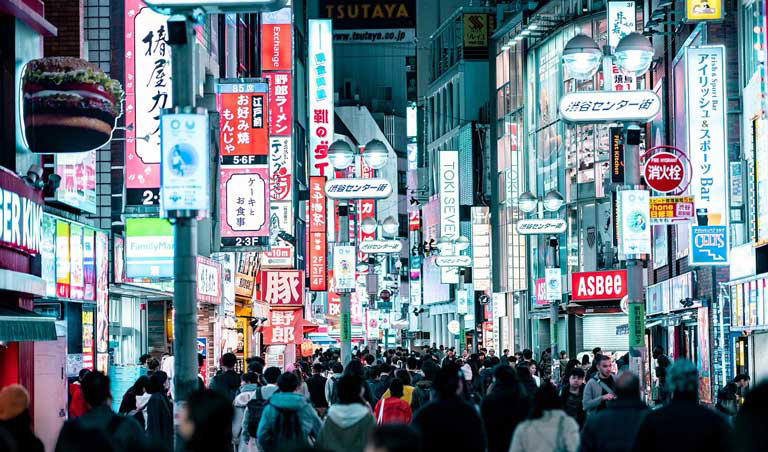

IMAGES
VIDEO
COMMENTS
Read on for a jam-packed guide on how to spend 3 days in Tokyo! Planning a trip to Tokyo can be a bit intimidating. With over 38 million people in the metro area, this is the most populous city in the world. ... For a 3 days in Tokyo itinerary, your best bet is picking up one of the 72-hour Tokyo metro tickets. The Klook website is the cheapest ...
Tokyo 3-Day Itinerary Summary. Three days is the ideal amount of time for the traveler to stay in Tokyo. Base yourself somewhere central to save time. On Day 1, visit modern Tokyo on the west side. On Day 2, visit traditional Tokyo on the east side. On Day 3, visit the Imperial Palace Area and Shinjuku.
Don't worry; My 3-day itinerary is your ultimate guide. I aim to offer you a well-rounded Tokyo adventure, covering its iconic landmarks, hidden treasures, and irresistible cuisine. This guide is perfect for anyone—from first-time visitors to solo explorers and lovebirds looking for a unique getaway.
The last stop of the day and the last activity on this 3 days in Tokyo itinerary is Roppongi. Roppongi is known for its vibrant nightlife, shopping, dining, and entertainment. ... Here are my favorite day trips from Tokyo: Amazing TOKYO to HAKONE Day Trip (7 Fun Things You Can't Miss) 14 Practical Tips How to See SNOW MONKEYS in JAPAN (Best ...
3 Days in Tokyo Itinerary Day 1: West Side (Modern Tokyo) ... Hakone is one of the most visually beautiful day trips from Tokyo, boasting stunning views of Mount Fuji amidst forested shrines and landmarks. A short train ride from Tokyo's city center, Hakone is a perfect day trip you can go on to get a bit more peace and quiet; I'd recommend ...
In my complete Tokyo 3 day itinerary, I suggest that you spend each day seeing as much as possible in Shibuya, Shinjuku, Asakusa and Ueno: Day 1) Shibuya and Harajuku. Day 2) Shinjuku. Day 3) Asakusa and Ueno. My 3 day in Tokyo itinerary ensures that you see the top highlights, experience the most iconic neighborhoods and visit cultural sites ...
Day 1: Tsukiji, Ginza, Imperial Palace, Tokyo Station, Akihabara, Asakusa. Spend your first day in Tokyo on the East side of the city, where you can experience both the traditional side and the flashy, futuristic parts of Tokyo. Stops on Day 1 of my Tokyo three-day itinerary include Asakusa's famous Sensoji temple, Tsukiji fish market, Ginza ...
Day 1. Tsukiji Fish Market. If your body is on a different time zone, your first day in Tokyo might be the best day for an early morning visit to the Tsukiji Fish Market, the biggest wholesale fish and seafood market in the world. Make sure to catch the tuna auction - spots are limited so you need to arrive at 3:00 am in the morning!
Dive into Tokyo's kaleidoscope of attractions with this meticulously crafted 3-day Tokyo itinerary, designed to showcase the city's main highlights and provide you with an unforgettable experience. From ancient temples to modern skyscrapers, traditional markets to trendy boutiques, and serene gardens to bustling streets, Tokyo offers a ...
Tokyo 3 Day Travel Itinerary Evening- Imperial Palace. The Tokyo Imperial Palace is the primary residence of the Emperor of Japan and is surrounded by parks and gardens offering a getaway from the busy city streets. Surrounding the home of the Emperor, the grounds are immaculate and visiting them is one of the top things to do in Tokyo for many ...
Your 3 rd day should be spent either at DisneySea (we loved it!) or on a day trip outside of Tokyo. Day 1: Akihabara, Senso-ji, Imperial Palace, Ginza, Shibuya Crossing, Takeshita, Meiji Jingu, karaoke. Day 2: Ghibli Museum, Skytree. Day 3: DisneySea or day trip to Kamakura.
Tomorrow will be a big travel day, but you sure did spend your three days well! Other Considerations. As you follow this three-day Tokyo itinerary or plan your own, keep the following points in mind: Since you'll be doing a lot of walking around outside, you don't want your three days in Tokyo to be hampered by rain.
5 days in Tokyo. Day 1 - Tokyo Skytree, Sensō-ji Temple. Day 2 - Meiji Jingu, Shibuya Scramble Crossing, Hachiko Memorial Statue. Day 3 - Tokyo National Museum, Imperial Palace, Tokyo Tower. Day 4 - day trip to Mount Fuji. Day 5 - Sumo morning training, Tsukiji Outer Market, Cat Café MoCHA, Japanese dinner cruise.
Day 3. 10:30 a.m. Brian MacDuckston left his Bay Area tech job to teach English in Tokyo. But 10 years later his one-year adventure threatens to become something more permanent now that his blog ...
Tokyo Geisha Cultural Experience. Spending time with a Geisha is a fantastic activity to add to your Tokyo travel plan. Spend 1.5 hours in the company of a geisha as you learn about the fascinating Japanese culture. While you enjoy refreshments, the geisha will perform songs, dances and play games.
Each part of the three day Tokyo itinerary. Jump down to a particular day - or keep reading for my complete itinerary for three days in Tokyo. • Day 1: Morning. • Day 1: Afternoon. • Day 2: Morning. • Day 2: Afternoon.
If you've got limited time in Tokyo, then where you stay is going to be hugely important. One thing to note is that accommodation in Tokyo can be quite expensive, which makes sense when you consider the size of the population of Tokyo.Very basic hotels start around 100-125 USD, but anything decent is going to cost you 175-200 and up.
Tokyo 3-Day Itinerary for First Timers to Japan's Capital. Here is an overview of the highlights of this 3-day itinerary: Day 1: Adventure through the western side of Tokyo and check out the modern pop culture and fashion of Harajuku, brave the Shibuya Crossing, and try a range of award-winning ramen dishes!
Embark on a 3-day adventure through the bustling streets of Tokyo and the tranquil landscapes of Hakone. Begin your journey in the heart of Tokyo with a visit to the Shinjuku Gyoen National Garden, a peaceful oasis amidst the city's hustle.
Contents: 3 Days in Tokyo Itinerary. [Close] Day 1: Central Tokyo (Shibuya & Harajuku) Morning: Meiji Shrine & Yoyogi Park. Afternoon: Shibuya & Omotesando. Evening: Dinner & drinks in Nishiazabu. Day 2: Discover Old Japan in Northern Tokyo. Morning: Yanaka & Ueno Park.
Relax and Recharge in Asakusa. After a long day of sightseeing, enjoy a great meal at one of the district's best restaurants, like Daikokuya Tempura or Asakusa Mugitoro. Then, end your night at Jakotsuyu Public Bath, a traditional Tokyo bathhouse with hot springs. Relaxing in the warm spa and sauna is a great way to end any 3-day Tokyo trip.
Tokyo 3 Day Itinerary For Winter. Day 1: Exploring Winter Wonderland in Tokyo. Ueno Park. Senso-ji Temple. Day 2: Skiing Adventure in the Tokyo Area. Gala Yuzawa Ski Resort. Day 3: Tokyo City Culture and Winter Markets. Toyosu Outer Market. Hamarikyu Gardens.
Working hours: 7:45 - 18:30; every day. After having exchanged your Pass, take the Narita Express, (included in your Japan Rail Pass) and travel to any of the following Tokyo stations: Shinagawa - Shibuya - Shinjuku - Ikebukuro - Omiya - Yokohama - Ofuna. Note: The Narita Express requires a seat reservation, which is why we ...
A great taster of Tokyo's Pop Culture, exploring and tasting your way around Harajuku. Pokemon Cafe. Photo Credit PreTraveller.Com Day 3 Tokyo with Kids Itinerary Morning. Head on an early morning train out west of the city to visit the Ghibli Museum and Hayao Miyazaki Movies Tour. Ghibli Museum half day trip. Photo Credit PreTraveller.Com ...
Embark on a 4-day adventure through the bustling cityscapes of Tokyo and the picturesque waterfronts of Yokohama. Begin your journey with the serene beauty of Shinjuku Gyoen National Garden, a lush oasis amidst Tokyo's urban sprawl, followed by an exploration of the iconic Shinjuku City, known for its vibrant nightlife and shopping districts.
Here, you can indulge in a leisurely cruise, embrace the serenity of the surrounding nature, and ponder the beautiful moments of your journey. The lake's mystical atmosphere, enhanced by the reflection of the surrounding mountains, provides a fitting and peaceful end to your four-day Tokyo Hakone itinerary.
1/2 day trip to Naoshima Bike rentals Chichu art gallery Art House project Benesse House Museum 1/2 day trip to Teshima Day 10 (Monday) Kanazawa Takamatsu => Kanazawa Check into Kanazawa hotel Dinner @ Mori Mori Sushi Day 11 (Tuesday) Kanazawa Higashi Chaya District (geisha district)
Day 4 of this 5 day Tokyo travel itinerary promises a fantastic blend of nature, culture, and immersive experiences. Morning. Kickstart your day with a walk through Ueno Park in the heart of the city.
Japan Itinerary Day 3: Tokyo. There's a lot to see and do in Tokyo (I cover it all here and here)! But consider taking a day trip out of town to see some non-urban sights: Kamakura Here you can see a 13-meter (43-foot) bronze statue of Buddha that was built in 1252. It was initially constructed within Kotoku-in Temple, but that has since been ...
Itinerary for 4 days in Tokyo with kids. ... Note: If theme parks aren't your style, you can elect to skip Disney on day three, and do a day trip from Tokyo to Hakone.